

Driving Utah National Parks: 7 Day Road Trip (Map + Itinerary)
Use our Utah National Parks road trip map and itinerary to plan the perfect one week driving tour through some of America’s best National Parks of the West.
Our 2 Utah National Parks road trips
Our first trip to Utah National Parks was during a one-month National Parks camping road trip in 2011, before starting our Peace Corps service.
We loved it!
Utah’s beauty is so different from where we grew up (Oregon and Hawaii). But I think that’s what makes Utah’s Parks especially captivating: they feel like they’re not of this world!
Reds and oranges. Textures like thousand-layer pancakes cut through with a sharp knife, or blobs of wet sand plopped in columns as big as buildings.
From an aerial view, this part of Utah may look dry and bland. But up close, every corner has new shapes and shades of the rainbow.
In 2020, we revisited the Utah National Parks in October on a 7 day road trip . This time we stayed in Airbnbs, while practicing responsible, social distance travel .
Disclosure: This post contains affiliate links. That means if you make a purchase through one of our links, we may receive a small commission, at no additional cost to you.
Table of Contents
Utah National Parks Road Trip Map + PDF
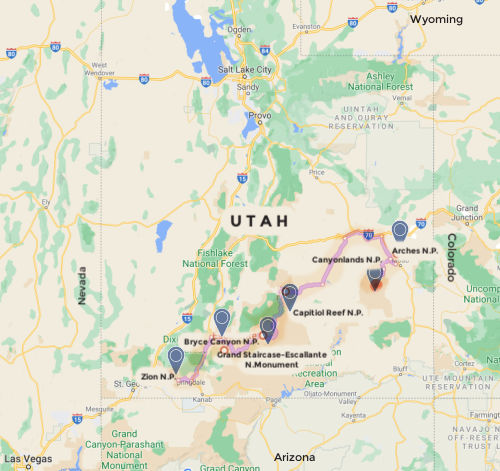
* Get our Utah National Parks map & itinerary PDF pack *
Best Utah Road Trip Itinerary
The ideal Utah National Parks tour includes: – Arches National Park – Canyonlands N.P. – Bryce Canyon N.P. – Zion N.P. – Capitol Reef N.P. – Grand Staircase-Escalante National Monument
That is a lot to cover in a 7 day Utah Parks itinerary! But yes, it can be done.
When limited to one week, most travelers skip Grand Staircase, as many of its attractions are more remote.
Capitol Reef and Canyonlands are not as well known and many skip these as well.
That being said, if you wish to avoid crowds in the Utah National Parks, you may want to spend more time at Grand Staircase-Escalante, Capitol Reef, and Canyonlands.
Let’s take a look at each of these Utah National Parks one by one, then we’ll answer some Frequently Asked Questions about Utah Parks road trips.
Bryce Canyon National Park
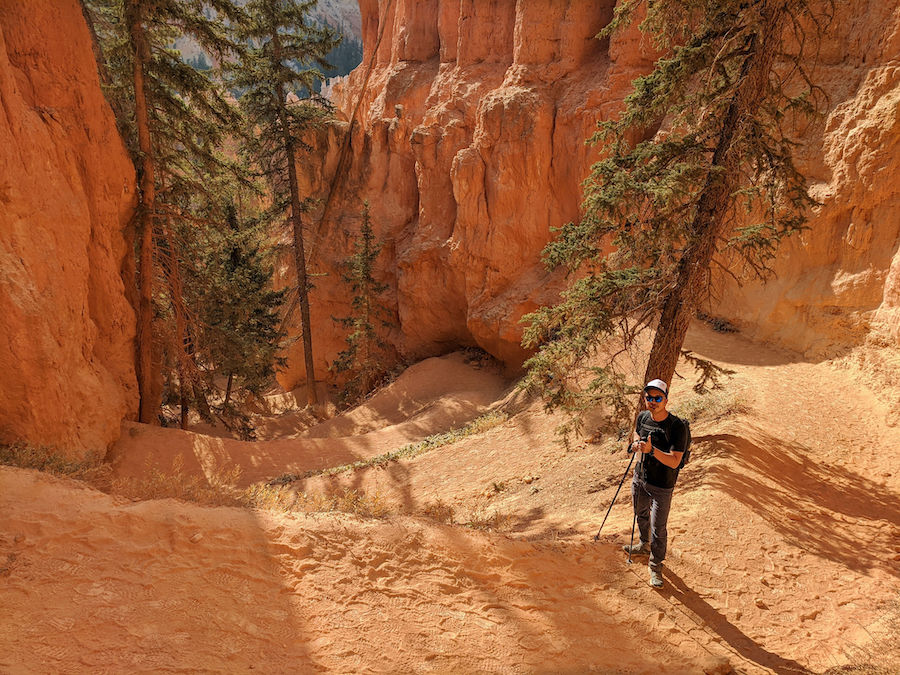
Bryce Canyon National Park is most famous for having the greatest concentration of hoodoos on Earth. Hoodoos are irregularly eroded columns of rock. It’s a beautiful geological wonder to behold!
Bryce is one of my all-time favorite National Parks and definitely deserves a top spot on your Utah National Parks itinerary. That being said, you can easily see the best of Bryce Canyon within half a day if needed.
Check the Bryce Canyon National Park website for visitor information
Bryce Highlights:
– Hiking among the hoodoos – Sunset and Sunrise viewpoints – Ranger talks and astronomy programs – Canyon horseback rides
Best Hikes in Bryce:
– Queen’s Garden and Navajo trails (2.9 mile loop, moderate difficulty): A must see! Bryce’s most popular hiking trail packs a punch, with gorgeous vistas and fascinating geological formations.
– Peekaboo Loop (5.5 miles, strenuous): Combine this in a figure-8 with the Queen’s/Navajo loop above for a spectacular half-day work out.
– Rim Trail: For folks with less mobility, or short on time, walk from the parking lot on this wide, paved path above the canyon. View Sunrise and Sunset points, about 1 mile apart.
Recommended Accommodations for Bryce Canyon:
Bryce activities:, zion national park.

Zion is Utah’s first and probably most popular (read: crowded) National Park.
On our Utah National Parks road trip map, you’ll see Zion is in the southwest corner of the State. This makes Zion National Park an ideal place to start a trip, especially if you’re coming from Las Vegas or California.
Zion’s main canyon boasts colorful, epic scenery and wildlife . But you can also visit a separate corner of the park, Kolob Canyon, that’s much less crowded.
Check the Zion National Park website for visitor information
Zion Highlights:
– Hiking in Zion Canyon or Kolob Canyon – Driving through the mile-long Mt. Carmel tunnel – Cycling the Zion Canyon Scenic Drive
Best Hikes in Zion:
– West Rim Trail to Angel’s Landing (5.4 miles, strenuous): Switch back climb with epic views. For those with fear of heights, skipping the final section to Angel’s Landing is still a great hike.
– The Narrows (up to 9.4 miles): A trek through the river itself, inside a narrow gorge with walls a thousand feet high.
Recommended Accommodations for Zion National Park:
Zion activities:.

Capitol Reef National Park
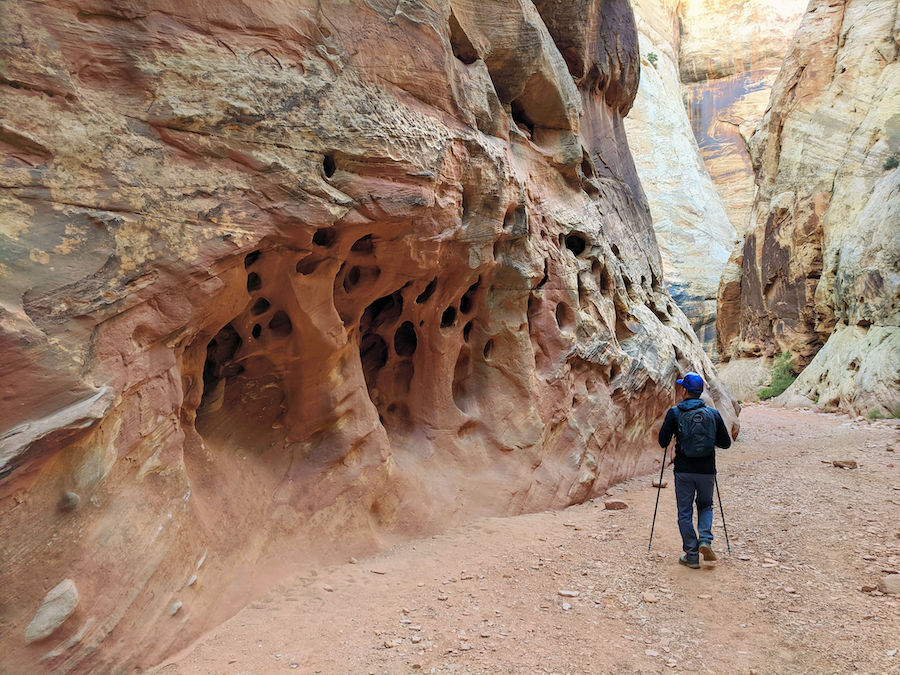
Capitol Reef is the most underrated Utah National Parks trip destination, in my opinion.
It’s also centrally located between the Western Utah parks (Bryce and Zion) and the Eastern parks (Arches and Canyonlands). Plus it’s next door to Grand Staircase-Escalante. With this location, Capitol Reef can make a great home base for a Utah National Parks vacation.
After a too-brief visit on our first trip, I made sure to spend extra time at Capitol Reef the second time around.
With such striking, unusual landscapes and relatively few crowds, Capitol Reef National Park is a hiker’s paradise .
Check the Capitol Reef National Park website for visitor information
Capitol Reef Highlights:
– Hiking through unusual geologic formations – Scenic drive into Grand Wash and Capitol Gorge – Petroglyphs and pictographs by Fremont peoples – Historic pioneer farmstead in Fruita
Best Hikes in Capitol Reef:
– Grand Wash (up to 4 miles, flat): A dry streambed trail through the narrows of a sculpted canyon with fascinating rock colors and textures. Option to add on a climb to Cassidy Arch.
– Hickman Bridge (1.8 miles, moderate): Canyon views and a grand rock arch/bridge.
Recommended Accommodations for Capitol Reef:
Budget Alternatives: Capitol Reef campgrounds ($), Wonderland Cabins ($/$$) Luxury Alternative: Cougar Ridge Lodge villas ($$$)
Grand Staircase-Escalante National Monument
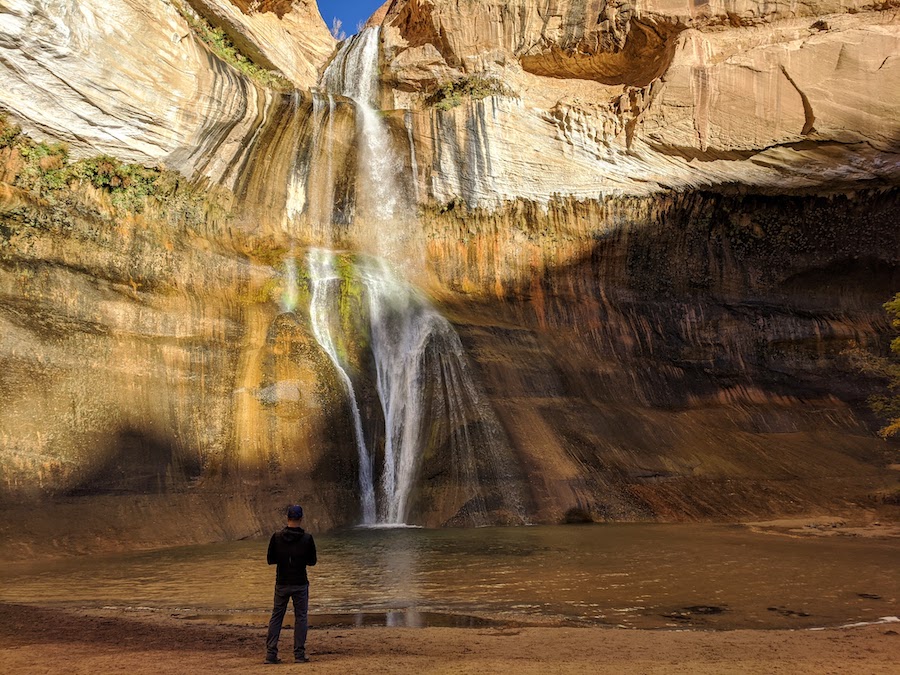
Grand Staircase-Escalante is actually a National Monument, which covers almost a million acres. Full of cliffs, slot canyons, river gorges, rock arches, fossils, and native artifacts, these public lands rival the other National Parks in Utah.
Unfortunately, these attractions are extremely spread out and not as accessible .
For convenience on a Utah road trip, we recommend visiting the area around Escalante, UT . This includes part of the Scenic Byway 12.
Check the Park website for visitor information
Grand Staircase Highlights:
– Scenic Byway 12 viewpoints and overlooks – Hiking diverse terrains
Best Hikes in Escalante:
– Lower Calf Creek Falls (6 miles, moderate): The stunning waterfall at the end is matched by fascinating terrain along this relatively flat but sandy out-and-back trail – pictured above.
– Coyote Gulch (11.5 miles, strenuous): A semi-narrow canyon that snakes its way through incredible red rock landscapes and arches.
Recommended Accommodations:
Budget Alternative: Calf Creek Campground ($) Luxury Alternative: 40 Acre Retreat ($$/$$$), Escalante Yurts ($$$) Escalante Activities:
Canyonlands National Park
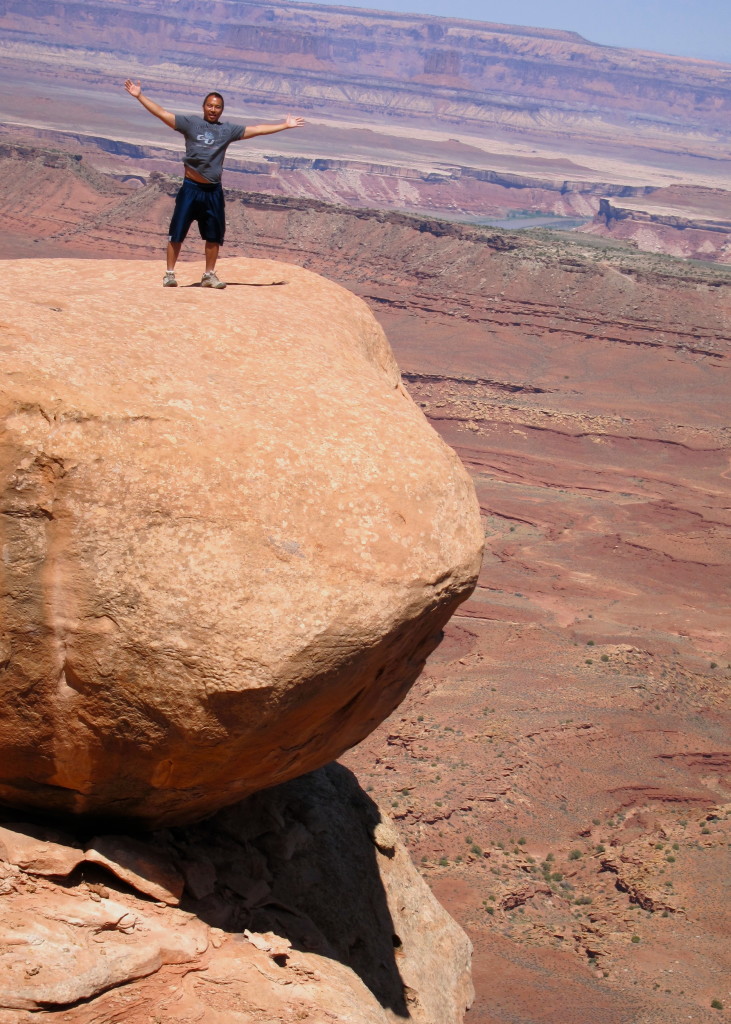
Adding Canyonlands to your Utah National Parks driving tour may depend on how much time you have. With its primitive desert landscape, it’s not quite as flashy as Arches, Zion, or Bryce, so some visitors choose to skip it.
That being said, Canyonlands National Park is a short drive from Arches , so it’s easy to make a day trip out of it.
Check the Canyonlands Park website for visitor information
Canyonlands Highlights:
– Horseshoe Canyon’s “Great Gallery” has some of the most significant rock art in North America – Impressive canyon vistas along the Island in the Sky Scenic Drive
Best Hikes in Canyonlands:
– Mesa Arch (0.5 miles, easy): A short loop trail to Canyonland’s most iconic rock arch.
– Grand View Point (2 miles, easy): Great for panoramic views of Candlestick Tower, the Green River, and the White Rim Road.
Canyonlands campgrounds
See Arches accommodations below for more options outside the park.
Canyonlands Activities:
Arches national park.

No Utah National Parks road trip itinerary is complete without a stop in Arches. True to its name, this open desert landscape is home to thousands of red rock archways and other fun stone formations.
Arches National Park is located just outside of Moab, Utah , an outdoor adventure hot spot of its own. This is the closest park to Utah’s Eastern border with Colorado.
Arches Highlights:
– Taking a scenic drive to countless viewpoints – Hiking among the arches – Rock climbing, canyoneering, biking, or horse-back riding
Best Hikes in Arches:
– The Windows (1 mile, easy): An easy climb to view massive rock windows and Turret Arch.
– Delicate Arch (3 miles, moderate): A steady uphill, passing a wall of Ute Indian petroglyphs, to get up close to one of the most iconic arches.
Budget Alternative: Edge of the Desert tiny houses , Devil’s Garden Campground Luxury Alternative: Modern Moab Villa (for 8) ; Exclusive Retreats 3bdr Home
Arches Activities:
Utah national park road trip itinerary tips.
How many days do you need to visit Utah Parks?
Technically , you could see the Utah Big 5 in a five day road trip. Driving distance is short enough, but this would allow very little time to actually enjoy yourself.
We recommend at least a one week Utah road trip itinerary. Two weeks in Utah National Parks would be even more ideal to get off the beaten path and explore the best of all the parks.
Best Time to Visit Utah Parks
Generally, the best time to visit US National Parks is in “shoulder season” when the weather is still nice but there are fewer crowds. That means avoiding school breaks, hot summers, and freezing winters.
Typically, Fall is a great time to take a southwest National Park road trip through Utah.
Which is better: Bryce or Arches? Zion or Moab?
You’ll see on our Utah National Parks map that Bryce and Zion are closest to each other on the West side of Utah. Arches and Canyonlands are on the East near Moab, Utah.
The best Utah parks to visit is personal preference. They are each so unique, it’s difficult to compare.
If you’re short on time and can’t see all the parks, I would pick whichever are closest to you geographically, to maximize your time in the parks. Whichever you choose will make for an amazing trip!
What should you pack for a road trip in Utah? What should I wear?
If you’ll be camping, see our epic camping road trip packing list . Don’t forget good hiking shoes and light-weight, layered clothes for the outdoors. It does get hot in the summer but can cool off at night, so a light jacket is recommended.
In winter, bring a heavier jacket, hat, gloves, and moisture-wicking layers. Sunscreen and water bottle are also must haves.
Alos, don’t forget your National Parks Pass !
Do you need bug spray for mosquitos in Utah?
Fortunately, Utah’s dry climate means there are not many mosquitos around the National Parks. Mosquitos may be more common around Salt Lake City at some times of the year, but it’s not usually a significant concern Utah National Parks.
We hope this Utah National Parks trip planner has been helpful. Let us know in the comments if you have your own recommendations to add. And don’t forget to get your National Parks in Utah map and road trip itinerary PDF pack here .
Like this post? Pin it for later or share with friends!

Similar Posts
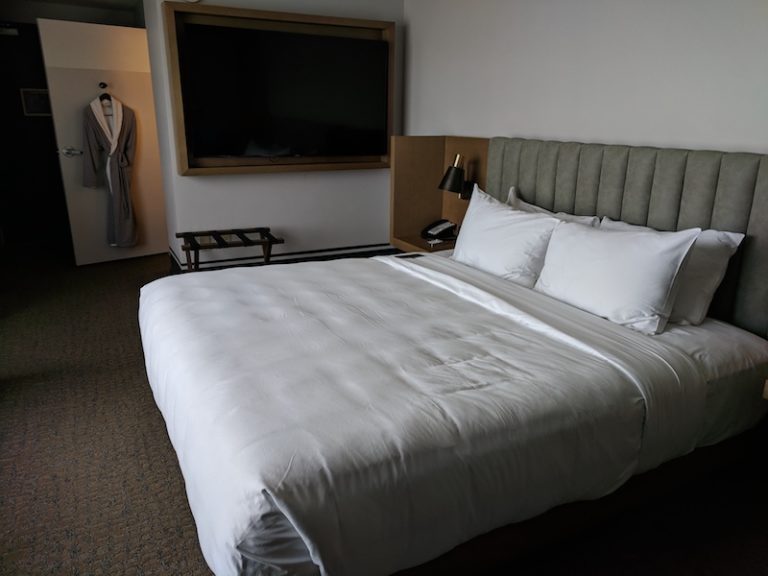
A Local’s Guide to Where to Stay in Portland Oregon
Staking its claim as America’s destination for weirdness, Portland, Oregon is one of the most popular destinations for travelers to visit. It is in a stunning location at the end of the Oregon trail with breathtaking views, great hiking trails, and must-see landmarks. Portland is a foodie paradise famous for abundance of food trucks, street…
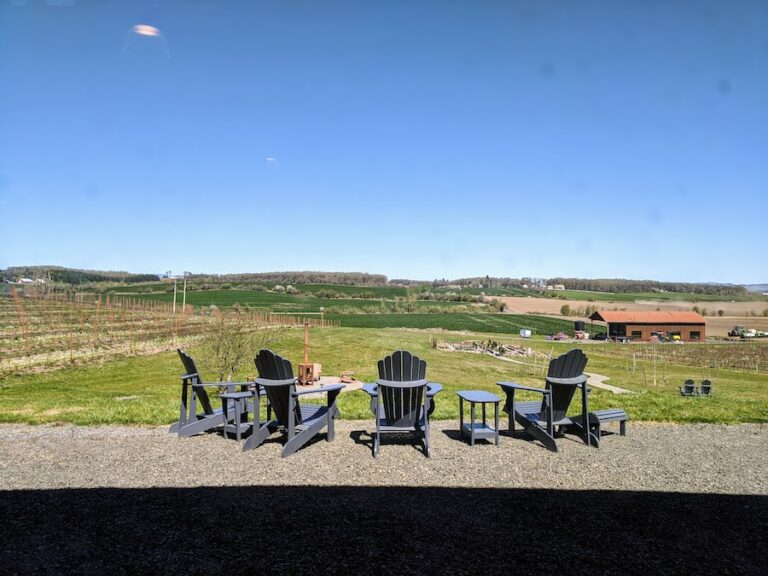
Where to Stay in Willamette Valley Oregon Wine Country
Oregon’s Willamette Valley is home to over 600 world-class wineries and is quickly growing in popularity as a wine tourist destination, offering its own charming alternative to crowded and more expensive wine regions. Named after the Willamette River flowing through the region, Willamette Valley also has much more to offer beyond wine. Trendy gourmet restaurants,…
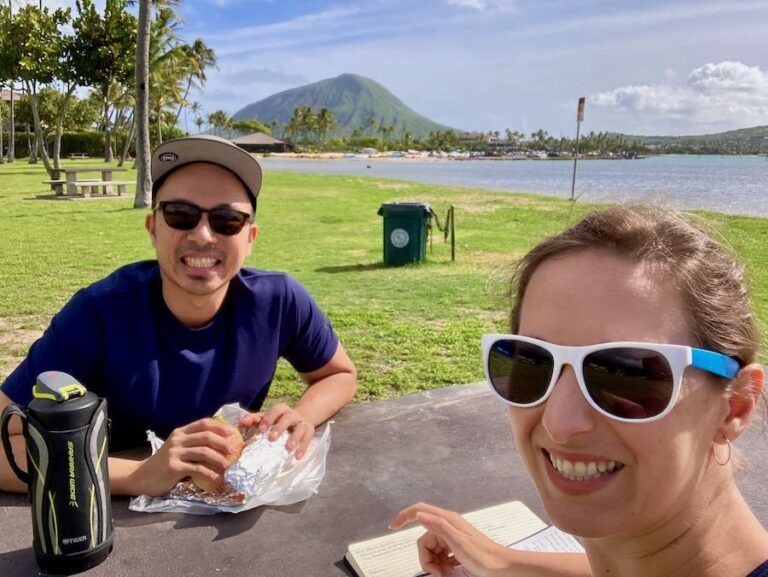
Visiting Honolulu in January: What to Know, Weather, and Events
Growing up in Honolulu and now returning annually to visit family, January has been my favorite time to visit Hawaii. In this post, I’ll share more details about why it’s so great and how to make the most of a January Honolulu trip. Is January a good time to visit Hawaii? Yes! Let it be…
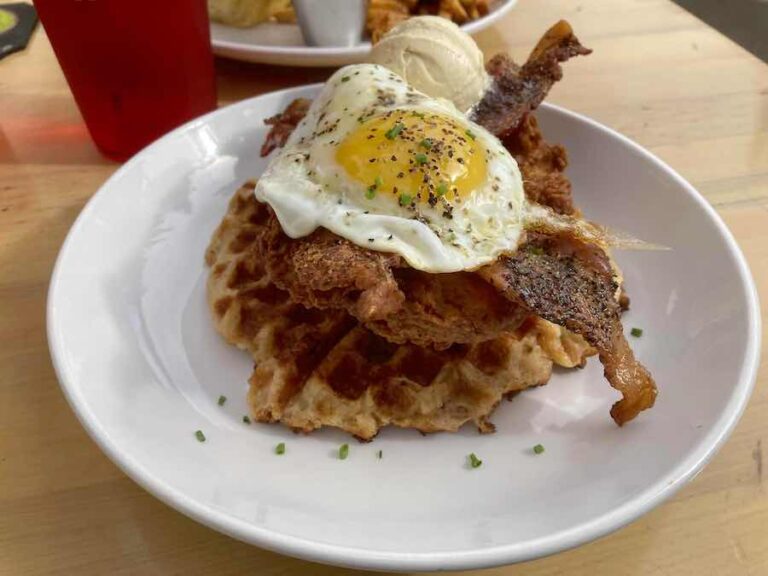
Best Breakfast in Salem Oregon: Guide to Salem Breakfast Restaurants
From cozy diners, modern eateries and cool coffeeshops, Salem’s breakfast scene is not only full of beloved institutions offering all your American classics. Oregon’s capitol city is also home to hip restaurants with the latest brunch trends. With all the options available, breakfast in Salem, Oregon makes for a great food trip! Keep reading to…
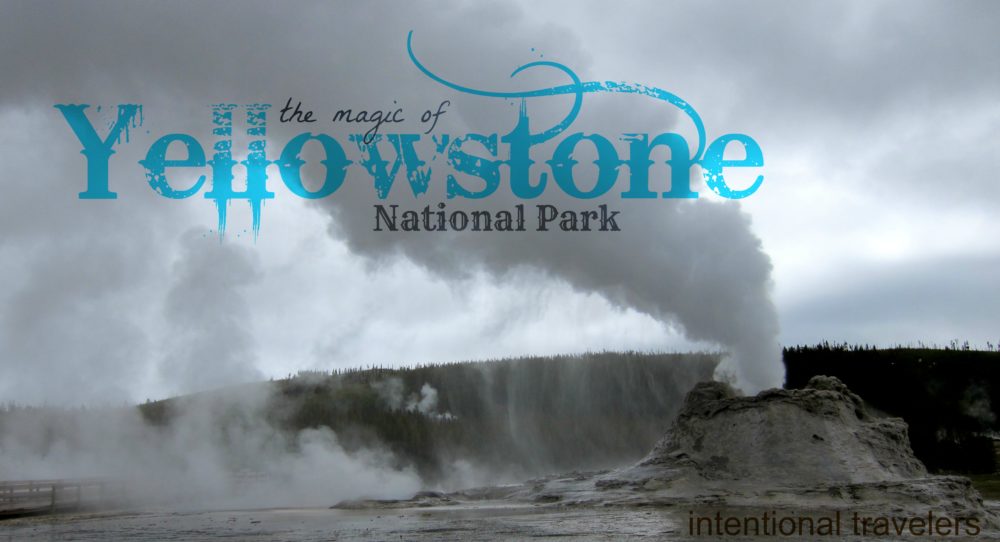
Yellowstone
Road Trip Yellowstone from Chamanson on Vimeo. Here’s a video montage of our times in the super volcano! We spent five days/four nights in a cute little budget cabin just steps from Old Faithful, and enjoyed a range of weather conditions from pleasantly sunny to blustery snow. Yellowstone is an unbelievable place with so many…
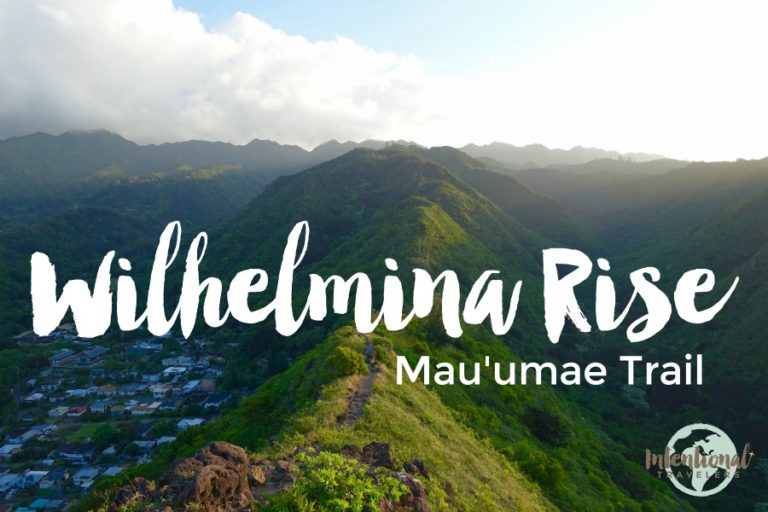
Wilhelmina Rise Mau’umae Trail Hike in Honolulu – Oahu, Hawaii
We’ve always called this the Wilhelmina Rise hike, although the trail name is Mau’umae Trail and it’s also known as Lanipo. This is one of several ridge hikes between the valleys east of Honolulu city center, off Highway 1. In our opinion, the first section of the trail is the perfect first Oahu hike for…
hello. we are planning a road trip in May with our well-trained pup. I checked out several of the lodging sites posted on your site and they all seem to be non dog-friendly. LaQuinta Moab and also in LaVerkin are pet friendly. Any suggestions for us? Also we are driving from the Olympic Peninsula in WA so would beginning in SLC be the best route? Thank you!
We are coming to Utah in November around the 6 to the 12. We are bringing my 11 year old granddaughter. Any suggestions for activities. We hike but don’t want difficult hikes. Are the activities still available I. November
Hi Ellen. There are plenty of easy hikes throughout the Utah Parks. If you’re not able to find the info you’re looking for in our post, each Park has up to date recommendations and calendars in a brochure that you can pick up at the entry or visitor center.
Thanks for the info. As seniors we need to see as much as we can without hiking. Which parks have the best scenic drives? Know we’ll miss a lot without hiking, but we are not physically able.
Thanks for visiting our blog! Several of the parks have well known scenic drives, which we’ve mentioned in this post. Capitol Reef and Arches come to mind as the best parks to view from your own car. Zion’s valley is not self-drive but you can take the park shuttle to experience that scenic drive.
Thanks for the information it is great. Which hikes would you recommend for beauty but avoiding dangerous hiking since my family are newbies and are afraid of heights in tight quarters. Also I’m thinking of let’s say doing 5 days or less, which would you avoid or if easier the must do’s.
Hi Fred. Great question. Most of the Parks have so many hikes, you’ll be able to find beginner-friendly non-scary hikes to suit your preferences. It might be easiest to start with Bryce and Zion, as both have great viewpoints without necessarily needing to hike up or down and your driving time will be minimal. You could add Arches as well for scenic drives and light hiking to see some of the best sights. Hope that helps!
Leave a Reply Cancel reply
Your email address will not be published. Required fields are marked *
This site uses Akismet to reduce spam. Learn how your comment data is processed .
Let's be friends! Sign up receive our monthly newsletter with updates and new in-depth guides.

How to Plan an Incredible Utah National Parks Road Trip
If you’re here, that means you’re probably in the early-ish stages of planning an Utah National Parks road trip. We have good news – you’re in the right place! In the guide below, you’ll find pretty much everything you need to plan a bucket list-worthy trip to all five of Utah’s National Parks.
We’ll begin with some important logistics, like where to start and end your Utah national parks itinerary and how many days to spend in Utah, and then get into the best stops, things to do and see, sunrise and sunset spots, hikes, places to stay, and more.
Over the last three years, we’ve been to 18 national parks. And multiple Utah national parks make it into our top five list of America’s national parks (though we haven’t visited them all…yet).
We’ve now been twice in the past few years – fall and spring – and have updated the guide below with some of our latest discoveries.
We absolutely love Utah, and think you will too. I, Matt, have been to Utah four or five times at this point, including two trips in the past few years. The diversity of landscapes in southern Utah – which is home to the “Mighty Five” national parks – is pretty mind boggling.
You’ll find natural arches in, well, Arches National Park. Unique rock formations called hoodoos in Bryce Canyon. The vast and surprisingly lush canyon in Zion National Park. And there’s so much more – it would take a lifetime of exploring to see everything that Utah has to offer.
If those incredible landscapes sound like something you want to experience, you’re in the right place. In this Utah national parks road trip itinerary, we’re going to cover – in detail – how to plan an amazing road trip through Utah.
We love Utah, and think you will too.
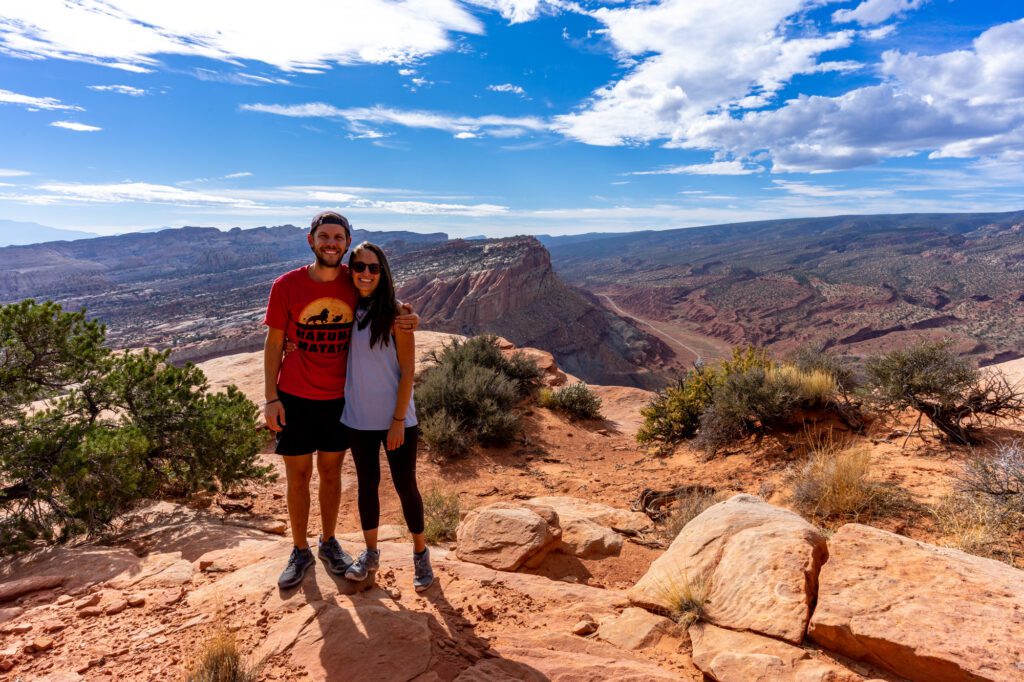
Disclaimer: Some of the links in this post, like hotel links, are affiliate links, meaning at no additional cost to you, we make a little bit of money if you click through and book. That being said, we would never recommend something to you that we don’t stand behind 100%.
How Many Days Do You Need for a Utah National Parks Road Trip?
We think that you need a full 10 days to do the complete Mighty Five circuit . Less time means a lot of driving and not a lot of time dedicated to each park. With 7 days, you’d essentially only have one day for each. Which we don’t think is enough time.
Some parks have more to see than others and are worth spending two to three days in to have the best experience.
We’ve written this guide for someone with 10 days , which I think is the perfect amount of time to see all five national parks in Utah, and have an extra day to spend on the other things that make Utah special.
What if You Only Have 5-7 Days in Utah?
If you have a week or less in Utah, we’d strongly urge you to focus on EITHER Zion National Park and Bryce Canyon, OR Arches, Canyonlands, and Capitol Reef.
When you include driving time, which totals around 10 hours or so over the course of the itinerary, 5-7 days BARELY gives you a day in each park if you were to do all five.
Focusing your time on only a few of them will give you a little more time in each park, rather than spending less than one day in each. The key benefit of this approach is that you’ll be able to spend more time in the early morning and late afternoon, which is when the crowds are thinnest at these parks.
Where to Start and End Your Utah Road Trip Itinerary
There are two options for getting to Utah – driving in from nearby, or flying in, renting a car, and driving.
The two best starting points for this road trip are Las Vegas and Salt Lake City . Denver is a distant third. It’s still doable, but involves more driving.
If you don’t live nearby, like in Salt Lake City or Denver, you’ll need to fly to one of the gateways to Utah, rent a car, and drive to your first destination.
The two easiest airports to fly into would be Salt Lake City and Las Vegas .
From Salt Lake City, it’s going to take around four hours to drive to the start and end points on this road trip itinerary (Zion and Moab).
From Las Vegas, it’s going to be just two and a half hours to Zion, but six and a half hours to Moab.
The best way to do this road trip if you want to avoid long days of driving is to fly into Salt Lake City and out of Las Vegas , which is how we’ve organized the itinerary below.
You could absolutely do it the other way around, but doing it this direction front loads the longer drive from Salt Lake City to Moab, versus having to do that drive at the end of your trip when your enthusiasm is waning and you only have your return flight to look forward to.
You can also fly in and out of the same airport, it’ll just involve a few hours of extra driving on one end of the trip.
Important Note : You need to check with the rental car company to make sure that it’s okay to pick up in one spot and drop off in another. You might have to pay a one way fee, but we think it’s worth it to avoid wasting a day of your vacation driving. See below in the rental car section to see what the tradeoff is between picking up / returning to the same place, and doing a one way rental.
You could fly into Denver and out of Vegas if you wanted to add on a few days exploring Colorado. It’s going to be five and a half hours of driving between Denver and Moab, but there’s plenty of things to do and see along the way.
Good to Know : Book the earliest flight you can into Salt Lake City, and the latest flight out of Las Vegas to give yourself as much time as possible to explore.
Tips for Your Road Trip Through Utah
Before we get to the full itinerary, a few general tips about planning a road trip through Utah.
National Park Entrance Fees
It costs $30 per vehicle to enter each national park (good for 7 days), and you can either pay online in advance (be aware that you must print it out and bring it with you), or at one of the park’s visitor centers.
If you are planning on visiting three or more national parks in the next 12 months, we’d highly recommend an America the Beautiful Pass , which covers entry to all national parks, national forest trailheads, national monuments, and more for 12 months.
It costs $80, which means it pays off with three national park visits (or some combination of national parks, forests, and monuments).
On this trip, you’re going to be visiting several national parks, which means it’s probably worth buying an America the Beautiful Pass before your trip.
Crowds in the Utah National Parks
If you’re visiting the Utah national parks in the summer (or a weekend in the spring or fall), you’re going to experience crowds.
There are a couple of things we’d say about crowds and how to avoid them as much as possible.
First, get an early start, and plan on staying out late . Peak time is from about 10:00 am to 4:00 pm, which makes the hours from 7:00 am to 10:00 am and 4:00 pm to 7:00 pm some of the best times to be out and about in the park. Plus, the rising/setting sun means the light will be better for pictures!
If You Want to Camp, Book Your Site Well in Advance
Camping inside the national parks is super competitive . For reservable sites, people book months and months in advance, and when there are first-come-first-served sites, they are snatched up immediately in peak season.
The good news? There are tons of camping options outside of the parks that are affordable and accessible, and you’ll find some recommendations in the where to stay section for each park.
This is a Good Route to Test Out Van Life
If you’re not into sleeping in a tent, consider an RV or Campervan rental . It’s a good way to save money on accommodations by staying at campgrounds or RV Parks instead of hotels. For what it’s worth, we did this entire trip living in a Honda Odyssey.
Think of it as a middle ground between camping and staying in hotels and vacation rentals.
Escape Campervans is a good choice, and they have options for the exact route (Salt Lake City to Vegas) that the itinerary below has you on.
Book Your Accommodations Well in Advance
If you’re planning on staying in hotels and lodges, book several months in advance between May and October . That’s peak season, and things fill up FAST.
Even outside of those months, you’ll still find that some places are full a few months in advance. You’ll find some hotel recommendations in each section to help you find the best place to base yourself to make the most of your time in each park.

The Perfect 10 Day Utah National Parks Road Trip Itinerary
Now, on to the itinerary itself!
Below, you’ll find a detailed day-by-day itinerary for a 10 day Utah national parks road trip based on our personal experience over the course of multiple trips. We’ll give you our favorite stops, the best hikes, places to stay, and more.
Grab a cup of coffee and strap in – this is a long one, but it has literally everything we could think of to help you plan an amazing adventure.
Here’s an overview of that road trip, plus a map to help you visualize the route.
Here is the 10 day Utah national parks road trip itinerary that you’ll find – in detail – below:
- Day 1 : Arrive in Salt Lake City, Drive to Moab
- Day 2 : Arches National Park
- Day 3 : Canyonlands National Park (Island in the Sky)
- Day 4 : Around Moab + Drive to Capitol Reef
- Day 5 : Capitol Reef National Park + Drive to Bryce
- Day 6 : Bryce Canyon National Park
- Day 7 : Bryce Canyon National Park + Drive to Zion National Park
- Day 8 : Zion National Park
- Day 9 : Zion National Park
- Day 10 : Zion National Park + Fly Home from Vegas
If you have a full two weeks in Utah , you’ll be able to get a little bit off the beaten path, exploring places like Kolob Canyons in Zion National Park and the Needles District in Canyonlands National Park that most visitors never even realize exist.
Below the full itinerary, you’ll find our suggestions for extending the 10 day trip.
With 7 days , rather than trying to fit in the entire Mighty Five Circuit, we’d opt for spending 7 days exploring EITHER Zion, Bryce, and Capitol Reef OR Arches, Canyonlands, and Capitol Reef.
Days 1 & 2: Arches National Park
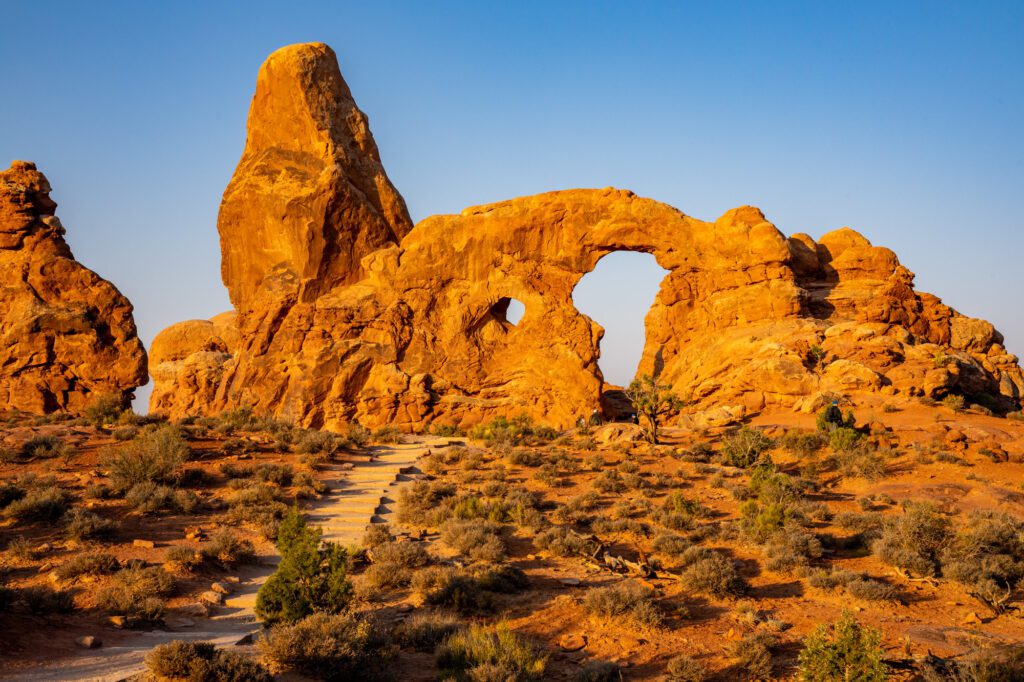
On your first day, you’ll spend most of the day in transit between Salt Lake City and Moab, which is the jumping off point for this itinerary.
We spent five full days in Moab , and loved just about every minute of it – minus the hour-long wait to get into Arches National Park to check into our campsite. A good reminder to make sure to enter the parks early (before 9:00 am at the latest!) to avoid long lines and crowds.
We didn’t realize it before arriving, but there are an astounding number of things to do in Moab .
Between exploring the two national parks that are a stone’s throw away – Arches and Canyonlands – to hikes outside the parks, and more adventurous activities like whitewater rafting and 4WD-ing, there’s plenty to keep you busy even if you had a full week JUST in Moab.
What to Do in Arches National Park
Here are our favorite things to do in Arches National Park.
Sunset at Delicate Arch
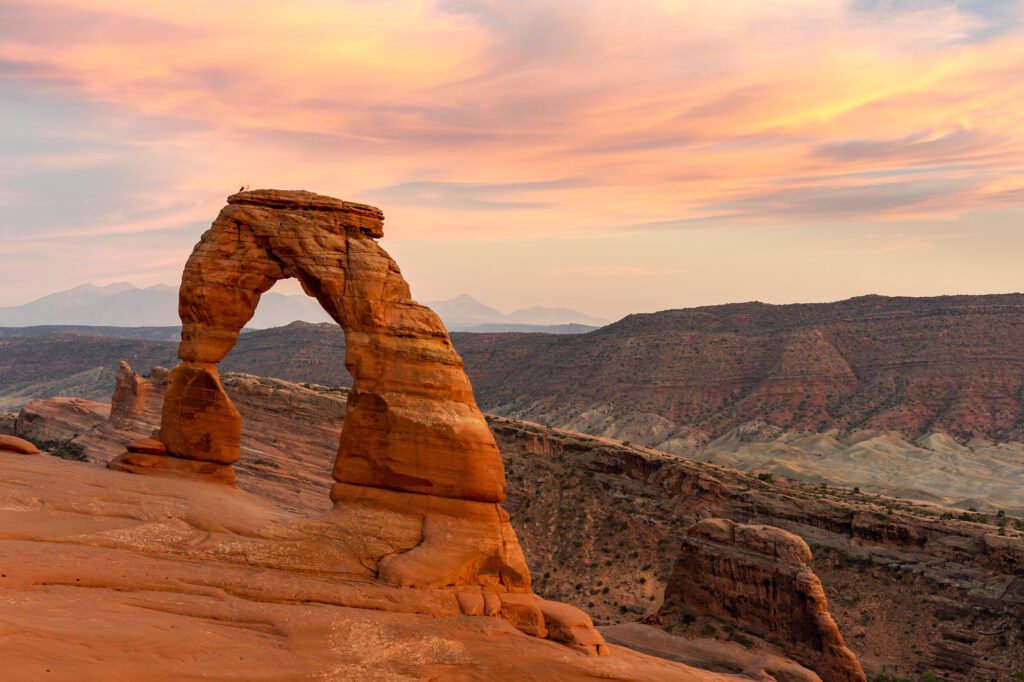
On your first day, you’ll be driving from the airport and you’re probably going to be arriving mid-afternoon depending on what time your flight was (try and get the earliest flight possible!).
Check into your accommodations for the next few days and head up to Arches National Park for that sweet, sweet golden hour light and sunset at Delicate Arch .
It’s a 3 mile hike (round trip) that was a little harder than we thought it would be, but that didn’t stop literally a hundred people – ages 5 to 65 – from doing it.
It will probably be crowded if you’re there anytime between April and the end of October, but it’s worth it. You’ll climb up a section of rock, so you’ll want to wear your hiking shoes with plenty of grip.
There’s one short section of the trail right before you get to the arch that’s narrow with a steep drop off, so keep an eye on your kids.
If you do that hike at sunset, make sure to bring a headlamp for the way down. It gets dark FAST, and the last thing you want is to be hiking down the slab of rock in the dark.
The Windows and Double Arch
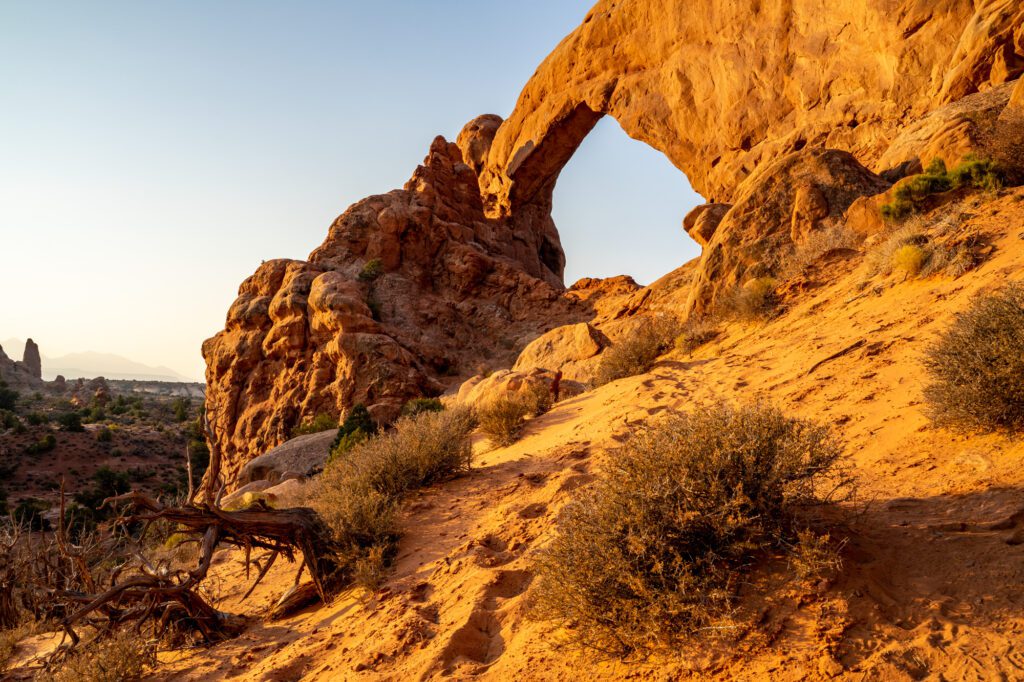
Start your day off your second day with an early morning at the Windows and Double Arch, which are quite possibly our favorite set of arches in the park. And they’re so close together that you can easily see all of them (there’s four arches here in total) in about an hour or so.
The Windows are two huge rock formations that are on the southeast side of the parking lot. There’s a nice trail that connects the North and South windows, along with nearby Turret Arch.
Make sure to walk through the North Arch and look back through the window to get a nicely framed picture of Turret Arch.
Double Arch is on the opposite side of the parking lot, and it’s the tallest arch in the park. There are two separate (huge) arches that you’ll be looking up at.
You can climb around inside the arch and marvel at the two arches sharing the same base structure. It’s about a quarter of a mile from the parking lot on a flat, sandy trail.
Hike the Devils Garden Trail
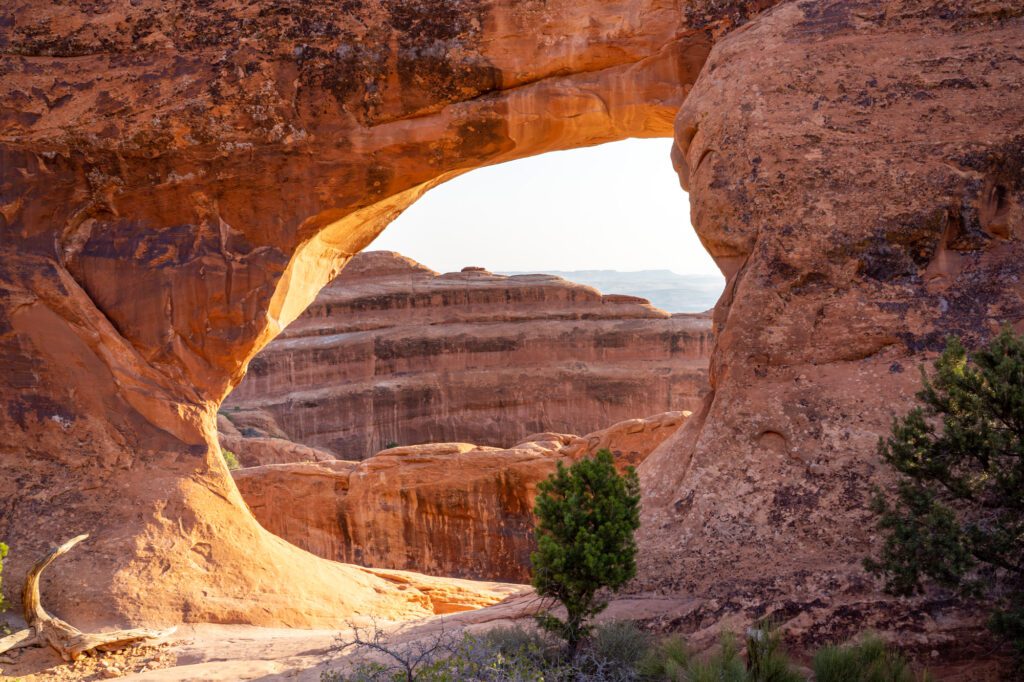
The Devils Garden Trail is a must-do hike in Arches National Park . The best part about this hike? You can customize it based on your experience and fitness level.
If you do the entire loop, including the fun primitive trail on the way back, it’s going to be just under seven miles, with 1,000 feet of elevation gain. Along the way, you’ll see seven different arches, and you’ll do some light scrambling and trail finding on the primitive trail, which we thought was a lot of fun.
You’ll want solid hiking shoes or hiking boots (Alysha loves her Columbia Newton Ridge boots , an excellent first hiking boot) with good traction for the scrambling sections, which have you making some steep climbs on rock that necessitate good footing. It’s nothing too crazy though if you’re an experienced hiker.
If you’re not up for 7 miles in the desert, do the 2 mile hike to Landscape Arch or the 4 mile (ish) hike to Landscape, Navajo, and Partition Arches , which takes you a bit further than most of the hikers go.
Whatever you choose, it’s going to be hot. Drink plenty of water, eat plenty of snacks, and wear sun protection. Sun exposure is no joke, particularly in the summer.
Broken Arch and Skyline Arch
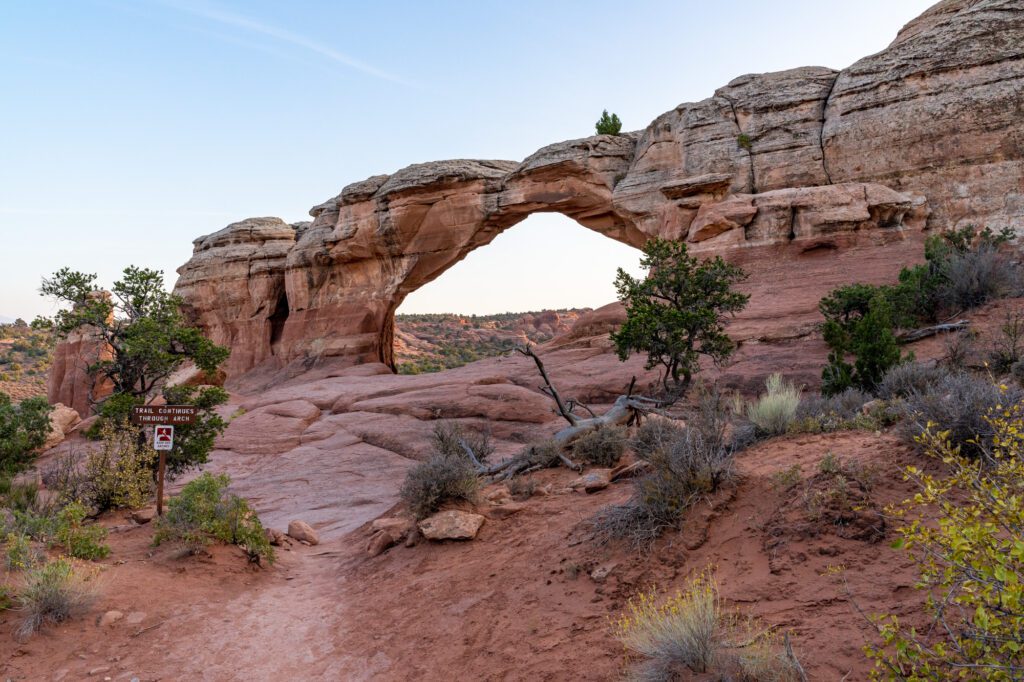
Stop for a quick picnic lunch near the Devils Garden trail (there’s a picnic area just south of the campground and trailhead), then do the short hikes out to Broken Arch and Skyline Arch.
You can park in Devils Garden Campground ( here ) to start the hike out to Broken Arch .
It’s a cool hike, which is why it’s on this list duh, and you’ll pass through a couple of cool canyons on the way back from Broken Arch. It’s about 1.8 miles round trip, and is basically flat. This is a good sunset hike too if you’re staying at Devils Garden Campground since you can leave from camp without driving anywhere.
Skyline Arch is also worth seeing. You get there via a pull off just south of the campground, and it’s a short, easy hike out there.
Where to Stay in Moab near Arches National Park (and Canyonlands)
You’re going to stay in Moab for the first three nights of this itinerary. You should try to stay in one place for all three nights UNLESS you’re camping, in which case we’d try to find a site in Arches for the first night.
Pssst ! Make sure to read our guide to the best places to stay in Moab to find the perfect home base for exploring this incredible area.
Hotels in Moab
We were planning on staying in a hotel in Moab for a night to shower and take a break from the weeks of sleeping in our van, but later decided to stay at a campground for an extra night instead.
There were exactly three places on our list of hotels that we wanted to stay in.
- The first is Moab Springs Ranch , which has a range of rooms from bungalows to more lodge-style rooms, and has a great coffee shop onsite (Horsethief Coffee). Unfortunately, they were sold out for our dates (book early, people!), but we would have chosen to stay there given the opportunity.
- The second, which is a place we booked then later canceled, is the Expedition Lodge . It’s in a great location along the main drag in Moab, and it looks nice. It’s motel style, which was what we were looking for during the summer of 2020, and it has some nice retro touches like the mint green mini fridges in the rooms. They also have some unique room configurations, like two queen bunk beds, which are nice for a traveling family (nobody likes sleeping on the cot on a hotel room floor). Oh, and there’s a pool, which is always a bonus.
- The last option was Moab Under Canvas , which is less a hotel, more glamping, but still fits here. This is your chance to stay under the stars while still maintaining some semblance of the comforts of a hotel. It looks incredible.
Camping In and Around Moab

If you’re looking to camp, you’ve actually got a fair number of options both inside Arches and Canyonlands, and just outside the national parks.
- Inside Arches, there’s only one campground – Devils Garden . It’s reservable in advance ( learn more here ), and it’s a really nice campground. We stayed there for three nights, and it’s a great base for exploring Arches for a couple of reasons. First, it’s at the trailhead for Devils Garden, so you can get an early start to beat the crowds and heat (staying outside the park means a 45 minute drive to the trailhead). Second, being inside the park means you’ll avoid the crazy lines at the entrance to the park. We waited an hour to get in one day because we had to leave the park to get ice for our cooler.
- Inside Canyonlands , you have only one option in the Island in the Sky District (which is the part of the park you want) – Willow Flat Campground . It’s first-come-first-served, and only has 12 sites. Unless you show up early AND get lucky, you’re probably out of luck. You could also camp at Dead Horse Point State Park , which is close to the entrance of Canyonlands, and is worth a visit in its own right, particularly for a spectacular sunset over the canyons.
Outside the park, there are a surprising number of campgrounds on BLM land that are all first-come-first-served. There are two major areas where you’ll find them.
- The first group are along Highway 128 northeast of Moab on the Colorado River, and they are competitive and you’ll need to show up relatively early for the first few campgrounds. They’re in an incredible location along the river and deep inside a gorgeous red rock canyon. Goose Island, Grandstaff, and Big Bend are the nicest based on our drive through the canyon.
- The other area is along Highway 279 northwest of Moab – check out Gold Bar Campground , which is near the trailhead for Corona Arch.
Day 3: Canyonlands National Park

On your third day in Moab, head out to Canyonlands National Park , which is a very different experience than Arches.
While Arches is about feeling small standing under the towering rock formations littered around the park, Canyonlands is about feeling miniscule while looking out over the deep fissures in the earth created over thousands (millions?) of years of tectonic plate action.
There are three sections of Canyonlands: Island in the Sky (closest to Moab, most accessible), the Needles District, and the Maze (technically I think there’s a fourth called the Rivers, but I’m not quite sure about that one).
With just one day, you should focus on Island in the Sky , which is the most accessible part of the park coming from Moab. However, if you have more time, a trip down to the Needles District is worth your time.
What Not to Miss in Canyonlands National Park
Here are some that we enjoyed in the Island in the Sky part of Canyonlands National Park.
Early Morning at Mesa Arch
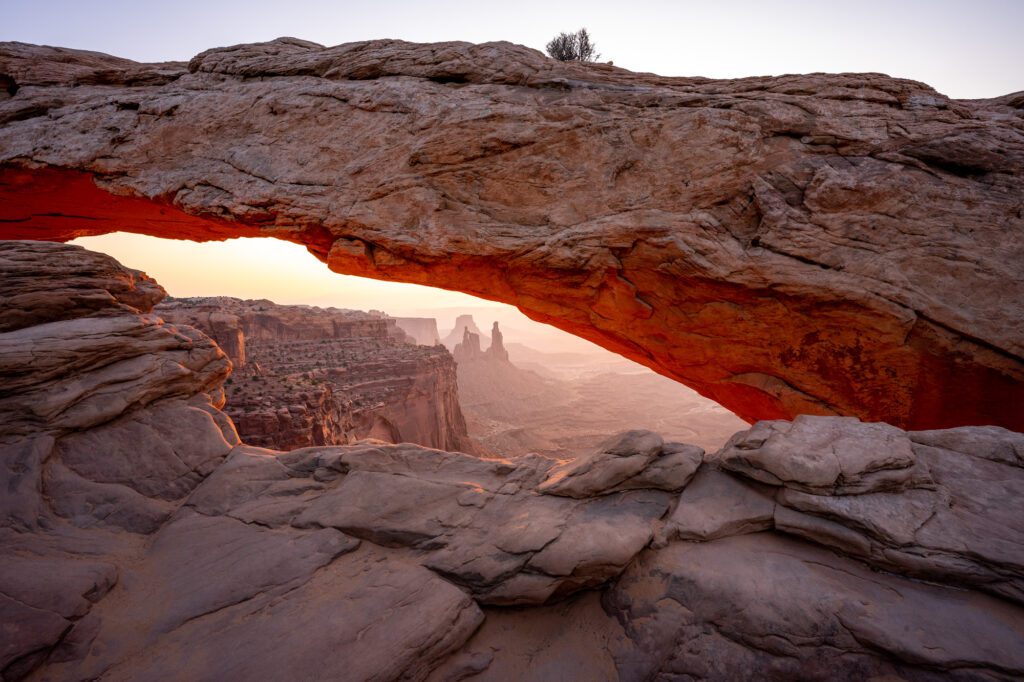
Start your morning at Mesa Arch just after sunrise. It’s a really short hike out to a low arch, through which you get a nice glimpse of the vastness of Canyonlands.
Why just after sunrise, you ask? Because at sunrise, there will be hundreds – yes, hundreds – of photographers vying for the best position to take that picture-perfect shot of the natural bridge with the sunstar on the bottom. I bet you’ve seen it before – it looks like this:
I took that around sunrise at Mesa Arch, where we’d arrived an hour before sunrise and still didn’t get a spot. Instead of jostling for position, we took a seat on a rock overlooking the arch and watched the sun rise, then I ventured down when the crowds started to thin.
Here’s the behind the scenes view of the sea of photographers that you don’t see in the pictures on Instagram.
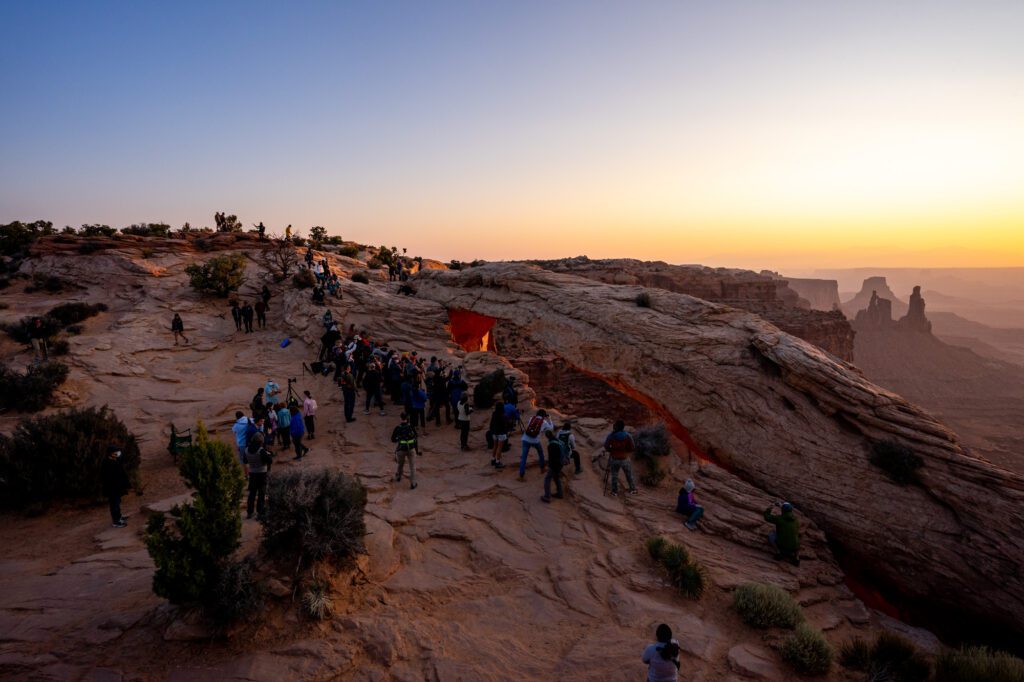
The point is that going after sunrise is a much more pleasant experience.
Hiking in Canyonlands
After experiencing Mesa Arch, head out on a hike in Canyonlands’ Island in the Sky District.
Here are three options for various levels of hiking experience and fitness. If you’re up for it, you could totally do a couple of the shorter ones together as part of a little circuit along Canyonlands’ main thoroughfare.
Aztec Butte (1.7 miles / 250 ft. elevation gain): This is a cool hike that has two distinct parts that form a “Y” shape. First, take the right fork to climb to a nice viewpoint over Canyonlands. Then on the way back, take the left fork and check out the ancestral Puebloan structures, which are pretty cool. DON’T TOUCH THE STRUCTURES – leave them be.
White Rim Overlook (2 miles / 200 ft. elevation gain): A short and sweet hike to an incredible overlook that really illustrates the scale of Canyonlands. It’s a short, well-marked hike out to a little “peninsula” (for lack of a better word – there’s no water, but it’s a peninsula shaped part of the canyon rim). Follow the rock piles, known as cairns.
The Gooseberry Trail (5 miles / 1,500 ft. elevation gain): This hike is no joke. You basically climb straight down the wall of the canyon to get to the lower plateau, which takes you to a nice overlook of the canyon forged by the mighty Colorado River. Just remember, the first part of the hike is a descent…which means what goes down must come back up. Try to get an early start so that you’re not out there in the heat of the day.
Grand View Point Overlook
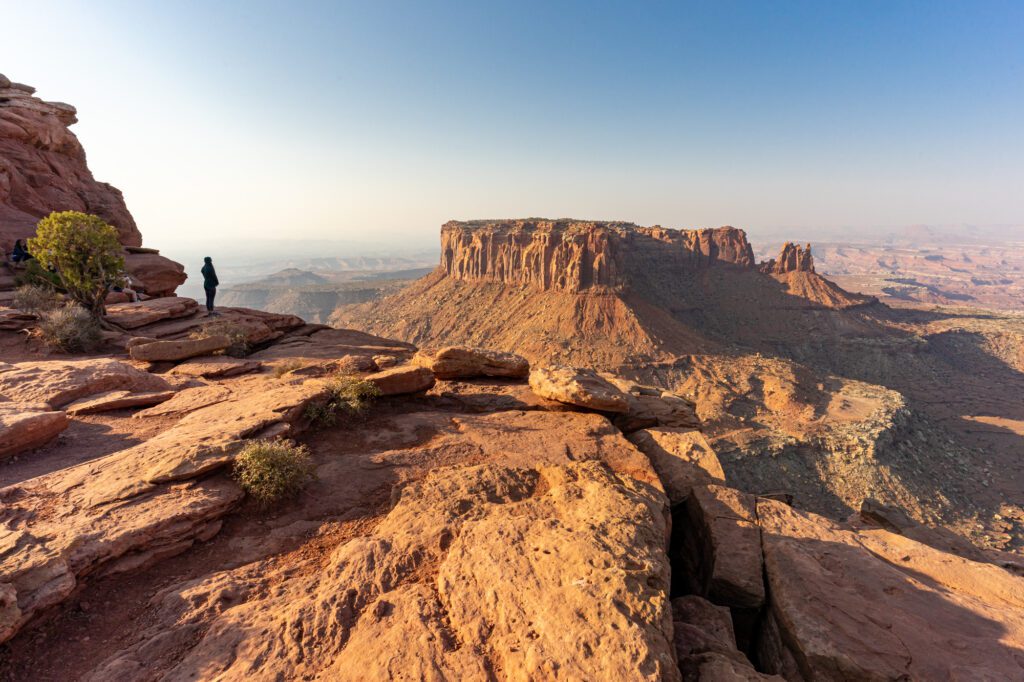
Next, head out to Grand View Point , which is another short stroll along the rim of the canyon that we DEFINITELY think you should do, no matter what. It’s mostly flat, with a little bit of up and down, but the end viewpoint is going to be well worth the small effort to get there.
The Scenic Drive
Grand View Point is at the end of the road, which means you can make the drive back towards the visitor center a scenic drive by stopping at all the viewpoints along the way.
The first stop, if you didn’t already tackle it, is the White Rim Overlook . We loved this short hike, and it’s worth mentioning again.

Make sure to also stop at the Buck Canyon Overlook and, our favorite viewpoint on the drive, the Shafer Canyon Overlook , which has amazing views of the canyon, and of the steep switchbacks of Shafer Canyon Road, which descend from the rim down to the plateau via tight switchbacks that I would be too terrified to drive myself.
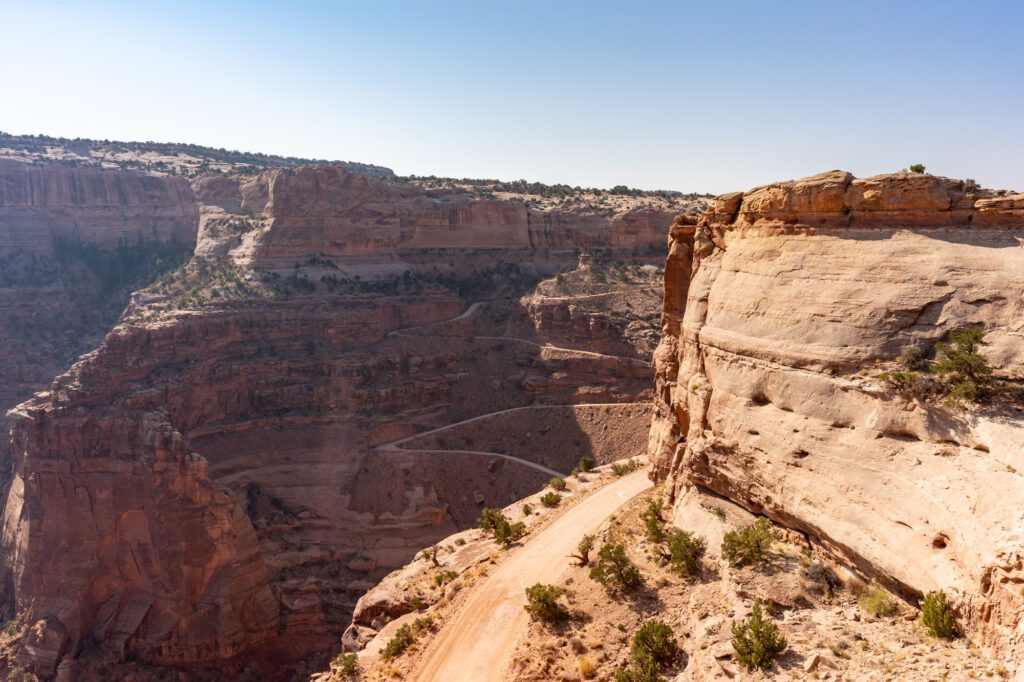
It’s also worth venturing out on the road that leads to Upheaval Dome, aptly named Upheaval Dome Road .
The turnoff is a little ways south of Shafer Canyon Overlook. Willow Flat Campground, the main campground in this part of Canyonlands, is out there, but stay on Upheaval Dome Road to get to Upheaval Dome, Whale Rock, and Aztec Butte – three great short hikes just off the road.
Day 4: Exploring Around Moab
Spend the morning and afternoon around Moab, exploring what we think are two of the best hikes in the area – neither of which are inside a national park – and then make your way over to Capitol Reef National Park.
Things Not to Miss Around Moab
Here are some things we really enjoyed near Moab (that aren’t within national park boundaries).
Corona Arch
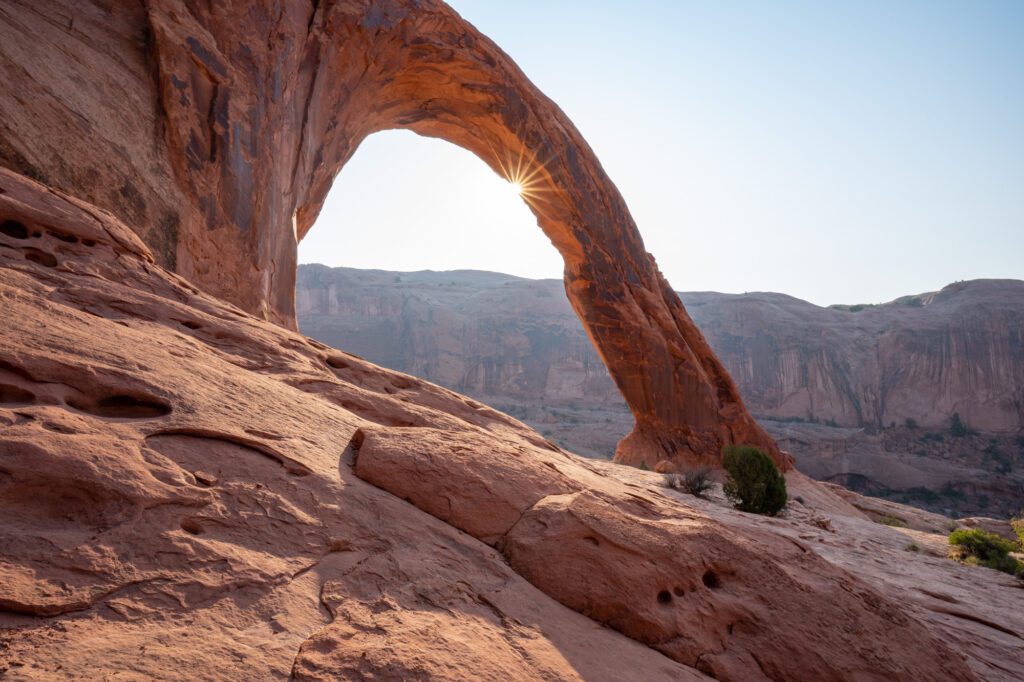
We did the hike out to Corona Arch at sunrise, and sat on a rock watching the light creep down, illuminating the arch about an hour after sunrise. Because of the rock walls here, we actually think the best time to be here is just after sunrise.
It’s only 2.5 miles long (round trip), but there are some sections of scrambling along slickrock, and a ladder that you have to climb. As long as you’re prepared with sturdy footwear, you should be fine, but you should know what you’re getting into before you leave the parking lot.
The arch itself is enormous, and is one of the more impressive arches we saw in Moab, including the ones in Arches (Delicate Arch and Double Arch might be the only two ahead of it).
The trailhead is along highway 279, just a twenty minute drive northwest of Moab.
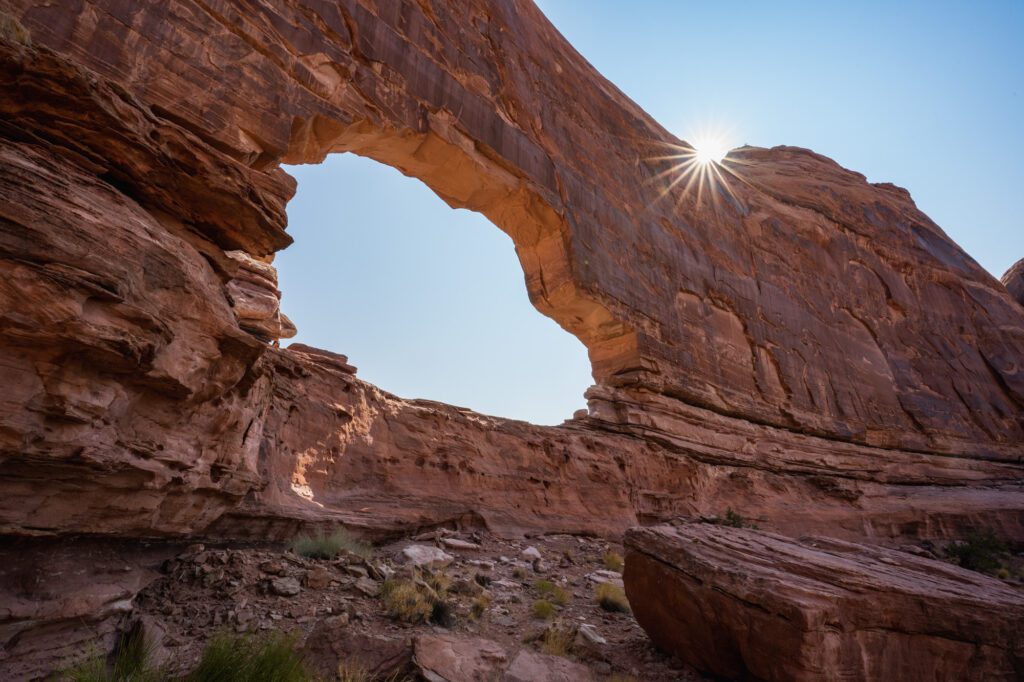
Just down the road from Corona Arch is another amazing hike that most people probably skip since it’s not inside one of the nearby national parks – and that’s Jeep Arch .
You’ll park in the small dirt parking lot along the road. We were there mid-morning after our hike to Corona Arch, and we were only the second car in the parking area.
This hike is a bit longer at 3.6 miles (1,000 ft. of elevation gain), and it is COMPLETELY exposed. No shade to speak of, except right at the base of the arch.
You’ll start by hiking up through the water pipe, which we didn’t realize on our way out and ended up hiking up to the railroad tracks, crossing the tracks, and then scrambling down the other side. Only to look through the other end of the pipe and say “ah, that’s the way you’re supposed to go.”
From there, you’ll follow a trail that is somewhat well marked by cairns across the rocky landscape, surrounded by the towering red rock walls of the canyon. It’s a loop, and after doing it both directions, we really don’t think it makes a huge difference which direction you go.

We will say that the arch will sneak up on you. We were very worried that we were going the wrong way because the map showed the arch just ahead of us, and we couldn’t quite see it yet.
It’s carved into the towering canyon wall, and if you squint, it looks a little bit like a jeep, hence the name (Matt’s not convinced).
Sunset at Dead Horse Point State Park
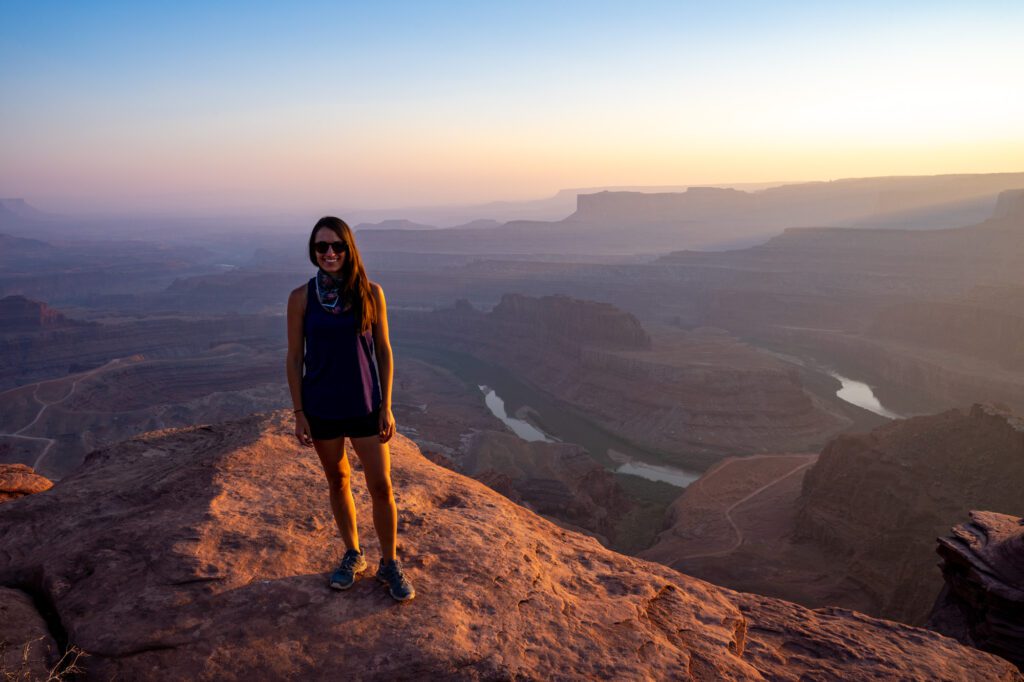
After a day of exploring Moab, head out to nearby Dead Horse Point State Park for sunset. Dead Horse Point is on the way back to Moab, which makes it a perfect last stop of the day before retiring to your hotel or campground for the night.
You’ll need to pay the entrance fee, since it is a Utah State Park and is not covered by your America the Beautiful Pass. It’s $20 a vehicle as of 2021 – double check the up-to-date fees here .
If you’re up for it and have some extra time before sunset, it’s worth doing one of the short hikes along the west rim. Our pick would be to park at the main parking lot and hike out to the Rim Overlook, and back along the rim to the parking lot, with a short detour to the Shafer Canyon and Meander overlooks along the way.
It’s about 2.5 miles there and back, and it’s flat.

After that, pick your spot, plop down, and watch the sunset over the canyon.
Day 5: Capitol Reef National Park

Be honest – before you started researching for this trip, had you ever heard of Capitol Reef National Park?
We hadn’t either.
But I understand why. Sandwiched between Arches and Canyonlands to the east, and Bryce and Zion to the west, it is the runt of the litter. Not that it isn’t a great stop and well worth your time, it’s just that the rest of the national parks in Utah are spectacular.
The most unique part of Capitol Reef in my book is the amount of green you’ll see. Coming from Moab, it’s pretty surprising to drive around a corner with red rocks towering above you and see… an orchard? Several orchards, actually.
And you can freely walk through them and eat the fruit in the late summer too! You have to pay if you want to take it to eat later though.
What Not to Miss in Capitol Reef National Park
Here are some things not to miss in Capitol Reef National Park.
Capitol Reef Scenic Drive

Stop at the visitor center to grab a map and a hiking guide, then it’s time to tackle the 10 mile scenic drive out to Capitol Gorge .
Take your time on the drive – it’s a gorgeous road through the red rock formations that are Capitol Reef’s specialty.
Eventually, you’ll arrive at the end of the paved road, where there’s a small parking lot and picnic area. If you continue on the dirt road, you’ll end up at the trailhead for Capitol Gorge , which is the beginning of a short one mile stroll through the towering canyon along the original path into the Fruita Valley.
Be careful with weather in the summer – afternoon thunderstorms and rain showers can cause flash floods, and you definitely don’t want to be stuck in the gorge during a flash flood.
Head back the way you came, making a right onto the dirt road that will take you to the Grand Wash Trailhead.
Cassidy Arch
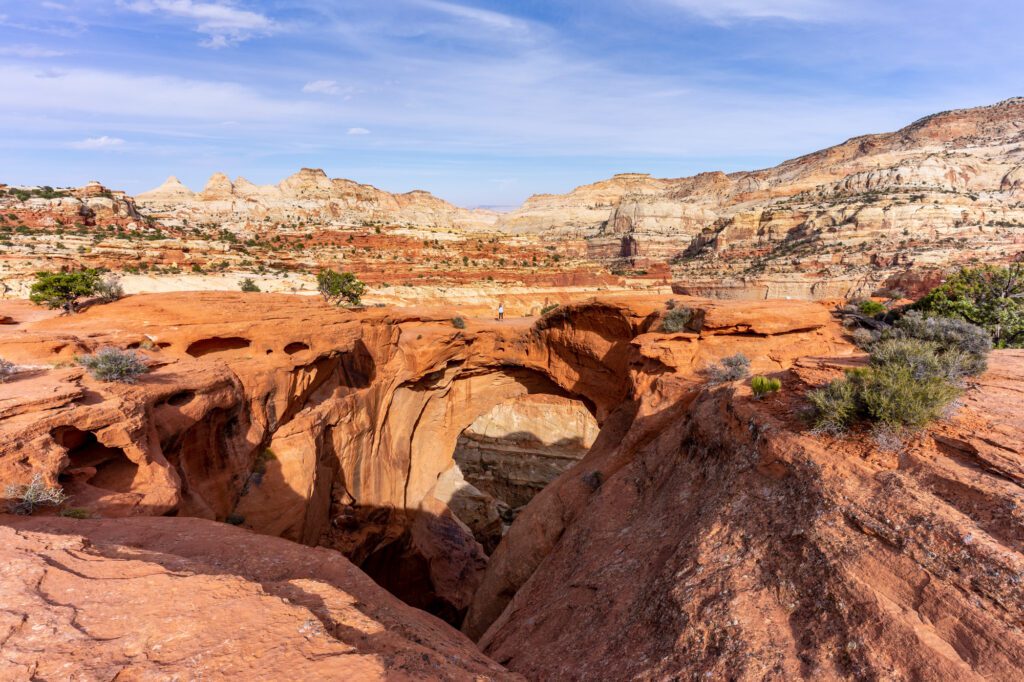
Head to the Grand Wash trailhead, which includes a short drive on a well-maintained dirt road, to hike to Cassidy Arch .
In high season, you might have to wait a few minutes to get a parking space, since the lot is small and the dirt road makes it hard if not impossible to park on the side of the road. The wait will be worth it – you’ll climb the wall of the valley to an arch that you can actually walk on!
It’s a steep climb up some stairs for the first bit of the trail, but it mellows out as you wind between the cairns (those are the little rock piles that mark a lot of the trails) up to the arch.
It’s a pretty stunning hike, as you’ll get views of the surrounding valley and beyond as you make the ascent. All in all, it’s a three mile hike with 660 feet of elevation gain.
You should know that it will be hot in the afternoon, so bring tons of water, snacks, sunscreen, and a hat for sun protection.
Hike Hickman Bridge + Rim Overlook Trail

We really enjoyed the hike to Hickman Bridge , which is another natural bridge (which is similar to an arch, but slightly different). It’s a short one mile hike up, and it’s another spot where the trail actually takes you up and through the arch, which is pretty cool.
From the Hickman Bridge, it’s another 2 miles to the Rim Overlook , which is an incredible hike that takes you to a high point on the canyon walls and looks over the entire valley. It was one of our favorite spots not only in Capitol Reef, but on our entire Utah road trip. Well worth the effort.

All-in, if you go all the way up to the Rim Overlook, it’s going to be between 5 and 6 miles, with a moderate elevation gain of about 1,000 feet.
Fruita and the Barn
Post-hike, head to Fruita and hit the Gifford House for a fresh baked fruit pie as a reward for finishing the morning hike. They don’t have gluten free options, so we ended up skipping the actual pies, but the historic Gifford House is worth a stop regardless.
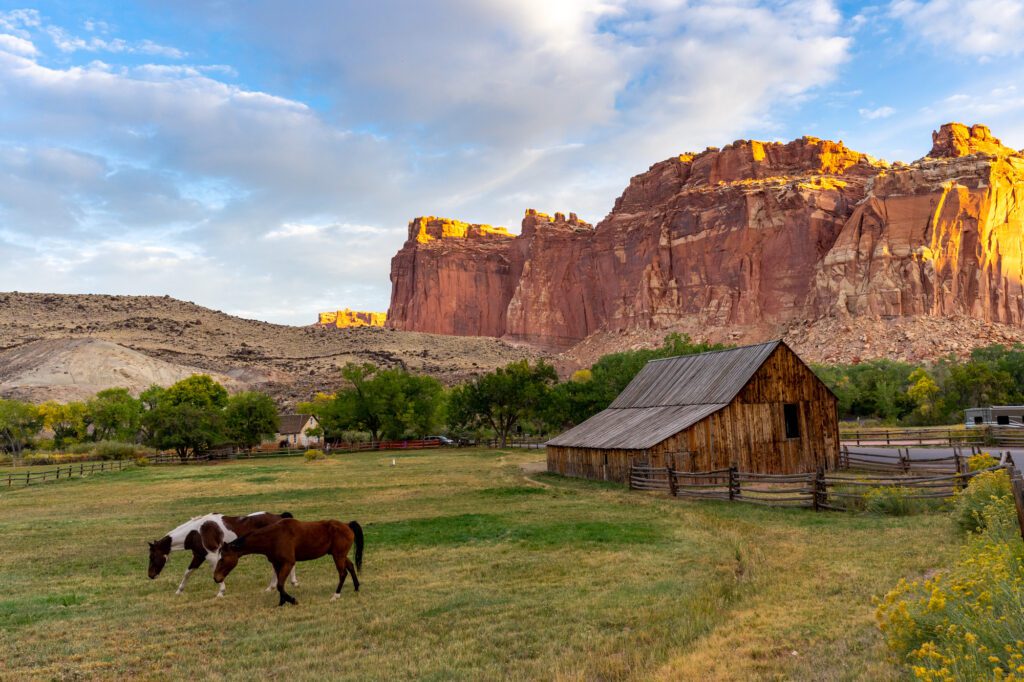
It’s a good representation of the original Mormon Settlement in Fruita Valley, though it has definitely been updated and renovated since it was built in 1908. Grab a mini pie and take it out to the picnic area outside.
Don’t miss walking up the road towards the campsite to get a picture of the Fruita Barn with the red rocks in the background – I love the contrast between the dry red rock canyon, and the lush field (with horses, if you’re lucky) where the barn stands. Super unique.
Sunset Point for… Sunset
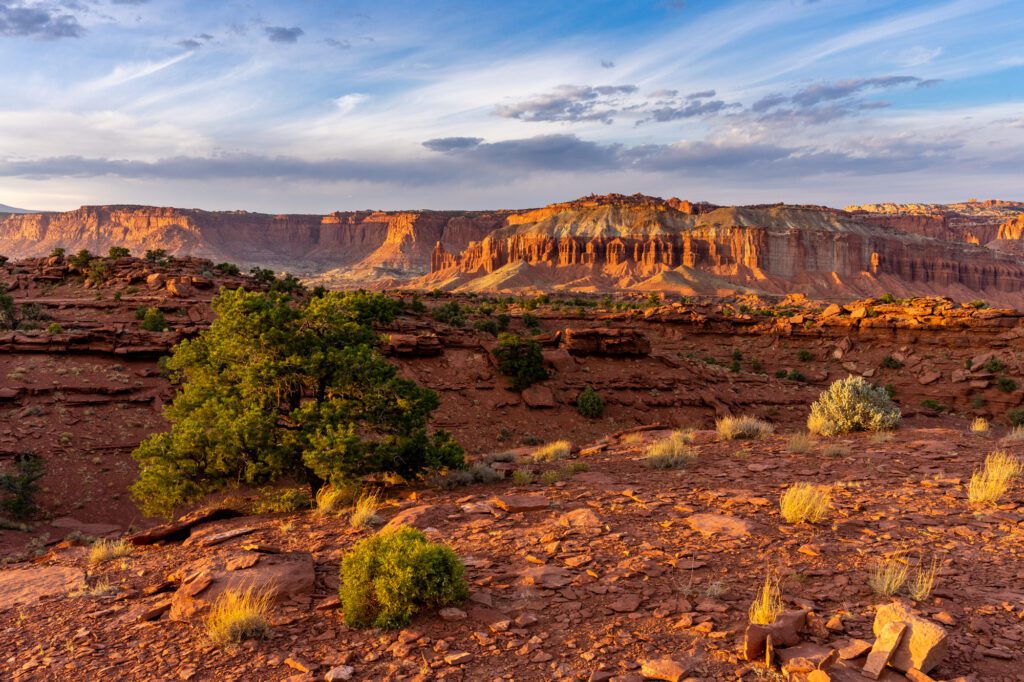
A little over an hour before sunset, head out to Sunset Point / the Goosenecks for the second most breathtaking panorama in the park (don’t worry, you’ll tackle the best viewpoint tomorrow morning).
The Goosenecks are an okay view of the river winding through the valley below, and they’re basically at the parking lot.
But the star of the show is Sunset Point , which has a view across the Fruita Valley with all sorts of interesting terrain as far as the eye can see.

It’s spectacular about a half hour before sunset, when the golden light brings out all the different colors in the surrounding landscape, particularly the red in the canyon walls. Here are a few pictures for you from our trip, if you’re not convinced.
Where to Stay at Capitol Reef National Park
There are really not many options near Capitol Reef – you can either camp inside the park, or stay in the nearby town of Torrey, Utah.
Camping in Capitol Reef

The best option, by far, is Fruita Campground , which is the only place to stay inside the park that you can reserve in advance. It’s a super nice campground, set in between red rocks and orchards.
We were discussing whether it was the nicest campground we’d stayed in on our four month road trip, and it’s definitely in the top five. Check availability here .
You could also stay at Cathedral Valley Campground , which is near the Temple of the Sun and Temple of the Moon, but it’s a journey to get there and it’s super remote with no amenities.
That being said, it’s free, so there’s that. Make sure you have a 4WD, high clearance vehicle or you’re going to have a bad time.
Hotels near Capitol Reef
You’ll have to head to nearby Torrey to find a place to stay that isn’t camping. It’s only about a 15 minute drive to the park entrance, so it’s a perfect stopover before heading onwards to your next stop, Bryce Canyon National Park.
As far as hotels and resorts go, the leaders of the pack are Capitol Reef Resort – which is also the closest place to stay near the park (and their two bedroom cottages have a kitchen) – and Red Sands Hotel .
Vacation Rentals near Capitol Reef
If you want a vacation rental with more space and access to a kitchen, there are a couple of good options around Torrey .
For couples, we like this cozy house .
For families and groups who need a bit more space, look at this modern two bedroom flat .
Days 6 & 7: Bryce Canyon National Park
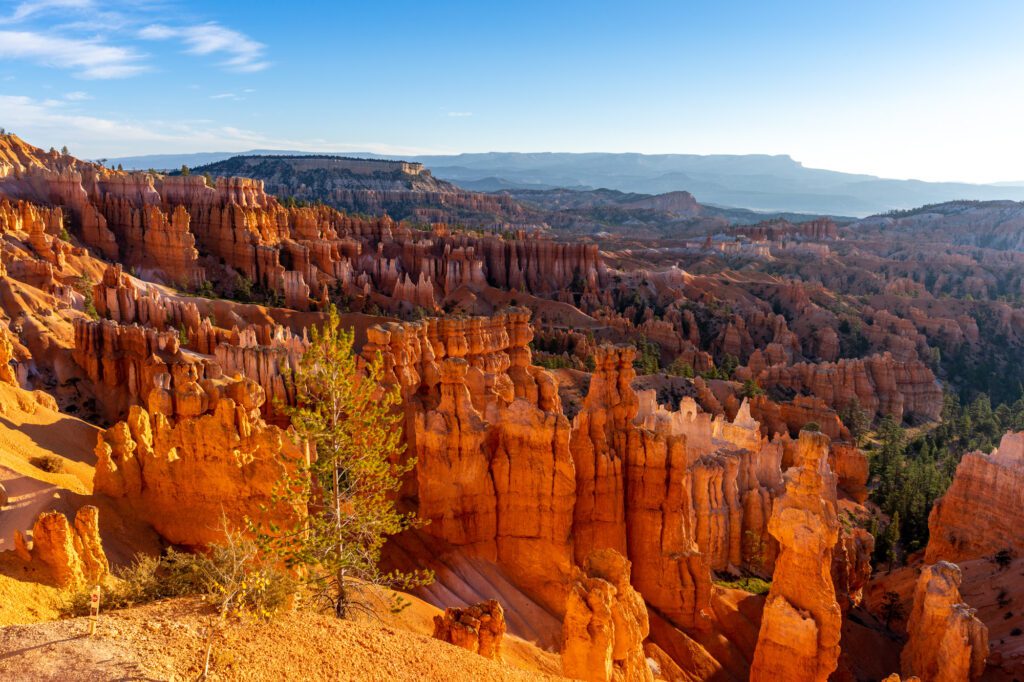
We spent two and a half days in Bryce Canyon, and I didn’t quite realize just how compact this national park is. Unlike places like Yellowstone and Yosemite, where you can literally drive for hours and still not leave the park, there’s essentially one 19 mile road that makes up the entirety of Bryce Canyon National Park.
Bryce Canyon really isn’t that big, so we think that a day and a half is enough to see the highlights.
For that reason, if you’re time constrained and only have ten days, I’d only spend one day in Bryce Canyon National Park , plus a portion of the next morning before driving to Zion.
If you’ve got more than 10 days, this is the first place I’d add time (an extra day would be perfect).
One thing you should know for Bryce that I didn’t know before my trip: the best light for photos is in the morning .
In the afternoon, the sun is on the opposite side of the canyon from most of the interesting stuff, which leads to long shadows that really mess with your pictures because of the extremes of light and dark in the photo.
In the morning, the sun lights up the hoodoos and other formations, making them that much more spectacular.
The Best Things to Do in Bryce Canyon National Park
Here are five things not to miss in Bryce Canyon National Park.
Sunrise at … Sunrise Point
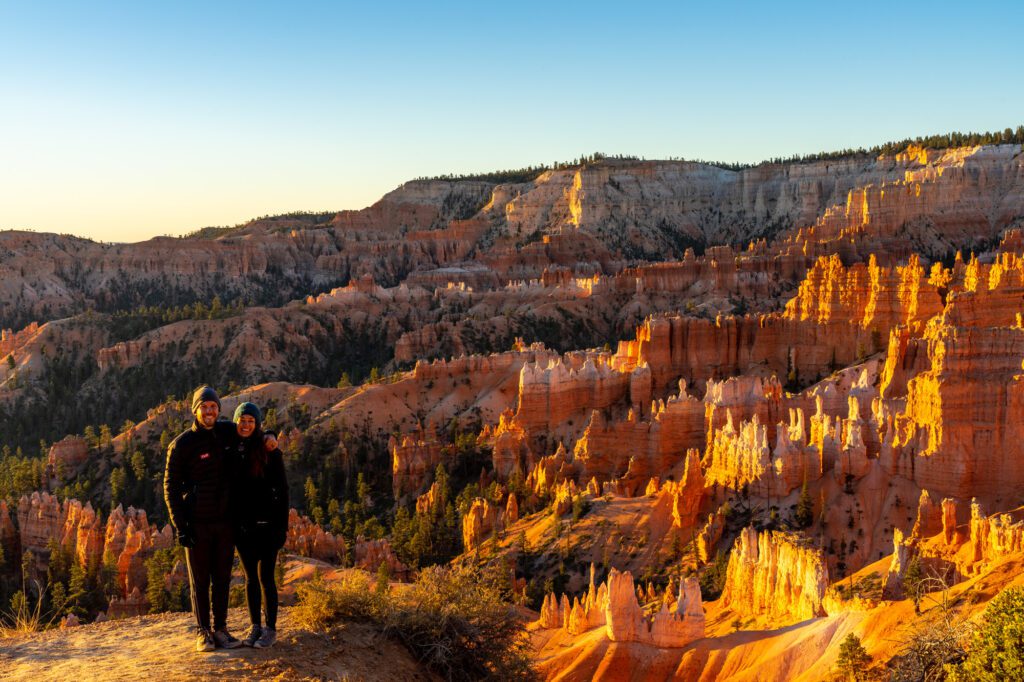
Start your time in Bryce Canyon with sunrise at Sunrise Point . This is a popular spot, so get there early.
You’ll have views of the hoodoos to your right, which is the direction you want to be facing, and the horizon on the left, which is where the sun will come up.
Again, it bears repeating, make sure to watch the rising sun light up the hoodoos – most people will be looking at the horizon to watch the sunrise, which would be a mistake!
As the sun comes up, it brings out all the different hues of the hoodoos, making for some spectacular photos.
Sunset Point and Thor’s Hammer

Next, walk along the rim to Sunset Point , which is another good viewpoint to see the hoodoos from a slightly different angle.
Hike down a little ways to get a good view of Thor’s Hammer , a unique rock formation that looks like the Marvel hero’s signature hammer.
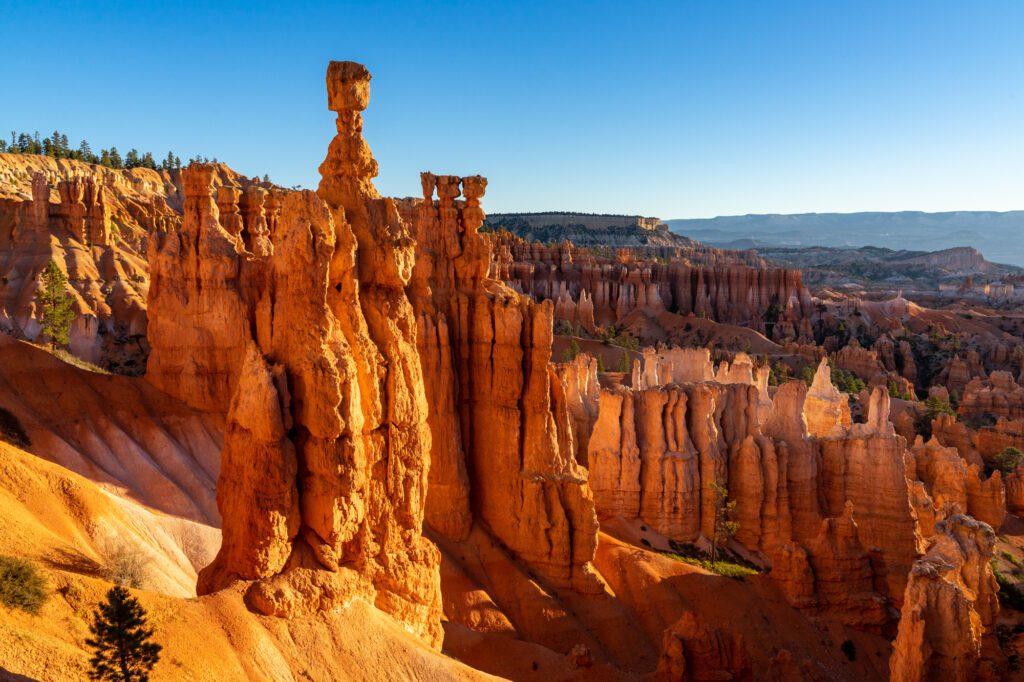
Hike the “Figure 8” Loop
After you’ve taken ALL the photos, you should embark on our favorite hike in Bryce Canyon – the Queen’s Garden / Navajo / Peek-a-boo Loop, which we’ll call the “Figure 8” loop because it sounds cooler and is less of a mouthful.

It’s a six mile hike with 1,500 feet of elevation gain. You’ll start at Sunset Point and end along the rim near Sunrise Point.
Make sure you’re fueled up with coffee and breakfast before heading out. To really take in the beauty and scale of Bryce Canyon, you HAVE to get below the rim. This hike takes you through canyons, between hoodoos, and to viewpoints with sweeping views of the magnificence of this park.
You’ll start by descending Wall Street – a set of (very photogenic) steep switchbacks that take you down, down, down into the canyon. Try to get started early, because this spot gets very, very congested.
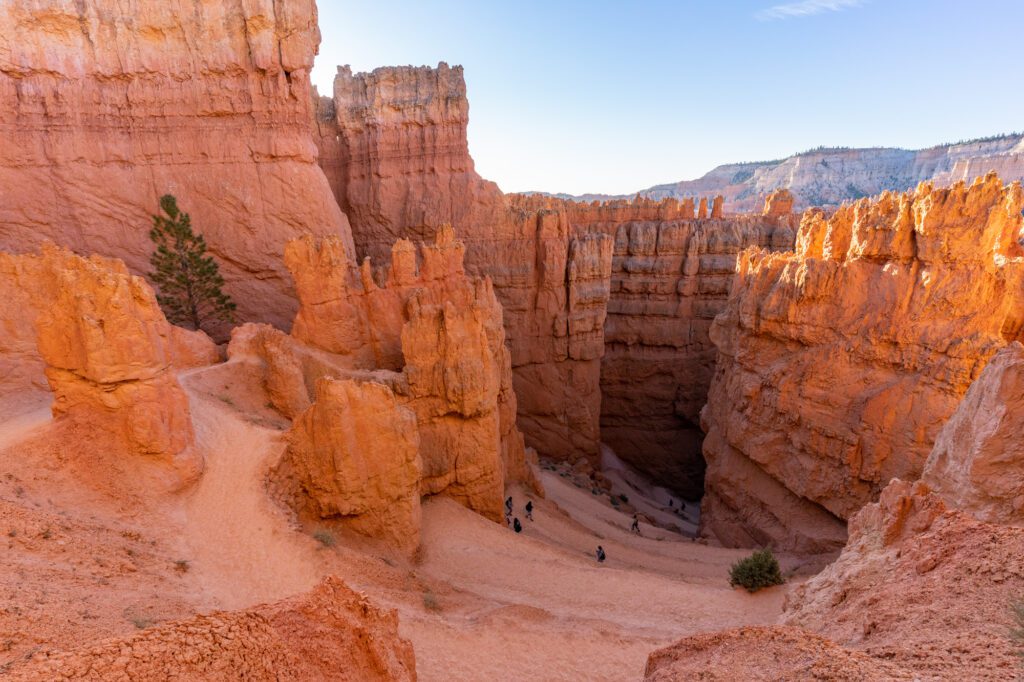
You’ll wander through the canyon for a bit before you reach a junction – veer right to tackle the peek-a-boo loop, ending back at the exact point you veered right. From there, you’ll climb back up to the rim of the canyon via the Queens Garden trail, which is not an easy hike, especially if it’s hot, but it’s totally doable for most people.
After the hike, take a break from being in the sun and eat some lunch to refuel, either a picnic lunch, or at the Bryce Canyon Lodge are your best options.
The Bryce Canyon Scenic Drive
One thing you definitely shouldn’t miss in Bryce Canyon is the scenic drive along the 19-mile road that runs from one end of the park to the other. It’s a good afternoon activity, and it will only take you about an hour or so.
Make sure to check out Natural Bridge and Bryce Point , our two favorite stops, and stop at any viewpoints along the way that catch your eye.
You’ll want to start this drive at least two hours before sunset, before the sun drops behind the canyon wall and takes all the color out of the hoodoos for the night.
Where to Stay Near Bryce Canyon National Park
There’s exactly one place to stay in the park (plus two campgrounds – scroll down to read about those) – the Bryce Canyon Lodge . The location is great, but it’s going to be expensive and it’s a little dated. That being said, it’s a solid choice if you want to stay in the park and aren’t on board for camping.
Staying Outside the Park
If you’re looking for more options, you’ll need to look outside the park to the towns of Bryce and Tropic .
The best place to stay to be close to the park is in the town of Bryce . It’s as close as it gets to the entrance of the park, and you’ve got a few options. Unfortunately, the selection isn’t great.
The Best Western Plus Canyon Grand is, by far, the best place to stay. I know what you’re thinking – “really Matt? Best Western? That doesn’t seem like you.” I hear you, believe me. I had the same reaction. But this is a NICE Best Western.
Tropic, Utah is another place you could stay, and it’s about 15-20 minutes outside the park entrance, which means it’s about 30 minutes from Sunrise Point, which is where you’ll start the next morning. Generally, Tropic is going to be the cheaper option between the two, but also the less convenient option.
Camping in and Around Bryce Canyon
There are two campgrounds inside the park.
Sunset Campground is the bigger of the two campgrounds inside the park. You’ll need to book well in advance, or be prepared to check the availability daily for a cancellation, which is how we ended up getting a spot for a night.
The location is great, right across from Sunset Point, which will mean you can walk over and skip dealing with the parking nightmare that is that parking lot in the morning. Oh yeah, and the bathrooms are heated, which I’ve never encountered before at a campground.
North Campground is basically right on the rim of the amphitheater, which also means that you will be able to leave the car at camp and walk to the two best hikes in the Bryce Canyon National Park (more on that in a second). There are 99 sites, and for 2023 (May through October) you’ll need to reserve in advance.
The best option for camping (and RV sites) outside the park is Ruby’s RV Park and Campground , which is where we stayed for the rest of our time in Bryce Canyon because we couldn’t get a reservation in the park.
Days 8 – 10: Zion National Park
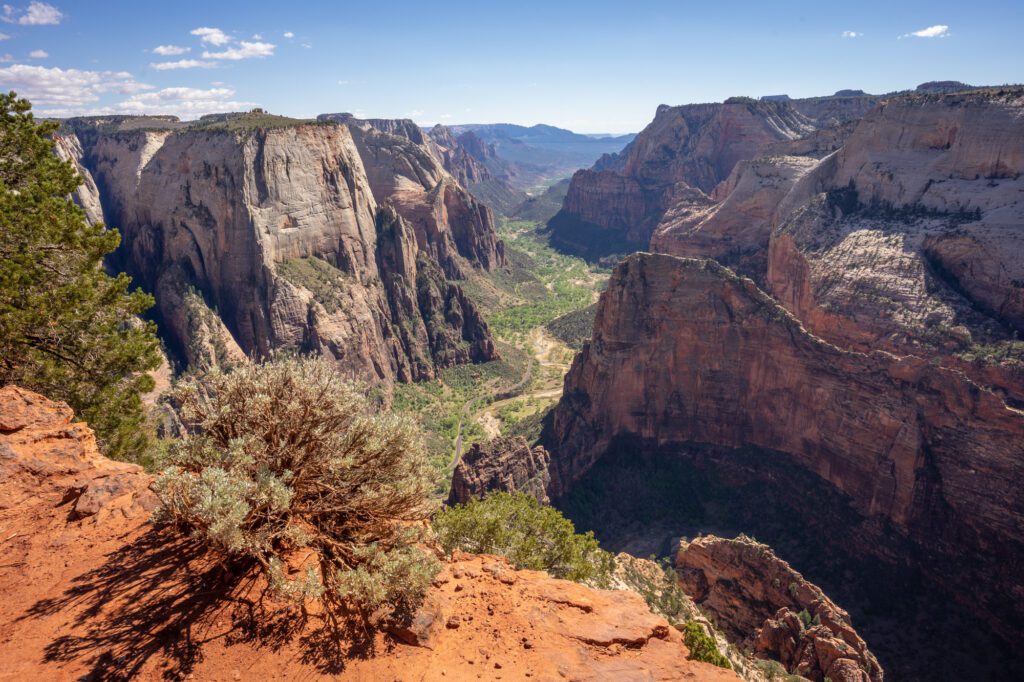
Zion is the park I’ve spent the most time in on road trips growing up, and finally we made it back in the spring to marvel at both the canyon itself, and the ingenuity that went into constructing the Mt. Carmel – Zion tunnel, and the trail up to Angels Landing.
Both were built during the Great Depression by the Civilian Conservation Corps , and are amazing feats of engineering, especially when you consider they were made almost a century ago.
Zion is one of the best national parks in the country, let alone Utah, so you’re ending your trip on a high note.
There’s tons to do and see, and two days in Zion is not nearly enough time to see all there is to see, but you can get a great taste of the park that will leave you hungry to return and spend more time exploring the canyons, rivers, and hanging gardens that make Zion a special place.
The best thing to do in Zion National Park, by far, is hiking. And there are two iconic hikes in the park that you should tackle – one on each day.
They are the Narrows and Angels Landing – you’ll do Angels Landing on Day 1, then the equally-iconic Narrows of the Virgin River on Day 2. In between, there are some great shorter hikes to tackle.
A note here for RVs and trailers: if your vehicle is higher than 11’ 4” or wider than 7’ 10”, you’ll have to pay a $15 “escort fee” to pass through the Zion-Mt Carmel tunnel (which you’ll have to do to get into the park from the east) which basically means that a ranger will stop traffic in the tunnel and make it one-way so that you can pass through to avoid accidents. More information can be found here .
The Best Things to Do in Zion National Park
Here are some of our favorite things to do in Zion National Park.
Hike Angels Landing

Get an early start on your first day in Zion to make your way out to Angels Landing (shuttle stop is the Grotto ). It is, along with the Narrows, one of the best and most unique hikes in Utah if not the entire western United States.
It’s only 5.4 miles long, but it’s a steady climb of over 1,500 feet, which is going to feel like A LOT at this elevation and temperature. Seriously, the trail starts flat for about a quarter of a mile, but then it starts climbing steadily for the rest of the hike up to Angels Landing.

You need to pack plenty of water (more than two liters per person), sunscreen, and a hat. If you’re afraid of heights, the tail end of this hike is going to test your willpower. You’ll need to do some scrambling and climbing with the help of chains, but the sweeping views at the top will make it all worth it.
However, you should know that we stopped before the serious part of the chains started. There are essentially two sections of chains – one that traverses the side of a ridge, and another that makes the ascent to the summit. We did the first section, and turned around before the second section.

It had rained the day before, which created a fine sand that coated every rock surface on the hike. We weren’t super comfortable with our footing as we were traversing the first set of chains, and the unbearable crowds didn’t help with the anxiety. Know that it is perfectly okay to stop and turn around if you’re not feeling comfortable. We did, and we regret absolutely nothing.
I mean it when I say to start early. It gets hot in Zion, and the last thing you want is to be stuck at one of the sections with chains waiting for a slow group to go up or down while you, quite literally, roast in the desert sun.
It’s going to take you most of the morning and part of the afternoon to do this hike. Afterwards, head to the Zion Lodge to eat lunch – either a pre-packed picnic, or a meal at the lodge’s cafe – and relax before tackling some other short hikes in the afternoon.
Note : in 2023, you need an advance reservation to hike to Angels Landing. It’s meant to control crowds, which we experienced and literally said to each other on the way down “they should really permit this hike.”
Sunset at the Watchman

This was one of our favorite hikes in Zion, though we did it at sunrise, when the light wasn’t at its best thanks to the towering rock wall behind you that blocks the sun from lighting up the Watchman.
That’s why we have it here, at sunset instead.

It leaves from the visitor center, and climbs pretty gently to a mesa that is directly across the valley from the Watchman, one of the most famous rock formations in the park. It’s a good spot to pack a picnic and a couple of beers after a long day of exploring.
Hike The Narrows
Today, hop on the shuttle early and head up the canyon to the Temple of Sinawava stop to do the ten mile hike (roundtrip) to the Narrows.
This hike is through a canyon and river, which means it is CRUCIAL that you check with the rangers about conditions and flash flood warnings before you start the hike . In the spring, heavy water flow from snow runoff might mean that this trail is closed.
Seriously, flash floods in canyons are no joke. Stop by the visitors center to make sure you’re good to go.
Don’t let that scare you – the hike through the Narrows is the #1 Zion experience that I think you should have on your trip.
The hike follows the Riverside Walk for the first bit, then continues on when that trail ends. You’ll pass through narrow canyons, deal with knee-high water, and do some bouldering en route to Big Springs, where the hike ends and you’ll turn around to head back the way you came.
It’s going to take you five to six hours, maybe more. To make it as smooth as possible, bring plenty of water, tons of snacks, proper footwear (not flip flops – either hiking sandals like Chacos , or real hiking shoes), a dry bag , and a pair of trekking poles for stability.
After that, recharge for a second and catch your breath. Maybe take a nap. It has been a whirlwind of a couple of days!
East Zion Scenic Drive
The eastern side of Zion National Park is one of the more unique landscapes in the country. Checkerboard Mesa, in particular, is pretty impressive. It’s a huge, textured cone-like formation that has checkerboard textures all over its surface.
The drive through the eastern side of the park, from the East Entrance to the tunnel, is spectacular. You should do it in the late afternoon if you can, so that you’re well-positioned to do the Canyon Overlook Trail at sunset.
The Canyon Overlook Trail
Parking for this one is a bit of a pain due to all the people vying for a very limited number of spots. You’ll need to park along the road and walk to the trailhead.
The hike itself is short, but a little steep, and takes you up to a spectacular view out over the canyon. Below, you’ll see the road switchbacking its way up to the tunnel, and the iconic, impressive rock formations of Zion Canyon across the valley below.
Last light on the canyon from the setting sun is amazing, and it’s worth hanging out up here for a bit until after sunset.
Where to Stay near Zion National Park
Unlike a place like Capitol Reef, where it’s hard to find a place to stay that’s close to the park, Zion has some great options nearby in Springdale, Utah .
Whether you’re looking for a campground or you want a comfortable hotel, there are plenty of great places to stay near Zion.
Inside the park, your options are splurging on a lodge room or private cabin at the iconic Zion Lodge , or snagging a campground at either Watchman Campground (we stayed here and it’s great) or South Campground .
Both are walkable to the visitor center, which is where you’ll need to catch the shuttle if you’re here between March and November.
In Springdale , which is immediately outside the entrance to the park, you’ve got a wide range of options, from budget to bougie. Here are some picks based on what you’re looking for.
- On a budget : I have stayed at the Holiday Inn Express , and it’s nicer than most Holiday Inns, and there’s a shuttle that will take you to the park entrance right outside the front door. The Best Western is another option, and it’s slightly closer to the park entrance.
- Mid-Range : I love the cottages at the Red Rock Inn Cottages , and that’s where we would have stayed if we weren’t camping. Flanigan’s Inn is an eco-friendly hotel with nice rooms, a beautiful property, and a great onsite restaurant. The Desert Pearl Inn is a good choice if you need a kitchen (and the rooms all have nice patios overlooking the pool).
- Best of the Best : The Cable Mountain Lodge is the best place to stay near Zion thanks to its location RIGHT OUTSIDE the park entrance. It’s a nice boutique hotel, so it’s not the cheapest, but it’s worth every penny for the location alone. In the same complex, there’s a small grocery store, a coffee shop, a brewery, and an outfitter that rents bikes and gear for the Narrows if you need it.
You could also stay in a vacation rental in Springdale , which there are plenty of. That’ll give you more space to spread out and relax, which is particularly helpful if you’re traveling with a group. Nobody wants to cram four people in a small hotel room with two queen beds.
For a once-in-a-lifetime glamping experience, stay at Zion Under Canvas . It’s a little further out – 45 minutes from the South Entrance – but it’ll make up for the distant location with the superb facilities.
They have a range of options – from simple “safari tents” that are basically a bed with a shared bathroom (they’re single-occupancy and nice, though) to “Stargazer” (private bathroom and deck!) and Suites. Some even come with a separate kids tent – perfect for families.
Psst ! We have a whole guide dedicated to helping you find the perfect place to stay at Zion National Park – you can read it here .
What to Do with More Time in Utah
Here are three things to add to your Utah itinerary if you are lucky enough to have some extra time.
Grand Staircase Escalante National Monument
Time required : 1 full day
Before heading to Bryce, it’s well worth a stop in Grand Staircase Escalante National Monument , home of some of the best slot canyons in Utah that don’t require a permit lottery to access.
The best way to do it is to tackle one or two of the hikes (if you’re ambitious) on the way to Bryce Canyon, staying overnight either in nearby Boulder, Utah, or completing the hikes and heading into Bryce at the end of the day.
There are at least three hikes that are worth your time in this area, and which ones you choose basically depends on your ability to navigate a long dirt road with some questionable spots for passenger vehicles and your willingness to navigate tight spots in slot canyons.
The road to get to the trailhead for Peek-a-Boo and Spooky Canyons is a 26-mile long dirt road called “Hole-in-the-Rock Road”. It’s passable in a passenger vehicle, but you’ll need to take it slow and it’s going to take you about an hour. I’d recommend a 4WD, high clearance vehicle to get to the second two hikes on the list.
We skipped them all because Homer, our Honda Odyssey, was sick of unpaved roads after some misadventures in the Pacific Northwest.
Here are those three hikes, with a short description of each.
- Lower Calf Creek Falls (6 miles roundtrip): This is right along Scenic Byway 12, which means you don’t have to survive a dirt road to get to the trailhead. It’s a lovely hike through a surprisingly green canyon to a 126 foot waterfall, Lower Calf Creek Falls, which is in a grotto-like setting. Bring a swimsuit on a warm summer day to take a dip in the pool underneath the falls.
- Zebra Slot Canyon : This trail is not always accessible, since the entry point fills with water after storms. But if it hasn’t rained in a while, it’s a worthy five mile trip. I haven’t personally done it, but I’ve seen plenty of pictures on Instagram of the wave-like textures in the Zebra slot.
- Peek-a-Boo and Spooky Slot Canyons : This hike includes a 15 foot climb on rock walls, and a 20 foot descent with assistance from a rope, along with some very tight spots (12-18 inches wide) through a slot canyon. We didn’t make it here because the 26 mile long dirt road scared us and our minivan off, but I’ve heard from family members and friends who have done it that it’s amazing. The reward is two of the best slot canyons in Utah, which means it’s a busy trail. Be careful in slot canyons if there’s an incoming rainstorm – flash flooding is no joke.
If you’re looking for an awesome overnight backpacking trip, look no further than the 11.5 mile journey to Coyote Gulch . It has quite a bit of elevation gain, which makes it a little much for a day hike. But the destination is pretty epic. Permit information here .
If you’re not up for the 26 mile drive on a dirt road, do the hike to Lower Calf Creek Falls on the drive from Capitol Reef, then head to Bryce Canyon National Park that night.
Add a Detour into Arizona

Time required : 3-4 days
If you’ve got two weeks and you’re looking for a great addition to your Utah road trip adventure, a mini Arizona road trip would be a great option.
Zion is just two hours away from Page, Arizona, which is home to two amazing natural wonders – Horseshoe Bend (you’ve probably seen it on Instagram) and Antelope Canyon .
Horseshoe Bend is a giant picture-perfect bend in the Colorado River that makes for an amazing sunset location, while Antelope Canyon is one of the most picturesque slot canyons in the Southwest, but is only accessible by guided tour (check out this company , which is Navajo-owned).
On the way to Page, make a stop at Paria Canyon to hike to Buckskin Gulch. The Wave is also here, in Vermillion Cliffs National Monument, but you’ll need to apply in advance to get a permit to hike it. More information here .
After Page, continue on to the South Rim of the Grand Canyon, and spend two days at the Grand Canyon in constant awe over the natural beauty and scale on display. Make sure to drive Desert View Road at sunset , hike the South Kaibab Trail , and catch sunset at Hopi Point along Hermit Road while you’re there.
From the Grand Canyon, it’s a four hour drive west to Las Vegas. You’ll pass by Hoover Dam along the way, which is worth a stop for the sheer scale of the dam.
Cedar Breaks National Monument
Sitting just north of Zion (an hour and a half drive) is Cedar Breaks National Monument. It’s even higher than Bryce Canyon at 10,000 feet above sea level, which means the ecosystem is very different from most of the places you’ve seen so far in Utah. It’s most similar to Bryce Canyon, with its orange-tinted rocks and ponderosa pine forests.
It’s also shaped kind of like Bryce, forming an amphitheater, but unlike Bryce you can’t hike below the rim because it’s steep and dangerous. As a result, there aren’t a whole lot of long hikes here, so a half day is probably enough time.
Similar to Bryce, morning is the best time to be here for the light since the sun sets behind the canyon and mid-afternoon it’s shrouded in darkness. While you’re there, make sure to hike both the South Rim Trail and the Alpine Pond Trail . Both are short and relatively easy.
How to Plan a Shorter Utah National Parks Itinerary
If you have less time in Utah, like we mentioned above, rather than trying to fit in the entire Mighty Five Circuit, we’d opt for spending 7 days exploring EITHER Zion and Bryce OR Arches, Canyonlands, and Capitol Reef.
The first itinerary might look something like this (you’ll want to fly in and out of Las Vegas for this one).
- Day 1 : Arrive in Las Vegas, drive to Zion
- Day 2 : Zion National Park
- Day 3 : Zion National Park
- Day 4 : Bryce Canyon National Park
- Day 5 : Bryce Canyon National Park
- Day 6 : Day trip to Grand Staircase-Escalante (Calf Creek Falls)
- Day 7 : Drive Back to Las Vegas
If you’re more interested in spending your time in and around Moab (which is where you’ll find Arches and Canyonlands), here’s what it might look like.
- Day 1 : Arrive in Salt Lake City / Moab
- Day 3 : Arches National Park
- Day 4 : Canyonlands National Park
- Day 5 : Around Moab
- Day 6 : Capitol Reef National Park
- Day 7 : Drive Back to Salt Lake City / Moab
The Best Time to Visit the Utah National Parks
In general, we think fall and spring are the most pleasant times to be in Utah (we were there in October and April, and it was lovely).
Visiting in the Fall and Spring (March – May / September – October)
Fall and spring in southern Utah, which is where the national parks are, are fairly similar. We’ve been in both October and April over the past year, and both were very pleasant times to be there. However, the weather is certainly more unpredictable than the summer – it was 80 degrees and sunny one day, and then snowed the next day on our trip in April.
On our road trip to the Mighty Five in the fall (October), we found temperatures in the 70’s and 80’s during the day, and between 50 and 60 degrees at night. This varies by park – Bryce Canyon is at 8,000 feet above sea level, and is much cooler than Arches and Canyonlands, for example.
The parks are still busy, so you’ll need to reserve things early – it’s actually still considered high season.
Visiting in the Summer (June – August)
Summer is crowded and blazing hot. In the United States, a lot of families plan summer vacations because that’s when the kids are out of school. The result? Parks are packed, camping reservations are few and far between, and good luck getting a parking spot at the most popular trailheads in the park.
Usually, the weather is the most predictable in the summer, where it’s often warmer and drier than other times of year. There’s also going to be afternoon thunderstorms, which are a phenomenon that we’ve run into multiple times in the southwest and in Colorado.
Summer isn’t the best time to visit Utah’s Mighty Five national parks. You’ll find unbearable temperatures in the heat of the day, often reaching over 100 degrees, which basically means you can’t do much during the middle of the day. You’ll need to plan on being out early in the morning and late in the afternoon and drink plenty of water.
That being said, I’ve been on two separate versions of a Utah road trip in the summer growing up, and I’m still here. It’s doable, but not preferable.
Visiting in the Winter (November – February)
In the winter , the parks are basically empty, but it’s going to be freezing cold. You might even get a little bit of snow, which is a particularly beautiful way to see the Mighty Five in Utah. Pack a warm jacket (we basically wore this jacket every night on our road trip) and some long underwear and you’ll be fine.
It’ll be in the 30’s and 40’s during the day, and drop below freezing at night. You might even get treated to a nice dusting of snow covering the parks, which is stunning. If you’re planning on visiting in the winter, I’d avoid camping (although we’ve camped in Yellowstone when it was below 20 degrees before) and plan on staying in hotels and vacation rentals along the way.
The best part? You won’t have to brave the crowds – you’ll have the major sights virtually all to yourself. The worst part? Some roads and hikes might be closed due to snow and ice, so you might miss out on an experience or two.
Matt is the founder and main writer behind Wheatless Wanderlust, which he started back in 2018 as a way to share his gluten free travel guides with his fellow Celiac travelers.
Since then, Matt and his wife Alysha have visited 18 national parks, spent three months in Europe and six weeks in Colombia, and have explored every corner of the Pacific Northwest, which is where Matt grew up.
He writes super detailed guides to the places they visit, bringing together personal experience and historical context to help YOU plan an amazing trip.
This has been by far the most imformative review I have ever had the pleasure of reading on any vacation. Awesome, Thank you so much for the detailed description and personal tips. This is helping us plan for our trip next summer, I’m taking some of your advice and hope for a great trip with out teenage boys. Thanks again
Hey Paul, thanks for the kind words! Glad you found it helpful – we plan (and pay for) all of our own trips, so we do our best to include all of those important tidbits that come from personal experience on a route. You’re going to have an amazing trip next summer. Cheers!
Hello Matt and Alysha – this site is amazing and full of info. My hubby and I and another couple are thinking of visiting Utah from Wisconsin. Our plan is to drive from home so no flying. We are all retired. If we visit in April are hotel/motel reservations still necessary? My thoughts are traveling ‘on the fly’ so to speak and when we are tired we stop and get a hotel room. Possible? Thanks.
Hey Pam! April is actually high season for the Utah parks, so yes you will probably want to reserve in advance. With the huge rise in number of visitors at national parks over the past couple of years, it’s really tough to do it “on the fly” these days between hotel reservations and park entrance permits (those haven’t quite hit the Utah parks yet, but I imagine they’re coming at some point!). Enjoy!
Leave a Reply Cancel reply
Your email address will not be published. Required fields are marked *
This site uses Akismet to reduce spam. Learn how your comment data is processed .
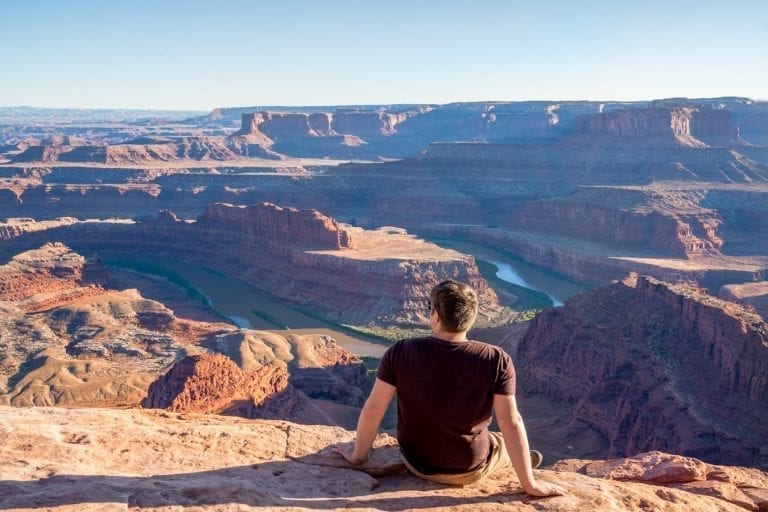
The Ultimate Utah National Parks Road Trip Itinerary
With its otherworldly landscapes, Mighty Five national parks, fascinating slot canyons, and its seemingly endless number of state parks and other beautiful natural spots, Utah is, without a doubt, one of the most unique states in the USA–and nothing puts that uniqueness on display quite as well as a Utah national parks road trip.
Utah was made for road tripping: there is no shortage of dirt roads to meander down, quiet corners to explore, stargazing to enjoy, and iconic landscapes to seek out.
We’ve taken several road trips in Utah at this point, and every time we visit, we end up even more enchanted with a state whose landscapes encompass the word “otherworldly” so perfectly that I will no doubt overuse it in this blog post.
Planning your first (or third) Utah Mighty Five road trip and want to make sure you make the most of your time in southern Utah?
We have you covered: t his Utah national parks road trip itinerary covers all of Utah’s Mighty Five national parks, along with several state parks, small towns, and interesting side trips.
Here’s how to structure the ultimate road trip through Utah’s national parks!
Table of Contents
How We Structured This Utah Road Trip Itinerary
Getting around during your utah national parks road trip, getting to utah’s mighty five (where to fly into + out of), other places to add to your utah national parks road trip, essential tips for a utah mighty five road trip, southern utah road trip itinerary map, what to pack for a utah road trip.
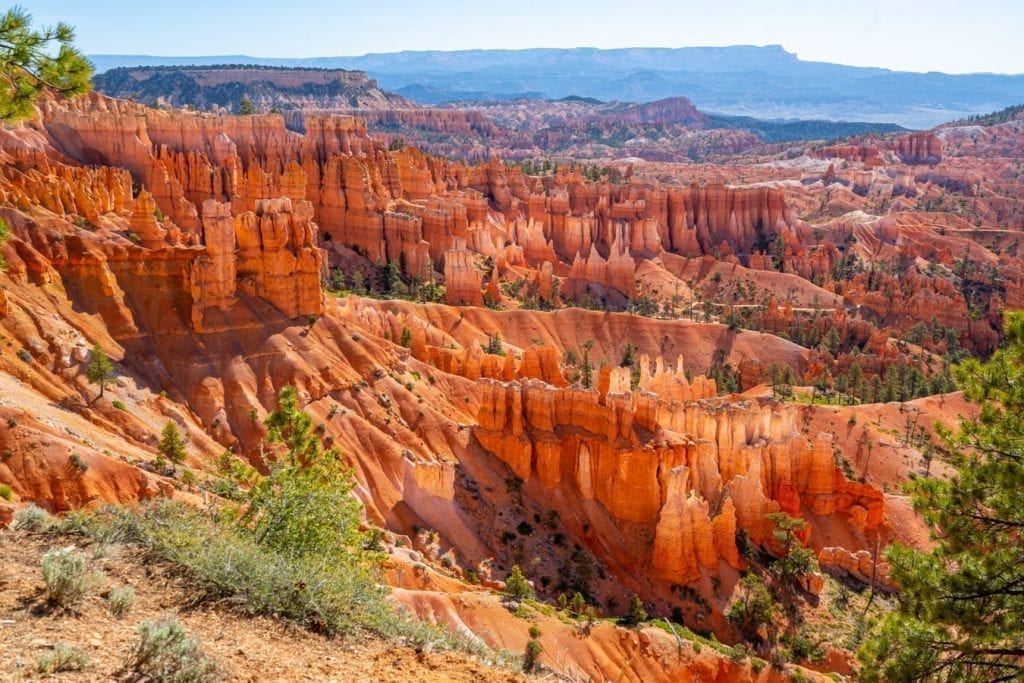
Some links in this post may be affiliate links. If you make a purchase through one of these links, we may earn a small commission at no extra cost to you. Please see our disclosure policy for more detail.
We structured this Utah road trip itinerary not as a loop, but as a trip with different starting and ending points.
Since this Utah national parks road trip takes place in primarily very rural areas, you’ll need to get yourself to the starting point of Moab if you fly into the region–we’ll cover more on how to do that later–and back to the airport (or a different airport) from Zion National Park after your trip is over.
Later, we’ll also cover possible additions to this road trip, including in neighboring states, if you’d like to consider turning your trip into a Utah and Arizona road trip or even a general southwest road trip .
This blog post is quite long, so feel free to use the table of contents above in order to navigate through different sections!
We also have many, many more blog posts about exploring Utah’s national parks and the southwest in general here on Our Escape Clause.
While we’ll link them throughout the post, you can also use the search bar in the top right of the screen (on desktop) or on the pop-out menu (on mobile) to search for blog posts about various parks and topics!
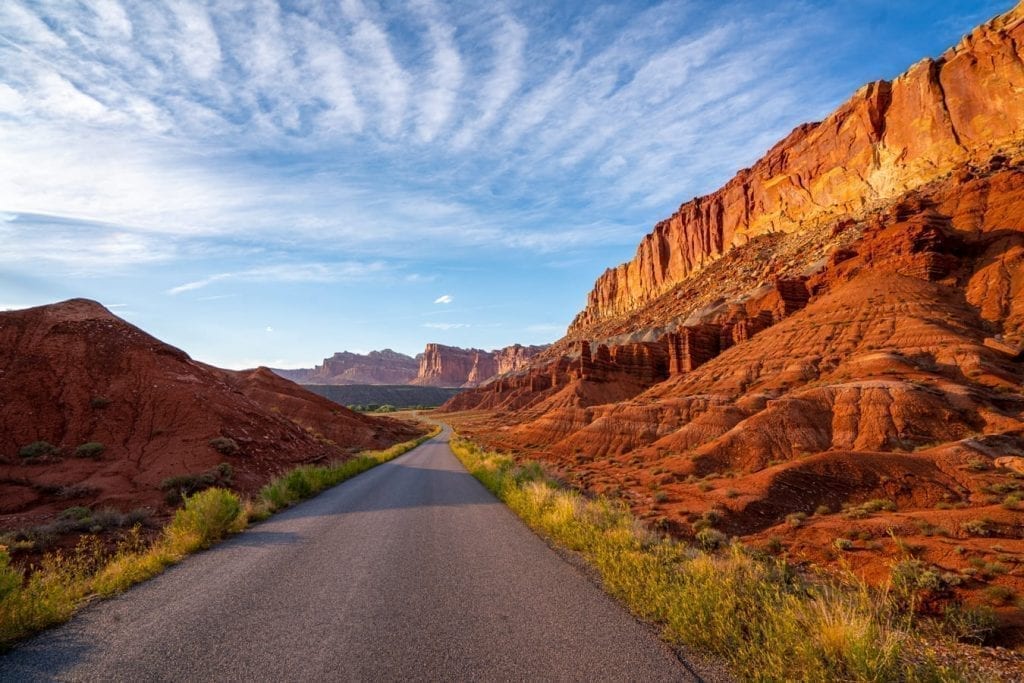
If you’re planning to rent a car for your Utah road trip, the best company to rent from will likely vary dramatically depending on exactly when you’re traveling.
Sometimes large international carriers offer the best prices, sometimes local outfits.
Sometimes one company has an excellent base price, but terrible rental requirements.
The best way to find your rental car is to search through Discover Cars , which will sift through dozens of companies to find the best combination of low prices and reasonable rental terms for your road trip.
We’ve taken several road trips in the southwest over the years, and have never used or needed a 4-wheel drive–but if you want to get far off the (literally) beaten path, you may want to consider renting one!
Check rates & book your rental car for your Utah Mighty 5 road trip!
We have offered suggestions for the best hotels in each place but if you are doing this as a true road trip it is really cool to do it in an RV. You can rent incredible RVs and camper vans from Outdoorsy, book here for your next road trip!
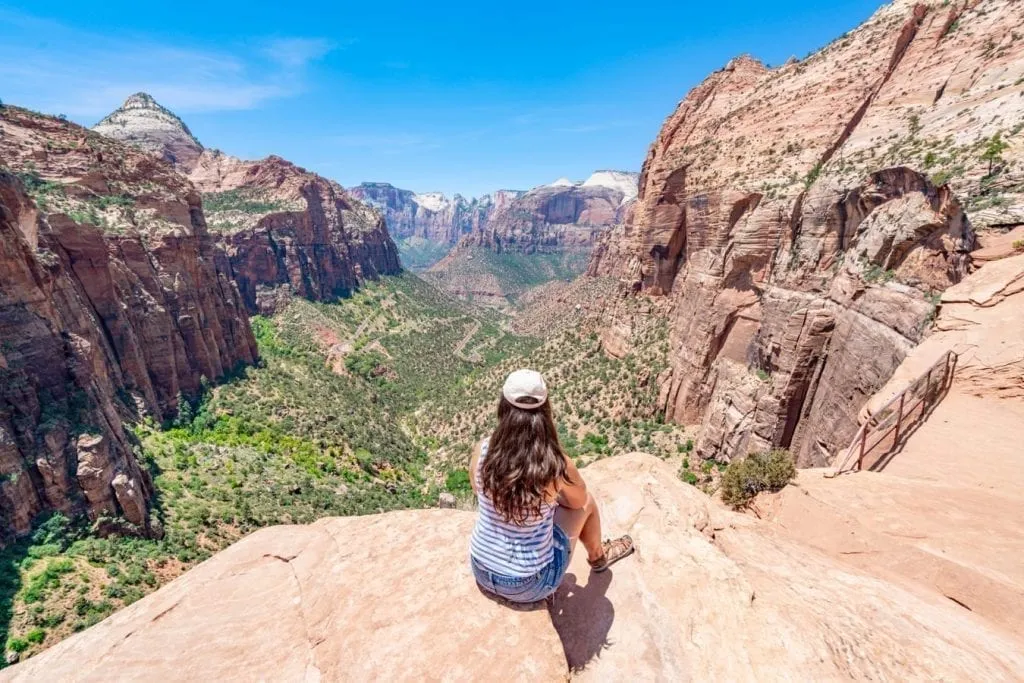
The Utah national parks road trip outlined here takes place over 9 days.
In other words, it takes just enough time to take one week off of work and make a trip through the southern part of the state at breakneck speed, which is similar to what we did on our very first Utah road trip back in the day (no regrets).
However, any of Utah’s Mighty Five national parks could easily soak up more time, so if you have more days to work with, you’ll definitely find plenty to do!
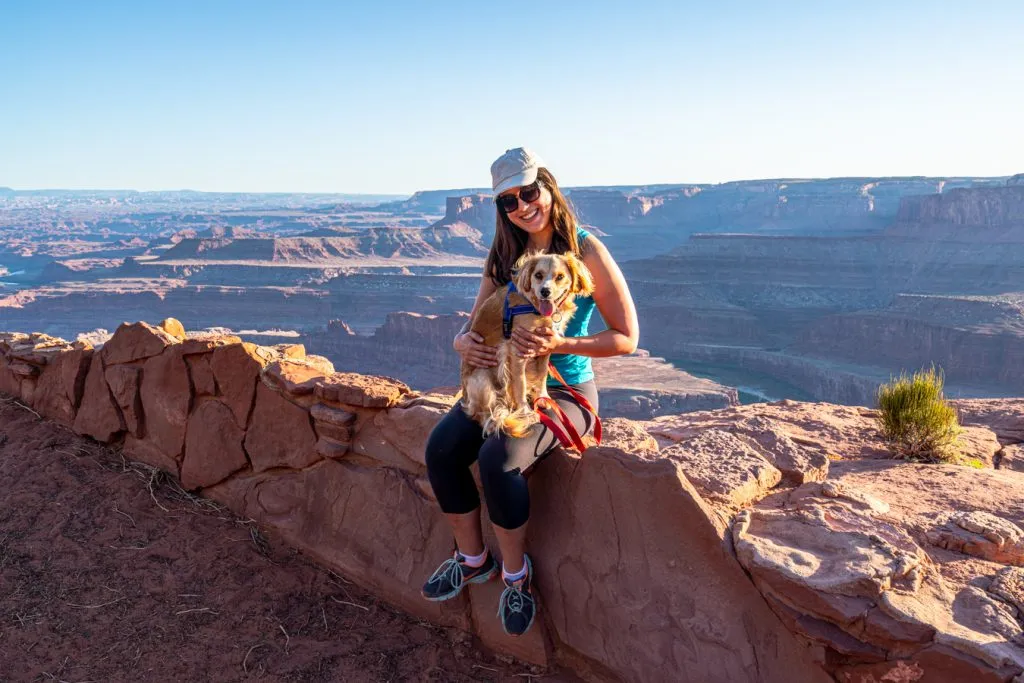
Day 1: Kick off your Utah National Parks road trip in Moab.
Moab is the perfect starting place for your Utah road trip itinerary!
This small, outdoorsy town in southeastern Utah is perfectly positioned to access not one, but two of Utah’s Mighty Five national parks, as well as state parks and other highlights!
If you get into town early enough, consider spending the afternoon and evening kicking off your explorations of Arches National Park, which is located just outside of town!
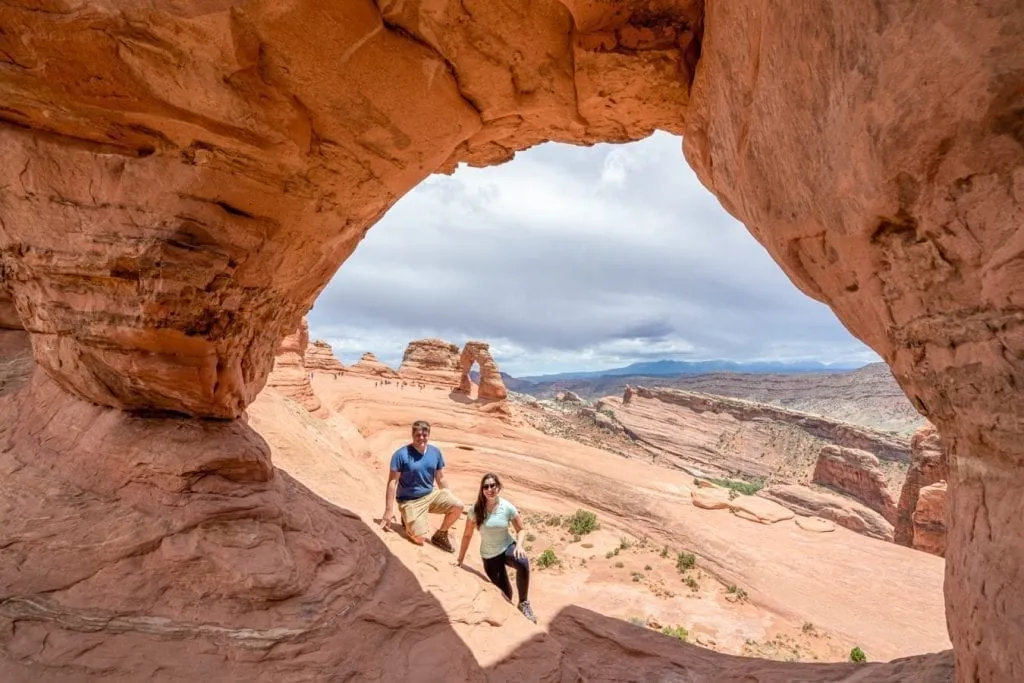
Where to Stay in Moab
Moab has plenty of hotels and motels to choose from, but fair warning–it’s one of the priciest destinations covered during this road trip, so don’t expect to nab a great deal during high season!
Red Stone Inn — Centrally located in Moab, the Red Stone Inn feels like a callback to another era of American road trips.
If you’re looking for an inexpensive slice of Americana, the Red Stone Inn is a great option–and the swimming pool and laundry services located on-site are a selling point, too.
Check rates & book your stay at the Red Stone Inn!
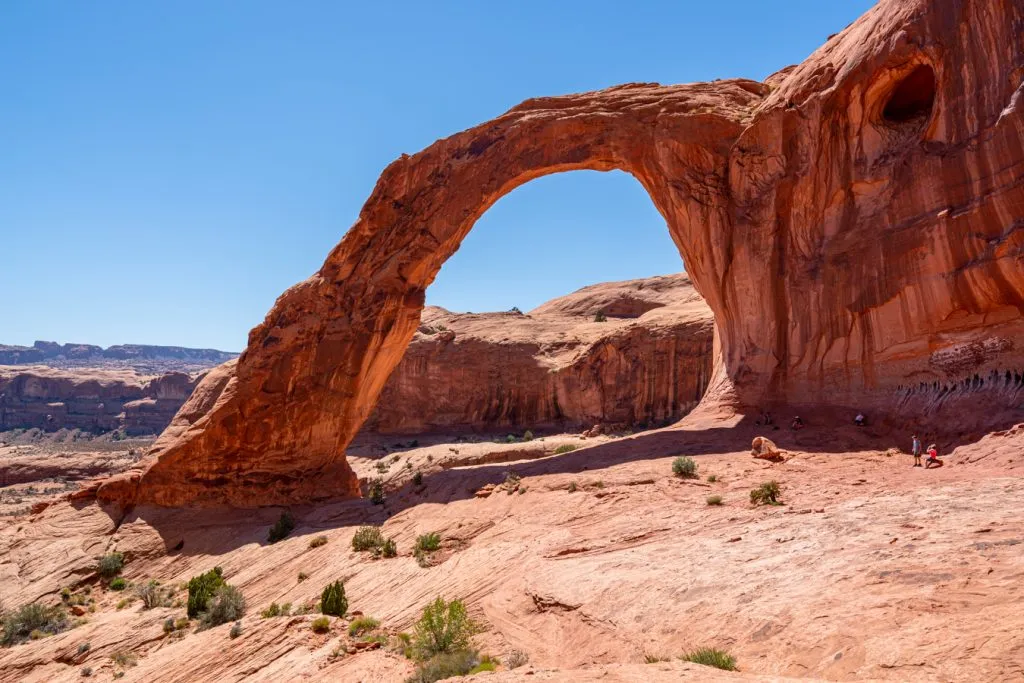
Comfort Suites Moab — We stayed here during a recent visit to Moab, and couldn’t have been happier with the comfortable rooms, exceptional customer service, and great location in town.
Check rates & book your stay at Comfort Suites Moab!
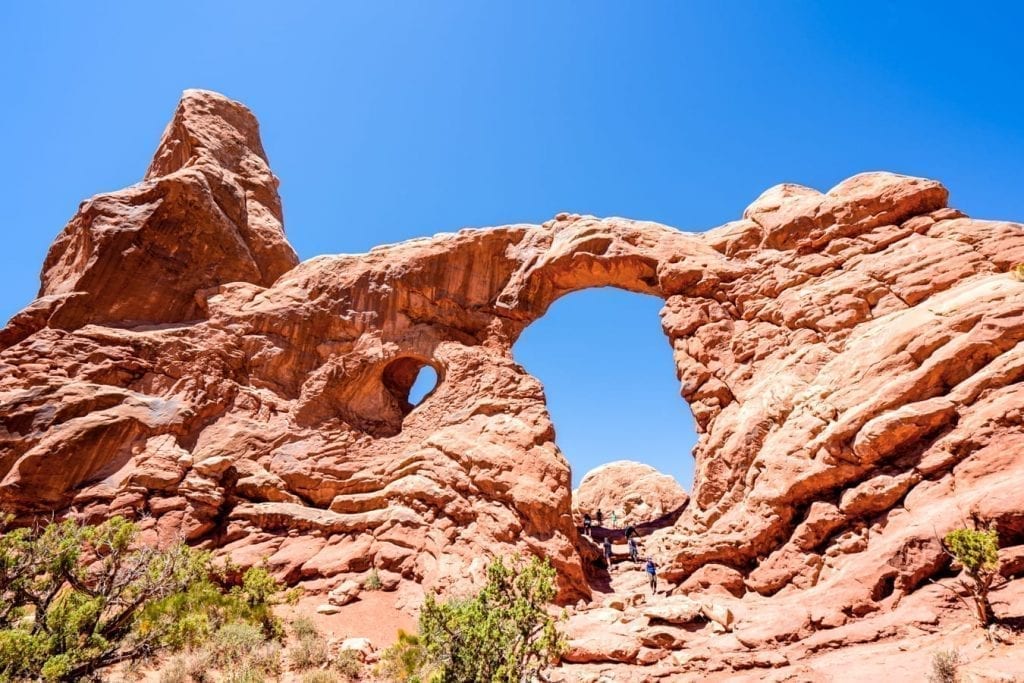
Hyatt Place Moab — Moab isn’t exactly a destination that lends itself to luxury, but those looking for some great creature comforts during their trip will find them at the new, swanky Hyatt Place Moab, which is just a few years old!
In addition to its swimming pool, included breakfast, and great rooms, Hyatt Place Moab also boasts an exceptional location on the edge of Moab, just minutes from the entrance to Arches National Park.
Check rates & book your stay at Hyatt Place Moab!
Vacation rental.
My Place Hotel — Need access to a kitchen while exploring the best activities in Moab? Consider the studios at the brand-new My Place Hotel!
We stayed here on our most recent trip to Moab and loved the kitchen access (though be warned, it’s not stocked, so bring your own plates/pans), the view, the extreme cleanliness, and beyond all, the location.
My Place Hotel is located on the edge of town, a short drive from Arches National Park, making it an ideal place to stay for hikers.
It’s also pet-friendly, a must for Ranger!
Check rates & book your stay at My Place Hotel!
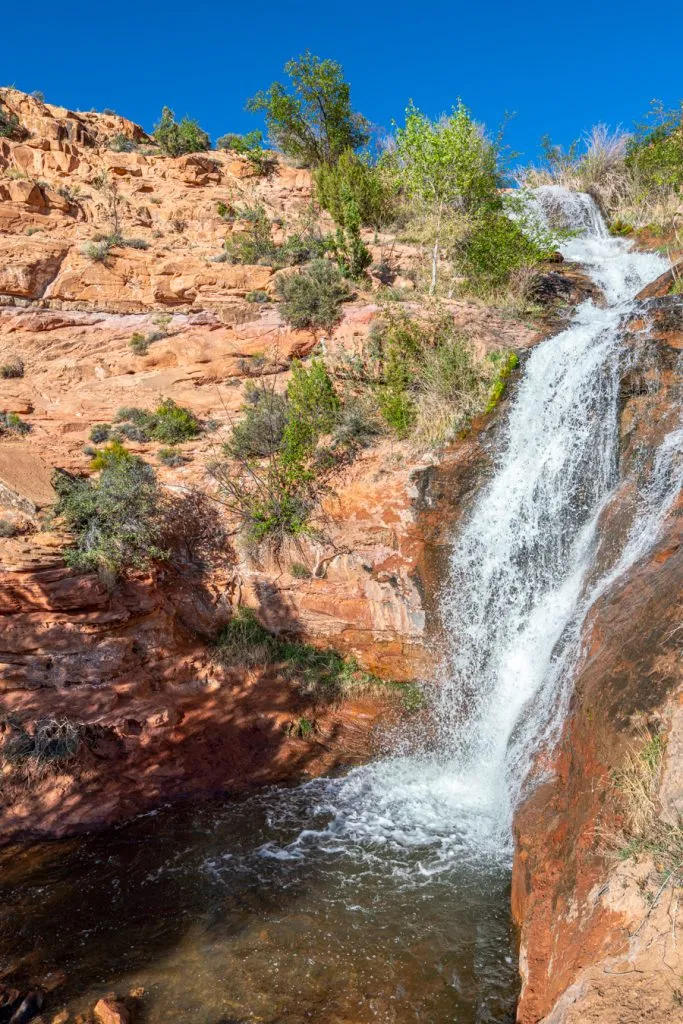
Day 2: Explore Arches National Park.
On day 2 of your national parks road trip in Utah, head (back) to Arches to knock off at least one of its iconic hikes.
We have a full post detailing the best hikes in Arches here , so I’ll try not to repeat myself much, but the Delicate Arch trail and the full Devils Garden trail are among our favorites.
Even if you’d rather not go more than, say, a mile along a trail, though, Arches still has plenty to offer!
In the evening, head back to town to enjoy dinner at one of the great restaurants in Moab .
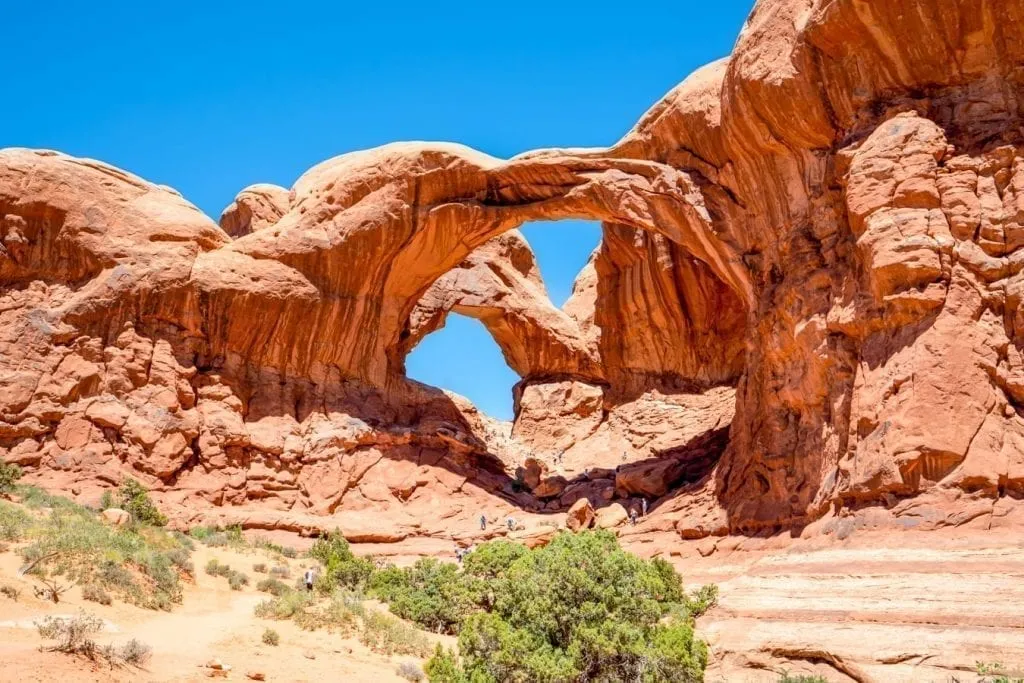
Day 3: Check out Canyonlands + watch the sunset at Dead Horse Point State Park.
Canyonlands National Park is enormous, and it is divided into three distinct sections: Island in the Sky , the Maze, and the Needles.
This Utah road trip itinerary includes a visit to Island in the Sky, both because it is the easiest section to access from Moab and because it is the district that is most accessible in general.
Be sure not to miss the iconic (and short) hike to Mesa Arch: it’s popular at sunrise for a reason, but even if you’re not willing to get up well before dawn, it’s still worth visiting at any time of day.
You’ll want to pack a picnic lunch for this part of your Utah road trip because after spending the bulk of the day on the Island in the Sky, we recommend stopping by Dead Horse Point State Park on your way back to Moab to enjoy the sunset from one of Utah’s best sunset spots.
If you’re on a strict budget, you may want to skip Dead Horse Point State Park as it’s an additional $20 fee per car to enter–but the sunsets are magical enough that we have visited more than once.
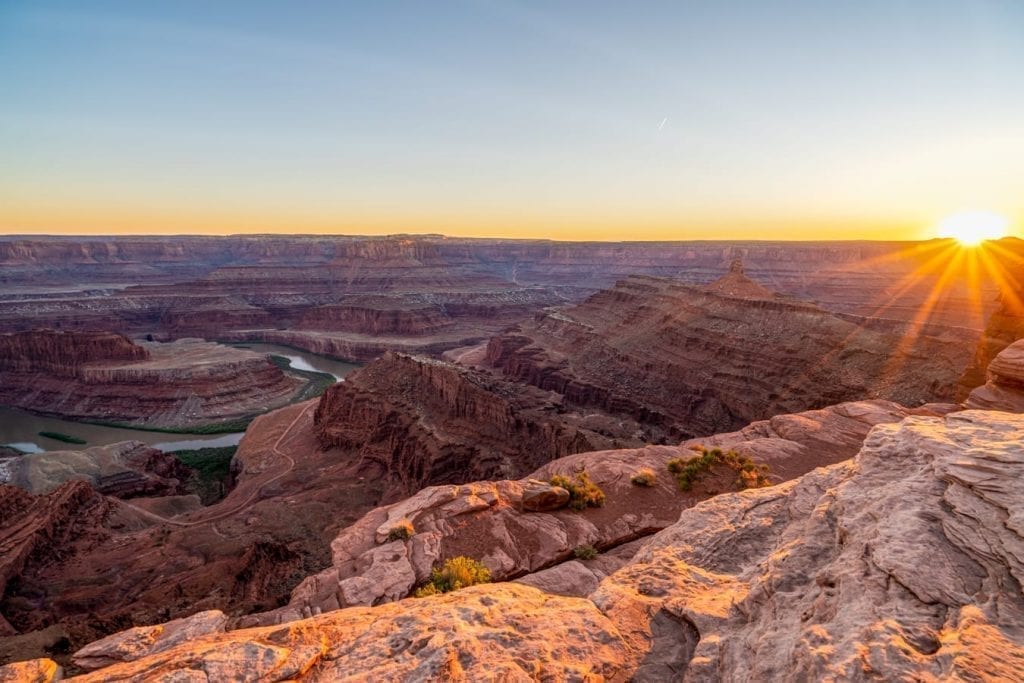
Day 4: Drive to Capitol Reef National Park + stop at Goblin Valley State Park.
Today, it’s time to leave behind popular Moab and head off to the least-visited of the Mighty Five national parks in Utah: Capitol Reef National Park.
We recommend traveling along beautiful Highway 24–the scenic drive is worthy of being considered a tourist attraction itself!
Along the way, consider making a detour to Goblin Valley State Park .
This valley is populated by a unique set of hoodoos that look remarkably like goblins!
A stop here doesn’t necessarily need to be longer than a couple of hours to be worth the effort, but be sure to come prepared for lots of heat and sun exposure: the valley floor is mercilessly hot and exposed.
Once you finish checking out the goblins, head to Capitol Reef to finish your day with some absolutely stunning views.
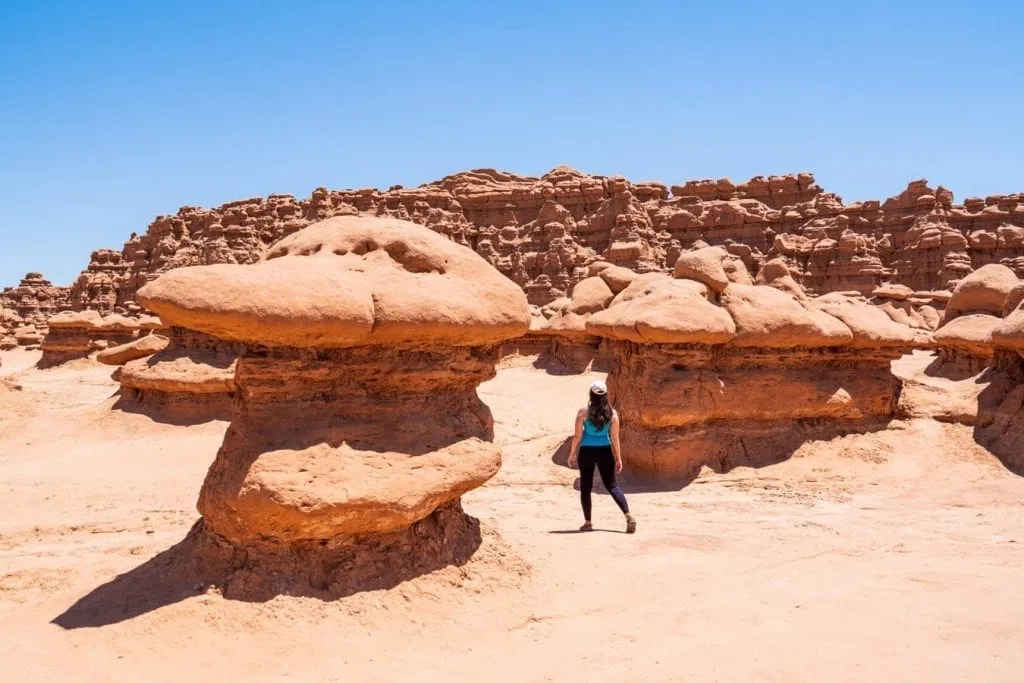
Where to Stay Near Capitol Reef National Park
Capitol Reef National Park is located in a very rural area, but there are a decent number of nearby hotels to consider, particularly in Torrey.
We personally went for a more unique stay when we visited and stayed in a covered wagon!
If you’re looking for unique accommodation, Capitol Reef is a great place to look. Yurts, glamping tents, covered wagons, and beyond are fairly easy to come by!
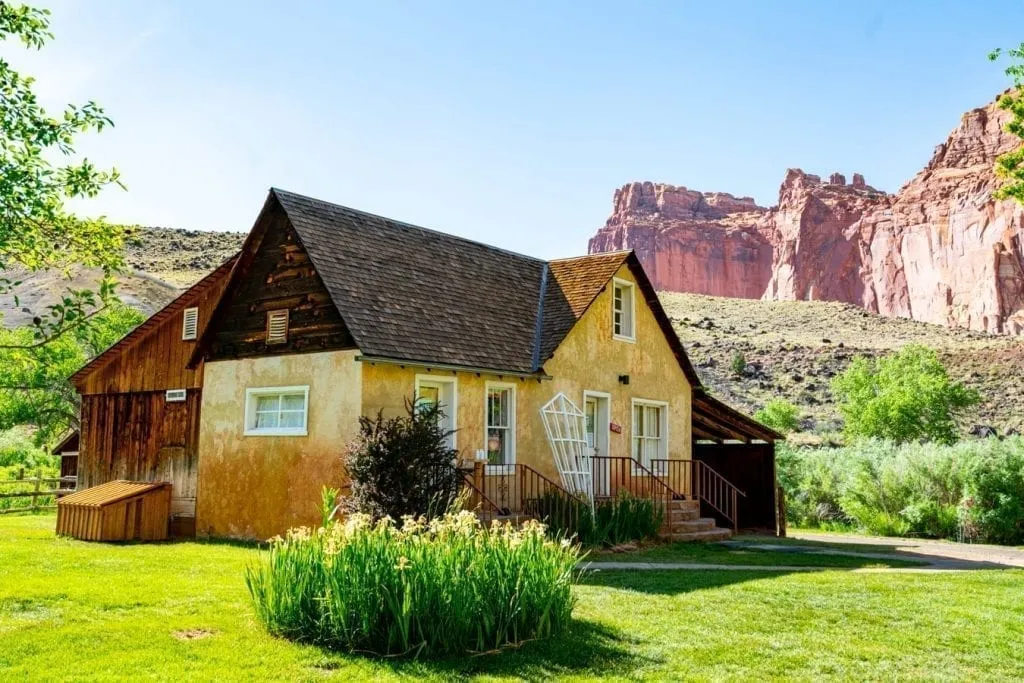
Broken Spur Inn & Steakhouse — We stayed at the Broken Spur during our time at Capitol Reef National Park and loved the novelty of sleeping in a covered wagon!
For those looking for a well-located property close to the national park with a few more creature comforts, though, the inn does also have more typical rooms available in the main building.
Check rates & book your stay at Broken Spur Inn & Steakhouse!
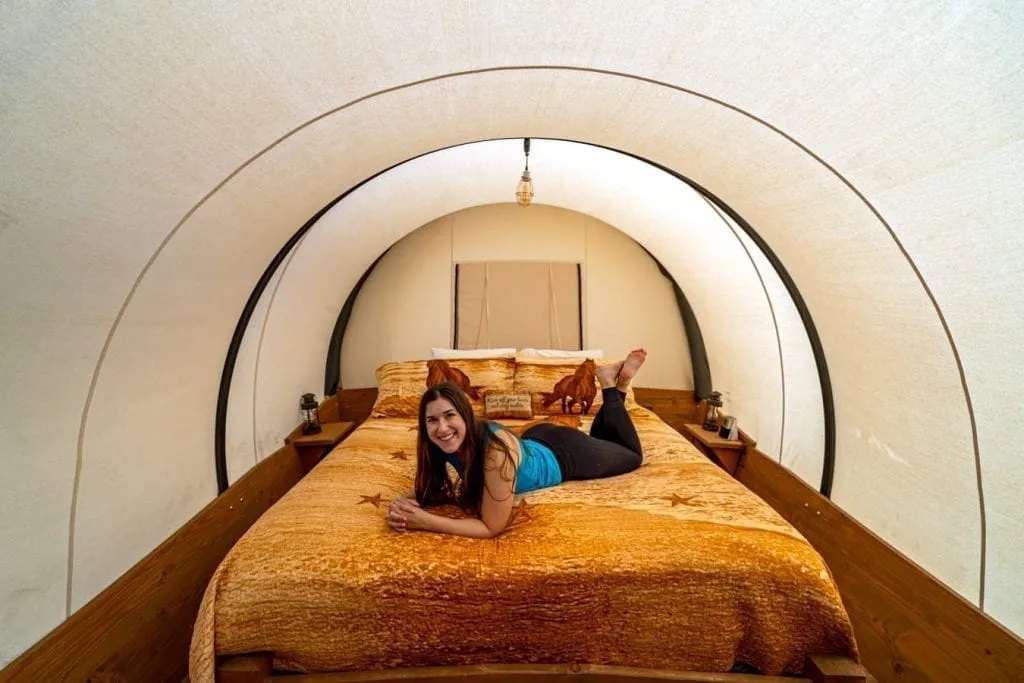
Austin’s Chuckwagon Motel — With great reviews and plenty of southwestern curb appeal, Austin’s Chuckwagon Motel is a convenient and reliable place to stay near Capitol Reef National Park–and the views from the property aren’t bad, either!
Check rates & book your stay at Austin’s Chuckwagon Motel!
Capitol Reef Resort — Set on a beautiful property and boasting amenities like a luxurious pool with a view and a fitness center, Capitol Reef Resort is a choose-your-own-adventure style accommodation.
Whether you’d like to glamp in a tent, indulge in a memorable night’s stay in a covered wagon, or simply stay in one of the resort’s more traditional rooms, Capitol Reef Resort has an option for you!
Check rates & book your stay at Capitol Reef Resort!
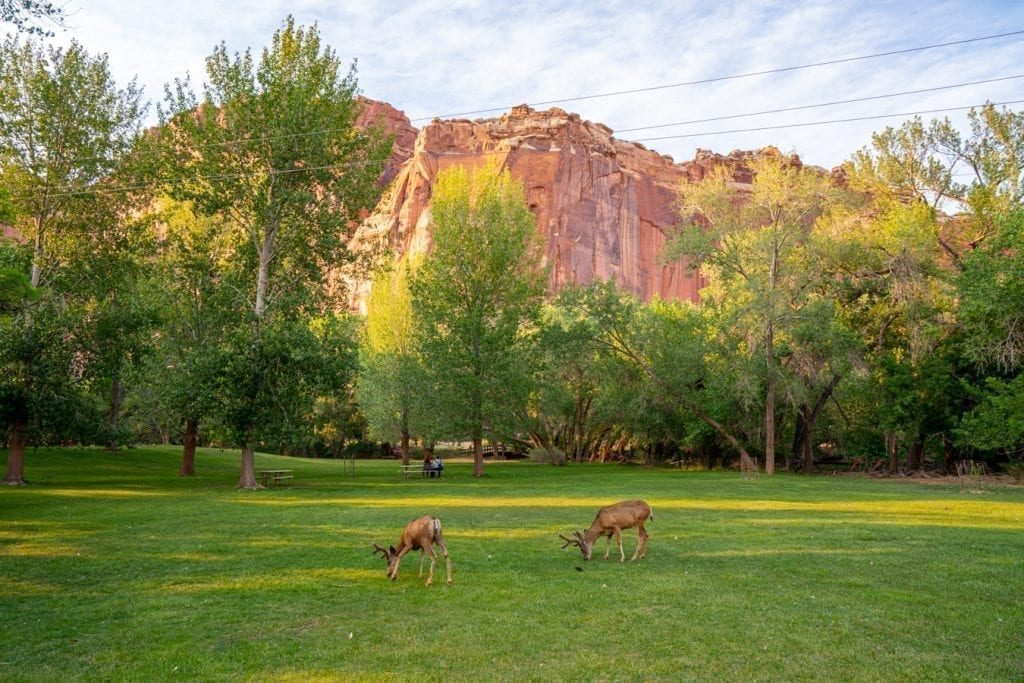
Day 5: Enjoy Capitol Reef National Park.
Many Utah road trips skip past or barely touch Capitol Reef National Park, partially because it’s small and partially because it’s a bit out of the way, but that’s a mistake.
In our opinion, Capitol Reef is incredibly beautiful, and also has the benefit of being less crowded than parks like Arches and Zion!
The scenic drives through the park are stunning, and there are several cool hikes worth checking out, including the popular Hickman Bridge and the Cassidy Arch Trail, so named because it is said that Butch Cassidy once hid out there.
Be sure to also spend some time in the Fruita Historic District: this small village was built by 19th-century Mormon settlers, and the fruit trees there produce some truly remarkable things to eat.
Head to the Gifford House, now a small shop, where you can pick up homemade jams, pies, baked goods, and other desserts that are made from the fruit grown on-site.
The triple-berry pie is one of the best pies we’ve ever had in our lives, and it makes a delicious post-hike snack!
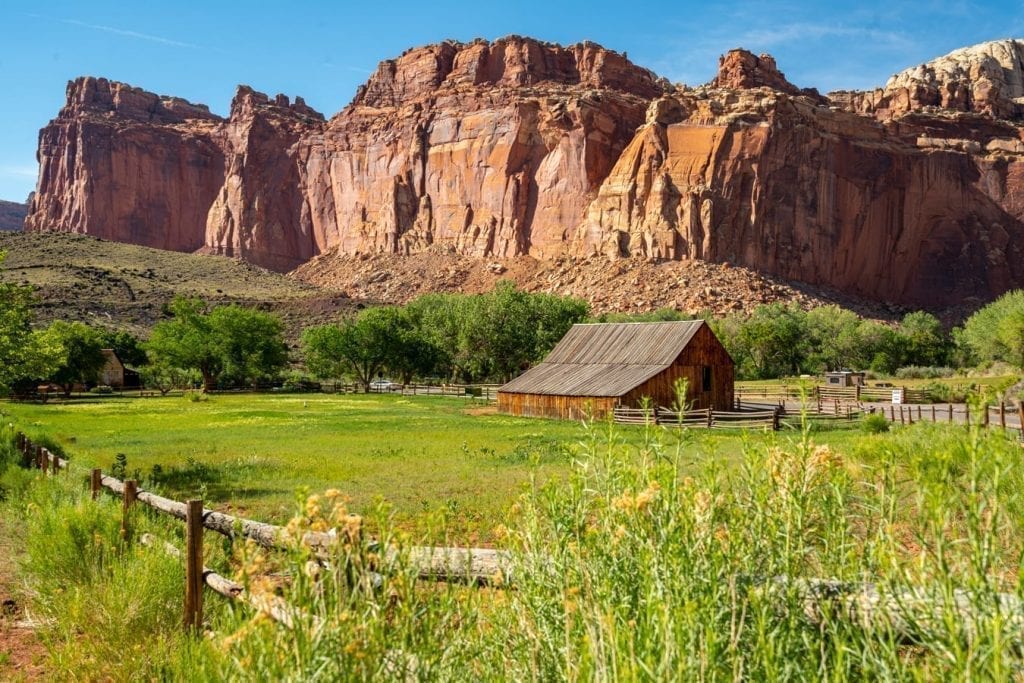
Day 6: Drive to Bryce Canyon National Park via Highway 12 + start exploring.
The scenic route from Capitol Reef National Park to Bryce Canyon National Park along Highway 12 will see you spending most of your driving time in Grand Staircase-Escalante National Monument.
In other words, the views are pretty incredible, and you may want to stop a few times along the way!
Once you reach Bryce Canyon, head directly into the park and start exploring: scenic viewpoints like Inspiration Point and Bryce Point are the perfect way to start exploring the park.
For sunset, head to the aptly-named Sunset Point to watch the hoodoos of Bryce Canyon shift color as the sun goes down.
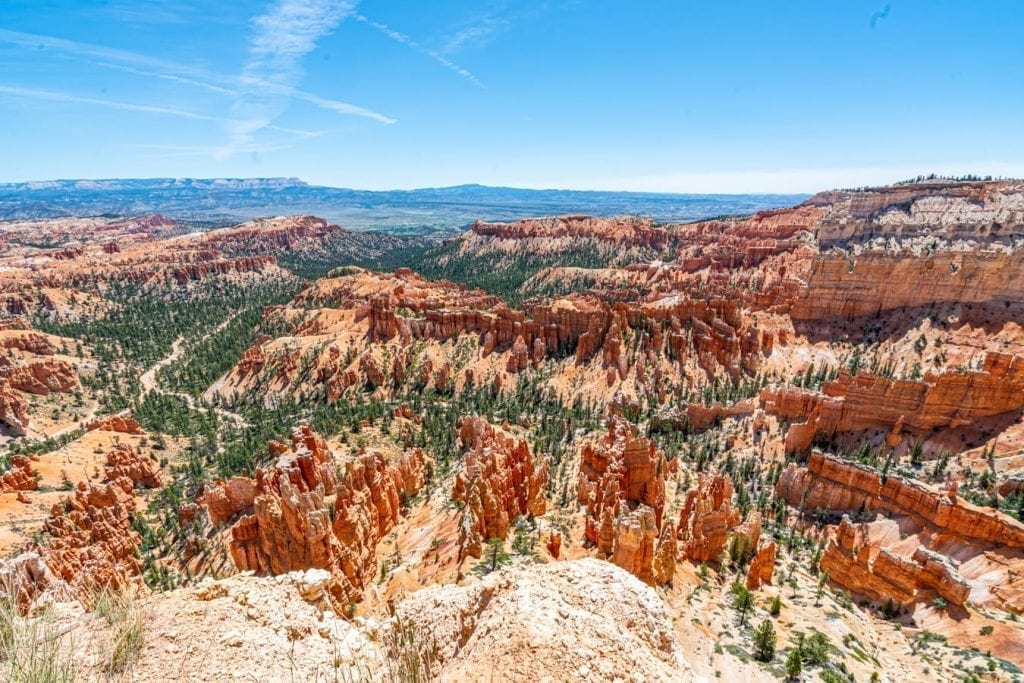
Where to Stay Near Bryce Canyon National Park
Bryce Canyon City is located right outside Bryce Canyon National Park and is the best place to stay when visiting.
Here are a couple of great places to consider!
Bryce Canyon Pines — For basic, comfortable accommodation with a wildly popular restaurant on-site, Bryce Canyon Pines is an excellent option!
We stayed here during our most recent trip to Bryce Canyon and found it to be exactly as advertised: basic but decent enough for a quick stay.
Check rates & book your stay at Bryce Canyon Pines!
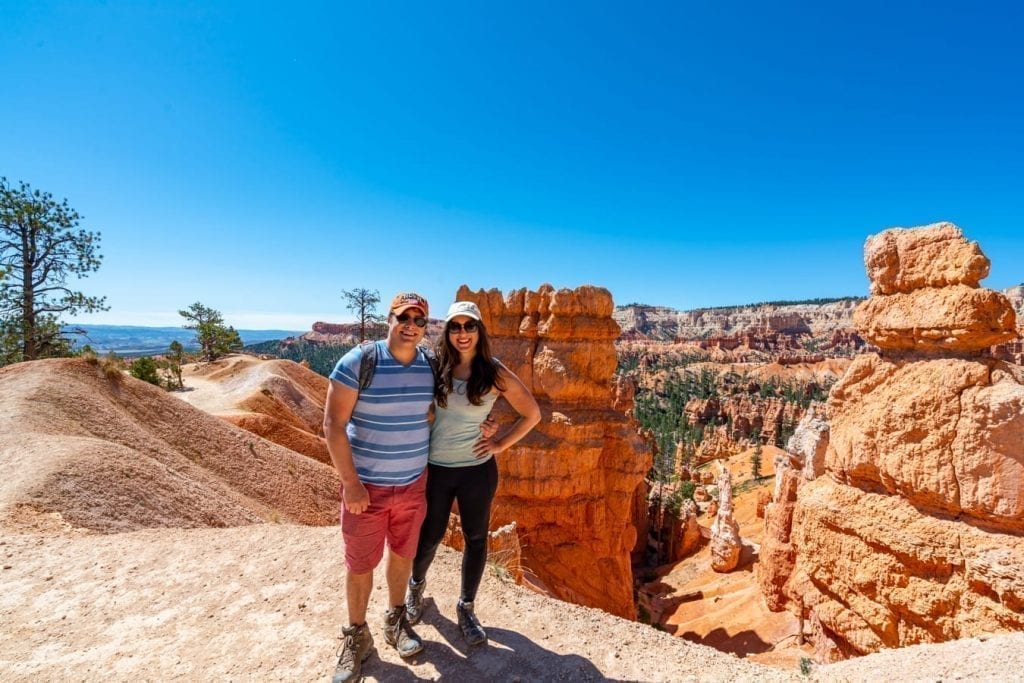
Mid-range/Luxury
Best Western Plus Bryce Grand Canyon Hotel — After staying in literally hundreds of hotels over the last several years, we still count this as one of our most memorable stays–in part because of the hotel’s absolutely phenomenal breakfast, and in part because of the excellent location and customer service.
This is our #1 choice of where to stay near Bryce Canyon, and we will always check if it’s available before booking anywhere else when we return to the park!
Check rates & book your stay at the Best Western Plus Bryce Grand Canyon Hotel!
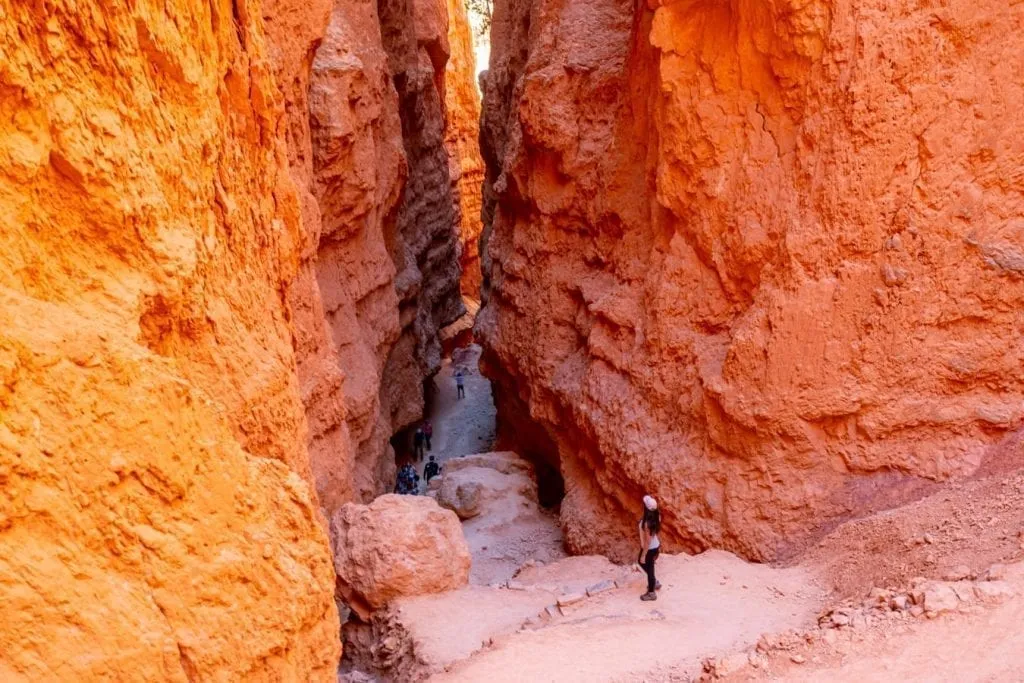
Day 7: Spend the morning at Bryce Canyon before driving to Zion National Park.
This morning, we recommend hiking a combination of Bryce Canyon’s most popular trails: Navajo Loop to the Queen’s Garden Trail (via Wall Street if it’s open).
If you get a prompt start, you can easily finish before lunch and be ready to head onto Zion, while still getting to see what are arguably the best views in Bryce Canyon first!
Once you reach Zion, if you have the energy for a second hike, consider knocking a short one off of your wish list–but be sure to leave enough energy for tomorrow, when you’ll tackle one of the most unique hikes in Utah!
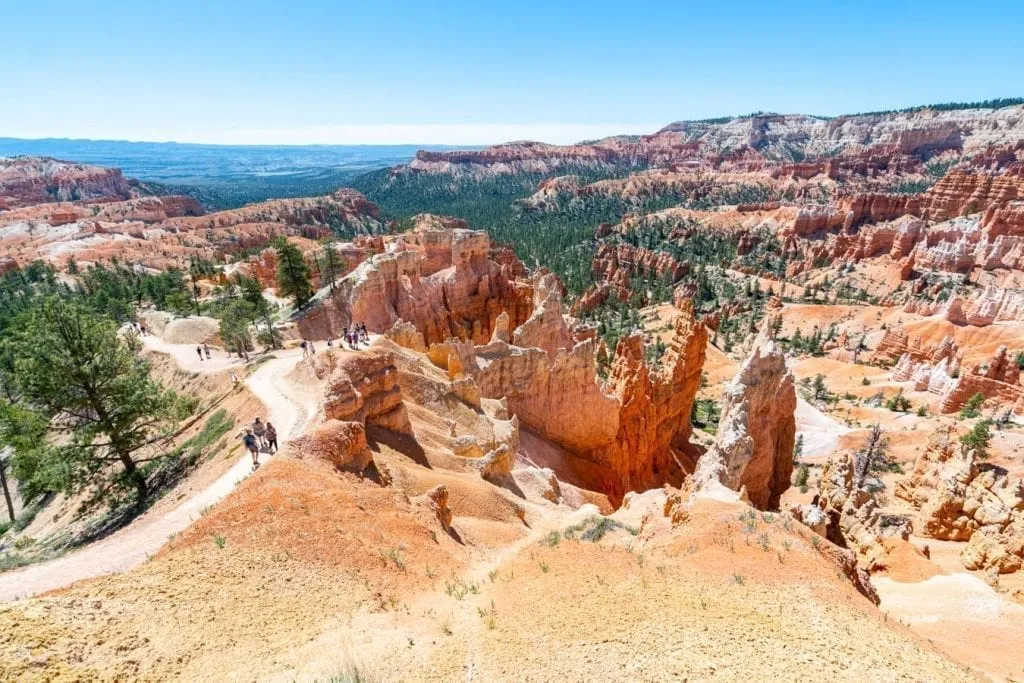
Where to Stay Near Zion National Park
Springdale is the closest town to Zion National Park and the ideal place to stay when visiting–however, like Moab, it is popular and therefore pricey.
If you’re on a strict budget, you can also consider looking a bit further out in towns like La Verkin.
However, be prepared for a 30+ minute drive into the park each morning if you stay further out!
La Quinta Springdale — Located just a few miles from Zion National Park, La Quinta Springdale has comfortable rooms, great reviews, and a beautiful pool to cool off in to go along with its prime location.
Check rates & book your stay at La Quinta Springdale!
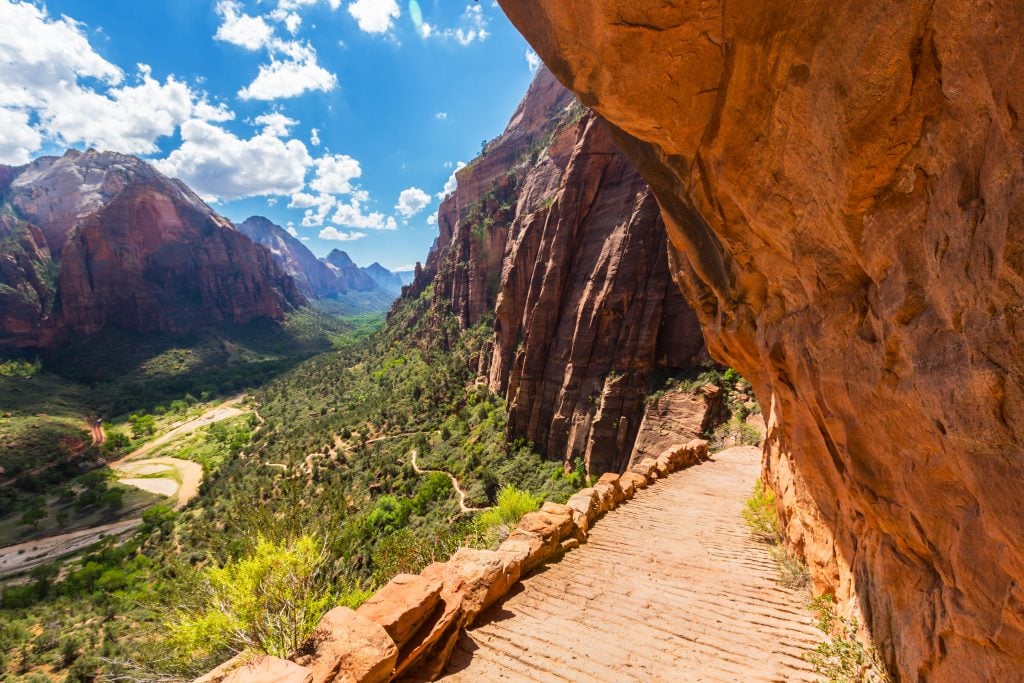
Best Western Plus Zion Canyon Inn & Suites — With fantastic reviews, great amenities, and a prime location in the heart of Springdale, this hotel is a reliable and comfortable option for visiting Zion National Park!
Check rates & book your stay at Best Western Plus Zion Canyon Inn & Suites!
Holiday Inn Express Springdale — With beautiful lodge-style architecture and phenomenal reviews, Holiday Inn Express Springdale is located less than 2 miles from Zion National Park and is the perfect place to cool off after a long day of hiking.
Check rates & book your stay at Holiday Inn Express Springdale!
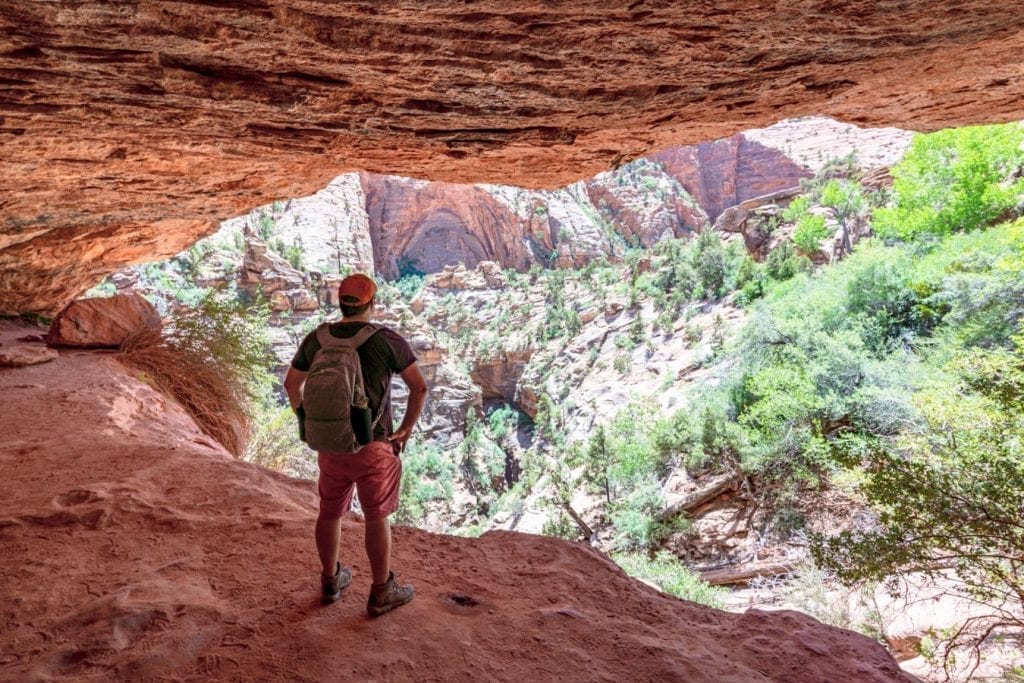
Day 8: Go hiking in Zion National Park.
On your full day in Zion National Park , we recommend tackling one of Zion’s two most famous and incredible hikes: Angel’s Landing (which requires a permit as of April 2022) or the Narrows.
Angels Landing is a bit terrifying for people like me who are scared of heights, but ends in a positively stunning view of Zion Canyon, and it ranks among the best hikes in the USA for a reason!
The Narrows, in contrast to the soaring heights of Angel’s Landing, involves hiking directly in the Virgin River as you descend deeper and deeper into the canyon.
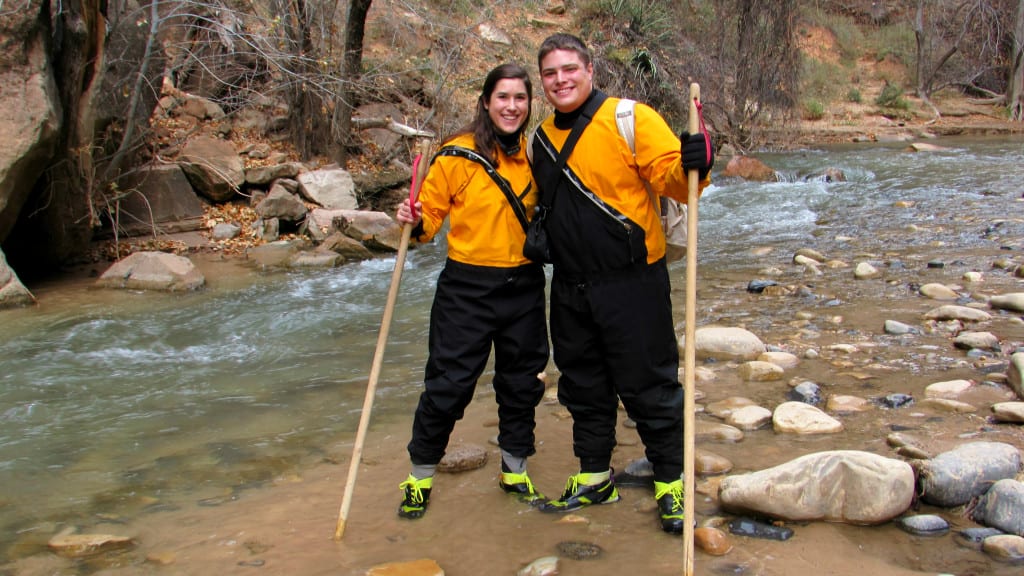
Both are utterly unforgettable, and while you can technically attempt both in the same day, that’s really only suitable for very athletic and determined hikers.
Other hikes to consider include the West Rim Trail (if you’re up for a big challenge), or if you’re lucky enough to nab a permit, the Subway.
Unfortunately, a few popular hikes in Zion, including Observation Point and the Weeping Rock Trail, are closed for the foreseeable future due to large rock falls.
Check here for updates before visiting.
Also, keep in mind that from March to October, you can’t drive your private vehicle onto Zion’s Scenic Drive–you’ll need to catch the shuttle instead!
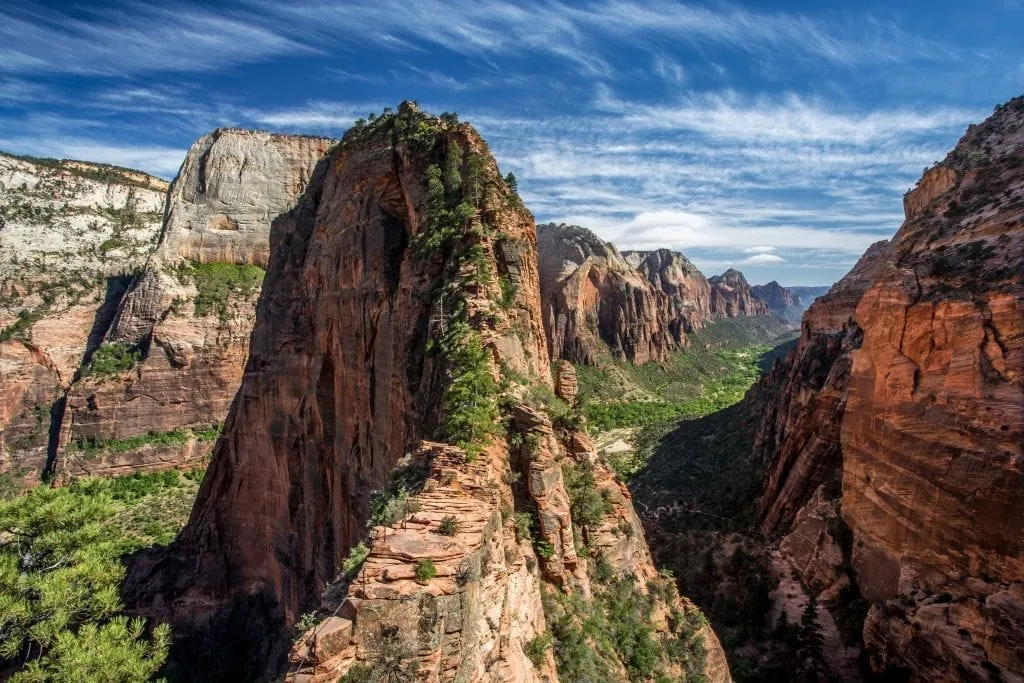
Day 9: Say goodbye to Utah’s Mighty Five + head home (or to wherever is next).
On the final day of your Utah national parks road trip, say goodbye to Zion National Park and head home–or to wherever is next!
If you have time for one more quick hike before leaving Zion, we highly recommend the Canyon Overlook Trail for something fast and easy with a great pay-off at the end (and unlike most hikes in Zion, you can drive your own vehicle to the trailhead year-round).
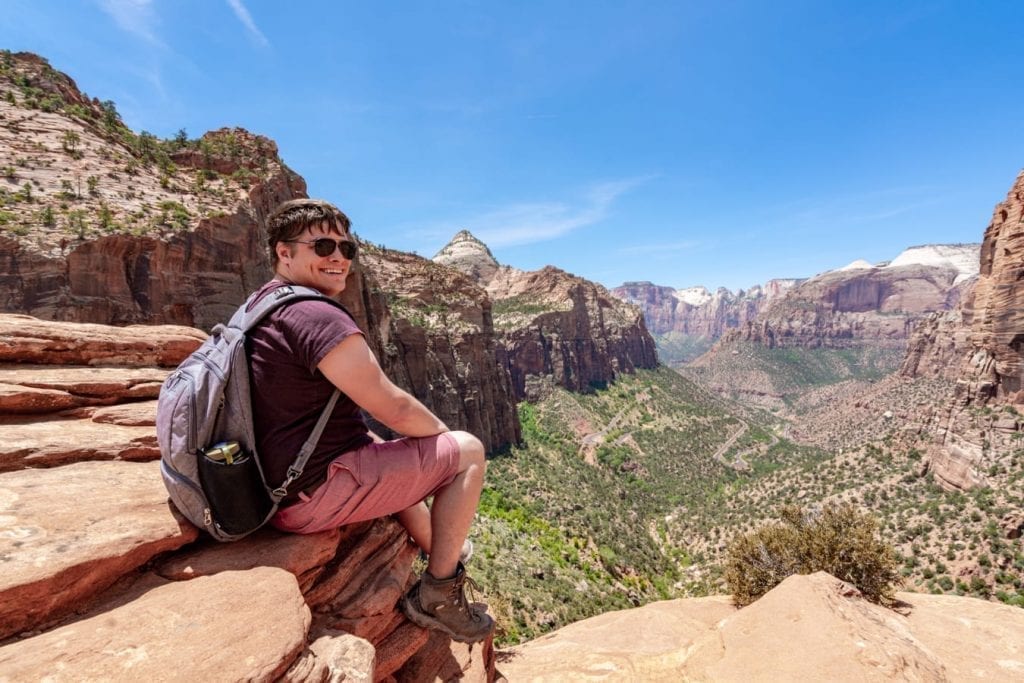
As fantastic and rewarding as a Utah Mighty Five road trip is, this road trip does take a bit of effort to actually start, as there are no major airports in the direct vicinity of Moab.
That being said, it is slightly more convenient to get to/from Zion National Park at the end of the trip.
Of course, there’s no rule stating you need to follow this Utah national parks road trip itinerary exactly.
D epending on your flight schedule and what airport you choose, you may prefer to reverse this trip (though personally, I am partial to starting in Moab if you can).
Assuming you’re flying into the region for your trip, there are several cities that would work as a starting point–h ere are some that we recommend checking flight prices and times for.
Depending on exactly when you’re visiting and what your priorities are, the best (and most affordable) airport will vary, but that being said, Las Vegas is a very popular option.
In addition to those listed here, if you plan to extend your Utah road trip into a larger Utah and Arizona road trip and/or southwest road trip, you may want to check prices for Albuquerque and Phoenix as well.
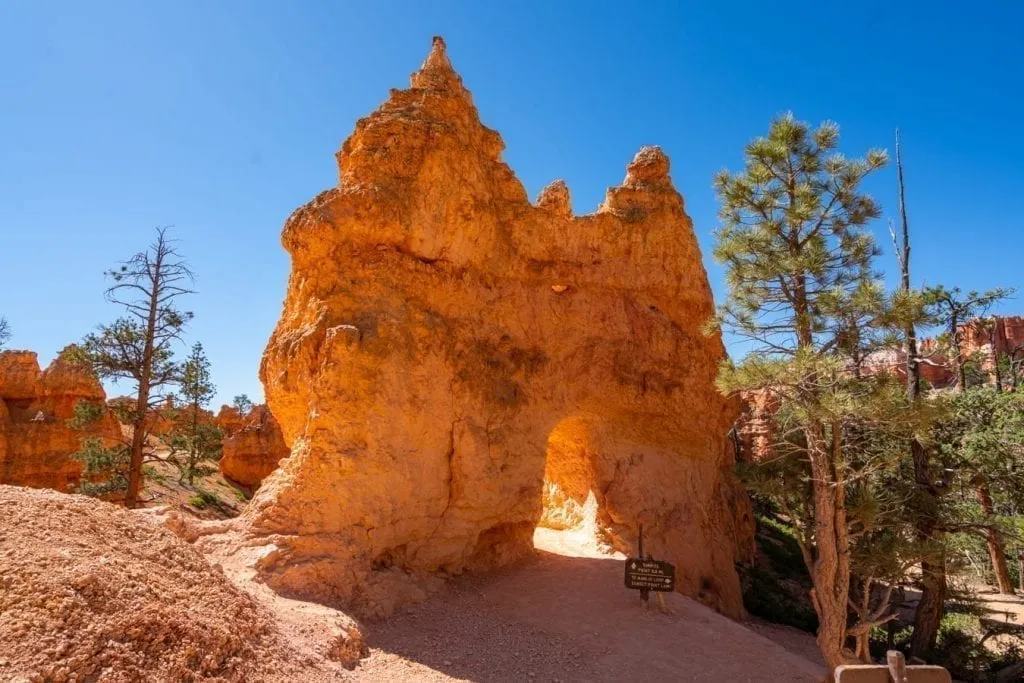
For sheer convenience alone, St. George is arguably the best airport to fly into for this Utah national parks itinerary.
St George is about an hour from Zion National Park, and a little under 5 hours from Moab.
Las Vegas is often the cheapest and most convenient option when flying into the US southwest.
Flights are plentiful and typically affordable from a wide variety of initial destinations, and Las Vegas is about 6.5 hours from Moab and less than 3 hours from Zion National Park.
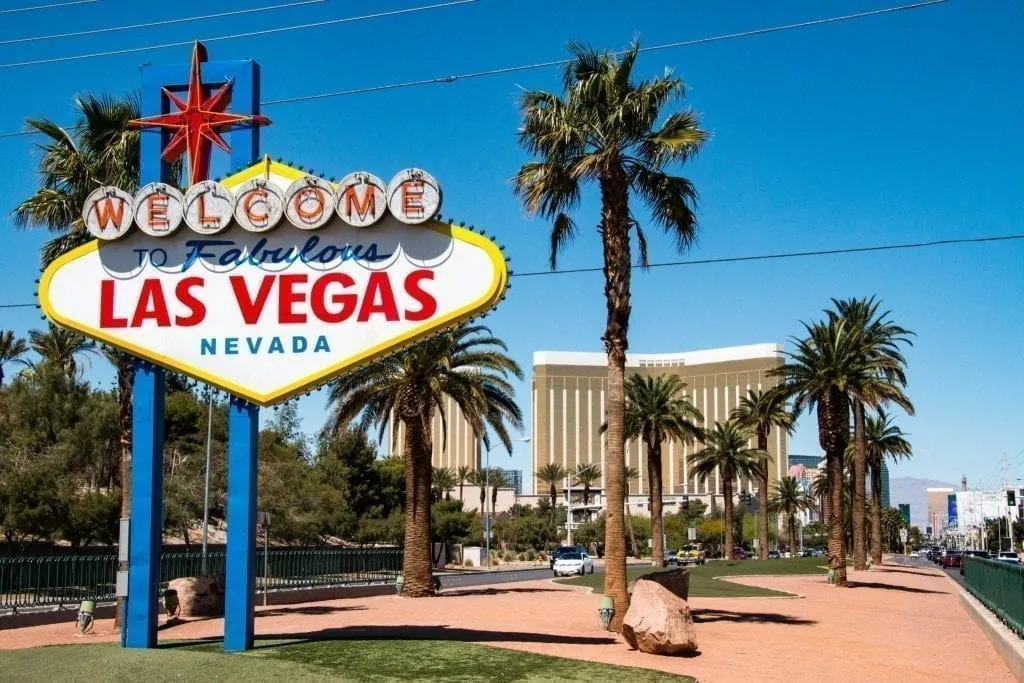
Salt Lake City
Utah’s capital city makes a solid starting point and is located under 4 hours from Moab and under 5 hours from Zion National Park.
If you want to extend your itinerary to include northern Utah, SLC is the clear choice for you!
At more than 5 hours from Moab and 4 hours from Zion National Park, Flagstaff isn’t the most convenient airport for this Utah road trip–but it is ideal if you’d like to add a stop at the Grand Canyon to your trip!
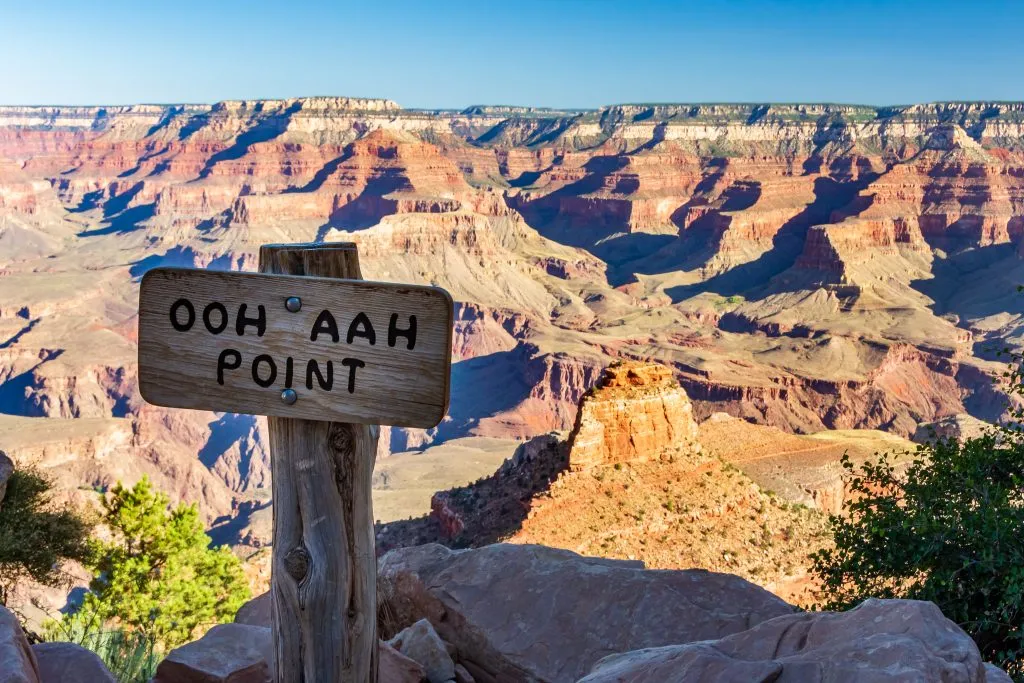
Have more time to spend on your road trip in the southwest?
The first thing we would recommend is adding additional time to your favorite national parks–Zion and Arches, in particular, could each use more time, especially for enthusiastic hikers.
Adventurous travelers with access to 4-wheel drive may want to visit other sections of Canyonlands and Capitol Reef, as well.
In addition to extending your time, though, here are a few other places to consider adding to your Utah road trip itinerary!
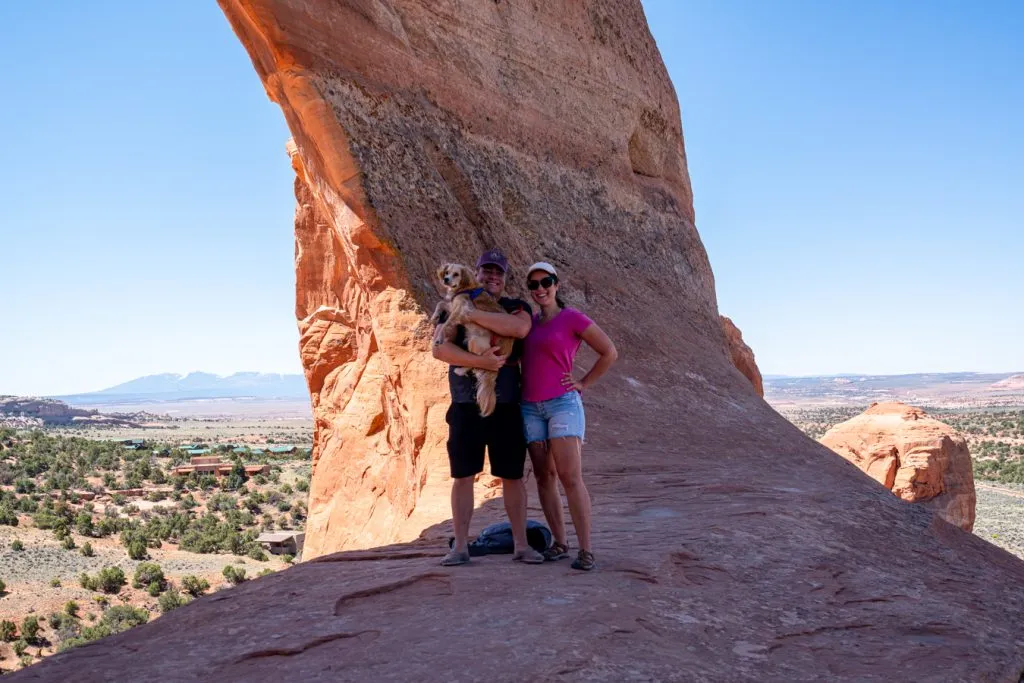
Within Utah
Grand staircase-escalante national monument.
This Utah national parks road trip already takes you right through Grand Staircase-Escalante–you’ll drive through it on Highway 12 between Capitol Reef and Bryce–but it’s well worth spending some time in if you have a chance to spend longer in Utah!
There is plenty of diverse hiking in Grand Staircase-Escalante, but these days it’s known for its incredible slot canyons.
Some of the most popular include Zebra Canyon, Peekaboo Canyon, and Spooky Canyon, where we took this photo:
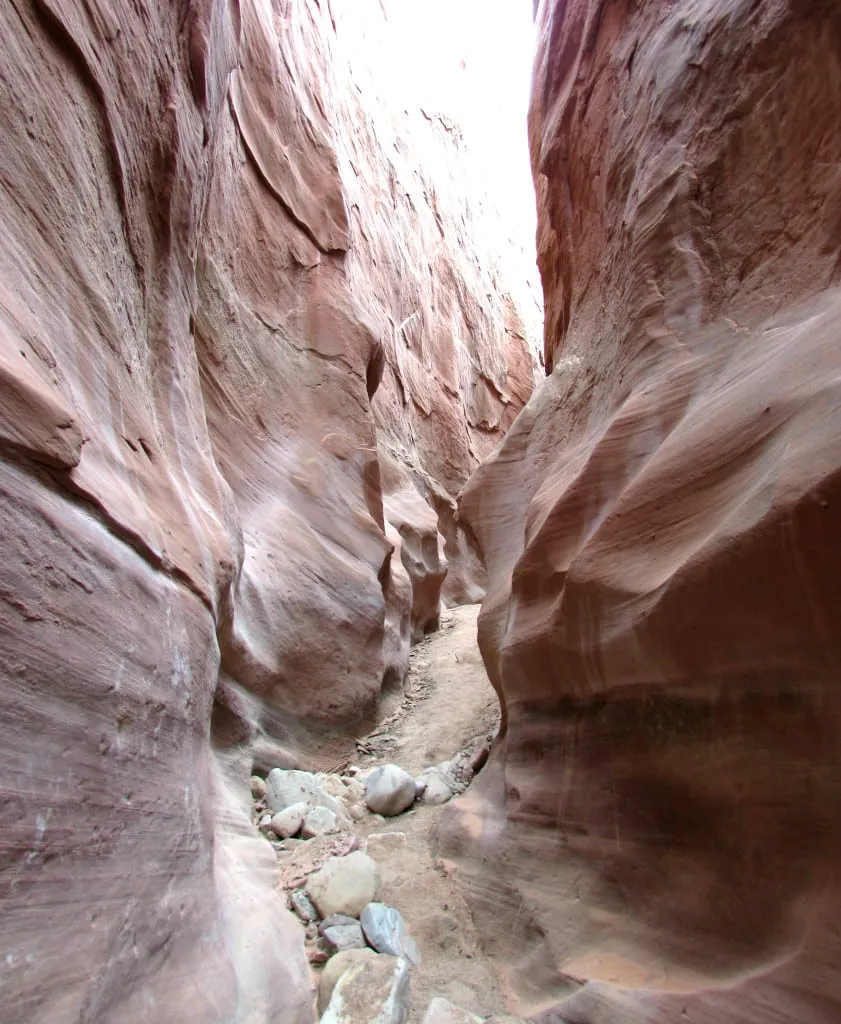
Coral Sand Dunes State Park
Want to see some rolling sand dunes without leaving Utah?
At Coral Sand Dunes State Park, you can–and depending on the light that day, the dunes can indeed look a bit pink.
There are also several other fun things to do in Kanab that are worth checking out after your visit!
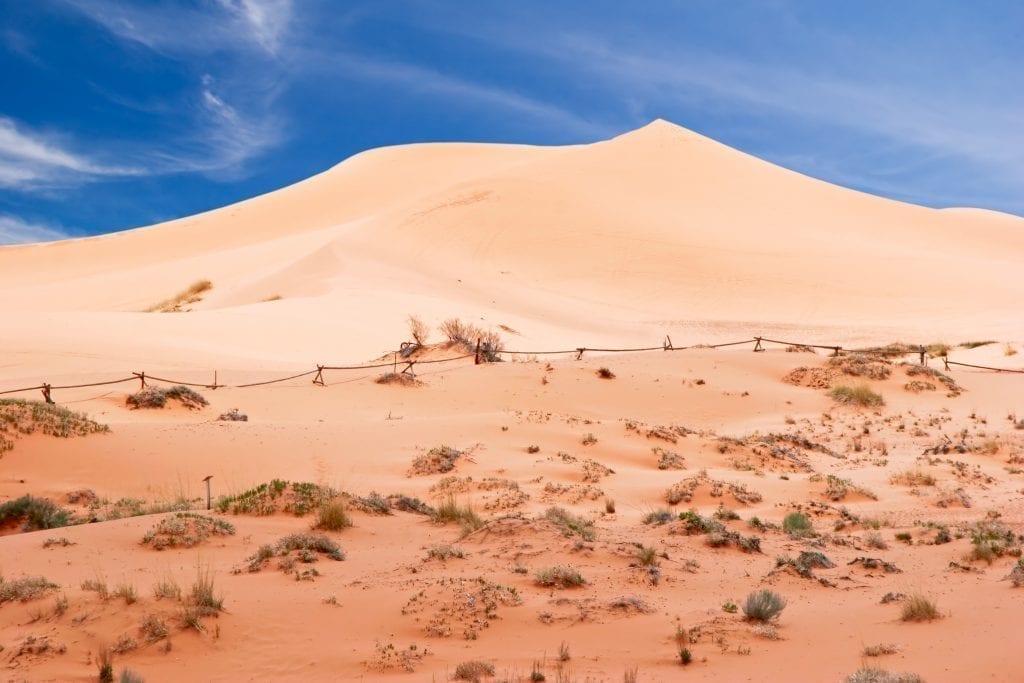
Monument Valley Tribal Park
Situated in Navajo Nation right along the Utah/Arizona border, Monument Valley is known for its soaring rock formations and its status as a popular place to film movies–including, perhaps most famously, Forrest Gump!
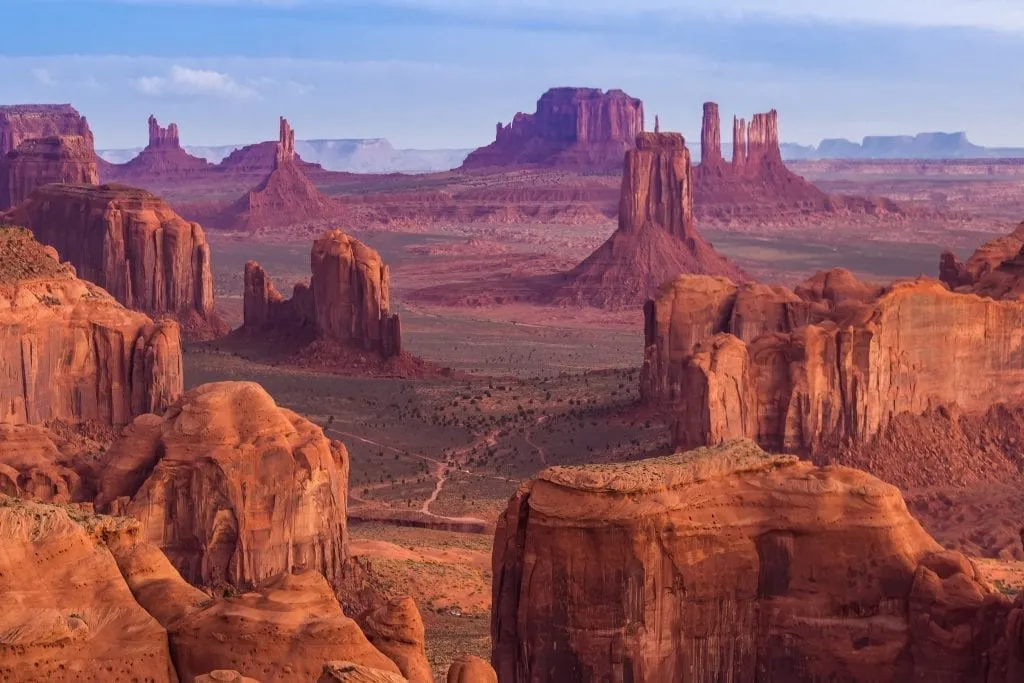
Natural Bridges National Monument
Home to 3 stunning natural bridges, those who fell in love with Arches National Park will also enjoy Natural Bridges National Monument!
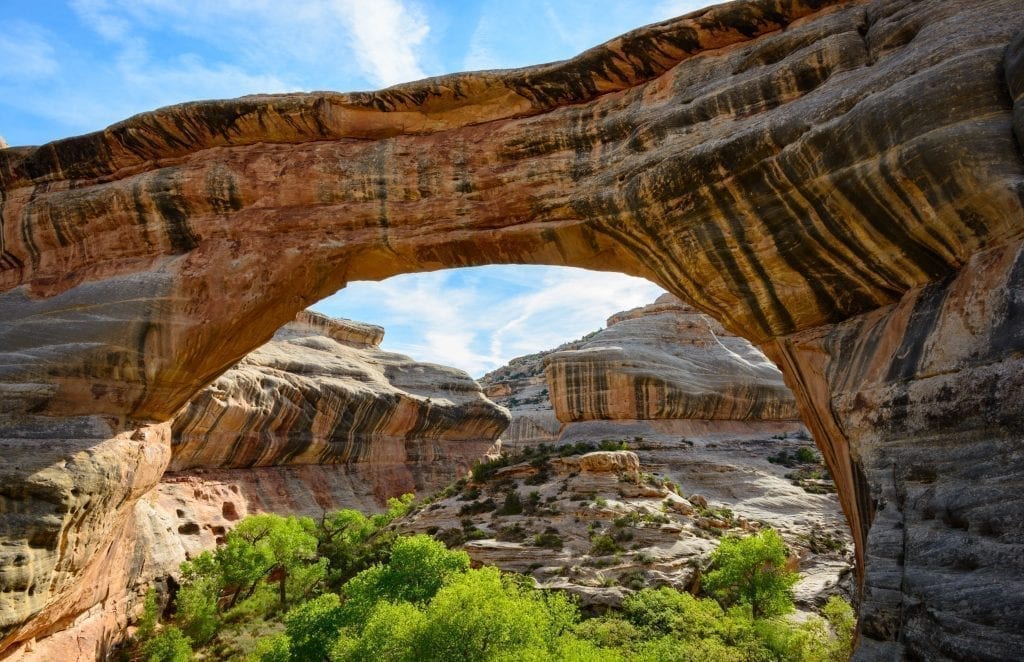
Beyond Utah
Located just over the border in Arizona, the Wave is not easy to access–its permit system limits access to just 20 people/day.
If you manage to nab one of the elusive Wave permits , though, it’s worth rearranging your road trip itinerary to make it happen!
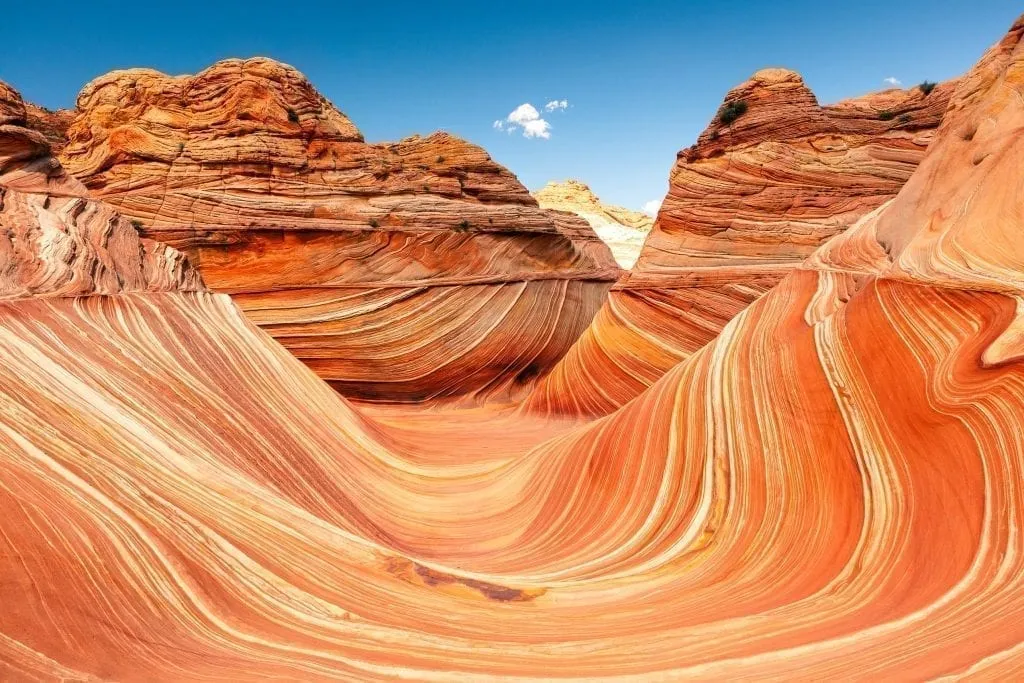
Valley of Fire State Park
If you fly into or out of Las Vegas, Nevada’s beautiful Valley of Fire State Park makes for an excellent stop along the way–even half a day is long enough to see some of the coolest spots in this park.
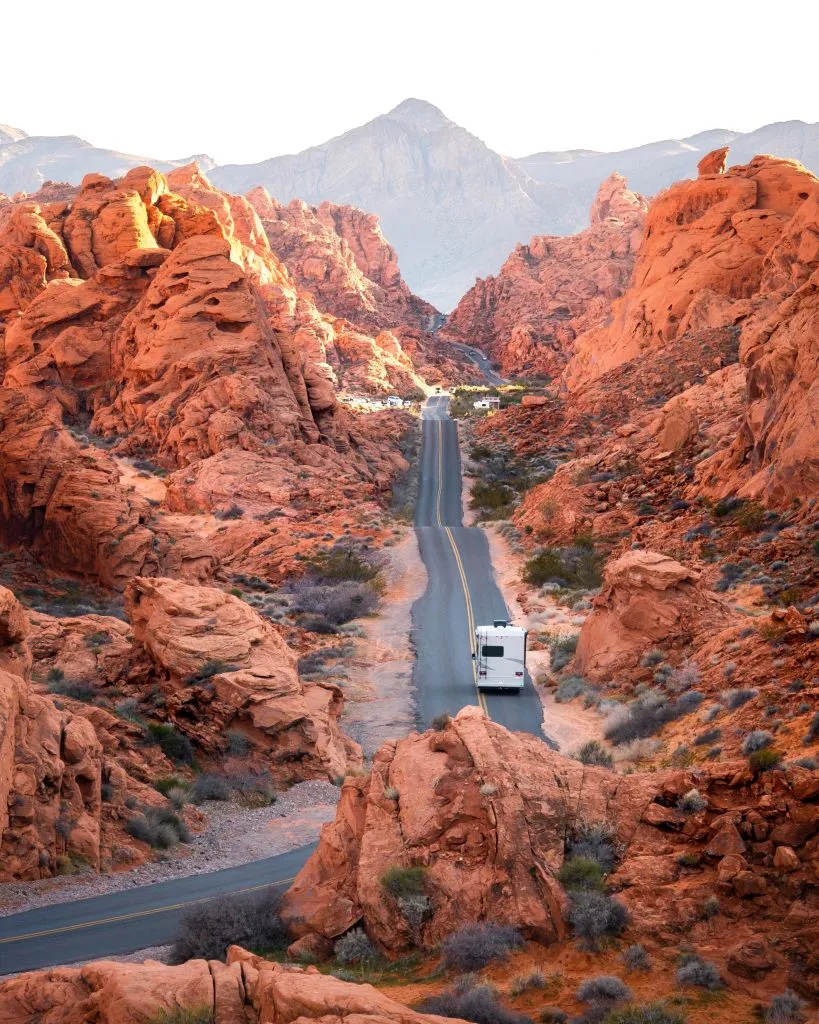
Horseshoe Bend + Antelope Canyon
Hop over the Utah/Arizona border, and you’ll immediately find Page , the small, unassuming town that is home to two of Arizona’s most popular attractions: Horseshoe Bend and Antelope Canyon.
While Horseshoe Bend can be accessed spontaneously (it’s $10 per vehicle to park and visit), visiting Antelope Canyon requires some advance planning and a tour guide.
The canyon is located on Navajo land, and you can check the availability of tours here , on the Navajo Nation’s national parks website.
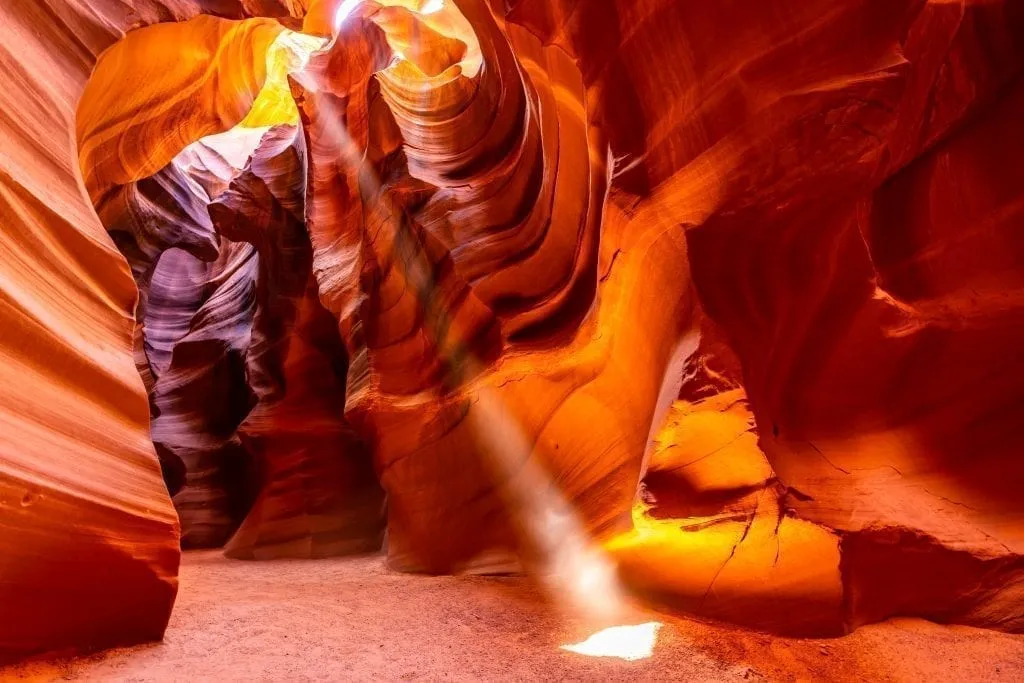
Grand Canyon
Of course, no discussion of places to visit near Utah’s Mighty Five could skip over the Grand Canyon in northern Arizona, which is one of the most famous national parks on the planet!
Just be aware of the distance involved: the Grand Canyon may look close on the map, but in order to reach the popular South Rim from Utah, you’ll need to drive around most of the canyon!
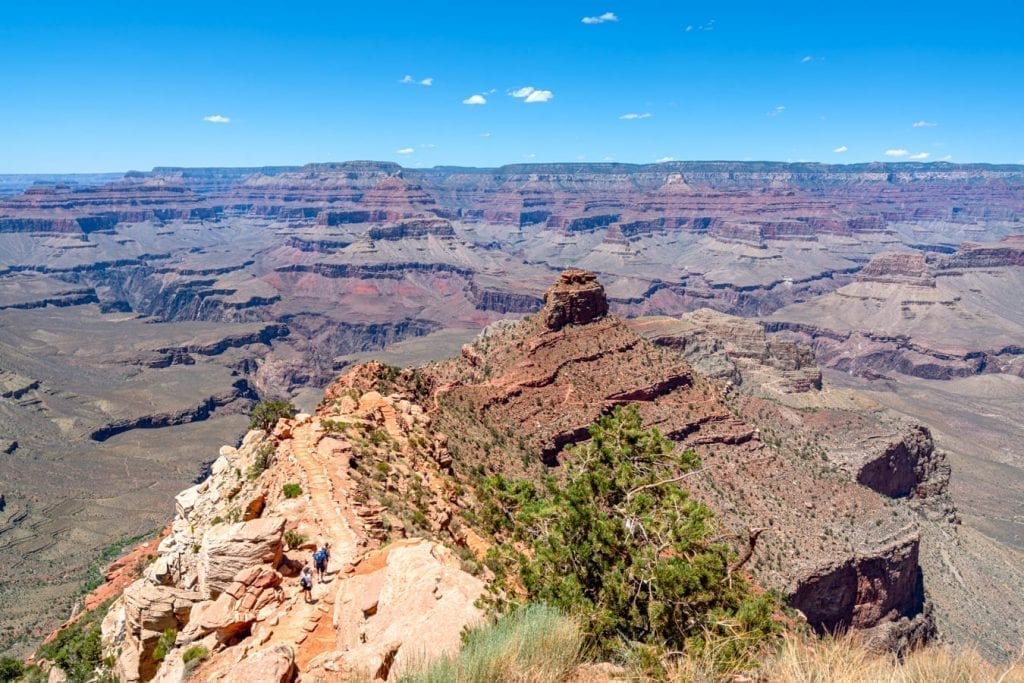
Check to see if you need a reservation.
Starting in April 2022, Arches National Park is piloting a reservation system to enter the park between 6:00 AM and 5:00 PM.
This applies daily between April 3 and October 3, so be sure to book your dates as soon as you can!
Other national parks have also been introducing reservation systems for hikes and even access in the last couple of years (such as Angel’s Landing in Zion or the timed access requirements for Rocky Mountain National Park), so it’s best to double-check to see what the latest requirements are as you plan your Utah road trip.
Grab an America the Beautiful Pass before getting started.
The America the Beautiful Pass is the USA’s annual national parks pass and is priced at $80/year for most travelers (there are discounts available for seniors and military personnel).
The $80/year covers daily use fees for all lands that the National Park Service controls.
And, considering that each of Utah’s Mighty Five costs between $20-35/car to enter, you’ll absolutely save money on this trip alone by having one!
Grab your America the Beautiful pass today!
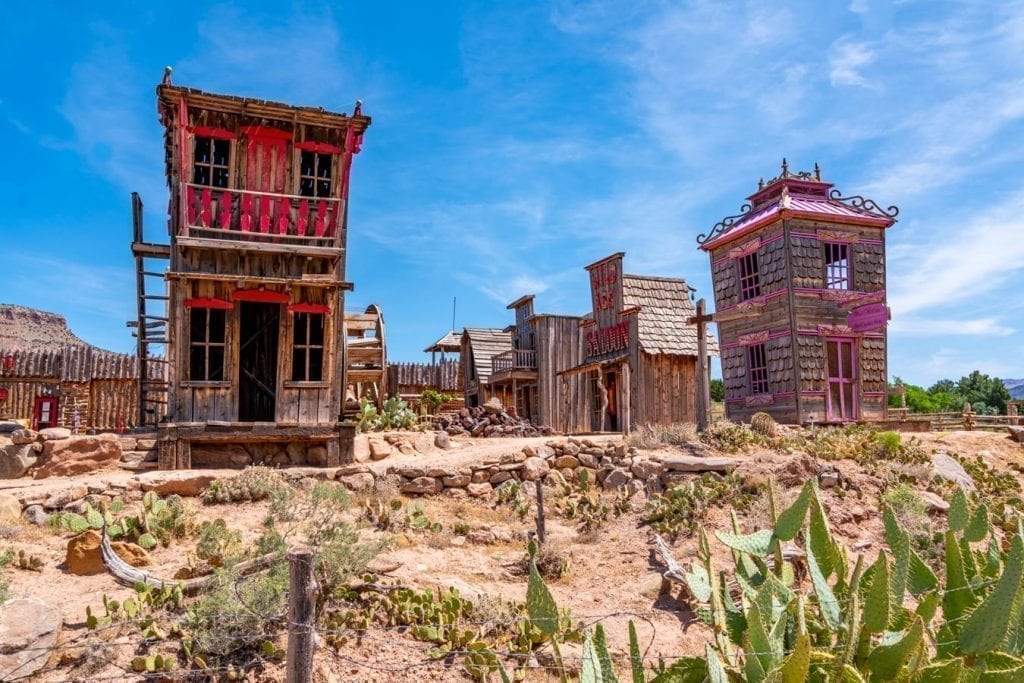
Book your accommodation early!
If you’re traveling during high season, and especially on the weekends, it’s imperative to book your hotel stays ASAP.
Hotels do fill up, especially in places like Bryce Canyon where there are relatively few choices, and you don’t want to be stuck with a less-than-ideal place to stay or an extra-long drive to your park of choice!
We book all our lodging for Utah road trips on Booking.com .
Be prepared for a few dirt roads.
You don’t need a 4-wheel drive vehicle for this Utah national parks road trip (though it would help you reach a few more spots, including Cathedral Valley in Capitol Reef), but you very well might end up down a dirt road or two!
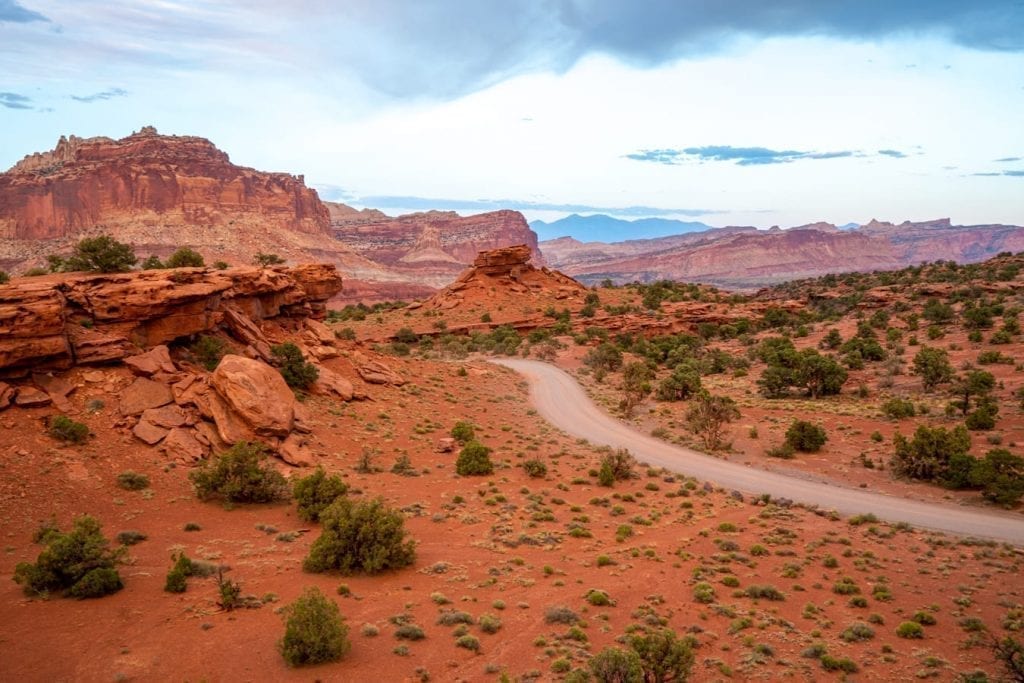
Check on permits if you have your heart set on exclusive hikes.
Some hikes you could potentially complete during your southern Utah road trip do require permits, including the Subway in Zion National Park, the Fiery Furnace in Arches National Park, and the Wave (technically in northern Arizona, but very close to the border).
If you have your heart set on anything in particular, be sure to do a bit of research on how to make it happen before you go.
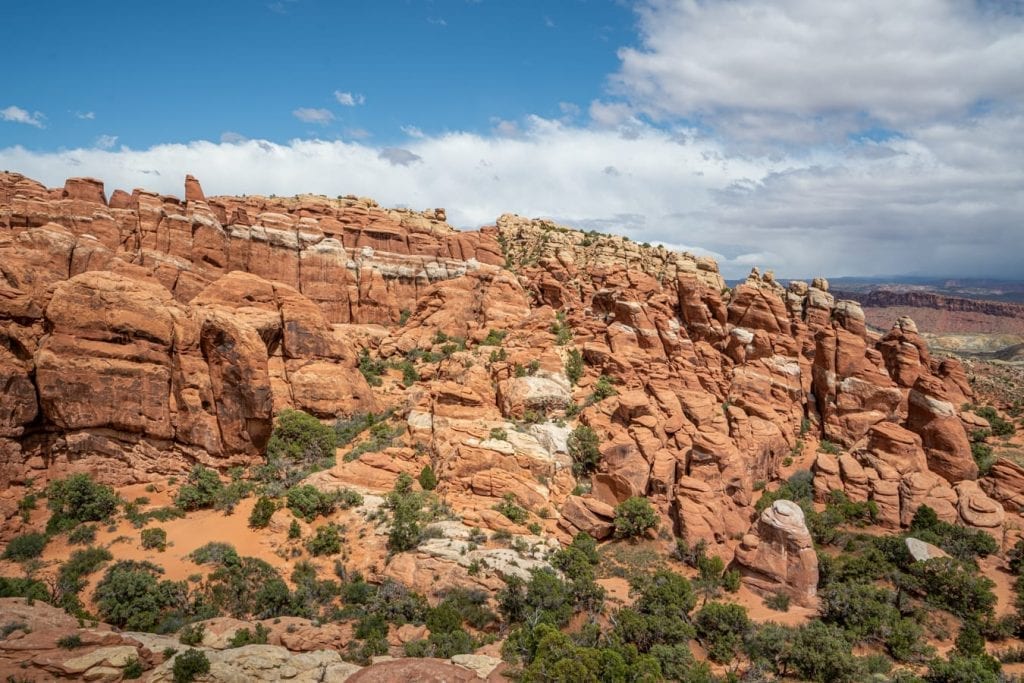
You’ll probably want to do laundry along the way.
This isn’t difficult–most towns along this route, including Moab, have laundromats available, but to make life easier, you may want to bring quarters along with you instead of needing to track down cash during your trip!
Watch the weather carefully during your Utah national parks road trip.
The brutal heat of the desert summer, the snowstorms of the winter, and the potential flash floods throughout the year all mean that watching the weather during your Utah road trip is imperative.
Be sure to bring plenty of season-specific supplies when hiking in Utah, and as always, make sure to put safety first during this Utah national parks trip.
Take This Map With You! Click each highlight to pull up the name of the destination. To save this map to “Your Places” on Google Maps, click the star to the right of the title. You’ll then be able to find it under the Maps tab of your Google Maps account! To open the map in a new window, click the button on the top right of the map.
America the Beautiful Pass — I mentioned this above, but it bears repeating: a national park pass is a must on a Utah national parks road trip!
If you don’t have one before leaving, each of the Mighty Five does sell the in-person.
Travel Insurance (For You) — We don’t ever suggest traveling without travel insurance–anything can happen, and an epic road trip is definitely a case of better safe than sorry. Check travel insurance policy inclusions and prices for your trip here .
Sunscreen — Keep your skin safe from sun exposure both in and out of the car by adding sunscreen to your road trip packing list!
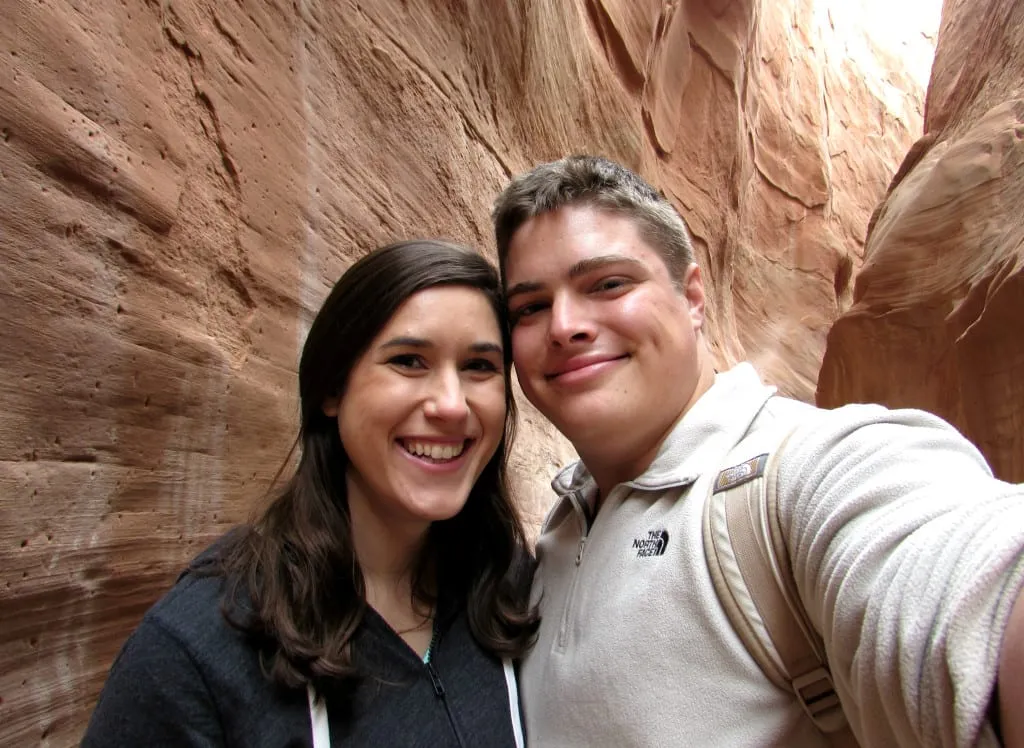
Proof of Insurance (For the Car) — If you’re driving a rental car, this may or may not be covered by either your rental company, your credit card, or your travel insurance–but you’ll definitely want to know exactly what the expectations are before leaving!
Rental Contract (If Applicable) — If you’re renting a car for your road trip, be sure to keep your rental contract handy–we generally keep ours in the glove compartment.
Roadside Emergency Kit — If you’re taking your own car on your road trip, hopefully you already have one of these packed and ready to go–but if not, now is the time to buy one!
Basic roadside emergency kits are extremely useful, very affordable, and a great way to stay safe on the road.
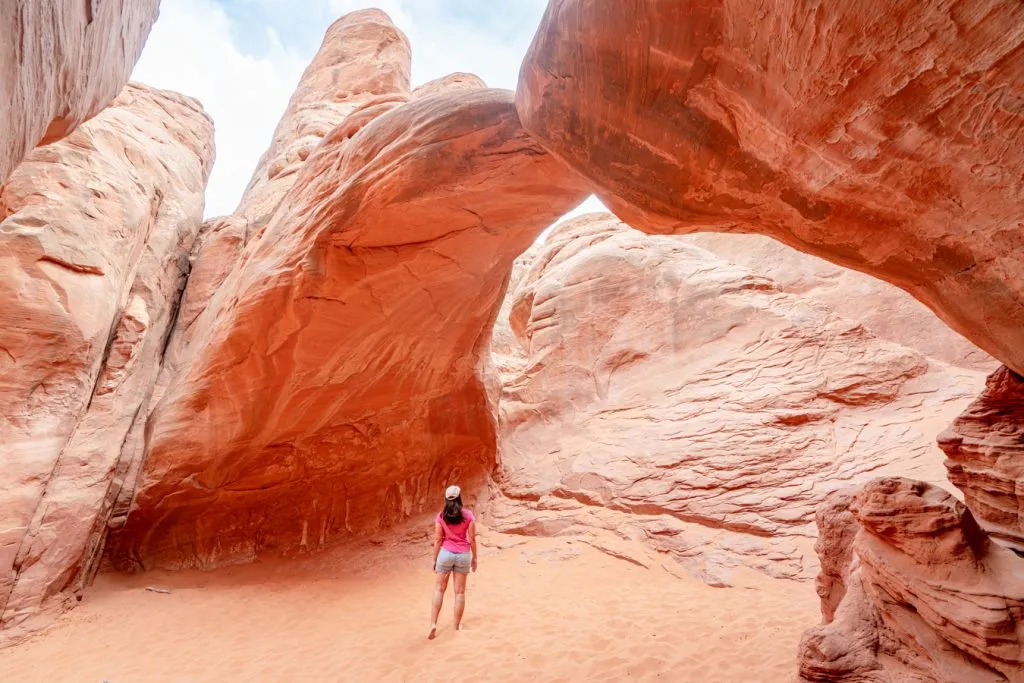
Windshield Shade — During the hot summer months, you’ll no doubt come back from a sweltering hike during your Utah road trip to find your car practically boiling.
Windshield shades aren’t practical for flying with, but if you’re driving your own vehicle to visit Utah’s Mighty Five, you’ll be glad you picked one up before setting off!
Downloaded Maps — You will undoubtedly lose cell signal at some point during this Utah national parks road trip, so make sure to download your essential maps before heading off!
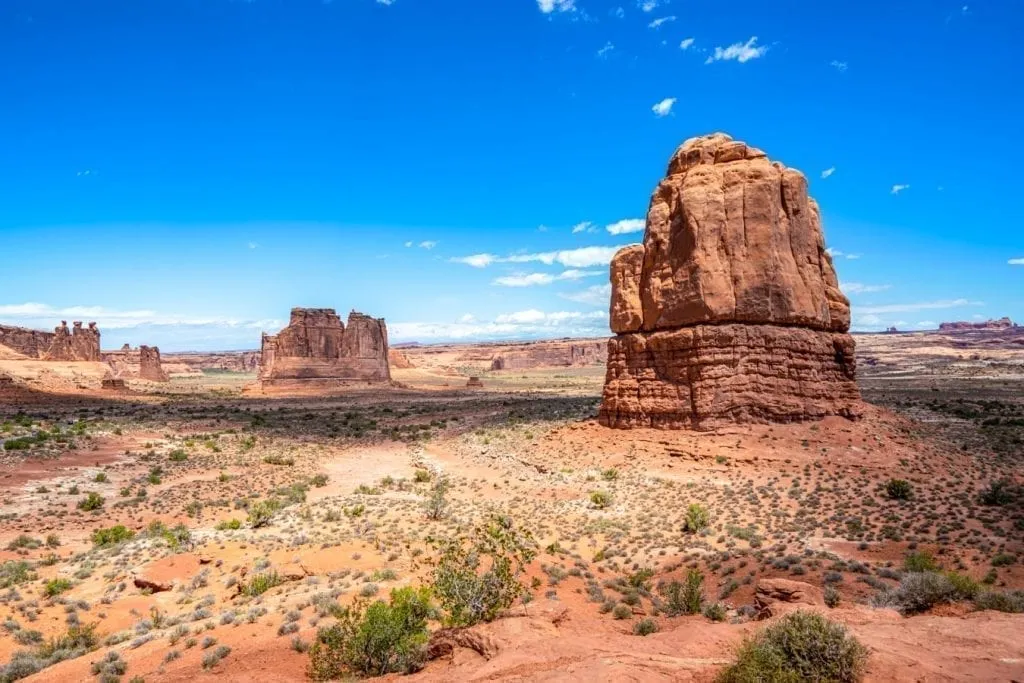
Reusable Water Bottle(s) — Cut down on plastic waste, save money, and make sure you don’t have to stop for water constantly: a reusable water bottle has lots of benefits on a road trip.
We personally love and use these , and love both the look and the functional design!
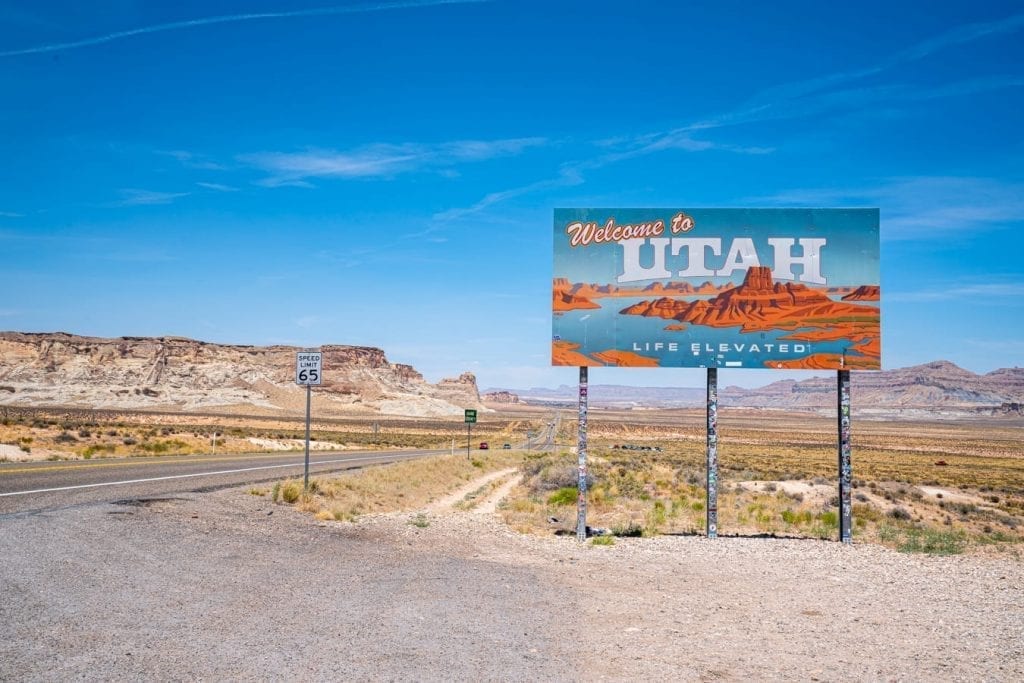
Extra USB Cables and/or Phone Charging Cables — Whether it’s to charge your phone, your camera, or even your portable USB charger, odds are that you’ll be glad to have a few extra cables lying around.
Hands-Free Phone Mount — This is especially important if you don’t have a reliable co-pilot: the last thing you want to do is be fumbling with the GPS on your phone during your road trip.
Pack a cell phone holder to attach to the car and you’ll be able to drive much more safely!
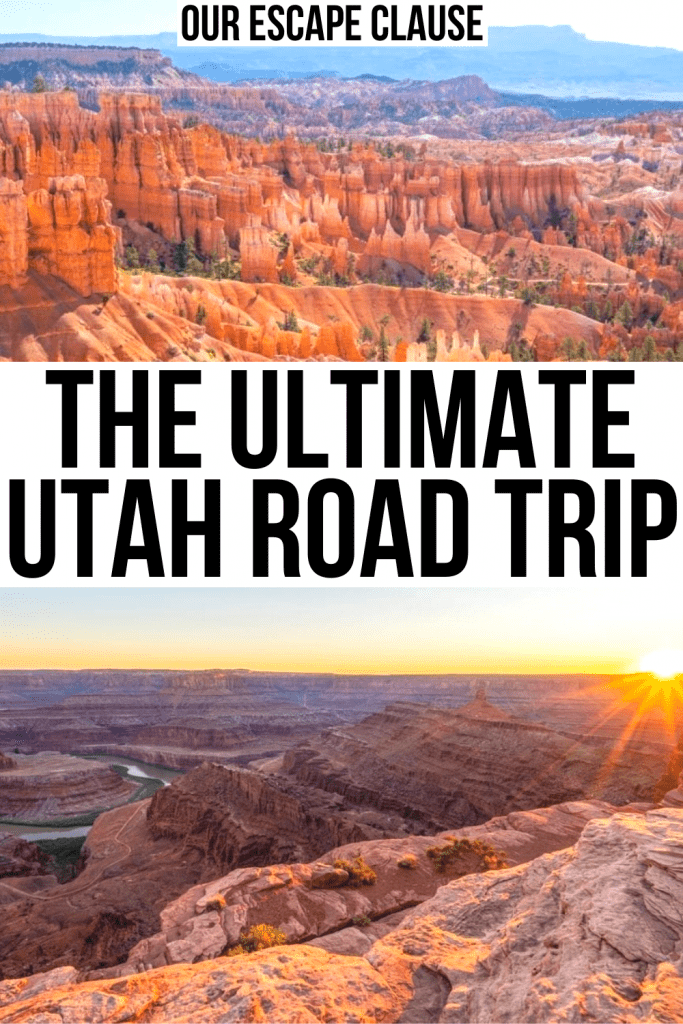
About Kate Storm

In May 2016, I left my suburban life in the USA and became a full-time traveler. Since then, I have visited 50+ countries on 5 continents and lived in Portugal, developing a special love of traveling in Europe (especially Italy) along the way. Today, along with my husband Jeremy and dog Ranger, I’m working toward my eventual goal of splitting my life between Europe and the USA.
5 thoughts on “The Ultimate Utah National Parks Road Trip Itinerary”
That sounds like a pretty kickass itinerary. I love the wild outdoors, and national parks are the one of the best ways to experience native natural history. Love this post wish I living in America right about now, only so I could take this on! lol
Thank you, it was a great trip!
Our National Park system is one of, if not the, top reason to visit the USA in my opinion–we have some incredible (and diverse!) landscapes.
- Pingback: The Great American Bucket List
how many days should we alot for this kind of a trip to UTAH? We were just going to Bryce and Zion but I would want to do the waves. From Utah we were going to Las vegas for a meeting so what would be the most logical place as a last stop in Utah? Thank you for this escape memoir
The core itinerary outlined here takes place over 9 days, but the reality is that a southern Utah road trip can take up as much or as little time as you have!
As I’m sure you know, hiking the Wave requires winning the lottery, so to speak, so you’ll want to base yourself in/around Kanab for as long as possible to give yourselves the best chance of getting to go. Luckily there is lots to see in the area, including the Vermillion Cliffs, Coral Sand Dunes State Park, etc. It is a bit out the way if you’re focusing on Zion/Bryce though!
Driving from Zion to Las Vegas, you could stop around St. George before leaving Utah, or explore Valley of Fire State Park in Nevada.
Leave a Comment Cancel reply
The Ultimate Utah Road Trip (National Parks + Itinerary)
Wondering “How do I plan a trip to all 5 Utah national parks?” Ayyy, don’t stress, we have you covered. Our 10 day Utah road trip will take you through some of the best things to see in Utah, along with the Mighty 5 National Parks.
Utah happens to be one of our absolute favorite states in America. Once you explore Utah for yourself, you’ll soon see why. It’s amazing, it’s diverse and it’s full of adventure. Now, let’s get you prepped, you have a Utah road trip to get to!
Don’t forget to check out our road trip essentials packing list !
10-Day Utah Road Trip Itinerary
Jump Ahead To:
Best Month to Visit Utah
Ok, let’s set the record straight…Utah is amazing all year round. No lie.
- Utah In The Winter: Winter is cold, but it’s perfect for skiing the slopes around Salt Lake City. Another perk is fewer crowds on the hiking trails in the State Parks and National Parks.
- Utah In The Spring: The spring months tend to be the busier months to visit Utah due to milder temps and springtime blooms. Be prepared to deal with large crowds around Spring Break time and Memorial Day weekend.
- Utah In The Summer: Depending on which part of the state you are in, Utah can be hot, hot, hot. The summer is a popular time as school is out so lots of families can be seen exploring the state. However, the sun stays out much longer so you have longer days which is really nice.
- Utah In The Fall: Considered one of the best times to visit Utah, the fall months are great. Changing of the leaves, milder temps but with great weather usually means more crowds.
For us, we visited Utah in late September / early October and it was perfect. Mild to chilly temps, bright sunshine, and nothing was too crowded. If you were to ask us, we say aim to visit Utah during September or October.
Utah Road Trip Map
The Mighty 5 in Utah is something everyone should see in their lifetime. Scattered throughout the state of Utah, the Mighty 5 (sometimes known as the Big 5) refers to the 5 National Parks that are found within the state of Utah. Yes, Utah is so awesome that it’s home to 5 amazing National Parks.
- Arches National Park (Located near Moab, Utah)
- Canyonland National Park (Located near Moab, Utah)
- Capitol Reef National Park (Located near Torrey, Utah)
- Bryce Canyon National Park (Located near Tropic, Utah)
- Zion National Park (Located near Springdale, Utah)
Our Utah road trip will take you on some of the best scenic byways in the country, through some of the best National Parks in America, and give you too many adventures to count.
Getting Around Utah – Rent an RV
One of our favorite ways to a road trip is by RV! It’s your one-stop-shop for everything you need – shelter, food, and clothes. An RV gives you the flexibility to change direction and not have to worry about canceling a hotel reservation and booking a new one. Making it a great “car” to take on your Utah road trip.
It’s a perfect road trip companion and a great vehicle to consider when exploring Utah. From large rigs to camper vans, there is something out there for everyone.
Day 1: Get Yourself To Utah (Salt Lake City or Denver)
To start your Utah road trip, you have to get to the state, right? Two popular jumping-off points to explore Utah tend to be flying into Salt Lake City (airport code: SLC) or Denver, Colorado (airport code: DEN).
Note: While our route takes you from North to South through the state of Utah, you can easily do our route in reverse by flying into Las Vegas and starting South, and working your way North. Totally up to you.
Flying Into Salt Lake City
Once you land in Salt Lake City, plan to pick up your car or RV rental and head south toward Moab, Utah. Moab is located about 3 hours and 40 minutes (234mi / 377km) away from Salt Lake City and where our Utah road trip itinerary begins from.
It’s worth noting that Salt Lake City airport is the closest airport to Moab, Utah.
Flying Into Denver, Colorado
The second closest airport to Moab is Denver International Airport located 5 hours and 30 minutes (355mi / 571km) away. Once at the Denver Airport, plan to pick up your rental car and/or RV rental and head west until you reach Thompson Springs where you’ll take 182 straight-ish into Moab.
Tip: If you don’t feel like driving back to either Denver or Salt Lake City, buy a one-way ticket into either of these airports for your arrival and then a one-way ticket out of Las Vegas for your departure.
Day 2 – 4: Explore Moab, Canyonlands and Arches National Park
Welcome to Moab. Home to two of the Mighty 5 National Parks, a quaint little downtown, and loads of outdoor adventure. Whether you’re looking for a 4×4 off road adventure , white water rafting down the Colorado Rive r or just some epic trails to bike or hike through, Moab is the PERFECT jumping-off point for all of it.
After a day of adventure and outdoor fun, you can mosey through the shops, downtown cafes, and bars. Grab some breakfast and coffee at Jailhouse Cafe or Moab Garage Co ., some lunch or dinner at Moab Food Truck Park or Sunset Grill , and finally, a beer at Moab Brewery .
Perfect for a few day’s stay, you’ll find becoming bored in Moab is next to impossible.
Check Out our Perfect 2-3 Day Moab Itinerary here!
Arches National Park
The first National Park on our Utah road trip is located 5 miles from Moab (about a 9-minute drive). It is here where you’ll find the entrance to Arches National Park . Some 2,000 natural stone arches along with endless, towering desert landscapes can be found here.
Check out Arches National Park in One Day to help you make the most of your time!
Costing $15/vehicle to get in, you can easily spend a day driving the 36-mile (round trip) road through Arches National Park, hiking Arches’ most popular trails like “The Devils Garden Loop” and “The Double Arch Trail” or watching the sunset from the Delicate Arch Viewpoint.
However you choose to spend your time, be it a few hours or a full day, Arches National Park will not disappoint.
TIP: If you want a truly unique experience within Arches National Park, consider booking the “ Fiery Furnace ” tour.
Canyonlands National Park
About a 35-minute drive from Moab and Arches, you’ll find the second of Mighty 5 National Parks, Canyonlands National Park . The expanse of this park is something to see. Canyonlands is the largest of the National Parks in Utah offering dramatic, staggering views of canyons below.
The park is divided into four districts:
- The Island in the Sky: The most popular district offering rim views of the expansive canyons below, pull-offs for photo ops, and trailheads. This district is home to the famous “Mesa Arch”.
- The Needles : Home to popular hiking trails (great for overnight backpacking) and desert landscapes with rock spires.
- The Maze : The most remote of the districts requires a several-day commitment and should only be visited and trekked by experienced hikers.
- The Rivers (Colorado and Green) : For those wanting to get down into the canyon, the river’s section is great for kayaking, guided boat tours, etc.
Whichever district you decide to visit the entrance fee for Canyonlands is $30/vehicle.
Get our complete guide to spending one day in Canyonlands National Park !
Dead Horse State Park
Ok, ok, so yes, not a National Park but Dead Horse State Park is spectacular and since you’re in the area, it should not be missed! Dead Horse State Park is about a 15-minute drive from Canyonlands National Park and about a 35-minute drive from Arches National Park.
A popular choice is to spend the majority of the day in Canyonlands and finish your day (a couple of hours) at Dead Horse State Park. Costing $20/vehicle, Dead Horse State Park is located atop a mesa offering incredible vista views of the land and canyons below.
Where To Stay in Moab, Utah
- The Luxury Inclined | Hoodoo Moab
- The Budget Conscious | Rustic Inn
- Something in Between | Moab Springs Ranch
For more places to stay in Moab, you can check out the latest places and prices here .
Day 5. Experience Capitol Reef National Park
With Moab in your rearview mirror, your sights should be set on the next National Park, Capitol Reef National Park. Located a little over 2 hours away from Moab, Capitol Reef is the least visited of the 5 National Parks within Utah, but don’t let that statement think this park is worth skipping.
TIP: As you leave Moab, be sure to take Highway 24 to Highway 12 as Utah State Highway 12 is considered one of the most scenic drives in Utah.
Costing $15/vehicle for the park entrance fee, Capitol Reef has some amazing hikes like Hickman Natural Bridge or the Cassidy Arch. If you’re short on time or just feel like taking in the sights, we suggest driving the paved Capitol Reef Scenic Drive that winds through some of the best areas of the National Park.
If you’re looking for something more adventurous, canyoneering in Capitol Reef’s slot canyons should be added to your list. However you choose to spend your time, the sights and landscape of Capitol Reef are well worth the visit.
TIP: On your way to Capitol Reef National Park, you’ll pass by Goblin State Park. It’s definitely worth stopping to check out if you have the time. A few hours will give you a taste of what Goblin State Park has to offer.
Where To Stay Near Capitol Reef
- The Luxury Inclined | Courage Ridge Lodge
- The Budget Conscious | Austin’s Chuckwagon Motel
- Something in Between | Capitol Reef Resort
For more places to stay near Capitol Reef, you can check out the latest places and prices here .
Day 6: Adventure Through Grand Staircase-Escalante National Monument
From Capitol Reef, continue on Highway 12 (the scenic byway) for about 1.5 hours, until you reach the town of Escalante. If you find yourself hungry along the way, we highly suggest stopping at Hell’s Backbone Grill .
Grand Staircase-Escalante National Monument is nearly one million acres of public land that offers endless beauty and loads of outdoor adventures. Whether you’re exploring the Petrified Forest State Park, exploring the Peekaboo, Spooky, and Zebra slot canyons, or hiking to Lower Calf Creek Falls and Devil’s Garden, your day will be well spent.
After a day of exploring, plan to grab a bite to eat at Esca-latte Restaurant , Nemo’s Drive Thru or Circle D Eatery . Oh, and if you need a coffee pick-me-up, make a pitstop at Kiva
Where To Stay in Escalante
- The Luxury Inclined | Escalante Yurts
- The Budget Conscious | Prospector Inn
- Something in Between | The Inn of Escalante
For more places to stay in Escalante, you can check out the latest places and prices here .
Day 7: Explore The Hoodoos of Bryce Canyon
Your next stop is the magnificent Bryce Canyon, located about an hour east of Escalante. Known for its vast views and spire-shaped rock formations called hoodoos, Bryce Canyon is truly something to behold.
Costing $35/vehicle to enter the park, that entrance fee is well worth it once you set your sights on the views that await you. Plan to hike the Queens Garden/Navajo Trail Loop to see the hoodoos up close. Then, head up to the canyon rim and walk to a few outstanding viewpoints such as Sunrise Point, Inspiration Point, and Sunset Point.
You can also drive the 18-mile scenic drive that will allow you to get out at the numerous viewpoints that surround the rim of Bryce Canyon. If you love stars, plan to stay after sunset as Bryce is a certified Dark Sky Park, making it perfect for star gazing.
Check out our one day in Bryce Canyon Itinerary here!
Really and truly, it’s impossible to not become smitten with Bryce Canyon. It’s a true gem.
Where To Stay Near Bryce Canyon
- The Luxury Inclined | Bryce Country Cabins
- The Budget Conscious | Red Ledges Inn
- Something in Between | Happy Trails BnB
For more places to stay near Bryce Canyon National Park, you can check out the latest places and prices here .
Day 8 – 9: Stand in Awe at Zion National Park
From Bryce Canyon, you’ll head 1.5 hours southeast to what some consider to be the “mecca” of Utah’s Mighty 5 National Parks, Zion National Park .
Steep red cliff canyon with a flowing cool river and vivid green foliage that lays atop rugged rocks and dirt all set the stage for the awe-filled scenery that makes up the landscape that is Zion National Park.
Costing $35/vehicle to enter the park, Zion is one of the most visited parks in the United States. Once you arrive, you’ll soon see why.
Learn how to spend 2 days in Zion National Park !
The signature sites of Zion National Park are without a doubt Angels Landing and The Narrows. However, some other popular hiking outings to add to your “to-do list” are Observation Point Trail, Watchman Trail, and Overlook Trail.
If you’d like to take a break from hiking drive the scenic Zion-Mount Carmel Highway or hit the cliff side for some canyoneering and rock climbing fun.
After a day of amazing views and fresh air, head out into Springdale (the town that butts up to the entrance of Zion National Park) for some much-needed food.
Bit & Spur , Kings Landing Bistro and Oscars Cafe are great options for dinner and drinks. For breakfast, stop at Cafe Soleil or Deep Creek Coffee Company .
Where To Stay Near Zion
- The Luxury Inclined | Cable Mountain Lodge
- The Budget Conscious | Zion Park Motel
- Something in Between | Best Western Plus
For more places to stay near Zion National Park, you can check out the latest places and prices here .
Day 10: Your Utah Road Trip Comes To An End
A sad day. Your Utah road trip has come to an end. As you leave Zion National Park, the closest airport to Zion National Park is McCarran International Airport in Las Vegas, Nevada – about 2 hours and 45 minutes (172mi / 275 kms) away.
If you have a flight to catch out of the airport you came into (Salt Lake City or Denver), you have a little bit (or should we say a lotta bit) of a drive. From Zion National Park, Salt Lake City is a 4-hour and 20-minute drive (312mi / 502km). Whereas Denver is about 10 hours (628mi / 1010km) away.
If you’re wanting to keep exploring the beautiful southwest of the United States, consider extending your stay to explore some nearby places and National Parks.
- Grand Canyon National Park
- Antelope Canyon
- Monument Valley
- Havasu Falls Hike
- Taos, New Mexico
- Great Sand Dunes National Park
Tips for Visiting Utah National Parks
- National Parks Pass : A great idea if you plan on visiting multiple National Parks throughout the year.
- Get To The Parks Early : Some of the most beautiful and quiet times at any National Park is sunrise. Plus, starting to hike before the heat of the day is always a good idea.
- Pack Your Lunch : Make your lunch and bring it with you. By not having to leave the park to find a place to eat, you get to spend more time in the park. Oh, and pack snacks in your daypack too!
- Come Prepared : If you’re going during the spring and fall months, pack accordingly. The weather can change so make sure you have a jacket . Oh, and protect that skin of yours by applying sunscreen .
- Bring a Reusable Water Bottle: It’s important to stay hydrated and not use single-use plastic water bottles. Another great option is to have a camelbak .
Camping In Utah & Its National Parks
Utah is home to some amazing campsites. You can find campsites scattered about outside and inside the National Parks. For any campsites located within the National Parks, where you are able to, reservations are highly recommended.
If the campsites are first come, first serve, we highly suggest getting to the campground as early as possible to secure a spot.
Be sure to check out our camping tips and essential gear list !
- Arches National Park Camping: Devils Garden Campground
- Canyonlands Camping: Island in the Sky (Willow Flat) Campground, The Needles Campground
- Capital Reef Camping: Fruita Campground, Cathedral Valley Campground, Cedar Mesa Campground
- Bryce Canyon Camping : North Campground, Sunset Campground
- Zion National Park Camping: South Campground, Watchman Campground
For campsites located outside and near Utah’s Mighty 5 National Parks, some require a reservation whereas others are first come first serve. We recommend the ap p Dyrt to help you pinpoint campgrounds in the area that you can call home for the night.
WANT MORE INFORMATION?!
One Day in Arches National Park
How to Spend 1 to 2 Days in Zion National Park
One Day In Bryce Canyon
How To Spend 2-3 Days in Moab
Arches National Park in One Day
Road Trip Essentials
Tips & Essential Gear for Camping
PIN IT FOR LATER!
For more travel tips, guides and awesome travel shots, be sure to poke around our site, follow us on Instagram @wanderingstus , Pinterest and on Facebook . Oh and if you have any questions, let us know in the comment section. We’re happy to answer. Or, just leave us a positive note!
Happy Travels,
– Lauren & Jesse Stuart (The Stüs)
We're Lauren & Jesse, the creators behind Wandering Stus! We've been traveling for decades, exploring and experiencing the very best this world has to offer. Whether we're roadtripping the U.S. in our camper, hiking through National Parks, or jet-setting to different countries around the globe, we write detailed travel guides to help you plan one amazing (and unforgettable) adventure!
Questions?! Let us know. Leave us a comment! Cancel reply
This site uses Akismet to reduce spam. Learn how your comment data is processed .
- Work with us

The ULTIMATE Utah National Parks Road Trip Itinerary (10 days)
Last updated on April 12th, 2024
Hoping to explore Utah’s national parks? In this guide we’re sharing a detailed itinerary for a 10 day Utah national parks road trip! With red rocks, canyons, rivers, hoodoos, arches, and so many other mind blowing natural features, Southern Utah is a GEM in the United States. You could spend a lifetime in just the southern part of Utah alone and still not explore everything there is to see and do! When deciding where to spend a couple months in our van this past spring (mid-March until early May), we quickly set our sights on Southern Utah. Not only did it offer tons of free camping and mild spring weather, but it is also home to FIVE national parks! FIVE!

On our quest to visit all of the US National Parks, we were still missing three of the five Utah national parks, and with the five parks being within a half day’s drive from each other, combining them into one big Utah national parks road trip was a no brainer for us. So we left Texas, where we had been spending time with family, and headed west to Utah. We spent two months driving all around the southern part of the state. We visited the national parks on our days off of work. As well as other spots outside of the park and had the BEST time!
Watch our experience at all five of Utah’s national parks, including hikes, local eats, and so much more!
In this guide we’re sharing all that we learned and experienced during our Utah national parks road trip. We want to help you plan your own! We’ve adapted our own route and itinerary to fit into 10 adventurous and beautiful days. And have also included info about the parks. There’s tons of tips and important things to know, some suggestions of where to stay, and more! We hope this guide helps you experience the beauty of these parks, prioritize your time at them, and have a blast! WARNING: This is a long guide, but we hope it provides everything you need to know to plan your own epic Utah national parks road trip! We have a table of contents feature below if you’d like to skip ahead to any section. Looking for even more detail? We’ve written detailed guides for each Utah national park, which you can find here !
Want an ad-free, downloadable version of this guide that you can save to any device or print? Check out our 10 Day Utah National Parks Road Trip Itinerary eBook !

Want to explore outside of the national parks too? Check Out Our Other Southern Utah Guides:
- Things to do in Kanab, Utah
- Visiting the Toadstool Hoodoos in Kanab
- 1 Day in Page, Arizona Itinerary
- Exploring the Peek-a-boo and Spooky Slot Canyons
- Hiking to Lower Calf Creek Falls
- How to hike to Kanarra Falls near Zion National Park
- How to hike the Corona Arch Trail in Moab
- Best things to do in Moab
- Hiking Wire Pass to Buckskin Gulch
- Visiting the Great Salt Lake
- All of our Utah Vlogs
- All of our Utah Guides
Before embarking on your adventure, please review the Leave No Trace principles to ensure you leave every place better than you found it, so that others can enjoy these beautiful places for many years to come! These seven principles include planning ahead and preparing, hiking and camping on durable surfaces, disposing of waste properly (pack out what you pack in!), understanding campfire rules and always fully extinguishing your fires, respecting wildlife, and being considerate of other visitors.
About Utah’s National Parks
Utah national parks road trip route options.
- How much time is needed to visit Utah’s National Parks?
- When to visit the Utah National Parks
Where to stay for your Utah National Parks Road Trip
- How to get around the Utah National Parks
Things to know before your Utah National Parks Road Trip
What to bring on your utah national parks road trip, some things to know about this utah national parks road trip itinerary, 10 day utah national parks road trip itinerary.
Utah’s five national parks, known as the Mighty Five, include Zion, Bryce Canyon, Capitol Reef, Canyonlands, and Arches National Parks. These parks are all located in the southern portion of Utah. With each park being between 35 minutes to 3 hours from the next closest one. This close proximity makes it the perfect Utah national parks road trip! Here’s a quick rundown of each park and what it has to offer!
Zion National Park

Zion National Park is the 4th most visited National Park in the United States. It is home to steep orange and red cliffs, slot canyons, and the Virgin River, which winds through the park. It’s the most popular park of the Utah national parks road trip. The park is split into five main hiking areas : Zion Canyon (the most popular area and what we will focus on the most), Kolob Canyons, Kolob Terrace, East Rim, and Southwest Desert. Each area has a different vibe, but all offer incredible views of the canyon, peaks, and surrounding area. Some of the most notable sights in this park are Angels Landing. This requires chains in one section and is said to not be for those who are afraid of heights. And The Narrows, which takes you through a river and slot canyon (you will get wet!). But from our experience, you cannot go wrong with any hike in the park, every inch of it is stunning!
Check out our full Zion National Park Guide where we share a more detailed overview of the park, things to do, where to stay, and more! Plus, how to get a permit for Angels Landing (new for 2022!)
Bryce Canyon National Park

Bryce Canyon National Park is famous for having the world’s largest collection of hoodoos. They are rock columns that form over millions of years due to erosion from ice and rain. It became a national park in 1928 and was named after Ebenezer Bryce, a Mormon settler that lived near the park. He built a logging road into the canyon and locals began calling it “Bryce’s canyon.” But back in 1200 AD, well before European Americans and Mormons explored the area, it was occupied by Paiute Indians. And despite its name, Bryce Canyon is not actually a canyon. But rather a collection of natural amphitheaters, which sit along the eastern slope of the Paunsaugunt Plateau. It’s another necessary stop on your Utah national parks road trip!
Check out our full Bryce Canyon National Parks Guide where we share a more detailed overview of the park, things to do, where to stay, and more!
Capitol Reef National Park

Another stop along the Utah national parks road trip is Capitol Reef National Park. This park is named after the white Navajo Sandstone dome formations. They look similar to domes found on capitol buildings. And because the reef of mountains that proved to be a barrier of travel for pioneers. Capitol Reef National Park is approximately 368 square miles in size and is made up of 3 areas to explore. Fruita, Waterpocket (South), and Cathedral Valley (North). Each area is home to great hikes, scenic drives, and views. With the Fruita area being the easiest to access and most popular. This park was the biggest surprise during our time in Southern Utah. We knew the least about it beforehand and were blown away by its beauty and things to do, see, and EAT (they have PIE!!!). Don’t sleep on Capitol Reef!
Learn more about the park, plus see more itinerary options than we will include in this guide in our Capitol Reef National Park guide!
Canyonlands National Park

Canyonlands National Park preserves 337,598 acres of amazing Utah desert scenery. You’ll see colorful canyons, mesas, buttes, fins, arches, and spires all over these gorgeous lands. The park is made up of four districts, the three land districts of Island in the Sky, The Maze, The Needles, and then the two rivers, the Green and the Colorado, that divide the park. These districts may look close on the map, but there are no roads directly connecting them. Traveling between them requires 2-6 hours. Each district offers its own unique character to experience and adventures to be had. Make sure to visit this unique park on your Utah national parks road trip.
Check out our Canyonlands guides ( Island in the Sky and The Needles ) for even more information on this park!
Arches National Park

With over 2,000 arches in the park, including the iconic Delicate Arch, Landscape Arch (one of the longest arch spans in the world), and the gorgeous Double Arch, Arches is the world’s largest concentration of natural arches. Every arch in the park is unique from the others, making seeing each one a different experience. And what made our time in the park extra special was knowing that someday not all of these arches would still be standing. This gave us an extra appreciation for being able to witness this snapshot in time. Not that you needed another reason to make Arches a stop on the Utah national parks road trip!
For more details and everything you need to know before visiting the park check out our Arches National Park guide, including how to get a timed entry reservation !
Map of the Utah National Parks Road Trip
To experience all five of Utah’s national parks, our suggested route is:
Fly into Las Vegas -> Zion National Park -> Bryce Canyon National Park -> Capitol Reef National Park -> Canyonlands National Park -> Arches National Park -> Fly out of Salt Lake City
Note: you could do this route in reverse, but for this guide we will be listing it in the order above, as it’s the closest to our route. The driving time between each of these stops is:
- Las Vegas to Zion: 3 hours
- Zion National Park to Bryce Canyon: 2 hours
- Bryce Canyon to Capitol Reef (Fruita): 2.5 hours
- Capitol Reef (Fruita) to Canyonlands (Island in the Sky): 2.5 hours
- Canyonlands (Island in the Sky) to Arches: 35 minutes
- Arches to Salt Lake City: 3.5 hours
A few things to know about this Utah national parks road trip route and your options
One way vs. loop: This Utah national parks road trip route is about 14 hours of driving and while you could do this route as a loop, starting and ending in the same city, it will add on a couple extra hours of driving. If you were to do a loop, the shortest option is to fly in and out of Salt Lake City (SLC). Close to 16 hours of driving. Whereas flying in and out of Las Vegas (LAS) is 17 hours of driving. Moab area parks: You can switch Canyonlands and Arches National Parks. These parks are right by each other in Moab. So you can do them in whichever order you’d like without it adding on extra time! Other airport options: While Las Vegas (LAS) is the closest major airport to Zion National Park at about 3 hours away, St. George (SGU) does have an airport you can fly into, which is about an hour from Zion National Park. It has flights from Denver, Salt Lake City, Phoenix, and Dallas. So if you live in one of those cities, or don’t mind a layover, it may be a good choice! Moab also has an airport called Canyonlands Field Airport (CNY), which is only 20 minutes from Moab. This airport has flights from Salt Lake City and Denver. But it will be harder to get flights than if you flew into Salt Lake City.
How much time is needed for a Utah National Parks Road Trip?

This itinerary is for 10 days. But you could cut it down to 7 or 8 and spend one day at each park. Plus two days for travel. We’d recommend 10 days if you are able to, as getting between the parks can take some time and each one offers so much to see and do! While we did this Utah national parks road trip over two months, the majority of those two months were spent working and we had a handful of days spent in non-national park areas as well. So even though we did not spend 10 days back to back exploring the national parks, this itinerary is still almost identical to ours, but with modifications to ensure you have enough time for what we suggest and enough time to drive between the parks. If you have extra time, we suggest adding on some other spots outside of the national parks along the way. We will include some suggestions under the appropriate day of the itinerary!
When to visit the Utah National Parks Road Trip
While the Utah national parks are open year round, there are a few things to consider when choosing when to go on your Utah national parks road trip, including weather, holidays, and crowd levels. Here’s a quick rundown of what each season brings to the parks!

We did the Utah national parks road trip in the spring and the weather was pretty perfect! With cool mornings, warm afternoons, and lots of sunshine, weather-wise it’s one of the best times in the park! However, the crowds can be pretty high in the spring. Especially with spring break in March and April all across the US. As well as Memorial Day at the end of May. We did notice pretty large crowds in the parks, but if you start early, you’ll have some solitude.
The summers in Southern Utah are VERY hot, with 100 degrees being pretty common. We’d suggest avoiding the parks in the summer. The heat is brutal, the crowds can be high due to summer vacation, and afternoon thunderstorms can be common. This can cause flooding and make specific hikes dangerous. However, if you do plan to visit in the summer, we suggest starting very early to beat the heat. Be sure to take lots of water on hikes. And if you can, stay somewhere with a pool so you can cool off in the middle of the day.
Similar to the spring, the fall brings more mild temperatures. This makes the parks more enjoyable. With kids back in school and less holidays during this time, the fall would be a slightly less busy time to visit.
It is possible to visit the parks in the winter. But snow and ice can cause closures to trails and roads. It may possibly limit you on your trip. But, if you’re comfortable with the conditions and taking a little bit of a risk with weather impacting what you can do, you’ll be rewarded with less crowds and maybe some magical snowy views. One thing to keep in mind is that some of the towns near the park have less restaurants open in the winter. (We found many restaurants are only open from March-October or November). Also the parks tend to have more limited services during this time.
TIME OF DAY
We’ve said it many times and we’ll say it again, our biggest tip for visiting just about any hike, national park, or popular place, GO EARLY! This tip has never failed us and oftentimes the sunrise light can be the best for photography.

You’ll need to stay in different areas most nights of your trip. This will cut down driving and give you more time to explore. We will include our advice on what area to stay in during your Utah national parks road trip. Plus a few suggestions of where to stay under each day of the itinerary. But for a longer list of lodging options, check out our individual Utah national park guides ! Suggestion : Southern Utah is the perfect place to travel in a van or RV. There’s tons of free camping options, which is why we “lived” there for two months! We have included dispersed camping options under each day. But to find more free camping options, we love Campendium and freecampsites.net !
Want to find campsites all over the US? Try the Dyrt PRO for FREE for one month! The Dyrt is the #1 camping app in the US! Sign up for a FREE 30 day trial of their PRO version using our code AplusK ! The Dyrt PRO offers many incredible features to make finding campsites even easier (+ cheaper). Some of our favorite features are: -Offline maps, so you can find campsites without cell service -Map layers to find free camping areas (+ cell phone service map layers) -Discounts from PRO partners and on campground bookings (up to 40%!)
How to get around on YOUR Utah National Parks Road Trip
Whether you fly to visit the Utah national parks and rent a car or if you drive from a nearby area, you will need to have a vehicle to properly explore the parks. We designed this Utah national parks road trip guide to be doable for any type of car . But if you want to have a bit more freedom and explore areas not on our main itinerary (like Cathedral Valley), we’d suggest getting a 4×4 vehicle if possible so you have the ultimate freedom to explore. Important reminder: If you do this route as planned, remember to make your rental car pick up and drop off locations different, as you’ll be flying in and out of different airports. If the fee to do this is too high, we’d suggest flying in and out of one airport instead. As the extra mileage isn’t too bad and you could see more scenery!

Rent a van!
As we mentioned above, Southern Utah is perfect for van life! If you want to rent a van, we suggest looking into Outdoorsy , which is like Airbnb for campervans!
Park Shuttles + Vehicle Restrictions
Both Zion and Bryce Canyon have free park shuttles that you can utilize. But the other three parks do not and you will need to drive yourself around. However, there are some things to be aware of when it comes to driving and taking the shuttle in Zion and Bryce Canyon.
Zion shuttle system
Zion has two free park shuttle options that run from March through November. The first shuttle takes you from the town of Springdale into the park. The other takes you onto the Zion Canyon Scenic Drive. The Springdale Shuttle, also known as the town shuttle, makes stops at 9 different stops in town. And it drops you off at the bike/pedestrian entrance to the park. This is a good option if you cannot find parking in the park. Or if you just want to shuttle into the park from your hotel or Airbnb. The other shuttle option takes you down Zion Canyon Scenic Drive. During the shuttle months it is NOT accessible by private vehicle unless you’re staying at the lodge inside the park. This means you are required to take the shuttle to go down this road. The Zion Canyon Shuttle runs from the visitor center up Zion Canyon Scenic Drive to many popular spots. This includes the trailheads for Angels Landing and the Narrows. The lines can get pretty long for the Zion Canyon Scenic Drive shuttle. Arrive early and be prepared to wait. Also, make sure not to miss the last shuttle of the day. It is a long walk back to the visitor center (8+ miles). You can find more information and see the exact shuttle schedule on the park website .

Zion Mt. Carmel Tunnel Restrictions
Driving a large vehicle on the Utah national parks road trip? Anything over 11’4″ (3.4m) tall or 7’10” (2.4 m) wide must get a $15 tunnel permit to go through the Zion-Mount Carmel Tunnel, which connects the eastern and western entrances of the park. This is because you will have to drive in the middle of the tunnel, taking up both lanes. They’ll have to shut down one way so you can get through. There are also specific times you can access the tunnel if you’re an oversized vehicle, which varies by month.

Bryce Canyon shuttle + length restrictions
Bryce Canyon also has a free shuttle that will take you to the popular areas of the park. We didn’t have any issues getting parking. So we recommend parking at the park, assuming you arrive early. However, between April and October, any vehicle over 20 ft long (like our van!) cannot drive in the main amphitheater area during shuttle hours. You will need to park in an oversized lot and take the shuttle in. We avoided this by visiting in March, when we were allowed to freely drive around. You can learn more about the shuttle hours, stops, and oversize parking here !

Tips for planning a Utah National Parks Road Trip
Here are a few important things to know before hitting the road on your Utah national parks road trip!
Get the America the Beautiful Pass
Each national park costs between $20-$35 per car for a 7 day pass. This pass will only get you into that specific park, not all five of the national parks. We suggest buying the America the Beautiful pass . It costs $80/year and will get you into all of the national parks for free!
Book in advance
The Utah national parks are very popular between the spring and fall. So if you plan to book hotels, Airbnbs, and campgrounds, make sure to book early! This is especially key for Arches National Park, which now requires a timed entry permit!
Arches National Park now has timed entry reservations
Similar to Rocky Mountain National Park , Arches National Park is implementing a timed entry reservation system. This is to help manage crowds and also maintain the park’s landscape. This will allow people to enjoy it for years to come. These reservations will be required between April 1 to October 31, 2023 to enter the park between 7 AM-4 PM. However, you can enter the park without a reservation outside of those times. We HIGHLY recommend that anyways so you can beat crowds and see the sunrise and/or sunset in the park. Reservations will open up three months in advance for the entire month. For example, on February 1st, the entire month of May will open for reservations. There will also be a select number of reservations available at 6 PM MDT the day before you plan to visit. You can learn more about the process here !
Angels Landing at Zion now requires a permit
Angels Landing now has a lottery permit system due to the increased usage of the hike. It costs $6 (nonrefundable) to enter the lottery. And if you are lucky enough to get a permit, it also costs $3 per person for the permit. There are a couple ways to enter the lottery, both in advance and the day before. You can find out more about this permit system here .
Pets are (mostly) not allowed
Pets are typically not allowed on any Utah national park trails and are only allowed in developed areas, such as parking lots, and campgrounds, so please leave your furry friend at home or in a safe, cool spot!
Learn how we travel with a dog and what we do with Kona when she cannot join us at the national parks.
Cell Service is limited
There were many times, both in the national parks, as well as driving between them, where we had zero cell service. We highly recommend downloading offline AllTrails Maps and offline Google Maps. This way you can navigate without cell phone service and don’t get lost!
Want to get 30% off an AllTrails+ membership ? Use our code aplusk30 (you must redeem this code on the website, not the app)! We use AllTrails+ on every single hike and it is the most helpful hiking tool out there! Some of the features we love are offline maps (so we can navigate even without cell service), wrong-turn alerts, and its 3D maps feature, so we can get a feel for trails before we hike.
Amenities can be limited
Some parks are close to decent sized towns (like Zion, Canyonlands, and Arches). While others are more remote (Bryce Canyon and Capitol Reef). Make sure to fill up on gas and have lots of snacks and water with you!
Check the weather conditions before you go on a Utah national parks road trip
Always check the weather conditions the day or two before you visit a specific park. Especially before driving down the Utah backcountry roads or entering slot canyons. Slot canyons can be extremely dangerous and flash flood quickly when there is rain. Even if it is raining miles away. Never ever enter a slot canyon if there is rain forecasted in the area!

A common question we get when sharing our adventures is what we bring with us. We have almost all of our gear listed here . But here are some items we especially recommend bringing to Southern Utah for a Utah national parks road trip!
TEN ESSENTIALS
As always, we recommend having the 10 essentials on you when doing any hike. While most national park trails are very maintained and easy to follow, accidents can happen anywhere and it’s good to be prepared!
HIKING SHOES
Hiking along canyon rims, on sandstone, and in canyons require a sturdy shoe. So you’ll want to wear proper hiking shoes. We almost always wear our Lowa Renegades (Kathryn) and Altra Superiors (Adam), but also love our Chacos . These are great hiking sandals for the warmer months and for sandy and smooth rock terrain.
Despite being more of desert climates, the parks range in elevation. If you go in the spring or fall, temperatures in the high desert can swing up to 40 degrees in one day! We visited in March and April and typically started our days in the spring with jackets or pullovers on. Then ended in t-shirts or tank tops.
SUN PROTECTION
Almost all of the hikes at these parks are very exposed. We’d suggest bringing sunscreen, sunglasses, and a hat to stay protected. We have been using Bare Republic , which is a “better for you” sunscreen. Although it may give you a nice white, vampire-esque sheen.
Water is a must in the desert! We love our Camelbak bladder for hikes because it stores a ton of water. And it’s easy to drink from while moving.
Make sure to bring along some snacks for your hikes and on the Utah national parks road trip! We love the meals and bars from Wild Zora (if you use our link you’ll get 15% off your purchase) and some of our other favorite snacks are trail mix, lunch meat, carrots and hummus, apples, chicharones, and pistachios.
ALLTRAILS MAPS
We’d highly recommend downloading the AllTrails maps for all hikes you plan to do before you go. While the trails are mostly easy to follow, we like to use the map to track our progress along the trail. You will need an AllTrails+ membership to download maps, which is $35.99 a year and so worth it!
Before we jump into all of the best things to do on the Utah National Parks road trip, here are some notes we wanted to make about this itinerary.
- As we mentioned above, you can shorten it to fit your trip length. If you have any questions or want any tips on what to prioritize, send us an email at [email protected] . We’d be happy to help!
- We love jam packed adventures and typically need a vacation from our vacation. This guide is loaded with hikes and activities, with many early wake up calls. So it may not be super relaxing, but you will beat some crowds this way.
- On a similar note, we have included both easier and harder hikes on this guide This is to make it doable for different activity levels and to give you options to choose from.
Now that you know a bit more about the parks, what to bring, and when to visit, it’s time to start planning! This Utah national parks road trip itinerary will mostly be based around our actual time in the parks and what we did. There’s a large focus on hiking and free activities (vs. paid tours). We have a suggested itinerary for each day. It can of course be adjusted to what you want to do, how much you want to do in a day, and how much time you have. To keep this itinerary easier to follow and not too overwhelming, we’re keeping it a bit more brief than our individual guides. To find more information about the parks, ideas of things to do, where to eat and drink coffee, and more options of where to stay each night, check out the individual guides we have for the Utah national parks.
- Zion and Bryce Canyon National Park
- Capitol Reef National Park
- Canyonlands National Park- Island in the Sky
- Canyonlands National Park- The Needles
- Arches National Park
Day 1: Land in Las Vegas

- Welcome to Las Vegas! After landing at the airport, depending on how early you arrive and how much time you have, you can either spend a couple hours exploring Sin City (we have some of our favorite things to do in Vegas here !) or hit the road to Zion National Park.
- If you are hungry, we highly recommend grabbing tacos in Vegas at one of our favorite taco spots ever , Tacos El Gordo . We also loved La Cocina Mexican Street Food in St. George, Utah!
- Once arriving near Zion National Park, get some rest so you’re ready for 8 nonstop days of exploring the Utah national parks road trip!
Where to stay:
For day 1, staying at Zion National Park will be the best option. You can start bright and early the next morning! Zion is located right by Springdale, which has many accommodation options, such as campgrounds in the park, hotels, and vacation rentals.
Campgrounds: South Campground & Watchman Campground Dispersed Camping: Old Highway 89 (Kanab) & Hurricane Cliffs Hotels: Zion Lodge (located in the National Park), Desert Pearl Inn , Springhill Suites , Holiday Inn Express , La Quinta Inn & Suites Vacation Rentals: Springdale Townhome , Tiny Cabin at Zion , Luxury Suite
Curious how we get FREE flights and hotels? Check out our list of our favorite travel cards that have saved us thousands of dollars!
Day 2: Zion National Park

Read our Zion National Park guide for a much more in-depth look at the park, as well as where to eat, more places to stay, and more things to do!
- Start the Utah national parks road trip with sunrise on the Canyon Overlook Trail . It is one of the BEST views in the park in our opinion, especially for how easy it is! The trail is only 1 mile round trip and has 163 ft elevation gain. And despite having a couple narrow spots, it’s easy to navigate in the dark. We suggest getting there 15-30 minutes before sunrise so you can watch the canyon start to light up!
- After sunrise, grab coffee and breakfast at Deep Creek Coffee Co. , which is one of our favorite spots in Springdale. Their food and coffee is amazing and the views are top notch!
- Observation Point via East Mesa (6.7 miles, 695 ft elevation gain): While Angels Landing gets all the hype, we think this hike is even better, as it is less crowded, less scary, and has higher views than Angels Landing. The original trail has been closed due to rock slides. But if you hike via East Mesa, you still get to the epic view at the end! Even though it isn’t as scenic along the way. Check out our guide to hiking to Observation Point to learn more about this trail and where to park. Note: This will require a bit of a drive from Springdale.
- Angel’s Landing (5 miles, 1,630 ft elevation gain): This is one of, if not the most popular hikes in the park. It is known for its chains section. A narrow section with drop offs on one side and chains to hold onto. This hike can get very crowded (there is sometimes an hour wait to get to the top). And if you’re afraid of heights this hike may not be for you. NOTE : There is now a lottery permit system starting April 1, 2022. This means only those who get lucky and win a permit will be able to hike. You can learn more about this permit process here .
- Watchman Trail (3.1 miles, 646 ft elevation gain): This hike starts right in the visitor center parking lot. It takes you to a great view of a peak called the Watchman, as well as the park and Springdale. For only 3.1 miles, the scenery is pretty amazing!
- Grab dinner at Oscar’s Cafe , a delicious spot with AMAZING burritos and enchiladas!
- Enjoy sunset on the Pa’rus Trail . An easy, flat pathway that has great views at the Canyon Junction bridge for sunset.
You will still want to stay near Zion National Park so you can have one final adventure tomorrow.
Day 3: Zion National Park

- For your final day at Zion National Park, grab a quick coffee and bite to eat at Perks! . It opens at 6 AM and is perfect if you want to get an early start.
- If you want an alternative to the Narrows, we suggest hiking to Kanarra Falls . It is a mini version of the Narrows. This hike requires a permit, so it is less crowded, but is still an incredible experience. Plus has some unique features, like a ladder and waterfalls!
- Drive to Bryce Canyon National Park for your second stop on the Utah national parks road trip. It is about a 2 hour drive from Zion National Park. Note: There aren’t a ton of good dining options near Bryce Canyon. So we suggest picking up food at the store in Springdale before you hit the road. This way you can cook some of your own meals. Two restaurant options are Bryce Canyon Pines Restaurant and Stone Hearth Grille .
- If you’re up for an activity when you arrive, head to Bryce Point for sunset! While most overlooks in the park face east, this one faces north. You’ll be able to see some nice sun flares as the sun tucks behind the Bryce Canyon amphitheater.
OptionAL Utah national parks road trip Add On: Other areas of Zion
If you have extra time between Zion and Bryce Canyon, we highly recommend visiting Kolob Canyons and Kolob Terrace, which are much less visited areas of Zion National Park and SO beautiful! Kolob Canyons : Hike the Middle Fork Taylor Creek Trail (4.9 miles), Timber Creek Overlook (1.1 miles), and Kolob Arch (13.7 miles) Kolob Terrace : Hike the Northgate Peaks trail (6.0 miles), which is an easy hike with an awesome payoff at the end.
We suggest staying at Bryce Canyon for the night so you can start before sunrise the next morning. Campgrounds: Sunset Campground (closed in winters), North Campground (open year round) Dispersed Camping: Tom’s Best Spring Hotels: The Lodge at Bryce Canyon (located in the National Park), Best Western Plus Ruby’s Inn , Best Western Plus Bryce Canyon Grand Hotel Vacation Rentals : Farriers Quarters Studio , Ranch Hands Bunkhouse , Quaint and spacious cabin , King Tent , Deluxe Private Yurt , Affordable Family Fun
Want to get 15% off a Harvest Hosts membership? Click this link and then use the code HHFRIENDS15 ! Harvest Hosts is a network of destinations across the US and Canada that allow RVers (or Van Lifers like us!) to stay overnight for free with the membership! These destinations include wineries, breweries & distilleries, farms, golf courses and more! The annual membership gives you unlimited access to spend the night at any of the Host‘s locations for the year. There are 7,000+ super unique places to choose from and they are located all over the country. We even stayed at an alpaca farm once!
Day 4: Bryce Canyon National Park

Read our Bryce Canyon National Park guide for a much more in-depth look at the park, as well as where to eat, more places to stay, and more things to do!
- The #1 suggestion we have for Bryce Canyon National Park is to watch the sunrise! . We know this is so hard to do on vacation, especially a busy Utah national parks road trip like this. But it’s so worth it. The major overlooks in the park face east and seeing the hoodoos light up is magical! Sunset Point , which despite its name, is said to be a great spot for sunrise. But we have always enjoyed just finding a random spot on the rim. Somewhere between Sunset Point and Sunrise Point to watch the sunrise.
- Navajo Loop & Queens Garden Trail (3.5 miles, 662 ft elevation gain): This hike gets you up close and personal with the hoodoos in the park and is a MUST do! If you only have time for one hike, this is a great one to choose.
- Fairyland Loop (7.9 miles, 1,545 ft elevation gain): This hike is pretty challenging, but way less crowded and you get great views of the park! You can either start at the Fairyland Loop trailhead or at Sunrise Point. If you start at Sunrise Point, we suggest going clockwise. And if you start at the Fairyland Loop trailhead, we suggest going counter clockwise. This way, you get the “boring” part out of the way first. To learn more about the Fairyland Trail, read our guide to the hike !
- Figure Eight Trail (6.3 miles, 1,499 ft elevation gain): This hike combines the Navajo and Queens Garden Loop from above, plus Wall Street and Peekaboo Loop into one gorgeous hike through the hoodoos!
- Finish the day with a drive down the Bryce Canyon scenic drive (38 miles roundtrip) and enjoy the views from the Rainbow Point, Natural Bridge, Inspiration Point, and Bryce Point overlooks. If you have enough time, you can also stop by Mossy Cave , which is located outside of the main park area, to see a waterfall and a cool mossy cave.
Optional Utah national parks road trip Add On: Grand Staircase-Escalante National Monument
If you have an extra day between Bryce Canyon and Capitol Reef, we suggest spending a day or two in the Grand Staircase-Escalante National Monument. Two of our favorite activities were Lower Calf Creek Falls and Peek-a-Boo and Spooky Slot Canyons !
We’d suggest staying at Bryce Canyon again since you’ll have had a long day and the drive to Capitol Reef is 2.5 hours. But if you decide to go to Capitol Reef after exploring Bryce Canyon, we’ll share some places to stay under Day 5.
Day 5: Capitol Reef National Park

Read our Capitol Reef National Park guide for a much more in-depth look at the park, as well as where to eat, more places to stay, and more things to do!
- If you stayed at Bryce Canyon National Park last night, make the 2.5 hour drive to the Capitol Reef’s Fruita Historic District . This is the most accessible area in the park. This drive is beautiful and we suggest leaving as early as you can to get to Fruita early enough for a very special treat.
- First up, get PIE at the Gifford Homestead ! The Gifford Homestead is a historic homestead that has been home to many families over the years. And between March 14 (Pi Day) to October 31, the Gifford Homestead sells locally made fruit pies. They are amazing , as well as homemade ice cream. We tried the strawberry rhubarb and apple and loved them both! The pies do sell out, so arriving early to the park is key to ensure you have your pick of flavors! The Gifford Homestead also sells delicious cinnamon rolls (so we hear), but these sell out almost instantly.
- While in the Fruita Historic District, walk around the orchards ! These orchards were planted in the 1880s by Mormon settlers. They are maintained by the park staff using the original irrigation canals dug by the pioneers and heritage techniques. You can pick the fruit during the prime picking season which is mid-June through the end of October. It sounds like such a fun and unique national park activity! The type of fruit you can pick varies on the month you visit. You can see the harvesting schedule here !
- While in the Fruita area we also suggest visiting the Fruita schoolhouse . A one room schoolhouse that was built by residents in 1896. It also served as a church, community meeting house for dances, elections, town meetings, and more! It has been restored to what it looked like in the 1930s. During certain hours you can walk inside and take a look!
- Another great hike to check out in the Fruita area is Cohab Canyon (3 miles, 793 feet of elevation gain). This hike starts right by the Gifford Homestead and will give you amazing views of the Fruita Historic District, as well as the surrounding area.
- For your final hike of the day, hike to Hickman Bridge (1.7 miles, 416 feet of elevation gain), which is a short, fun hike that takes you to a huge sandstone natural bridge that spans 130 feet and is 125 feet high, which you can walk under! You could also continue on to the Rim Overlook (this will add on 3.7 miles and has a total of 1,053 feet of elevation gain), which shares the beginning of the trail with Hickman Bridge. This is a tough hike, but the views of the park, especially the Fruita Historic District, are amazing! We found the crowds to be less busy here too! Tip: we’d suggest choosing the Rim Overlook or Cohab Canyon. Doing both would be a lot in one day and they have somewhat similar views of the Fruita area.
- Enjoy dinner in the town of Torrey! We suggest checking out Capitol Burger or Chak Balam !
For Day 5 of the Utah national parks road trip, we suggest staying near Capitol Reef. This way you can explore a few more spots in the morning before driving to your next national park! Campgrounds: Fruita Campground (inside the park) Dispersed Camping: Beas Lewis Flat Campground & Capitol Reef Overflow Dispersed Camping Hotels: Capitol Reef Resort & Red Sands Hotel Vacation Rentals: Torrey Pines Cozy Cabin , Sandcreek Cottage
Day 6: Capitol Reef National Park

- Start the morning early and hike to Cassidy Arch (3.1 miles, 666 feet of elevation gain) for sunrise. While you could wait until the sun is up to do this hike, we LOVED hiking to the arch in the dark and getting to witness a magical sunrise along the trail and having the arch ALL to ourselves! The arch gets its name after the outlaw Butch Cassidy, who apparently had a hideout in Grand Wash. And what is amazing about this arch is that you can walk onto it! It may look sketchy to walk on from afar, but it’s very wide and we felt totally safe. Even if you don’t want to do this hike for sunrise, make sure to start early! The parking lot isn’t huge and it gets very busy.
- After finishing your hike to Cassidy Arch, continue on through part of the Grand Wash , which shares a trailhead with Cassidy Arch. This trail has multiple trailheads and you could hike to the other one, but we suggest making it to the Narrows (1.5 miles in) and then turning around. This hike is flat and easy, but takes you through some very tall canyon walls, which make you feel tiny!
- Continue down the scenic drive to Capitol Gorge, which requires driving on a dirt road for the last 2 miles, and if you’re up for it hike part of the Capitol Gorge trail (4.5 miles, 374 feet of elevation gain)! We tried to do a portion of this hike, but the parking lot was jam packed by the time we made it there (early afternoon), with no room to park our large van, so we were unable to stay unfortunately. And while this hike has some mixed reviews (some say it’s not as impressive as the Grand Wash), it does have a Pioneer Register, which is a wall that pioneers wrote their name and date on when passing through the area many years ago, which we think sounds worth checking out. You could just go to this portion of the hike and then turn around.
- Start your 2.5 drive to Moab to visit your final two national parks on the Utah national parks road trip! If you get hungry on the drive, we highly recommend Tacos la Pasadita in Green River. We LOVED their vampiros, which are kind of like quesadillas with meat.
- Settle into your lodging in Moab and get ready for another day of adventuring!
Optional Utah national parks road trip Add Ons: Navajo Knobs, Cathedral Valley, & Goblin Valley
If you have an extra day between Capitol Reef and Moab, or you just want to cut your time in the Fruita area of Capitol Reef short, we suggest adding on either Navajo Knobs, Cathedral Valley (if you have the right vehicle), or Goblin Valley State Park. Navajo Knobs is a 9.1 mile hike that shares part of a trail with the Hickman Bridge and Rim Overlook. So if you choose to do this hike, we’d suggest combining it with those. This was our favorite hike in Capitol Reef, but it was tough , so if you’re looking for a butt-kicking hike, with epic views, Navajo Knobs is the hike for you! The views on this hike were amazing the entire way as you climb high up, skirting the canyon rim, scrambling over some boulders, and getting views of the Fruita area, crazy rock domes, and really unique rock formations like the Castle. Cathedral Valley is north of the Fruita region of Capitol Reef and has a 60 mile driving loop , which consists of unpaved roads and takes about 6-8 hours to complete. There are many side trips and hiking opportunities along the way and some of the park’s most iconic sites, like Temples of the Sun and Moon, are located here. But you really need a 4×4 vehicle to do this driving loop, as it can be sandy and if you get stuck, it may be very hard to get help. Goblin Valley State Park (costs $20 per car to enter) is about 1 hour and 15 minutes from Capitol Reef National Park, on the way to Moab, and is home to tons of hoodoos, which resemble goblins. But one of the coolest things about Goblin Valley is that it’s basically a giant playground! While there are some “trails” here, it’s mostly a choose your own adventure type experience, where you can walk all through the hoodoos. We recommend just walking around and exploring and if you decide to skip Capitol Gorge at Capitol Reef, you could likely squeeze in Goblin Valley, which only requires a few hours, on your way to Moab!
We suggest staying in Moab after Day 6 of the Utah national parks road trip so you can be ready for a big day at Canyonlands tomorrow! This is where you’ll be staying for the remainder of the guide as well. Campgrounds: Devils Garden (Arches), Willow Flat Campground (Canyonlands), Kayenta Campground (Dead Horse Point State Park), Wingate Campground (Dead Horse Point State Park), Horse Thief Campground (Moab) Dispersed Camping: BLM 144 Dispersed , Willow Springs Trail Dispersed , & Klondike Bluff Hotels: Best Western Plus Canyonlands Inn , Hyatt Place Moab , Element Moab , & Fairfield Inn & Suites Moab Vacation Rentals : Moab Flats , Casa Moab Casita , Stylish Beauty , Wisteria Cottage
Day 7: Canyonlands National Park (Island in the Sky)

Read our Canyonlands National Park (Island in the Sky) guide for a much more in-depth look at the park, as well as where to eat, more places to stay, and more things to do!
Note: for the rest of this guide you could rearrange the days, as everything is pretty close to Moab.
- Start the day with sunrise at Mesa Arch (0.7 miles, 88 feet of elevation gain). This is the most iconic spot in this area of the park and we arrived about an hour before the sunrise to snag a spot since we heard it could get busy with photographers. If you’re not trying to get the famous shot, you could arrive closer to sunrise to still see its beauty, but without a front row spot.
- Next up, hike Upheaval Dome (1.3 miles, 226 feet of elevation gain), which is about as far east as you can go by car in Island in the Sky. This unique crater reminded us of something we’d see in Hawaii…it was unlike anything else in the park! We loved doing this second because it was still early and we were able to beat the crowds to this hike.
- If you’re up for a bit of an adventure, check out the False Kiva trail (1.9 miles, 426 feet of elevation gain), which is an unmarked trail (not on park maps or in AllTrails) that leads you to a kiva, which is a room used by Puebloans for rites and political meetings. However, they call this kiva a “false” kiva because its origins are unknown and they aren’t 100% sure if it was used as a kiva. To get to this hike, you’ll want to park at the Alcove Spring Trailhead , which is just down the road from the start of the trail. You’ll turn left out of the parking lot and walk the road until you see some wooden fencing and a path behind it. The trail starts out pretty easy and has cairns to guide the way. But once you get to a more open area with canyon views, it gets tricky. You have to do a bit of scrambling to get to the kiva and after attempting some of it, we didn’t feel comfortable continuing, so we turned around. Plus, the kiva was blocked off due to vandalism (grrr), so you couldn’t get as close to it as before. While we did not fully complete this hike, we loved what we got to see and highly recommend just hiking to the area right before where you’d climb up to see the kiva. The views are amazing and we didn’t see anyone else the entire time!
- Visit the Green River Overlook , which was one of our favorites of the day! Seeing the canyon and river together was breathtaking and isn’t a view you get to see from every overlook in the park.
- Head back towards the park entrance and stop at the Shafer Trail Viewpoint to watch Jeeps and other vehicles go on the crazy steep, cliffside switchbacks of the famous Shafer Trail. It is wild to see!
- If you’re doing well on time and want to stay in the park for sunset, we suggest taking a little break and leaving the park for lunch. We highly recommend Antica Forma for some delicious Neapolitan style pizza or Quesadilla Mobilla for quesadillas! You could also stay in the park and enjoy a picnic if you don’t want to make the trek back to Moab.
- Buck Canyon Overlook
- Grand View Point Overlook + Trail : You can admire the views from the overlook right by the parking lot or continue onto the 1.8 mile (round trip) trail, which is pretty flat and gives you even more views of the canyon, plus the Needles District of Canyonlands.
- White Rim Overlook Trail : This 1.8 mile (round trip) trail takes you out to the White Rim Overlook, which is only accessible by this hike. We found this spot to be pretty empty and loved the expansive views!
- If you still have some energy left from a long day, watch the sunset at Candlestick Tower Overlook , which is a non-marked overlook, so most people do not know to stop here, but it’s right off the main road and has room for 4 or so cars to park and is PERFECT for sunset!
Extra time in Moab? Hike the Corona Arch Trail in Moab !
We recommend staying in Moab for the remainder of the Utah national parks road trip. We’ve included some suggested spots under Day 6!
Day 8: Arches National Park

Read our Arches National Park guide for a much more in-depth look at the park, as well as where to eat, more places to stay, and more things to do!
Arches is a park where you could see it all in one day, but it would be a very busy day. We’d suggest allowing 1.5-2 days of your Utah national parks road trip to have a bit more of a relaxed time. Below is our suggested itinerary if you only have one day, but under Day 9, we will share how you could split it up into two days if you choose.
- Start with a sunrise hike to the park’s most iconic arch, Delicate Arch (3.2 miles, 629 feet of elevation gain), which is the largest freestanding arch in the park. Because of its popularity, this arch gets mega crowded and you’ll likely never have it to yourself, but when we went for sunrise, the crowds were not that bad, plus we were able to see the arch light up as the sun rose. It was gorgeous!
- After seeing the park’s most iconic arch, hike the Devils Garden Loop Trail (7.9 miles, 1,085 feet of elevation gain), which includes 7 different arches, including the famous Landscape Arch! This hike takes around 4-5 hours, so starting right after sunrise will be key to beat some of the heat and the crowds. The first part of the hike is very easy, but after the Landscape Arch, it becomes more primitive and you have to do a little bit of scrambling, walk on some more narrow ledges, and the trail is a bit harder to navigate. If you do not feel comfortable with this or just want to hike less, you can turn around at Landscape Arch (1.9 miles round trip). You can do this loop either clockwise or counterclockwise. We heard pros and cons to both ways, but we did it clockwise, as it allowed us to see the popular arches first and then end with the primitive portion. We include much more detail on this hike and the major sights along the way in this guide . If you do end up doing this hike on this day, be prepared to possible skip some spots below to ensure you have enough time.
- Hike the Sand Dune, Broken Arch, and Tapestry Arch Loop (2.8 miles, 321 feet of elevation gain) to see three more impressive arches. This hike was such a pleasant surprise for us!
- Make a quick stop at Balanced Rock , which is a 3,600 ton boulder perched precariously on a rock pedestal. You can see it from an overlook off the main park road and also go on the short walkway around the base of the rock.
- Walk among the tall rock walls on the Park Avenue trail (1.8 miles, 298 feet of elevation gain), which is a trail without arches, but instead takes you through a canyon, surrounded by tall rock walls and formations. The trail gets its name because it almost feels like you’re walking among skyscrapers on Park Avenue and we totally agree!
- Head to the Windows and Turret Arch (1.2 miles, 154 feet of elevation gain) and hike the loop trail where you can get a better look at the North and South Windows, which are large openings, as well as the Turret Arch, which is our favorite of the three. You can also get a cool photo of the Turret Arch framed within the North Window from the backside of the window.
- End the day at Double Arch close to sunset. This is a super short (0.6 mile) trail that leads to our favorite arch in the park! The arch gets its name because it consists of two arches, whose legs share the same stone foundation. Besides being two arches in one, this arch is also unique because it was formed by downward water erosion instead of side-to-side water erosion. We loved seeing the golden light on this arch!
- If you’re hungry after exploring, we recommend grabbing dinner at either Antica Forma for some delicious Neapolitan style pizza or Thai Bella for Thai food! We love their Panang Curry and Khao Soi! (Only open for dinner & closed Tuesdays and Wednesdays)
Day 9: Arches National Park OR Canyonlands National Park (Needles District)
For your final adventure day on your Utah national parks road trip, you have a couple options. You could either spend another day at Arches (and reduce how much you do the day before) OR you can head to the Needles District of Canyonlands, which we LOVED!

If you choose Arches National Park
If you decide to split Arches National Park into two days, we’d suggest following the itinerary on Day 8 of the Utah national parks road trip, but skip the Devils Garden Loop Trail and do it this day instead! This would give you more time to enjoy this hike at a more leisurely pace and start earlier since you wouldn’t have a hike beforehand.

If you choose Canyonlands National Park’s Needle District
In our opinion, the Needles District is best explored by one of its long trails, so if you do not want to do a ton of hiking, you may want to skip this park, as it is a 1.5 hour drive from Moab. But if you want to hike, we highly recommend hiking the Druid Arch to Chesler Park Loop (11.2 miles, 2,162 feet of elevation gain). While this hike is long and has a good amount of elevation gain, the diversity on the trail keeps things interesting! Along the hike you’ll walk on top of exposed slickrock, go through narrow rock walls, walk in washes, climb a ladder, see a super cool arch, lots of the needle formations, and even get to see a really neat cave. For slightly less miles (10.4 miles each) you could just hike to Druid Arch or the Chesler Park Loop Trail , but being able to see both of these is worth the extra mile or so!
Read our Canyonlands National Park (Needles) guide for a much more in-depth look at the park, as well as where to eat, more places to stay, and more things to do!
For either option, we recommend staying in Moab. We’ve included some suggested spots under Day 6!
Day 10: Drive to Salt Lake City
Your final day in Utah will be spent driving to Salt Lake City (or whichever airport you chose) to head back home! However, if you have additional time to spend, we highly recommend spending a couple days in Moab to explore outside of the national parks. We have a Moab guide with suggestions of things to do in Moab, including some dog friendly hikes! We hope that this Utah national parks road trip itinerary helps make planning your own adventure to visit the Mighty Five easier, so you can spend more time enjoying the trip and less time planning it! If you have any questions about the itinerary or Southern Utah, please let us know!
Frequently Asked Questions about a Utah National Parks Road Trip
While this road trip would be amazing any time of year, we recommend Spring or Fall for the best weather and slightly smaller crowds.
We recommend 10 days to fully experience each park. It can be done in less, and more days is always welcome!
The name “Mighty Five” refers to the five national parks in Southern Utah.
The Mighty Five National Parks are between 35 minutes and 2.5 hours from each other.
Want to save this Utah national parks road trip itinerary for later?
Pin this guide so you can reference it before your trip!

get the behind the scenes scoop!
© 2023 Adventures of A+K. All Rights Reserved. Website built with love by Dreamworthy Design . – Stock Photos provided by our partner Depositphotos
Privacy Policy
Your One Stop Shop For Travel Planning
Utah national parks road trip – 14 epic days.
Are you excited to be planning the best trip of your life?! Utah is home to 5 beautiful National parks and so much incredible scenery. I can’t wait for you to be blown away time and time again on this 14 day Utah National Parks road trip itinerary!!
I was born and raised in Las Vegas, so the southwest USA is my backyard. I have visited these national parks multiple times and crafted the best things to do in each park. In this incredibly detailed itinerary, you will be seeing all 5 of Utah’s Big Five national parks, tons of state parks, driving tips, restaurant recommendations, expert photography inspiration, and even a free map to download for later.
After explaining Campervans v. Hotels in each spot, I am jumping straight into the Utah road trip itinerary. At the bottom of the guide, you can see some commons questions and answers to help you plan every detail of your trip!
I can’t wait, I am so excited for you!
1,000+ miles!
18+ hours total driving!
6 National Parks!
Countless State Parks, National Monuments, and Navajo Lands!
All 5 of Utah’s Mighty 5!
Planning a trip to the Southwest? Here are some guides I think you would love!
- One Day in Bryce Canyon
- Hiking the Navajo Loop Trail in Bryce Canyon
- One Day in Arches National Park
- Things to do in Page, Arizona!
- Kayaking Antelope Canyon from Lake Powel
- One Day in Zion National Park
- Fun & Unique Things to do in Kanab, Utah!
- Jam-Packed Sedona Itinerary
- ALL LAS VEGAS ITINERARIES!
There’s a chance this free guide contains affiliate links. This means that if you make a purchase through one of these links, I might make a small commission (at no extra cost to you) that goes towards little Rosie’s dog treats!

Utah National Parks Road Trip Itinerary Overview
- Day 1: Fly into Las Vegas & Explore Some of Vegas’s best sites!
- Day 2: Drive to Zion National Park, stopping at my FAVORITE State park on the way!
- Day 3: Full Day Exploring Zion National Park – two best hikes in the park!
- Day 4: Short Drive to Bryce Canyon, Explore Bryce Canyon!
- Day 5: Sunrise over Bryce Canyon & Drive to Capitol Reef National Park!
- Day 6: Capitol Reef Scenic Drive & Slot Canyon Hike!
- Day 7: Drive to Moab with an incredible Hidden Gem on the way!
- Day 8: Full Day Exploring Arches National Park – Seeing all the best arches!
- Day 9: Canyonlands National Park – Best Sunrise & Sunset Locations!
- Day 10: Drive to Monument Valley + Famous Tribal Park Loop!
- Day 11: Drive to Page to see Antelope Canyon, Horseshoe Bend, and Lake Powel!
- Day 12: Kayak Lake Powel to a hidden slot canyon along the lake!
- Day 13: Stop in Kanab for Pink Sand Dunes, Hidden Caves, Slot Canyons, and an adorable western town!
- Day 14: Drive back to Las Vegas!
Campervans v. Hotel
Campervans are easily drivable with any regular license, the size of a mini van, user friendly, and have a great set up for one or two people! If you are starting and ending your Utah National Parks road trip in Las Vegas, then there are many Campervan companies to choose from:
- Escape Campervans
- Native Campervans
- Travelers AutoBarn
Camping and campervans are obviously very popular around National Parks, so there are always a bunch of camp sites to choose from. If you are on the road and are looking for camp sites, my favorite apps are Allstays & Campendium ! When in doubt, you can always try to hunt down a Walmart parking lot to camp in!
If money is not a concern and you would rather do this Utah road trip comfortably, then there are tons of hotel options in each location.
I solely use Booking.com for searching for hotels. If you create a log in, you can rack up points and use the points for discounts on your future stays. Plus, they show the best photos, real customer reviews, and a really easy-to-use map feature! 🙂

Utah National Parks Road Trip Itinerary
Day 1: One Day in Las Vegas
Las Vegas is the perfect hub as an adventure lover, because you are driving distance to endless sites, national parks, state parks, lakes, and natural wonders. I was born and raised in Las Vegas, so even though I’m a bit biased, I think it’s the best city in the world! 🙂
Not only is Las Vegas a perfect hub for seeing Utah National Parks, but it’s a bustling city with tons to do and a big international airport!
I would recommend spending your time in Las Vegas preparing for your road trip, hitting some good food spots (the good food spots will get sparse on this trip) , and enjoying a bustling city life before heading out into the “peacefulness” of the outdoors!
Being a local, I have TONS of guides on visiting Las Vegas! Feel free to check them out for some inspiration:
- Things to do in Vegas for Couples!
- Vegas Packing List – For Ladies!
- BEST Instagram Spots in Las Vegas
- Best Things to do in Vegas Besides Gambling!
- 10 BIG Mistakes to Avoid in Las Vegas!
- Best Bars in Downtown Las Vegas
- 15 Best Day Trips from Las Vegas
- 40 FREE Things to do in Las Vegas
- Girls Guide to Las Vegas
- How to spend your 21st Birthday in Las Vegas

Instagram: @MyPerfectItinerary

Day 2: Drive From Las Vegas to Zion, Stopping in Valley Of Fire
It’s time to head to Zion National Park , one of the closest National Parks to Las Vegas! The drive from Las Vegas to Zion is roughly 2.5 hours, but I would recommend making a really awesome pit stop on the way..
Valley of Fire State park is only 45 minutes outside of Las Vegas and has incredible hiking and scenery! Even if you just do the scenic drive, I think it is worth the stop. This state park got it’s name for being incredibly hot in the summertime and having bright red rock formations, more red than any of the parks you will see on this road trip!
Some notable, short hikes that are worth checking out:
- Fire Wave Trail
- White Domes Trail
- Petroglyph Canyon

Once you arrive at Zion National Park, I would recommend catching a short hike and sunset at Canyon Junction Bridge!
Starting at the Zion Visitor’s center, you can take the beautiful stroll along the Pa’rus Trail to see the sunset at Canyon Junction Bridge ! From the Visitor center to the bridge, it is a 2 mile walk each way. You might be exhausted after seeing Valley of Fire State park and driving, but this is a spot you won’t want to miss! It is by far the best (and most popular) sunset location in the park.
If you want to enjoy the sunset at this spot, plan to begin your hike about an hour before sunset! 🙂
TIP: If you don’t feel like walking all that way, there is a VERY small parking lot at the Canyon Junction Bridge that fills up very quickly around sunset. GOOD LUCK 😉
Pa’rus Trail Walk Specs
2 miles each way (~1 hour round trip)
Flat and scenic trail that takes you to a beautiful viewing platform!

Day 3: Zion Exploring
Zion is an incredible National Park with so much to see! If you are only stopping by for a day or two, I would recommend seeing some of the highlights.
I have an extremely detailed One Day Zion Itinerary if you want to check that out, but here is a quick overview of what I would recommend..

Canyon Overlook Trail
Wake up early and drive to Canyon Overlook Trail ! Keep in mind that this trail is in the east side of Zion National Park, meaning the shuttle does not go here. You are able to drive right to the trailhead and park instead of having to deal with the shuttle system.
The parking lot is extremely small and fills up very fast, which is the main reason I recommended this hike for early morning. If you pull up and the parking lot is full, just circle around a few times until you see someone come hiking back!
Canyon Overlook Hike Specs
1 mile out and back (30min – 1hr)
187 ft Elevation Gain
Rated Moderate
Can’t be afraid of heights 😉

Canyon Overlook Summit
After your legs are warmed up and you’re ready for the big event of the day, head to the visitor’s center (or Springdale) to load onto the shuttles. Shuttles are REQUIRED in the high season to get around the main portion of the park. The shuttle system is quite confusing, but I explain it in loads of detail on my One Day in Zion itinerary !
The shuttle will take you to the most famous hike in the park, the Zion Narrows , where you will hike through a river in between a slot canyon. It is such a unique hike that is on everyone’s hiking bucket list!
TIP: Order a “ Narrows Package ” from the visitor center so you don’t have to worry about wet socks, hiking sticks, or hiking boots! I would also highly recommend buying a dry bag off Amazon to store your belongings during the hike.

Zion Narrows

I would plan to just relax after the narrows because you never know how long you are going to spend on this hike. There is not really an “end point,” so you just hike until you are ready to turn around. Plus, it’s an exhausting hike, so plan to relax afterwards!
I would grab some food and drinks at a restaurant near your hotel or campsite and catch a beautiful desert sunset! I stayed at the Zion Wildflower Glamping Resort near the park, and it was perfect!!

Zion Wildflower Resort
Day 4: Drive to Bryce Canyon
The drive from Zion to Bryce Canyon is less than 1.5 hours, so if you leave fairly early you can have a full day in Bryce Canyon!
Bryce Canyon also has a shuttle system that is free for its visitors, but it is not required like the Zion shuttle is. If you have your own car, I would save yourself some time to drive to the viewpoints yourself!
Recommended Read: One Perfect Day in Bryce Canyon National Park!
MORNING / AFTERNOON:
Start your day in Bryce Canyon with the scenic drive seeing some of the famous points in the park! Something I was very shocked about with Bryce Canyon is that is surrounded by forest. Such an incredible desert landscape I would think would be surrounded by more desert, but it is surrounded by so much greenery!
Here are the stops that I stopped at and would recommend. Working your way from the back of the park, back to the visitors center:
- Natural Bridge – Farthest viewpoint from the entrance, roughly 20 minutes to get there!
- Bryce Point
- Inspiration Point

AFTERNOON / EVENING:
The Navajo Loop trail is easily the most popular hike in Bryce Canyon. I would assume at high times of the day, this trail would be absolutely packed. Even though it’s a busier trail, I definitely think it’s worth it because this hike is gorgeous and SO unique!
Only 1.3 miles in length, you start at Sunset Point and hike down into the canyon and then back up. After you pass sunset point, you will be greeted with a fork in the road making you decide which way you would rather take up or down.
I did this hike about 1.5 hours before sunset (took be 1 hour to complete with many photo stops and taking breaks on the way up). Around this time, the number of people on the hike were minimal and when I completed the hike, it was time to enjoy sunset at sunset point (the end point of the hike)!
BONUS: If you are interested in hiking the best hike in Bryce Canyon, don’t miss my full guide on the Navajo Loop Trail !
Navajo Loop Specs
1.5 miles (1hr – 1.5hrs)
515 ft Elevation Gain **a bit steep!

Day 5: Bryce in the morning, drive to Capitol Reef in the Afternoon
If you want to see a bit more of Bryce Canyon, here are some quick activities to do in the morning:
- Watch the sunrise at Sunrise Point
- Horseback Riding Tour through Bryce Canyon
- Learn the history and get some souvenirs at the Visitor Center
The drive from Bryce Canyon to Capitol Reef is a little over 2 hours. Many people skip over Capitol Reef because it is one of the less popular “Utah’s Mighty 5,” but I believe this park will surprise you!
Capitol Reef National Park is broken into three “districts.” Fruita (the heart of the park, most popular, easily accessible), Cathedral Valley (most scenic, need high clearance 4×4 vehicles), and Waterpocket Fold (least scenic, farthest, and least touristy). For this short itinerary, you will be exploring the Fruita district !

Once you arrive, head to Hickman’s bridge for a short and moderate hike. This is the perfect hike to do on a driving day because it is right by the entrance of the park. There is nothing worse than driving hours to arrive to a destination and then have to drive even more to get to your hike!
Hickman’s Bridge
1.7 mile out and back (1hr – 1.5hr)
416 ft Elevation Gain

After you complete your scenic hike, you can stop by to check out the petroglyphs that are only a one minute drive from Hickman’s Bridge trailhead before heading to your sunset spot of the day!
I always find it funny that every national park has a designated sunset location that they all uniquely name it, “Sunset Point.”
Creative, right?
Well.. guess where you are heading for sunset in Capitol Reef National Park.. Sunset Point !

Day 6: Capitol Reef
On your day where you don’t have to drive to another destination, you will be spending it… driving ! 😉
They call it a Utah National Parks Road Trip , don’t they?!
One of the best things to do in the Fruita district is the Capitol Reef scenic drive ! This 7.9 mile stretch has some of the most beautiful scenery and tons of pullout spots to explore. Here is a quick overview of what you will be doing:
- Grand Wash Trail – Located at the end point of the scenic drive. This 5 mile out and back trail is completely flat, where you hike through a wide slot canyon. Think Zion narrows without the river! I would budget around 2 hours to complete this.
- **Optional Hike at Cassidy Arch – This hike is very steep and rated moderate/difficult. To be honest, I would save your energy on this one, especially because your next stop on this Utah Road Trip Itinerary is Arches National Park!
- Lunch & Pie at Gifford House – This historic house has been turned into a bakery serving yummy pastries and famous pie for travelers! Stop in to learn about the history of the area and seen the beautiful farmhouse scenery!

Day 7: Drive to Moab
Time to explore the best area of the road trip! Arches, Canyonlands and Monument Valley are my favorite areas of Utah. And once you visit, you will quickly see why!
This area has incredible desert landscapes with slot canyons, the largest natural arches in the world, miles and miles of insane desert scenery, and so many sites in such a small area.
On your drive to Moab, you can make an optional stop to a hidden gem that looks like you landed on Mars! I haven’t made it out to this area yet (keyword here is yet ) , but a lot of my friends have and said it was incredible!
Located just outside of Hanksville , there is a Mars Research Station that has many hiking trails connected to it. You can not go in the Mars research station itself, but the area surrounding it is something out of this world (pun intended!) .
Click here to check out images on Google – they are insane!!
The drive from Capitol Reef National Park to Moab is a little over two hours. Spend some time exploring this surprisingly cute town, doing some souvenir shopping, and grab some food!
Moab was town that completely surprised me. Usually small towns near national parks lack cute boutiques, food options, and hotel stays, but Moab lacked none of those things. It was a bustling little town that had nightlife, great restaurants, an adorable downtown area, and even an airport!

While you are out exploring, make sure to stop at a convenient store or camping store to pick up some camping chairs! There are a lot of amazing viewpoints in this area that don’t require much hiking, so why not be comfortable at the viewpoint?!
For sunset, you will be breaking in those camping chairs at Park Avenue Trail in Arches National Park . This viewpoint is located at the beginning of the park, only a 15 minute drive from downtown Moab. There is no hiking required to look at the viewpoint, but an optional hike if you are feeling up to it!

Park Avenue Trail

Day 8: Arches National Park
Time for your full day exploring Arches National Park. If you want a super detailed itinerary on this amazing National Park, be sure to read my One Day in Arches National Park Itinerary !
This park gets CROWDED, let me tell ya! I would highly recommend starting your day as early as possible to beat the crowds. I entered the park at around 10am one of the days I visited and it took over an hour just to get past the check in point.
Start your day bright and early with a beautiful sunrise at North Window Arch and Double Arch . These two arches are in the same parking area, so you can easily see both of them in a short period of time.
I would recommend starting with North Window Arch, since this is the best arch for actual sunrise / just after sunrise! There will be a small crowd of photographers waiting to get “the shot,” but the arch is plenty big for everyone!

After you watch the sky light up with a beautiful desert sunrise, walk over to Double Arch… and get ready to be WOWED!
Double Arch was my favorite arch in all of Arches National Park! It was massive, picturesque, and not as crowded as some of the other arches. I got there right after sunrise on a Saturday and had the arch all to myself for almost an hour.
Both of these arches are not really “hikes,” but more a short walk to from the parking lot.

Follow Along On Instagram: @MyPerfectItinerary!

After your legs are warmed up by your super easy sunrise “hike,” it’s time to head over to Landscape Arch with a really fun stop on the way! 🙂
The drive from Double Arch to Landscape Arch is roughly 20 minutes of beautiful scenery! You’ll be so thankful you started your day early because this park gets crazy crowded and crazy hot! I always recommend starting early, taking a nice long lunch break and then hitting a last hike around sunset.. a far more enjoyable day!
Your pit stop on the way to Landscape arch is going to be a seriously underrated arch that was actually one of my favorites… Sand Dune Arch! I went to this arch in the middle of the day on a weekend during peak season and had the arch all to myself! I think so many visitors skip the smaller and lesser known arches, but I think this one is 100% worth the visit.
If you are doing this Utah National Park Road Trip with kids, this arch is a must-do!
Sand Dune Arch Specs
0.3 Miles Round Trip (~15 Minutes round trip)
Flat and scenic trail that takes you through a small slot canyon, soft sand dunes, and an impressive arch!

After you spend a little time exploring Sand Dune Arch, it’s time to head to Devil’s Garden Trailhead to begin your hike to Landscape Arch.
I think that Landscape arch should be a must-see on everyone’s Arches National Park itinerary because this arch will likely not be around much longer! The long and narrow look to the arch shows signs that it is at the end of it’s lifecycle. If you want to see the largest natural arch in the world while it is still there, you need to go sooner rather than later!!
Landscape Arch Specs
1.9 Miles Round Trip (~45 Minutes round trip)
Rated Easy / Flat
Starting at Devil’s Garden Trailhead, you can take the trail that shows you 3 arches, including Landscape Arch!

If you do these recommended hikes fairly early in the morning, you can have some time for a mid-day nap (a must after a sunrise hike), a big lunch, and some souvenir shopping!
There are so many great lunch spots in Moab, here are some of my recommendations:
- The Spoke on Center
- Milt’s Stop & Eat
- Singha Thai
- Quesadilla Mobila
After you got some grub and relaxed a bit, it’s time to head back into the park to do the most famous hike in the Arches National Park!
NOTE: Your park pass is good for 7 days from purchase, so you can enter and re-enter as often as you would like!
Delicate Arch is probably the most photographed and famous arch in the park. It is a 52ft, freestanding arch that is the recognized symbol of the state of Utah!
I felt this hike was pretty steep, but definitely doable if you are in moderate shape. There were times in the hike were my friends and I kept calling ourselves “Billy goats” because we felt we were scaling the rocks, haha!
Once you reach the summit, there is a large viewing area to sit and enjoy the view. We brought our camping chairs here and sat and enjoyed the view for about an hour! The line the get your picture under the arch wasn’t too bad, especially for a Saturday night at sunset.
Delicate Arch Specs
3.2 Miles Round Trip (2 Hours Round Trip)
629 Ft Elevation Gain
Rated Moderate – Difficult

Day 9: Canyon Lands National Park
Start your day off with an early morning with sunrise at the most famous spot in the area, Mesa Arch . Even at sunrise this place will be crowded and filled with photographers! If photos are not a huge priority for you, I think you would be fine skipping this spot or going later in the morning (supposedly right after sunrise the crowds get very sparse!) .
Mesa Arch Specs
0.7 Miles Round Trip (15 – 30 Minutes)
88 Ft Elevation Gain

Canyonlands National Park is split into 5 different districts, similar to Capitol Reef National Park. Because you only have one day in Canyonlands, you will be going to the most accessible district: Island in the Sky !
After your sunrise or early morning stop at Mesa Arch, head south down Grand View Point Road to check out some amazing viewpoints! Here are a few that I would recommend that are along this road:
- Buck Canyon Overlook – Just a viewpoint!
- White Rim Overlook Walking Trail – Very short and flat walking trail.
- Green River Overlook – This is a must-see viewpoint with a gorgeous view of Canyonlands!
TIP: Canyonlands is a bit far from Moab, so I would avoid driving back into town for lunch, especially because you have an amazing spot for sunset you will not want to miss! Try to stop by a store and pack up some waters and sandwiches. You can eat them at one of the viewpoints listed above!

After you’ve had some lunch and relaxed a bit, you will want to head to the best sunset spot in the park: Dead Horse Point State Park ! I would plan to get here about an hour or two before sunset to sit and watch the sun go down over the enormous canyon.
TIP: My friends and I got camping chairs at a general store during our time in Moab and brought them to all the viewpoints. I can truly say this is my #1 travel tip for our time in Moab, haha!! Don’t forget some drinks and snacks too!

Day 10: Drive to Monument Valley + Tribal Park Loop
The drive from Moab to Monument Valley is roughly 2.5-3 hours of wide open roads! Be sure to stop in Moab to get any drinks or snacks for the road, because there is pretty much nothing until you get to Monument Valley (and honestly.. not much after you get there either) .
Once you arrive in Monument Valley, grab some lunch and then head out to explore the Navajo Tribal Park!
Tribal Park Loop (stems right from the visitor center) is the main thing to do in the park and something you can do without a tour guide. It is just a 17 mile scenic drive that takes you through all the famous buttes and viewpoints.
TIP: DO NOT GO IF IT’S RAINING OR JUST RAINED! This road is a dirt road that will get muddy and you can get stuck. This is not a 4×4 road on a dry and sunny day, but will be if the roads are wet.
On your loop, make a point to get out at the most famous viewpoint in the area: John Ford’s Point ! This is an iconic viewpoint with monument valley in the background. If you want to take your picture with a horse, there is a guy who parks his horse there all day and charges $5 for a photo, haha! 🙂

For your sunset location, you will be going to the most photographed spot in Monument Valley, which I am sure you have seen all over Instagram! Forrest Gump Point is located just 20 minutes from visitor’s center. While this is not a viewpoint, trail, or hike, it is a famous road that is featured in the Forrest Gump Movie!
Some really important things to note:
- I would not have your heart set on getting your photo here unless you come for sunrise. The road can be quite busy (it is a highway after all), there might be tons of Instagramers or photographers there, and it might be too time consuming to try to get a good photo!
- This photo is taken from the middle of the highway. People have died trying to get their photos taken here, so don’t be dumb! Make sure you are looking out for cars and giving yourself plenty of window to run out into the street.
- Be respectful of cars driving and locals heading home, do not expect traffic to stop for you!

TIP: I would aim to stay at The View Hotel because it is one of the only restaurants in the area and they keep it exclusive for hotel guests only.
**Optional Extra Day in Monument Valley** (This would put you at 15 days total if you extend one day in Monument Valley)
This day is completely optional, and if you would prefer to move on from Monument Valley, this would be the day I would recommend cutting out.
Monument Valley has incredible desert scenery, that is still pretty untouched from tourism. There isn’t a huge town, souvenir shops everywhere, or endless tours to pick from. You still get the authentic experience of wide open, peaceful, desert scenery!
The downside to that of course is there are hardly any restaurants or hotel options to choose from.. so if that’s not for you, then I would plan to head out of Monument Valley on this day!

If you did want to use this day exploring more of Monument Valley, I would give yourself a break from the driving & the hiking and do a fun horseback riding or desert jeep tour! Monument Valley is a bit far from the other stops on this itinerary, so it’s nice to give yourself a break from driving for the day.
Here are some fun tours I would recommend:
- 2 Hour Horseback Riding Tour with a local guide
- Kayaking down the San Juan River
- Photography Tour (They offer sunrise, sunset, or night photography)

Day 11: Drive to Page & Checking off the Best Sites in Page
The drive from Monument Valley to Page is a little over 2 hours. Page, AZ is a bigger and more touristy area of the southwest, so you will find tons of restaurants, hotel options, events, tours, and golf courses!
I have actually been to this area twice since I live so close in Las Vegas, and it’s crazy how much growth happened between the first time I went in 2017 and second time in 2020. I think that by the time my readers go, it will grow even more!
And yes.. Page is not a Utah destination, but you are literally driving right through this city and it is right on the Utah boarder. I think you would be a fool to miss out on all these amazing spots if you are driving right through it! 😉

Right when you arrive in Page, you will be heading out on an Antelope Canyon Walking Tour ! This is by far the most famous thing to do in the area and definitely worth the hype.
Things to note about visiting Antelope Canyon:
- You MUST sign up a for a tour to visit the most scenic area of Antelope Canyon. There are many tour companies to choose from that all different lengths and the option between Upper & Lower antelope canyon.
- If you want more scenery and the chance to see the picturesque light beams shining into the canyon, then choose lower! If you feel claustrophobic easily and have a difficult time climbing up and down stairs, then choose the upper canyon.
- The meeting place for the tours is very close to the town of page, only about a 10 minute drive!
- If you want the best chance to see the light beams, you will want to go on a sunny day, when the sun is at the highest point (that varies depending on the season).
- The time in the canyon is roughly 1 hour, make sure you use the restroom before hand!
- The middle-of-the-day time slots book up fast! If you are planning this road trip, I would book your Antelope Canyon tickets ASAP.
When I did my Antelope Canyon walking tour, I went with the #1 tour company in the area: Ken’s Tours!

Upper Antelope Canyon

Lower Antelope Canyon
After you explored the #1 site in the area, it’s time to catch sunset at the #2 site in the area… Horseshoe Bend !
Horseshoe bend is located just 10 minutes outside of Page and is a very easy walk to the viewing area. I would recommend grabbing a blanket to bring with you so you can enjoy the incredible view for sunset.
Even though this spot gets BUSY, the canyon rim is extremely big and you should have no problem getting a spot to take in the amazing scenery.
Horseshoe Bend Specs
1.5 Miles Round Trip (30 Minutes)
137 Ft Elevation Gain
Rated Easy – Paved Walking Trail

Sunset at Horseshoe Bend (Instagram: @MyPerfectItinerary)

Day 12: Kayak Antelope Canyon – A Hidden Gem!
For your second day in Page, you will be seeing Antelope Canyon in a unique way!
Did you know that you can reach a part of Antelope Canyon from Lake Powel and see it without a guide?! Yes, most people don’t know that!
If you head over to Lake Powel and rent either kayaks, paddle boards, jet skis, or a small boat, you can reach a portion of Antelope Canyon. This is a complete hidden gem that SO many people do not know about!
Click here to read a detailed guide on Kayaking Antelope Canyon.

If you still have some energy after your day on Lake Powel, you can explore a few more hidden gems near Page, Arizona!
Like I said before, I live in Las Vegas so I have gotten the opportunity to explore Page a few times. If you want a complete list of the best things to do in Page, AZ… Click here!
Day 13: Drive to Kanab and Explore this Hidden Gem Town
Are you wondering what the most underrated city in Utah is?!
Kanab is one of the most scenic, non-touristy and adventure packed cities I’ve traveled to. This town has hidden caves, slot canyons, pink sand dunes, an adorable western town, and so much to discover!!
A few must-see sites in Kanab, Utah:
Coral Pink Sand Dunes
Moqui Caverns
- Belly of the Dragon Cave
- Buckskin Gulch
- Peek-A-Boo Slot Canyon
Here is a tour that combines Sand Boarding in Coral Pink Sand Dunes & a guided hike through the famous Peek-A-Boo Slot Canyon!
Recommended Read: Ultimate List of Things to do in Kanab, Utah !

Belly of the Dragon
Day 14: Head back to Las Vegas!
The worst part of the trip… your epic Utah National Parks Road Trip has come to an end!
To drive back to Las Vegas, it will take you roughly 3 hours from Kanab. Be very careful of speeding because the highway goes through small western towns that drop the speed to 25-35 miles per hour. I got a speeding ticket once because I didn’t realize the highway ended and the small town began 🙂
Like I mentioned before, I am a Las Vegas local who was born and raised! I have TONS of free guides on Las Vegas if you plan to stay awhile!

Be Sure to Follow Along on Instagram: @MyPerfectItinerary!
Common Q&A’s
What time of year is best.
Majority of the locations on this itinerary will see a HOT summer and a pretty cold winter. You ideally will want to avoid both the height of summer and the height of winter. I think aiming for late fall and early spring would be best for weather.
Plus, National parks are known to be 10x busier during the summer months when families travel with their kids being out of school!
How many days do you need for a Utah National Parks Road Trip?
Personally, I think 14 days is needed to fully see and explore all of the best of Utah! There is a decent amount of driving between each park, so you will want to give yourself some time in each area to explore. In this 14 day Utah road trip itinerary, you see all of Utah’s Big 5, a ton of hidden gems, state parks, and even some famous Arizona sites that are right along the Utah / Arizona border.
What is the prettiest park in Utah?
It’s SO hard to say because they all offer such different landscapes. I think the weather and the crowds always play a huge roll in your experience in each park as well. After seeing all of Utah’s Big Five, I would say Arches National Park was the most unique and impressive of them all!
What is the least visited National Park in Utah?
Canyonlands, surprisingly, is the least visited. Why? I am not sure since it is so close to Arches! If you are going to Arches National Park, then you MUST make a stop to see some of Canyonlands National Park.
Are Utah National Parks Crowded?
Oh my YES! With beauty and popularity comes lots of crowds!! Since this is a longer itinerary, you will be getting to explore a lot of the national parks during weekdays.
My must-do tip for visiting national parks is to bite the bullet and wake up for sunrise! You can get a lot of sight seeing done before the park starts to get crowded, and then you can head back to your hotel for a nap at the peak of the day.
Okay, that’s a wrap! I hope this Utah National Parks Road Trip was borderline TOO informative! 😉
In all seriousness though.. this guide is long, detailed, and seriously jam-packed with information. I created a map that is organized by location & day of the itinerary to help you plan your trip even more. Just fill out your information below and I will send you a link to the map & the guide to refer back to!
Even though this is a Las Vegas to Utah road trip, you could base your trip out of one of the other major, nearby airports like Phoenix, Salt Lake City, Denver, and more! I just always recommend Las Vegas because who doesn’t want to spend a day or two exploring that amazing city?! 🙂
Thanks so much for stopping by! 🙂
Like this guide pin it here.

myperfectitinerary
Everything you need to know about planning a bachelorette party in tulum, a romantic lake como itinerary for your italian summer holiday, you may also like, a perfect weekend in scottsdale: 3 jam-packed days, best things to do in scottsdale for couples, 23 unique things to do in la fortuna..., 10 days in costa rica – explore the..., 27 things to do in buena park for..., weekend in vegas itinerary – a perfect 3..., a jam-packed capri day trip from the amalfi..., an epic 2 week italy itinerary (with amalfi..., a romantic lake como itinerary for your italian..., everything you need to know about planning a....
[…] people stop in Kanab when they are doing an Arizona / Utah road trip! This city is very close to Bryce Canyon National Park, Zion National Park, Lake Powell (you can […]
[…] Pssst.. Doing a Utah Road Trip?! Click here to read my 14 Day Utah National Parks Road Trip Itinerary! […]
[…] 14 Day Utah National Parks Road Trip Itinerary! […]
[…] Recommended Read: 14 Day Utah National Parks Road Trip Itinerary! […]
[…] was recommended on my Utah National Parks Road Trip from Las Vegas Itinerary! […]
Leave a Comment Cancel Reply
Save my name, email, and website in this browser for the next time I comment.

The Ultimate 10-Day Utah Road Trip Itinerary | Best Utah National Parks Road Trip (2024)
- Last Updated: February 4, 2024
Plan the ultimate Utah road trip with our 10-day itinerary that will take you through all 5 Utah National Parks and leave you ready to return for another adventure!
There’s an inescapable allure to the open road, and nowhere does it beckon more enchantingly than the dusty trails and expansive landscapes of Utah’s five extraordinary National Parks, better known as the “Mighty Five.”
Welcome to an odyssey filled with towering red-rock monoliths, deep winding canyons, and the symphony of the winds dancing around ancient stone arches.
As you buckle up and hit the road, expect to be humbled by the grandeur of Arches, awed by the wild backcountry of Canyonlands, enamored by the lush woodland haven of Capitol Reef, entranced by the unique geological wonders of Bryce Canyon, and blown away by the raw magnificence of Zion.
Each park is a world unto itself, unique in its geological formations, yet united in their haunting beauty.
Get ready to wear yourself out hiking, enjoying the warm sun on your skin and the occasional rush of cool canyon breezes.
This is a journey of discovery, exploration, and most importantly, immense fun. So sit back, relax, and enjoy the ride – our Utah National Parks road trip starts now!
READ MORE: Check out our full guide to the best things to do in Salt Lake City !
Table of Contents
Beginning in Las Vegas
Beginning in salt lake city, how much time is needed to see the utah national parks, when is the best time of year to visit utah’s national parks, rving through the 5 utah national parks, book (everything) in advance, america the beautiful national park pass, pack in layers, start early, nearby hotels – springdale, rv campgrounds in zion national park, what to see and do in zion national park, if you have more time in zion national park, nearby hotels, rv campgrounds in bryce canyon national park, what to see and do in bryce canyon national park, if you have more time in bryce canyon national park, nearby hotels – torrey, rv campgrounds in capitol reef national park, what to see and do in capitol reef national park, if you have more time in capitol reef national park, nearby hotels – moab, rv campgrounds in arches national park, what to see and do in arches national park, if you have more time in arches national park, what to see and do in canyonlands national park, if you have more time in canyonlands national park, rv campgrounds in canyonlands national park, returning to salt lake city, returning to las vegas, continuing on your road trip, southern utah, central and northern utah, wrapping up your utah national parks itinerary, the ultimate utah national parks road trip.
Utah is an outdoor enthusiast’s dream. And whether you plan to stay for each of our recommended ten days or want to extend the road trip, know that you are in for one of the most hyper-scenic experiences in America.
We’ll cover all of the best places to visit and things to do in each of the 5 national parks.
But even the drive between national parks merits time of its own to enjoy the scenery along the way.
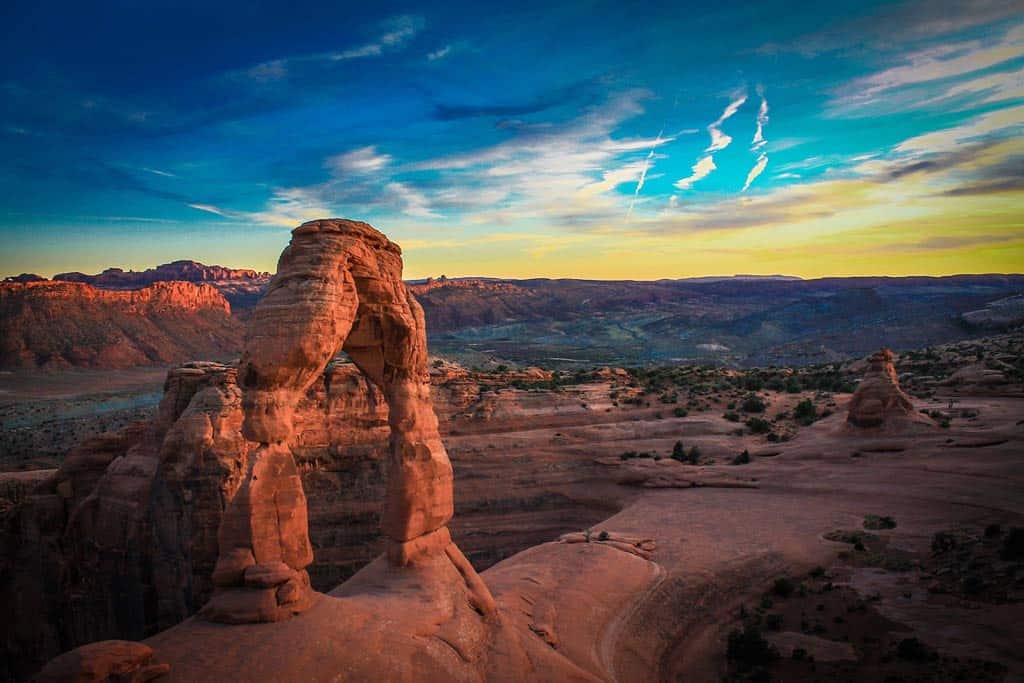
The Best Route Through the Utah National Parks
Although you can begin and end this Utah National Parks road trip on either end of our suggested itinerary, we recommend that you begin in Zion National Park and end at either Canyonlands National Park or Arches National Park, both located just outside of Moab.
To reach Zion National Park you can begin at either Las Vegas with all its crazy things to do, or Salt Lake City.
The best place to begin this epic Utah road trip is by starting in Las Vegas. This will give you the shortest distance to reach Zion National Park, at just over 2 hours of driving along Interstate 15.
Traveling from Las Vegas will also give you plenty of opportunities to take some side trips to amazing places like Lake Mead National Recreational Area, Valley of Fire State Park and the open country of Northern Arizona and Southern Utah where you could even add on a stop at the Grand Canyon National Park.
However, if you have your return trip planned out of Las Vegas, know that it will take nearly 8 hours to drive from Moab, where you’ll finish this itinerary at either Arches National Park or Canyonlands National Park, back to Las Vegas.
So if you have a roundtrip in and out of Las Vegas, you should consider adding a few extra days to this Utah road trip itinerary and consider stops at Monument Valley in Southern Utah and Grand Canyon National Park, Horseshoe Bend and Antelope Canyon in Northern Arizona as you loop back toward Las Vegas.
Of course, if you are on a long road trip that extends beyond these few days in Utah’s national parks, then you can continue on from Moab into Colorado or carry on further north to explore the more remote and less-visited beauty of Northern Utah, such as Goblin Valley State Park and Dinosaur National Monument.
Have extra time in Las Vegas? Check out our top day trips from the city!
If you want to make a roundtrip road trip through Utah, consider beginning and ending your adventure in Salt Lake City.
Although you’ll have to backtrack south along Interstate 15 for around 4 hours, beginning in Salt Lake City will give you the chance to take your time visiting all the national parks while working your way back toward Salt Lake City.
Salt Lake City has a lot of great things to do in itself. So you could add a few days to this Utah road trip itinerary to spend in Salt Lake City itself.
But if you plan to make the most of this 10-day Utah national parks road trip then you’ll want to hit the road immediately upon arriving in Salt Lake City and head south to begin in Zion National Park.
Of course, you can also follow this road trip itinerary in reverse from Salt Lake City as it is approximately the same driving time from Salt Lake City to Moab, where you can begin your adventure at either Arches National Park or Canyonlands National Park.
Related: Consider heading north into Wyoming to spend time exploring Jackson Hole .
To truly immerse yourself in the grandeur of Utah’s five National Parks, it’s recommended to set aside at least 10-14 days for your road trip.
This timeframe gives you about two to three days in each park, allowing you to savor the park’s iconic spots and venture a bit off the beaten path.
Don’t forget to factor in drive time between parks, ranging from 1.5 to 3 hours, and occasional rest days. This leisurely pace gives you plenty of opportunities to not only appreciate the majestic scenery and diverse ecosystems, but also to try out various activities such as hiking, biking, or stargazing.
However, if you’re pressed for time and simply want to soak in the iconic sights, a minimum of 7-10 days can provide a taste of each park’s unique beauty. Allocate a day or two for each park, with a focus on hitting the main highlights.
While this doesn’t allow as much time for long hikes or exploring the more remote corners, you’ll still witness some of the most breathtaking landscapes the American Southwest has to offer.
We have built this road trip itinerary to span 10 days and consider this the barebones minimum to truly enjoy every scenic drive and all of the great hiking trails you will find along the way.
Ultimately, the best itinerary is the one that aligns with your interests, travel style, and the time you have available. Regardless of how much time you spend, a road trip through Utah’s National Parks is an unforgettable journey of discovery and awe.
It is no longer a secret that Utah houses extraordinary scenery all throughout it. As such, trying to time your road trip around the crowds will be a challenge even if you’re not interested in visiting national parks for more than a day or two.
The best time to visit Utah’s National Parks largely depends on what you’re looking for in your journey. If mild weather, fewer crowds, and a vibrant explosion of colors sound appealing, then spring (April to June) and fall (September to October) are your best bet.
In spring, the parks are painted with wildflowers, and the weather is usually comfortable for exploring. Similarly, in the fall, the parks showcase a dramatic play of autumn hues, and the daytime temperatures are perfect for hiking.
Summer (July to August) in Utah can be intensely hot, with temperatures often reaching over 100°F (38°C) in the daytime. Despite the heat, this is the busiest time at the parks due to the school holidays.
If you plan a summer visit, aim for early morning and late afternoon activities when temperatures are cooler, and be sure to stay hydrated. Summer also brings the advantage of longer daylight hours, giving you more time to explore.
Winter (November to March) presents a different kind of beauty in Utah’s National Parks. While some areas may be closed due to snow, the ones that remain open are truly enchanting, with dustings of snow adding a magical touch to the red rock landscapes. The parks are quiet and peaceful, and lodging can be much cheaper.
If you don’t mind the cold and are adequately prepared, winter can be a unique and serene time to experience Utah’s natural wonders. Whether you’re seeking the vibrant colors of spring, the quiet serenity of winter, or anything in between, Utah’s National Parks are a spectacular destination year-round.
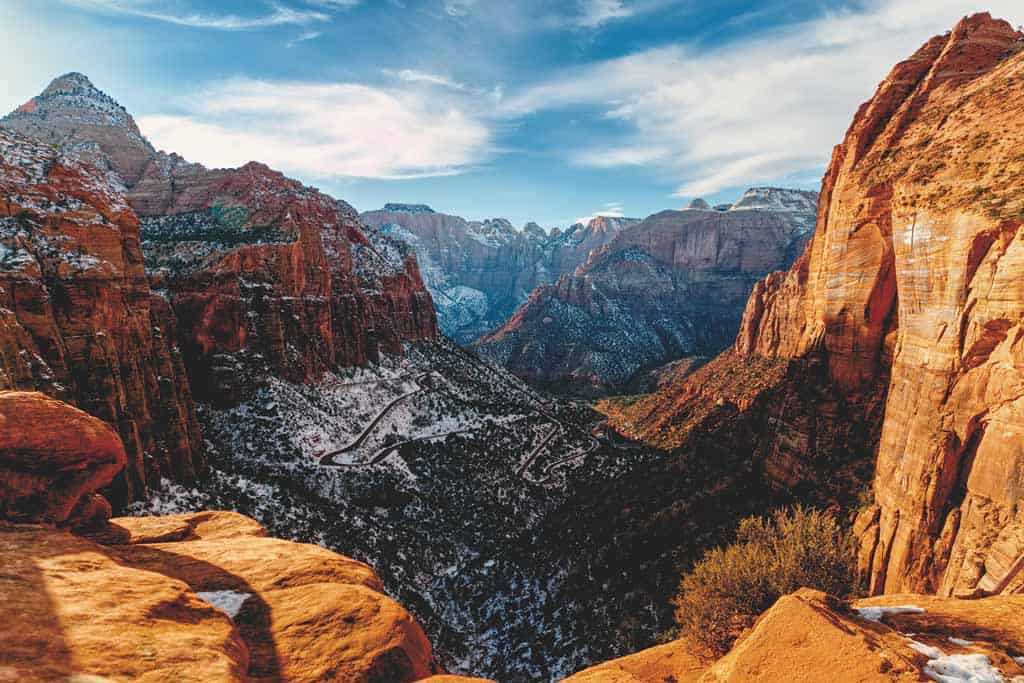
Embarking on an RV journey through Utah’s five magnificent National Parks – Zion, Bryce Canyon, Capitol Reef, Arches, and Canyonlands – is an experience like no other. It allows you to carry the comforts of home while you traverse through mesmerizing landscapes filled with soaring cliffs, fascinating rock formations, sweeping vistas, and brilliant night skies.
The versatility of RV travel offers an all-in-one transportation, dining, and accommodation solution, freeing you from the constraints of hotel check-in times, restaurant reservations, and packing or unpacking at each location.
But do remember that you will still need to book your campground reservations far in advance as this Utah national parks road trip is just as popular with RVers.
But there’s a unique freedom and flexibility that comes with RVing. Instead of rushing to make it to a hotel before nightfall, you can stay out late for stargazing, knowing your comfortable bed is just a few steps away. Early morning hikes become much more accessible when your starting point is in or near the park.
Moreover, an RV’s kitchen facilities mean you have the option to cook your meals, catering to dietary preferences or restrictions and saving you money on dining out.
If you don’t own an RV, fear not, there are numerous rental options available that cater to different needs and budgets. You can conveniently pick up an RV in major cities like Las Vegas or Salt Lake City, both excellent starting points for your Utah National Parks road trip.
Our favorite RV rental company, RVShare , offers a variety of RVs, from compact camper vans perfect for couples to larger motorhomes suitable for families or groups.
Opting for an RV, whether owned or rented, provides an immersive way to experience the captivating beauty of Utah’s National Parks while enjoying the convenience and comfort of having your accommodations on wheels.
Related: Don’t forget to spend some extra time in the adventurous town of Moab !
Tips For Planning A Utah Road Trip
You won’t be the only one planning your epic Utah national parks road trip. But if you plan it right, you can make the most of your time there. These are our best tips for helping you to enjoy your road trip.
Planning a road trip through Utah’s five National Parks is an exciting endeavor, but it’s crucial to book your travel arrangements well in advance. These parks are immensely popular and accommodations, whether you’re opting for campgrounds, RV parks, or nearby hotels, tend to fill up quickly, especially during peak seasons.
The same applies to guided tours , which can offer invaluable insights into the parks’ geology, history, and ecosystems. By booking ahead, you not only secure a place to rest after a day of exploration, but you also avoid the stress of last-minute planning.
Additionally, some parks require advanced permits for specific hikes or activities, so early planning ensures you won’t miss out on these unique experiences. Remember, a well-planned journey paves the way for a relaxed and fulfilling adventure amidst Utah’s stunning landscapes.
If your travel itinerary includes the spectacular quintet of Utah’s National Parks, purchasing the America the Beautiful National Park Pass is not only cost-effective but also convenient. Each individual park has an entrance fee, ranging from $20 to $35.
The American the Beautiful Pass, priced at $80, covers entrance fees at national parks and national wildlife refuges, as well as day-use fees at national forests and grasslands. This means that if you’re visiting three or more parks, the pass quickly pays for itself.
Plus, it eliminates the need to deal with payment at each park entrance, allowing for smoother transitions between your destinations. Keep in mind, the pass is valid for a full year, so any other national parks you decide to visit within that time are essentially free entries.
The America The Beautiful national park pass is an excellent investment for explorers setting their sights on America’s wealth of natural beauty.
Read More: Check out our list of the best day trips from Salt Lake City !
One of the key aspects of a successful trip to Utah’s National Parks is packing and dressing in layers. The state’s desert climate means there can be significant temperature fluctuations between day and night, sometimes exceeding 40 degrees Fahrenheit.
In the peak of summer, days can be scorching hot, while evenings bring a refreshing coolness. On the other hand, winter can see sunny, mild afternoons followed by crisp, chilly nights.
Layering your clothing allows you to easily adjust to these changes and maintain comfort throughout the day. Start with a moisture-wicking base layer to keep you dry, add an insulating middle layer for warmth, and top with water and a wind-resistant outer layer.
Remember, a comfortable explorer is a happy explorer, and the right clothing is essential in making the most out of your Utah National Parks adventure.
Check out our list of hiking tips for more ideas about what to pack and how to plan your adventures!
Starting your activities early when visiting Utah’s National Parks offers several advantages, and it’s a strategy veteran park visitors swear by.
First, you’ll avoid the peak daytime temperatures that can make strenuous activities like hiking not only challenging but potentially dangerous, especially in the summer months.
Second, many popular spots in the parks can get crowded as the day progresses. An early start allows you to beat the crowds, secure parking spaces, and enjoy the tranquil beauty of these natural landscapes at a leisurely pace.
Additionally, the soft morning light provides exceptional opportunities for photography. Lastly, many of Utah’s wildlife are most active during the cooler morning hours, offering a chance to spot and appreciate these creatures in their natural habitat.
So rise before the sun, soak up the serene morning vibes, and get a head start on your day of adventure in Utah’s stunning National Parks.
Utah National Parks Itinerary – Visiting The “Mighty 5”
Utah is hyperscenic. And following our itinerary below will give you the best chance to see and experience a taste of Utah’s national parks that will leave you ready to return to explore more of your favorite places.
We’re beginning this Utah national parks road trip in Las Vegas. But remember, you can swap out Day 1 with a start from Salt Lake City if you find that is better for your overall plans.
Day 1: Las Vegas to Zion National Park
As you leave the neon glow of Las Vegas behind and hit the road toward Zion National Park, prepare for a journey that’s as much about the drive as it is about the destination.
The roughly three-hour drive will take you through an array of landscapes, from the stark beauty of the Mojave Desert to the pastel-colored cliffs of Virgin River Gorge in Arizona.
If you have the time, make sure to stop at the Valley of Fire State Park, an hour’s drive from Las Vegas, which gets its name from the red sandstone formations that look as if they’re on fire when reflecting the sun’s rays.
Here, you can hike, explore ancient petroglyphs, and take stunning photographs of the landscape.
Upon reaching Zion National Park, you’ll find an array of activities to keep you entertained.
You can start with the Scenic Drive, which provides an excellent overview of the park’s main attractions, and the park shuttle makes it easy to hop on and off at different points.
We don’t recommend that you do too much on this first day as you will have plenty of time to explore Zion National Park the following day.
But simply driving through Zion National Park will give you an overview of the splendor and beauty of the area and set you up for what to expect from the other Utah national parks.
If you’re staying in the park, be sure to arrive at your accommodations early on this first night. This will give you time to set up and enjoy an incredible star-filled night .
But perhaps even more importantly, it will allow you to get a good night’s sleep so that you can plan for a very early start the next day.
Remember, although this is the first national park on your national parks road trip, you are not the only one with the idea to visit Utah national parks.
Get your sleep and be ready for an action-filled day as you explore Zion National Park from one end to the other!
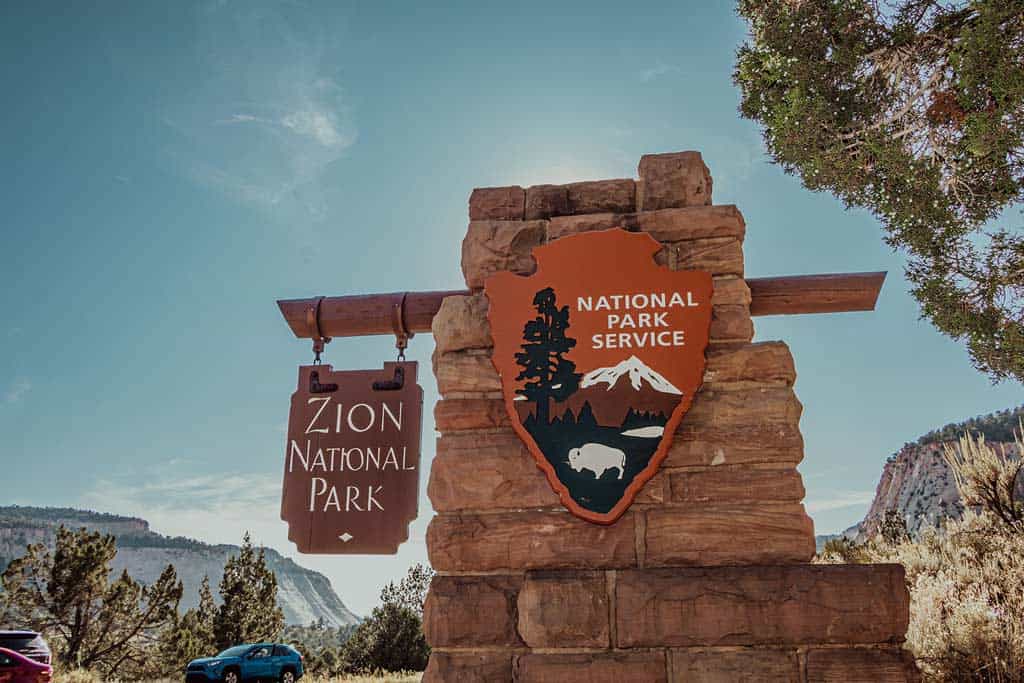
Where to Stay Near Zion National Park
Unless you’ve made arrangements to stay in Zion National Park, the town of Springdale is about as close as you can get to the park. Here are a few great options:
- Pioneer Lodge – This rustic-style lodge offers a range of amenities including a restaurant, an outdoor pool, and easy access to the park, making it a convenient base for visitors eager to explore the stunning landscapes of Zion.
- Holiday Inn Express – Nestled in the majestic red rock cliffs of Zion Canyon, the Holiday Inn Express in Springdale, Utah offers modern amenities and comfortable accommodations. With its outdoor pool, fitness center, complimentary breakfast, and breathtaking views, it serves as a comfortable and convenient hub for travelers exploring the marvels of Zion National Park.
There are a few RV campgrounds in Zion National Park. But these will fill up quickly. So be sure to book as far in advance as possible to ensure that you have a campsite:
- Watchman Campground
- South Campground
Check out this National Park site for information on booking your campsite.
Day 2: Zion National Park
Welcome to Zion National Park, a nature lover’s paradise nestled in the southwestern corner of Utah.
Revered for its impressive sandstone cliffs radiating hues of cream, pink, and red, Zion is a place where landscape meets the sky creating an awe-inspiring backdrop like no other.
The Virgin River, the architect of the park, has carved its way through the rock, sculpting the canyon over millions of years, and creating an oasis of sorts in the desert where diverse plant and animal life thrive.
Zion National Park isn’t just about breathtaking vistas; it’s an invitation for adventures.
With over 200 square miles of exploration, the park offers rugged hiking trails, such as the iconic Angel’s Landing and the narrows of the Virgin River.
It’s a land of discovery, where every corner turned unfolds a scene of stark beauty, a land where one can truly grasp the magnificence of the natural world.
Whether you’re an avid hiker, a wildlife enthusiast, or a casual traveler seeking the serenity that comes with immense natural beauty, Zion is a world-class destination that promises to captivate your spirit.
As a brief overview, here are the top things to see and do in Zion National Park. We’re not telling you where to begin or end.
And some activities may not be suitable for everyone. And you really can’t truly see the park without including at least one Zion National Park Hike.
However, when deciding what to do in Zion National Park, this is our list of the absolute best things to do!
- Angels Landing Hike : This famous hike is not for the faint of heart due to its steep and narrow path, but it provides some of the most breathtaking panoramic views of Zion National Park.
- The Narrows : This unique hike takes you through the narrowest section of Zion Canyon in the Virgin River itself, so be prepared to get a little wet!
- Emerald Pools : This trail leads to a series of picturesque pools and waterfalls. There are both lower and upper trails depending on your preference for difficulty and distance.
- Zion Canyon Scenic Drive : This drive provides stunning views of the park. You can access the park’s shuttle system which stops at multiple points along the route for easy exploration.
- Canyoneering : Zion is known for its excellent canyoneering routes. This adventure sport combines route finding, rappelling, problem-solving, swimming, and hiking.
- Watchman Trail : A relatively easy trail offering impressive views of Zion Canyon, Springdale, and the Watchman Spire.
- Weeping Rock : A short hike that leads you to a rock alcove where water seeps out of the rock, providing a cool respite during hotter months.
- Kolob Canyons : Located in the northwestern section of the park, this area provides a quieter experience with equally stunning canyon views. Don’t miss the Taylor Creek trail.
- Wildlife Watching : Keep an eye out for the park’s abundant wildlife, including mule deer, wild turkeys, and the rare sighting of a bighorn sheep.
- Stargazing : With limited light pollution, the park offers fantastic opportunities for stargazing . Zion regularly offers ranger-led stargazing programs as well.
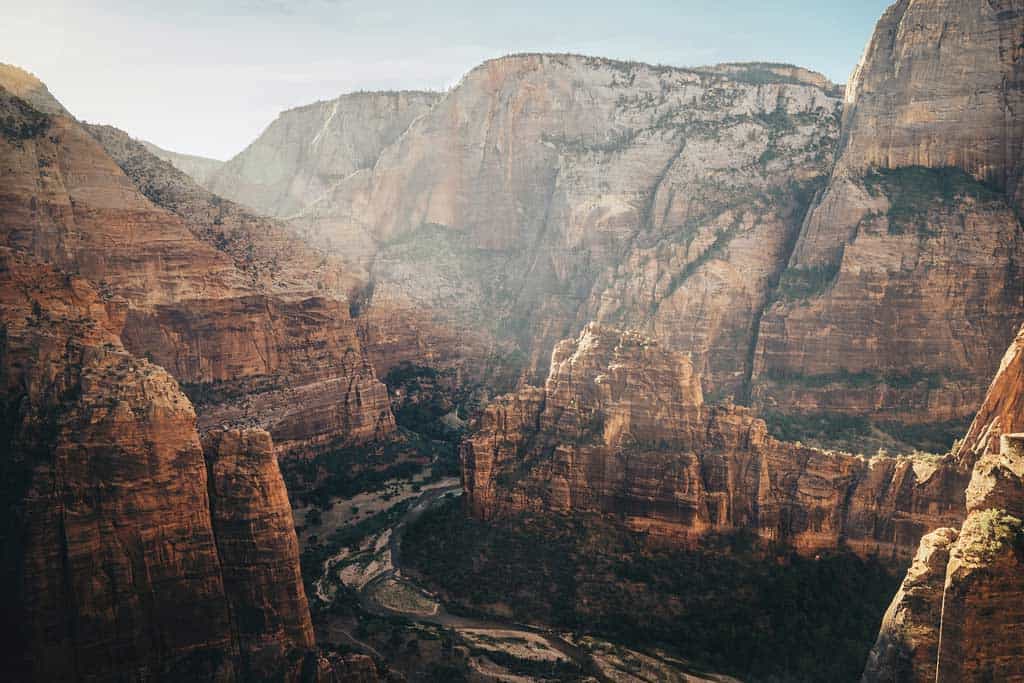
While most of the activities in Zion National Park involve getting out on the hiking trails, there are also some great viewpoints of the national park and a great visitor center where you could spend hours learning about the rock formations that gave rise to such a spectacular place.
Although visitor centers are typically great places to start, unless you stopped by on your first day traveling to Zion National Park, you won’t want to spend too much of your time there as this will eat into your less-busy time exploring the park itself.
If you have additional time in Zion National Park, consider exploring some of the less-trafficked areas of the park.
The Kolob Canyons, a lesser-visited section of the park, provides quieter trails and equally magnificent scenery.
Here, the Taylor Creek Trail is a delightful hike leading to the Double Arch Alcove.
If you’re up for a challenge, try the trail to The Subway, a unique tunnel-shaped canyon and geological marvel, though do note that this requires a permit. Also consider a horseback riding tour of White Mountain for a unique experience!
Alternatively, explore the Zion Human History Museum to learn more about the park’s cultural history or simply find a peaceful spot by the Virgin River and enjoy the serene beauty around you.
If you’re there in the right season, you might even partake in a peaceful bird-watching session, as Zion is home to over 290 species of birds.
Day 3: Zion to Bryce Canyon National Park
Don’t rush away from Zion National Park! Take your time and get one last hike or scenic drive in before heading north toward Bryce Canyon National Park.
The drive to Bryce Canyon National Park from Zion National Park will take a little less than 2 hours… unless you find yourself stopping to take in some of the incredible views along the way.
Taking Highway 9 out of Zion National Park, you’ll travel a few miles east before turning north onto Highway 89, arguably one of the most beautiful stretches of highway in America.
These 43 miles will lead you between the mountains that separate Zion National Park from Bryce Canyon National Park and there are places you may want to pull over to take in views of both.
Depending on how early you arrive in the area, you may want to check into your accommodations and grab a hearty meal to prepare you for a full day of exploring Bryce Canyon National Park.
To reach the park itself, you will turn off Highway 89 and go through a small stretch of hotels , restaurants and tourist shops and attractions in the small towns of Bryce and Bryce Canyon.
If you have time, you can park and take a shuttle through the national park or give yourself a quick self-guided driving tour . Be on the lookout for wildlife in the evening hours.
Remember, while Bryce Canyon National Park is not as popular as Zion National Park or Arches National Park, it is sure to be crowded the next day.
So head to bed early and get your rest so you can wake up early ready to spend a full day exploring the best that the national park has to offer!
Where To Stay Near Bryce Canyon National Park
Most of the accommodations near Bryce Canyon National Park are located in either Bryce, Bryce Canyon City or the town of Tropic.
While Tropic has more hotel offerings, it will require you to backtrack a little to return to the national park the following day.
ere are a few great options for where to stay near Bryce Canyon National Park:
- Best Western PLUS Ruby’s Inn (Bryce Canyon City) – Best Western PLUS Ruby’s Inn, situated just a mile from the entrance of Bryce Canyon National Park, offers cozy accommodations complemented by rustic decor reminiscent of the region’s pioneer heritage. It features a range of amenities including an indoor pool, on-site dining, a general store, and even horse riding activities.
- Bryce Pioneer Village (Tropic, Utah) – Bryce Pioneer Village, located in Tropic, Utah, offers a charming and rustic lodging experience just a short drive from the park. With options for motel rooms or individual cabins set in beautiful gardens, along with amenities like an outdoor pool and an on-site restaurant, it provides a comfortable base for visitors to unwind after a day of exploration.
There are a few RV campgrounds in Bryce Canyon National Park. But these will fill up quickly. So be sure to book as far in advance as possible to ensure that you have a campsite:
- North Campground
- Sunset Campground
Read next: The Ultimate 3 Days In Las Vegas Itinerary
Day 4: Bryce Canyon National Park
Bryce Canyon National Park is a geological wonderland located in southwestern Utah. Not quite a canyon in the traditional sense, Bryce is rather a spectacular series of natural amphitheaters filled with a maze of spire-shaped rock formations called hoodoos.
These towering limestone sculptures, painted in shades of pink, orange, and white, stand tall against a crisp blue sky, creating a whimsical landscape that appears to be more fantasy than reality.
The magic of Bryce Canyon extends beyond its otherworldly daytime views. Designated as a Dark Sky Park, Bryce offers one of the best celestial displays in the country once the sun sets.
Trails for every level, from the relatively easy Navajo Loop to the more strenuous Peekaboo Loop, lead visitors into the heart of the hoodoos, promising an intimate encounter with the park’s unique geology.
Whether you’re there to watch the sun cast its first light on the hoodoos or to gaze upon the star-studded sky, Bryce Canyon National Park is a place that both humbles and inspires with its majestic natural beauty.
As a brief overview, here are the top things to see and do in Bryce Canyon National Park. As with other Utah national parks, we’re not telling you where to begin or end.
And some activities may not be suitable for everyone. However, when deciding what to do in Bryce Canyon National Park, this is our list of the absolute best things to do!
- Sunrise/Sunset Point : Witness the breathtaking sight of the hoodoos glowing in the soft light of sunrise or sunset at this viewpoint.
- Hiking the Navajo Loop Trail : This popular trail descends from Sunset Point through the slot canyon of Wall Street and the Silent City formations.
- Bryce Point : Famous for its extraordinary sunrises, panoramic views of the Bryce Amphitheater can be seen from this point.
- Ride the Scenic Drive : A 38-mile round trip drive with over a dozen viewpoints to pull over and admire the park’s stunning landscapes. Or explore by ATV for an adventurous twist!
- Hike the Rim Trail : This relatively easy trail offers some of the best views of the park and can be hiked in sections.
- Peek-A-Boo Loop : A longer and more strenuous hike that offers stunning views of the park’s iconic hoodoos.
- Visit Mossy Cave : A less-visited part of the park where you can see a waterfall, a mossy overhang that’s cool even in summer, and hoodoos up close.
- Stargazing : Bryce Canyon has some of the darkest night skies in North America, making it an excellent place for stargazing.
- Horseback Riding : Experience the park’s trails from a new perspective with a guided horseback riding tour .
- Winter Sports : In the winter, the park offers cross-country skiing and snowshoeing for a different view of Bryce’s spectacular hoodoos.
If you find yourself with some extra time in Bryce Canyon National Park, consider venturing into the lesser-visited areas of the park. The Fairyland Loop Trail is a longer and less crowded trail that offers fantastic views of the hoodoos, towers, and walls for which Bryce Canyon is famous.
You could also explore the Bristlecone Loop that takes you to Yovimpa Point and Rainbow Point, the highest points in the park, with views extending over 100 miles on clear days.
Another option is to spend a leisurely afternoon horseback riding through the park’s canyon trails, soaking up the unique geological wonders around you.
And, if your visit falls during a new moon, don’t miss one of the ranger-led Full Moon Hikes or a guided astronomy program, as Bryce Canyon is renowned for its clear, dark skies, perfect for stargazing.
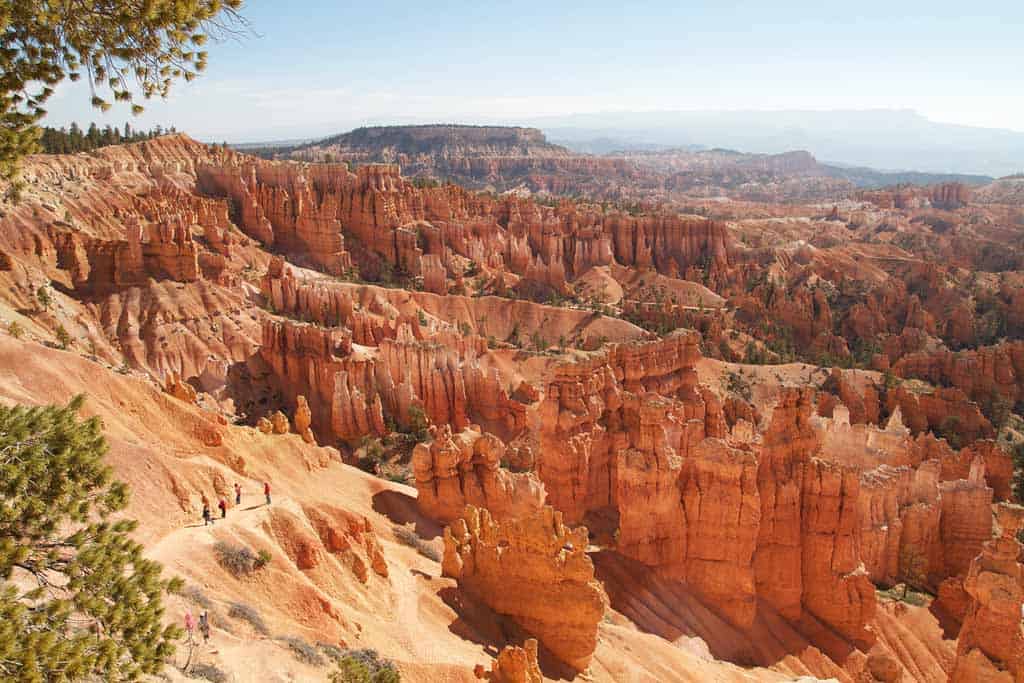
Day 5: Bryce Canyon to Capitol Reef National Park
Don’t rush away from Bryce Canyon National Park! Take your time and get one last hike or scenic drive in before heading north toward Capitol Reef National Park.
The scenic drive to Capitol Reef National Park will take approximately 3 hours. But with the cute little town of Escalante positioned right in the middle of the road trip, plus all of the beauty around, you may want to give it more time.
There are some great slot canyons to hike just north of Escalante if you enjoy finding yourself wedged between sandstone layers of rock that stretch upwards toward the sky.
Take a side trip down the dirt road (sometimes graded) on Hole In The Rock Road to visit Zebra Slot Canyon and Peekaboo Slot Canyon.
Both offer the opportunity to enjoy some open-country hiking that leads into the narrow slot canyons.
Depending on the time of day and season, you may find yourself slogging through water in either canyon and the opportunity always exists to do a little amateur rock climbing as you work your way further back into each canyon.
Zebra Slot Canyon doesn’t require any technical climbing skills. But to see the famed “zebra stripes” in the canyon you’ll want to do some scuttling up and through some very narrow slots.
Be sure to arrive at your accommodations with plenty of time to enjoy the evening. Pick up food in Escalante, or give yourself enough time to cook a meal in your RV if you’re traveling in one.
Then catch some great shut-eye before heading out into Capitol Reef National Park for a full day of adventure the next morning.
If you’re a night owl, you may consider stepping outside after sunset to take in the many stars that blanket the sky.
It’s likely that you’ll be able to very clearly see the Milky Way Galaxy with your bare eyes, depending on the season and timing.
Where To Stay Near Capitol Reef National Park
Your options for staying near Capitol Reef National Park are limited with most of the accommodation options being in the small town of Torrey, Utah, just a 15-minute drive to the national park entrance.
There are other options that lie further west away from the park. So we’d recommend considering the following options when it comes to where to stay near Capitol Reef National Park.
Both are highly rated and we think you’ll appreciate all they have to offer in addition to their proximity to the national park.
- Broken Spur Inn and Steakhouse – Located in the heart of Torrey, Utah, the Broken Spur Inn and Steakhouse offers comfortable lodging and an on-site steakhouse, ensuring guests enjoy not only scenic views of Capitol Reef National Park but also satisfying meals before or after a day of exploration.
- Skyview Hotel – Skyview Hotel in Torrey, Utah, pairs modern comforts with breathtaking views of the red cliffs and canyons of Capitol Reef National Park. Enjoy the pleasant charm and nice amenities such as a heated outdoor pool and a spacious picnic area.
In Capitol Reef National Park there is only one campground and it is likely to fill up quickly due to the remote nature of the campsite. Be sure to book far in advance to ensure that you have a campsite:
- Fruita Campground
Day 6: Capitol Reef National Park
Welcome to Capitol Reef National Park, an enchanting realm nestled in the heart of Utah’s red rock country.
Named for its white domes of Navajo Sandstone that resemble the U.S. Capitol building, and the water pocket fold, a ‘reef’-like geologic wrinkle extending nearly 100 miles, Capitol Reef is a dazzling display of colorful cliffs, massive domes, soaring spires, and twisting canyons.
The park’s unique geologic features tell a story of ancient environments, from lush tropical forests to arid deserts, that existed here millions of years ago.
Venturing into Capitol Reef is like stepping back in time. The park is home to the historic Fruita Rural Historic District, where lush orchards and rustic buildings offer a glimpse of the area’s pioneer heritage.
The rich human history, dating back to the ancient Fremont people, is inscribed on the sandstone cliffs in the form of petroglyphs, a silent testament to the park’s past inhabitants.
Whether you’re exploring its scenic byways, hiking through its dramatic landscapes, or picking fresh fruit in one of the maintained orchards, Capitol Reef National Park offers an unforgettable journey into a lesser-known, but equally captivating, corner of Utah’s impressive national park system.
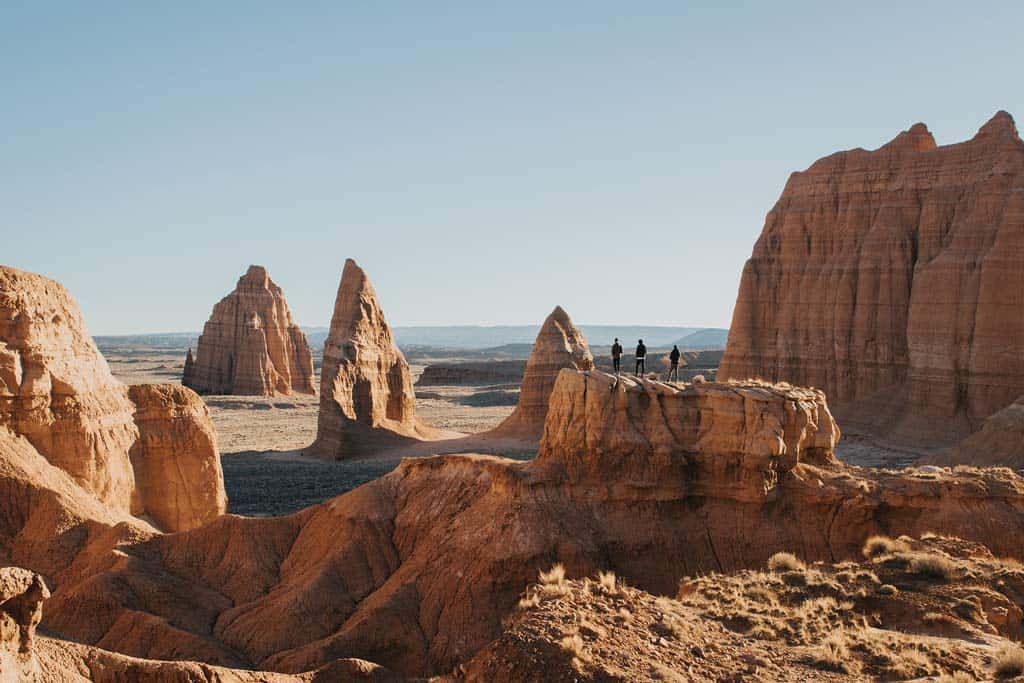
As a brief overview, here are the top things to see and do in Capitol Reef National Park. As with other Utah national parks, we’re not telling you where to begin or end.
And some activities may not be suitable for everyone. However, when deciding what to do in Capitol Reef National Park, this is our list of the absolute best things to do!
- Scenic Drive : A 25-mile round trip that takes you through the heart of the park’s Waterpocket Fold, offering magnificent views of cliffs, canyons, domes, and bridges.
- Hickman Bridge Trail : This moderate trail leads to the impressive Hickman Natural Bridge, one of the largest in the park.
- Fruita Historic District : Explore this old Mormon settlement with its charming orchards where you can pick fruit in season, a historic schoolhouse, and the Gifford Homestead which sells locally made pies and breads.
- Cassidy Arch : A strenuous hike leading to a large, spectacular natural arch named after the famous outlaw Butch Cassidy.
- Petroglyphs : Just east of the Fruita oasis, view petroglyphs inscribed in sandstone by Native Americans of the Fremont Culture.
- Cathedral Valley : A remote, less visited area of the park, featuring stunning monolithic sandstone formations.
- Sulphur Creek Route : A water hike through a narrow canyon, featuring three waterfalls to bypass. Best done in warmer weather.
- Chimney Rock Loop : A moderately difficult trail offering panoramic views of the Waterpocket Fold and the surrounding area.
- Goosenecks Overlook : A short walk to a viewpoint where you can see the deep, dramatic meanders of Sulphur Creek.
- Stargazing : Like many of Utah’s national parks, Capitol Reef offers incredible stargazing due to its status as an International Dark Sky Park.
With some extra time at Capitol Reef National Park, diving deeper into its hidden treasures can make your visit even more unforgettable. A great way to start is by exploring the Cathedral Valley, a less frequented but equally breathtaking region of the park, known for its monolithic formations.
If you’re an avid hiker, consider the strenuous but rewarding Upper Muley Twist Canyon trail, which offers some of the most spectacular panoramic views in the park.
Take a step back in time by visiting the old Fruita Schoolhouse, a one-room building that served the small community from the 1890s to the 1940s.
If you’re visiting during the right season, don’t miss the chance to pick some fruit in the historic Fruita orchards, a unique experience that harks back to the area’s pioneer past.
Looking for more epic road trips? Check out our guide to driving from Las Vegas to Los Angeles !
Day 7: Drive to Moab for Arches National Park and Canyonlands National Park
Next you’ll be heading north toward Moab, where you’ll encounter the spectacular Arches National Park and Canyonlands National Park.
Moab itself merits a little extra time if you have it. From a quaint downtown area that offers all sorts of places to eat and shop to some side trips to places like Corona Arch just outside of town, the area around Moab is worth the time if you have it.
From Capitol Reef National Park, you’ll drive just under 3 hours to reach Moab. Unfortunately, the backroads of this epic Utah national parks road trip ends for a brief stint on Interstate 70 straddling Green River, Utah before ducking back down on Highway 191.
Arches National Park is just as popular, if not more, than Zion National Park so it’s unlikely that you can enjoy too much with the late afternoon arrival into the area. Instead, use this time to head out toward Corona Arch and enjoy that afternoon or early evening hike instead.
Be sure to check in with your accommodations as soon as you can and get settled in for a quiet night. You’ll want to be ready to wake up early to hit Arches National Park before droves of other people do.
But if you are truly committed, consider waking up well before sunrise to head into the park and hike out to Delicate Arch for sunrise, arguably the most iconic arch in the entire national park.
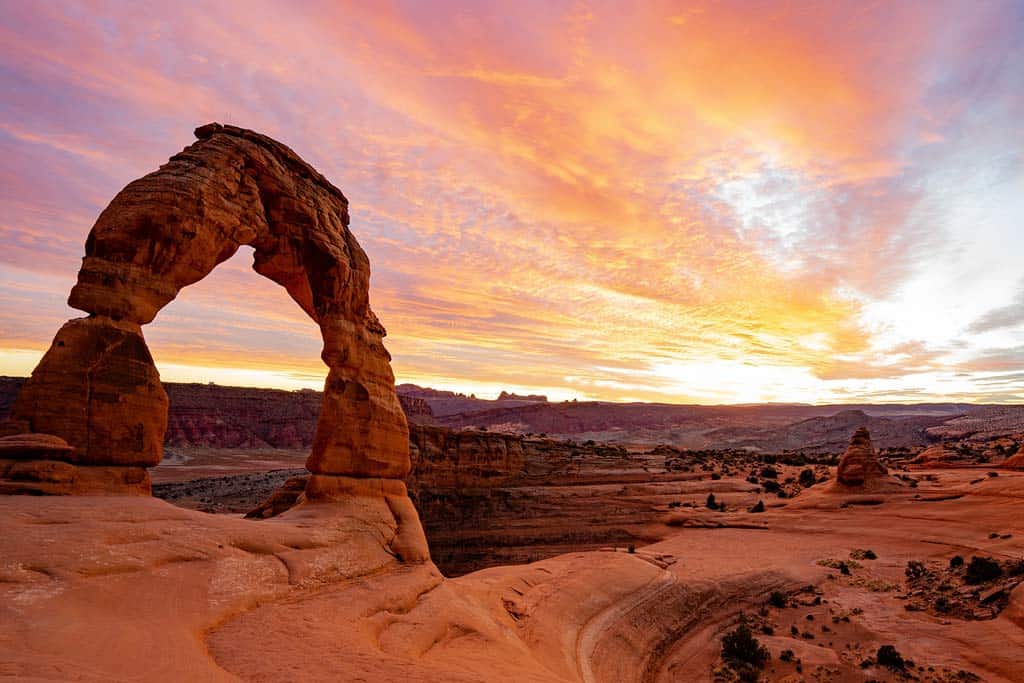
Where to Stay Near Arches National Park
Almost all accommodations for visiting both Arches National Park and Canyonlands National Park will be in and around the small town of Moab. Because Arches National Park is arguably just as busy, if not busier than Zion National Park, the town of Moab has grown up to support a massive influx of visitors and there are ample options for accommodations in the area.
Here are a few of the best options:
- Archway Inn – Complete with an outdoor pool, hot tub, spacious rooms, and a fitness center, this lovely hotel furnished with classy sandstone architecture is a top-rated place to stay near the park.
- Hotel Moab Downtown – Located in the heart of Moab with incredible mountain scenery, this full-service hotel is surrounded by the best restaurants and shops in town. The gorgeous hotel interior doesn’t hurt either!
In Arches National Park there is only one campground and it is likely to fill up quickly due to the popularity of the national park. Be sure to book far in advance to ensure that you have a campsite:
- Devil’s Garden Campground
Day 8: Arches National Park
Arches National Park is a captivating world of stone located in eastern Utah. As the name implies, Arches is a testament to nature’s power and creativity, hosting over 2,000 natural stone arches, the greatest concentration in the world.
These striking formations, along with an array of colossal pinnacles, balanced rocks, and expansive fins, are artfully carved from a vibrant red sandstone landscape, creating a visually stunning panorama that ignites the imagination.
Arches National Park invites visitors to delve into a world where the surreal becomes tangible.
Trails of varying lengths lead you up close to the park’s star attractions, like the Delicate Arch, one of Utah’s most famous icons, or the Landscape Arch, one of the world’s longest.
Whether bathed in the fiery glow of sunrise or sunset, shimmering under the midday sun, or glowing in the soft light of the moon, the arches offer an ever-changing, always mesmerizing spectacle.
Arches National Park is not just a place to see, but a place to savor and experience through adventures like mountain biking , backpacking, ATV driving, and more.
As a brief overview, here are the top things to see and do in Arches National Park. As with other Utah national parks, we’re not telling you where to begin or end.
And this park is PACKED year round, so you may not be able to fully enjoy every experience we have listed.
However, when deciding what to do in Arches National Park, this is our list of the absolute best things to do!
- Delicate Arch Hike : A moderately difficult hike to the park’s most iconic and most photographed natural arch.
- Devils Garden : A network of trails leading to several arches including the Landscape Arch, the longest natural arch in North America.
- Fiery Furnace : A labyrinth of narrow sandstone canyons requiring a permit or a ranger-led tour to explore, to ensure minimal impact on the environment.
- Windows Section : Easy trails that lead to some of the largest arches in the park, including the North and South Window Arches and Turret Arch.
- Park Avenue Trail : This trail provides views of towering sandstone monoliths reminiscent of skyscrapers on a big city street.
- Balanced Rock : One of the park’s most popular features, a massive boulder balanced on a slender pedestal.
- Courthouse Towers : A collection of tall stone columns that showcase the park’s unique geology.
- Double Arch : Two impressive natural arches that share a common end. The trail to reach them is relatively short and easy.
- Sunset at Delicate Arch : A popular activity is to hike to Delicate Arch at sunset to witness the stunning transformation of colors on the rock formations.
- Stargazing : Arches National Park is recognized as an International Dark Sky Park, making it an excellent place for stargazing due to minimal light pollution.
If you’ve budgeted some extra time for exploring Arches National Park, consider delving deeper into its off-the-beaten-path wonders.
The Fiery Furnace, a labyrinth of narrow sandstone canyons, offers a more challenging but rewarding experience – just remember to either join a ranger-led tour or get a permit if you plan to navigate it yourself.
If you’re up for a longer hike, the seven-mile Primitive Loop at Devil’s Garden will reward you with views of some of the park’s less-visited arches.
Consider also a visit to the petroglyphs at Wolfe Ranch to appreciate the history and culture of the park’s earlier inhabitants. Or go stand-up paddleboarding or white-water rafting on the Colorado River if you’re looking for a break from land-based activities!
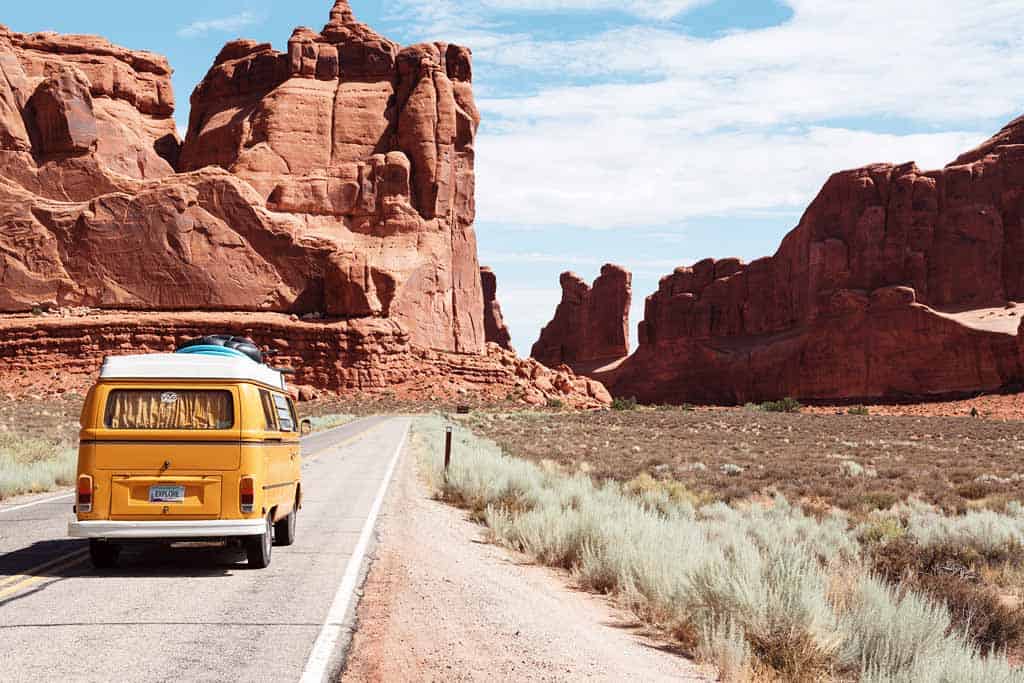
Day 9: Canyonlands National Park
Welcome to Canyonlands National Park, a captivating wonderland located in the heart of southeastern Utah.
Spanning over 337,000 acres, Canyonlands is a vast desert ecosystem sculpted by the Colorado River and its tributaries into a rugged panorama of mesas, canyons, and remarkable rock formations.
The park’s unique geology unfolds millions of years of Earth’s history, with layers of sedimentary rock that document time like pages in a book.
Yet, Canyonlands is more than just a geological showcase; it’s a place where the sheer scale of the landscape and the silence of the desert can create a profoundly stunning experience.
The park’s expanse is divided into four districts – Island in the Sky, The Needles, The Maze, and the rivers themselves – each boasting its own distinctive character and array of outdoor adventures.
Whether you’re standing on the edge of a towering mesa overlooking the winding river canyons, exploring the cryptic messages left by ancient Native American civilizations, or star-gazing in the crystal-clear night skies, Canyonlands offers an exploration into a beautifully rugged and untamed corner of the world.
Canyonlands National Park is a vast wilderness of stark yet breathtaking beauty characterized by its dramatic desert landscapes.
Featuring a diverse array of towering mesas, deep canyons, and the converging Colorado and Green Rivers, the park provides an awe-inspiring panorama that reveals millions of years of geologic history.
Here are a few of the best things to see and do in Canyonlands National Park:
- Island in the Sky : This is the easiest district of the park to access and offers breathtaking views from numerous overlooks along the paved scenic drive.
- Mesa Arch : A short hike leads to this poetically named natural arch, a popular spot for photographers, especially at sunrise.
- White Rim Road : A 100-mile dirt road loops around and below the Island in the Sky mesa, providing spectacular views for those up for a 4WD adventure.
- The Needles : This district offers extensive hiking trails through a landscape punctuated by colorful sandstone spires.
- Horseshoe Canyon : This detached unit of the park is home to the famous Great Gallery, one of the best examples of prehistoric pictographs (rock art) in America.
- Upheaval Dome : Visit this unique geologic feature and decide for yourself whether it was created by a salt dome or a meteor impact.
- Green River Overlook : A popular spot that provides panoramic views of the Green River in the Island in the Sky district.
- Rafting on the Colorado River : Experience the thrill of rafting through the park’s spectacular canyons.
- Elephant Hill Trail : This challenging 4WD trail in the Needles district leads to some of the most remote and beautiful places in the park.
- Stargazing : Canyonlands National Park has been designated a Gold-Tier International Dark Sky Park, making it an exceptional place to stargaze and contemplate the mysteries of the universe.
With additional time at Canyonlands National Park, your adventures can extend beyond the iconic Island in the Sky district.
Consider exploring the more remote Needles district, where colorful sandstone spires tower above extensive hiking trails and large, park-like clearings.
If you’re equipped with a 4WD vehicle, a journey along the White Rim Road will present stunning, up-close views of the park’s complex geology.
Another remarkable but less-visited area is the park’s Maze district, one of the most remote areas in the United States, offering solitude and a maze-like network of canyons to explore.
If you’re keen on prehistoric culture, the Horseshoe Canyon contains some of the most significant rock art in North America, including the breathtaking Great Gallery panel. Just remember, some of these activities require permits, so plan accordingly!
There are a few RV campgrounds in Canyonlands National Park. But these will fill up quickly. So be sure to book as far in advance as possible to ensure that you have a campsite:
- Islands In The Sky (Willow Flat) Campground
- The Needles Campground
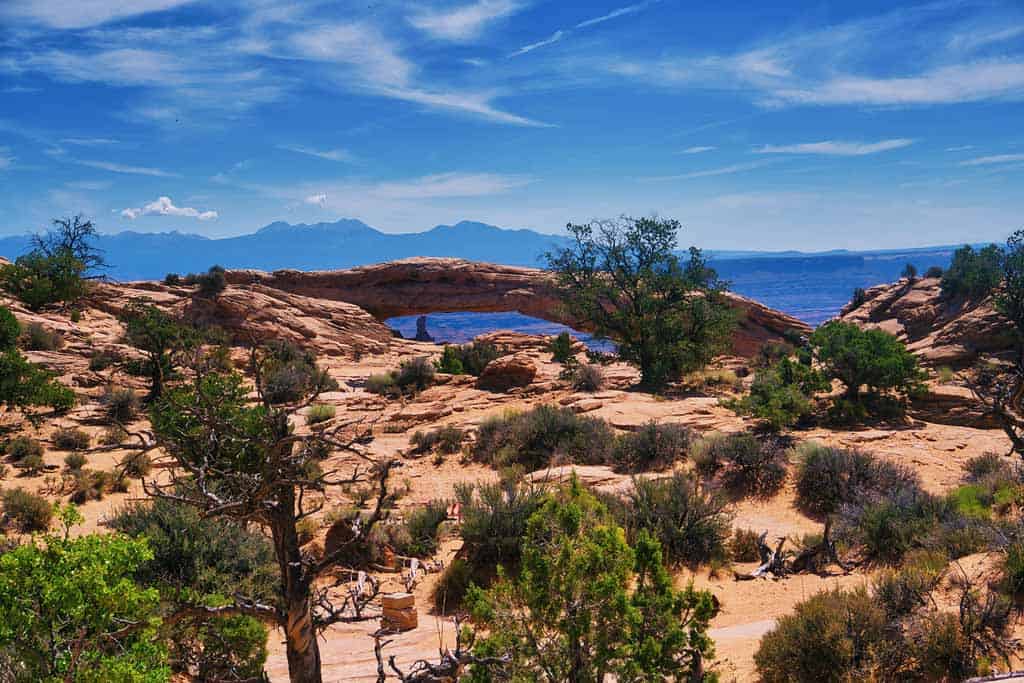
Day 10: Return trip
On the final day of your Utah road trip, you will spend a good portion of it driving back to either Las Vegas or Salt Lake City, depending on your final destination.
Both of these drives can be road trips on their own, with plenty of other stops along the way.
The drive from Moab to Salt Lake City will take approximately 4 hours. This will be mostly along backroad highways that continue to offer the kind of beauty that makes anyone want to visit utah.
Here are a few points of interest along the drive back to Salt Lake City:
- Price Canyon Recreation Area : This is a great spot to stretch your legs and take in the stunning views of the surrounding canyons and plateaus.
- Nine Mile Canyon : Known as the world’s longest art gallery, this canyon contains extensive petroglyphs and pictographs from ancient Native American cultures. It’s a slight detour off the main route, but well worth the extra time for history and archaeology enthusiasts.
- Helper, Utah : This quaint mining town has a charming Main Street with historic buildings, antique shops, and the Western Mining & Railroad Museum.
- Provo River Falls : Nestled in the Uinta National Forest, the Provo River tumbles over a series of scenic waterfalls. There are plenty of spots to picnic and trails to explore.
- Soldier Hollow : This venue was home to cross-country skiing and biathlon events during the 2002 Winter Olympics and now offers year-round outdoor activities. Take a break here to appreciate the beautiful mountain views, and if you’re passing through in winter, enjoy some snow sports.
Driving to Las Vegas from Moab will take around 7 hours and will be primarily along the interstate. You’ll spend much of the time on Interstate 70 until it meets Interstate 15.
If you head along this route and want to split the drive into two days, here are a few points of interest along the way:
- San Rafael Swell : Located near Green River, Utah, this is a large geologic feature known for its scenic sandstone formations, deep canyons, and expansive panoramas.
- Fishlake National Forest : Close to Richfield, Utah, this national forest is home to the Pando, an enormous grove of quaking aspen which is considered the heaviest known living organism.
- Cove Fort : Near Beaver, Utah, this historic site is a well-preserved pioneer-era fort. Guided tours offer insight into life in the 19th century American West.
- Cedar Breaks National Monument : Just off Interstate 15 near Cedar City, Utah, this park offers breathtaking views of a naturally formed amphitheater canyon filled with colorful hoodoos and rock formations.
- Valley of Fire State Park : Nevada’s oldest and largest state park, known for its vibrant red sandstone formations, petrified wood, and ancient petroglyphs. It’s about an hour off the route, but its otherworldly landscapes make it worth the detour.
If you want to take a more scenic route, you can head south out of Moab and follow highway 191 in Utah through Monument Valley and into northern Arizona. This will lead you to Page, Arizona where you can take a detour to visit Grand Canyon National Park, which is worth the detour in our opinion!
From Page you can also see famous landmarks and national monuments such as Horseshoe Bend and Antelope Canyon.
Carry on toward Kanab and take a little detour to hiks some great slot canyons or connect back to Zion National Park for a second visit before returning to Interstate 15 for the short drive back to Las Vegas.
Plan to explore more of Arizona? Check out our list of the best things to do in Tucscon !
If you are continuing on your road trip from Moab, you can easily cross into Colorado and enjoy all that the Centennial State has to offer.
A short 2 hour drive east along Interstate 70 will take you to Grand Junction, where you can decide which direction you want to go to enjoy the beauty of Colorado’s Rocky Mountains.
Of course, road trips in Colorado are a whole other opportunity and the state is well worth exploring over the course of several weeks.
And although not as close as Colorado, you could continue your Utah road trip north and enter remote areas of Wyoming where you’ll come across vast stretches of land that seem to stretch on forever.
This route will put you in Rock Springs, Wyoming and in a direct route toward Grand Teton National Park and the adjoining Yellowstone National Park.
Other Utah Road Trip Destinations
Visiting Utah national parks is a bucket list item of its own. However, if you feel like tacking on a few extra days (or weeks!) on your Utah road trip, then there are some other great destinations nearby that offer great alternatives to Utah’s parks.
Two regions that deserve your attention and do not require too much deviation from this core Utah national parks road trip are in southern utah and northeastern Utah.
If you aren’t in a rush and/or are making your way back to Las Vegas along the scenic Southern Utah route, consider spending a few extra days taking in all of the beauty of this region. Here are a few top places to stop along the way:
- Monument Valley Navajo Tribal Park : This iconic landscape, featuring stunning red sandstone buttes, is located within the Navajo Nation on the border of Utah and Arizona.
- Antelope Canyon : Near Page, Arizona, this mesmerizing slot canyon is renowned for its swirling sandstone walls and ethereal light beams.
- Lake Powell : A reservoir on the Colorado River, straddling the border between Utah and Arizona, this is a prime spot for boating, fishing, and exploring numerous sandstone canyons.
- Glen Canyon National Recreation Area : Encompassing over 1.25 million acres from Arizona to southern Utah, this area offers opportunities for water-based and backcountry activities.
- Coral Pink Sand Dunes State Park : Located in Utah, this park features a stunning expanse of reddish-pink sand dunes that you can explore on foot or with off-road vehicles.
- Horseshoe Bend : Just outside Page, Arizona, this iconic bend in the Colorado River is famous for its dramatic views from the cliff edge.
- Grand Canyon National Park – North Rim : While most visitors head to the South Rim, the North Rim offers a quieter and equally stunning view of this iconic landscape in Arizona.
- Vermilion Cliffs National Monument : Located in Arizona, this area is known for its colorful, undulating rock formations, including the renowned Wave formation in the Paria Canyon-Vermilion Cliffs Wilderness. Remember, visiting The Wave requires a permit obtained through a lottery system.
Read next: 21 Best Things To Do In Phoenix, Arizona
If your Utah road trip continues north from Moab there are some great places that will seem even more remote than any you have seen amonth the Utah national parks itinerary.
Here are a few of those places that can extend your utah road trip a few extra days:
- Dinosaur National Monument : While technically designated a national monument, this area in northeastern Utah is famous for its wealth of dinosaur fossils. The quarry exhibits a wall with over 1,500 dinosaur bones still encased in rock.
- Goblin Valley State Park: Renowned for its thousands of whimsical and eerie sandstone formations, often referred to as goblins, which create a surreal, Goblin Valley State Park offers Mars-like landscape that’s perfect for hiking and exploration.
- Little Wild Horse Canyon: Located near Goblin Valley State Park in Utah, the area is a popular non-technical slot canyon that offers a stunning, family-friendly hike through sculpted sandstone walls where you can day hike or continue on multi-day treks.
- Flaming Gorge National Recreation Area : This beautiful area, featuring a massive dam and reservoir, offers boating, fishing, camping, and plenty of trails with panoramic vistas.
- Uinta-Wasatch-Cache National Forest : The Mirror Lake Scenic Byway runs through this forest, offering stunning views, hiking trails, fishing spots, and campgrounds.
- Steinaker State Park : Located near Vernal, this state park has a reservoir for boating and fishing, along with camping facilities and picnicking spots.
- Utah Field House of Natural History State Park Museum : Also located in Vernal, this museum offers exhibits about the area’s geology and prehistory, including dinosaur fossils.
- Red Fleet State Park : This park offers a reservoir for water activities, hiking trails with dinosaur tracks, and camping facilities.
- Fantasy Canyon : This unique area features one-of-a-kind, small-scale sandstone formations that have been eroded into fantastical shapes, creating an almost otherworldly landscape. It’s off the beaten path but well worth the visit for photography or geology enthusiasts.
Wrapping up our expansive Utah road trip, it’s clear to see why this state’s stunning landscapes have captivated the hearts of travelers worldwide.
From the grandeur of the Mighty 5 national parks, each with their unique charm and attractions, to the countless additional points of interest along our journey – including state parks, monuments, and charming towns – Utah offers an abundance of natural beauty and history that makes it a premier destination for road trippers.
Whether you’re an adventurer seeking the thrill of hiking rugged terrains, a history enthusiast keen on immersing yourself in cultural and geological tales from millennia past, or simply a nature lover wanting to bask in some of the most awe-inspiring landscapes on earth, Utah’s diverse terrain has something for everyone.
Remember, this itinerary is just a guide – take your time, explore off the beaten path, and make your own discoveries. After all, that’s the beauty of a road trip: the journey is just as important as the destination. Safe travels, and enjoy your Utah exploration!
DISCLAIMER: Some of the links in this article are affiliate links, which means if you book accommodation, tours or buy a product, we will receive a small commission at no extra cost to you. These commissions help us keep creating more free travel content to help people plan their holidays and adventures. We only recommend the best accommodations, tours and products that ourselves or our fantastic editorial team have personally experienced, and regularly review these. Thanks for your support, kind friend!
Alesha and Jarryd
Hi, We’re Alesha and Jarryd!

We’ve been traveling the world together since 2008, searching for the planet’s best destinations and adventures.
Love Travel?
Sign up for our free weekly newsletter for the best travel tips, ideas and deals!
We respect your privacy. Unsubscribe at any time.
READ MORE...
The Ultimate 3 Days in New York City Itinerary (2024 Update)
25 Best Things To Do In Santa Fe, New Mexico (2024 Guide)
The 21 Best Things To Do In Richmond, Virginia (2024 Guide)
Related Posts
The 21 best things to do in phoenix, arizona (2024 guide), 21 best things to do in fort myers, florida (2024 guide), 16 best things to do in greenville, south carolina (2024 guide), the ultimate northern california road trip itinerary (2024 guide), leave a comment cancel reply.
Save my name, email, and website in this browser for the next time I comment.

Utah National Parks Road Trip Itinerary: How to Plan a 7-Day Trip to the Mighty 5 in 2024
Planning a Utah national parks road trip? I’ve got the ultimate Utah itinerary, based on my own travels in this beautiful state. And to make your planning easier, I’ve even included a handy downloadable trip planner!
With five national parks to explore, hiking trails galore and some epic scenery, a Utah national parks road trip is something you’ll never forget.
Hitting the so-called Mighty 5 – Utah’s five national parks of Zion, Bryce Canyon, Arches, Canyonlands and Capitol Reef – is possible in just a week, and you won’t believe how different and beautiful each national park is .
Here I’m sharing the Utah road trip itinerary my husband and I took. This itinerary allowed us to see the Mighty 5 in just seven days – and we even snuck in a quick side trip to Arizona .
This is one of my favourite adventures of all time in the United States, so here’s how you can follow the Utah itinerary we took.
I’ve even created a printable planner so that you can plot out your own Utah national parks road trip itinerary, so download a copy here .
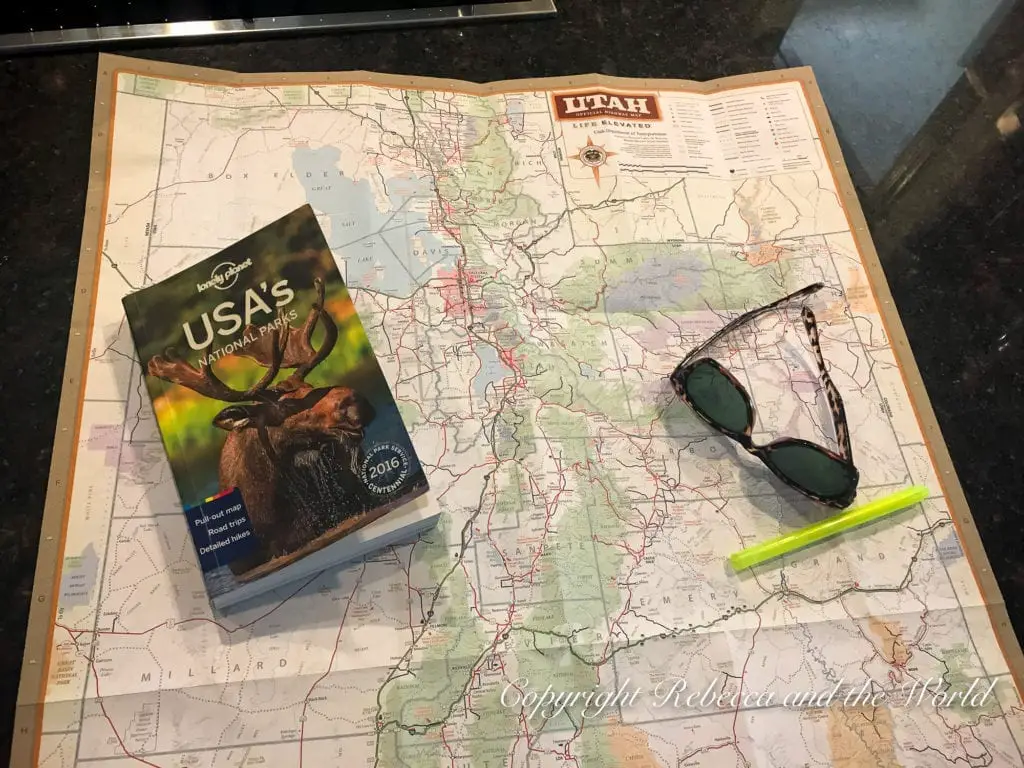
This blog post may contain affiliate links, meaning if you book or buy something through one of these links, I may earn a small commission (at no extra cost to you).

How to do this Utah road trip
This is a road trip, so of course you’ll need your own wheels . You have a few options here:
- Rent a car through Discover Cars and either camp or stay at hotels/Airbnbs along the way.
- Rent a campervan or RV – this is what we did and it made the trip even more fun! You’ll combine your transport and accommodation costs, saving some dollars as well. RVShare is a good option for this; it’s like the Airbnb of RVs. Escape Campervans is another great option for campervan rentals. I’ve listed campground throughout this post and you can use apps like iOverlander or US Public Lands to find free campsites .
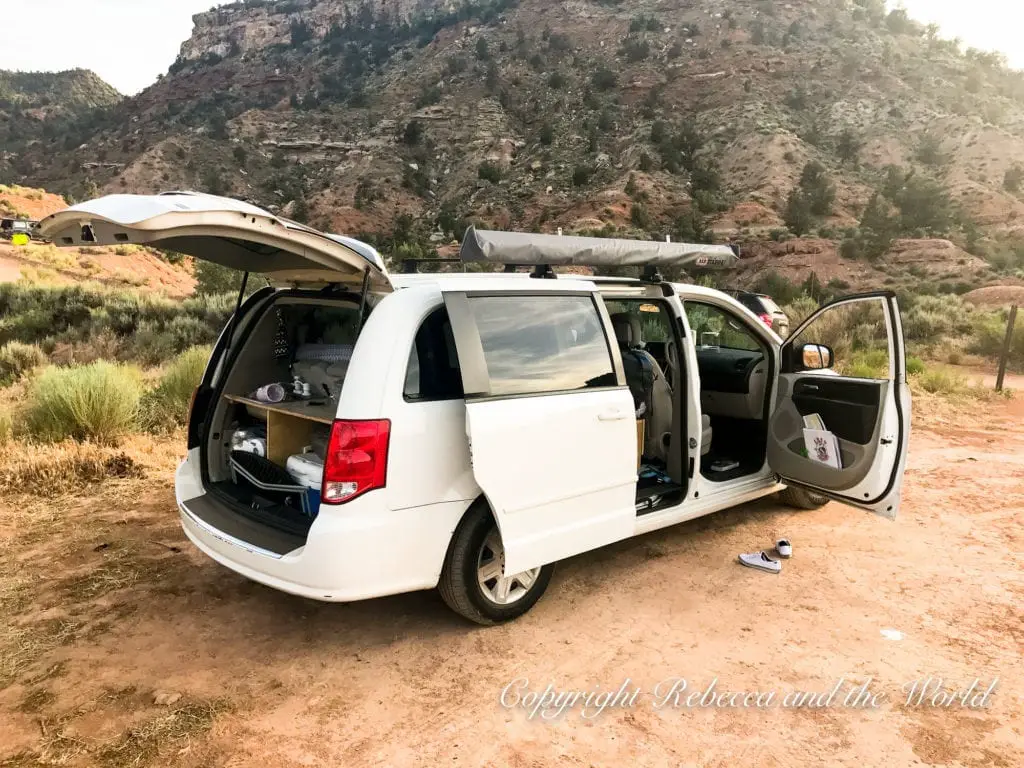
A question I get asked: Do you need a 4×4 for this road trip? If you follow this itinerary, you won’t need a 4×4 – a regular car is perfectly fine. The roads are all sealed and well maintained. Of course, you won’t be able to get out to some of the backroad locations – but you probably wouldn’t have time to do that in this short itinerary anyway.
Utah Mighty 5 road trip routes
To do this bucket list USA Utah national parks road trip, I’d recommend at least a week . This itinerary will give you a day in each park (two days in some parks) so there isn’t a lot of room for downtime.
If you have 10 days or two weeks to road trip Utah’s national parks, that would be even better. This will allow you to really explore all the natural beauty this state has to offer.
There are several ways you can visit all five Utah national parks in a week , depending on where you’re starting from. The best places to start and end this trip is in Las Vegas or Salt Lake City .
We did option number 1, but if I was doing this trip again, I’d probably take the Las Vegas to Salt Lake City (or vice versa) route to save on a bit of backtracking.
For option #2, check that your rental company allows you to return a vehicle to another location (there may be an additional charge).
For option #3, you could even add in a side trip to the Grand Canyon if you have one or two extra days.
These three Utah road trip route options include a side trip into Arizona to Monument Valley. But if you’re short on time, you can cut this out of your Utah itinerary.
National parks road trip itinerary
As mentioned earlier, we did a loop starting and ending in Salt Lake City , so that’s what I’ll get into in this article. You can easily take the information here and adapt it to the alternative routes listed above.
This 7-day Utah road trip itinerary that loops from Salt Lake City is:
Day 1: Salt Lake City to Zion National Park
Day 2: zion national park, day 3: bryce canyon national park, day 4: monument valley.
- Day 5: Canyonlands National Park and Moab
- Day 6: Arches National Park and Canyonlands National Park
- Day 7: Back to Salt Lake City via Capitol Reef National Park
Map of Utah national parks
Before I get into the nitty gritty of the Utah national parks road trip itinerary, here’s a map of where you’ll be going if you follow the route we took. You can download a map of national parks in Utah on the Visit Utah website or they’ll even post one to you if you plan ahead.
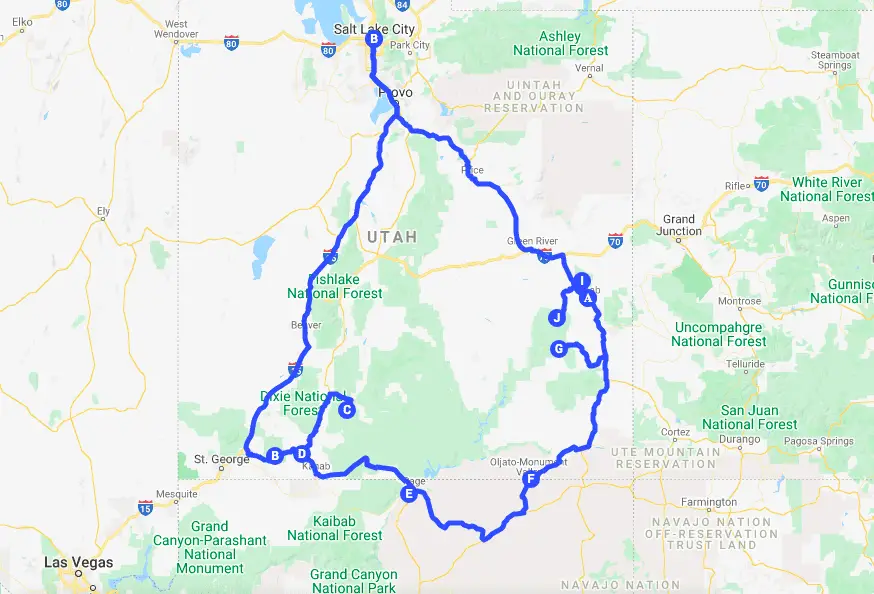
Alright, it’s time to hit the road!
Driving time: 4.5 hours / 308 miles
First up on this 7 day Utah national parks itinerary: pick up your car or campervan . Pick up any supplies you may need (including plenty of road trip snacks!). I have a handy road trip checklist so you don’t forget anything important.
You could check out of a few of the best things to do in Salt Lake City , but I’d recommend jumping straight on the road and heading for Zion National Park . It’s about a 4.5-hour drive from Salt Lake City.
Zion National Park is the busiest Utah national park , with more than 5 million visitors. Despite the crowds, it’s a must-visit on a Utah parks road trip.
Springdale is the town just outside of the entrance to Zion, and it has several great options for your first dinner on the road.
Zion National Park quick reference guide
Entrances: The main entrance is the South Entrance, near the town of Springdale Entrance fee: Private Vehicle, $35, valid for 7 days Website: Zion National Park Tips: Access to cars through the park is limited during high season (March to November), but Zion National Park has a fantastic free shuttle bus system to get around. The shuttle stops at all the key trailheads and loops around fairly frequently.
There’s also a shuttle bus that links to the Zion Canyon Shuttle from Springdale, which is convenient if you’re staying in town.
Where to stay in Zion National Park
Zion national park campgrounds.
Zion National Park has three campgrounds : South, Watchman and Lava Point. You can reserve South and Watchman in advance (campsites are $20 per night, $30 for powered sites at Watchman). South Campground can be reserved up to 14 days in advance, while Watchman can be reserved up to 6 months ahead of time. (Update: As of December 2023, South Campground is partially closed for rehabilitation works.)
If you can’t get a reservation in advance, you can still plan to arrive at the campgrounds at around 10 or 11am just in case a site becomes available. That’s how we got a site for the night.
Lava Point only has six basic campsites and is more remote, with no cell reception. Reservations can be made online. It’s open May to September only.
Hotels near Zion National Park
- Zion Lodge is the only hotel inside Zion National Park
- For something partway between a hotel and camping, try the luxury, safari-style tents at Under Canvas Zion
- Cliffrose Lodge is close to the entrance to Zion National Park
- Best Western Plus Zion Canyon Inn & Suites has comfy rooms with mini fridges and coffee makers – and great views
Vacation rentals near Zion National Park
If you can’t get a hotel room, plan ahead and look at vacation rentals instead. VRBO has several options to suit all group sizes and budgets. Check vacation rentals near Zion National Park .
Wake up early (I’m talking, like, 5am) to get a head start on the Angel’s Landing hike . This hike is very popular on most people’s Zion national park itinerary, and starting early helps to avoid both the crowds and the heat of the day. It’s a beautiful but fairly strenuous hike with some pockets of shade.
The final ascent to Angel’s Landing is a narrow ridge with steel chains as the only barrier to keep you falling hundreds of metres off the side.
I’m not shy in admitting that I just couldn’t bring myself to do this final section – it was too scary for me. I stayed below while my husband did the final section. He said that it was hairy in some parts, but the views are worth it if you don’t have a fear of heights .
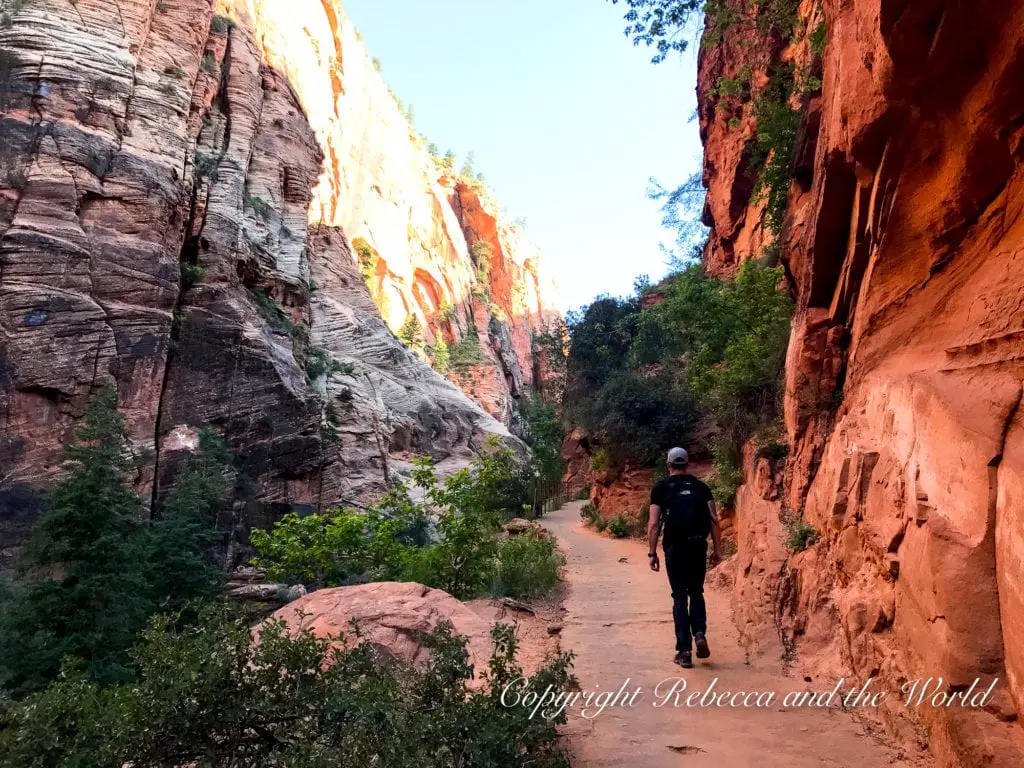
Later in the afternoon, take off on your next hike along the Riverside Walk .
If you can brave the icy water, end the day by wading through the start of The Narrows hike . We only did a small portion of this, and I would love to come back and do it completely. You can hike as far as Big Spring without a permit. It’s a 10-mile round-trip, so you’ll need the whole day to tackle this.
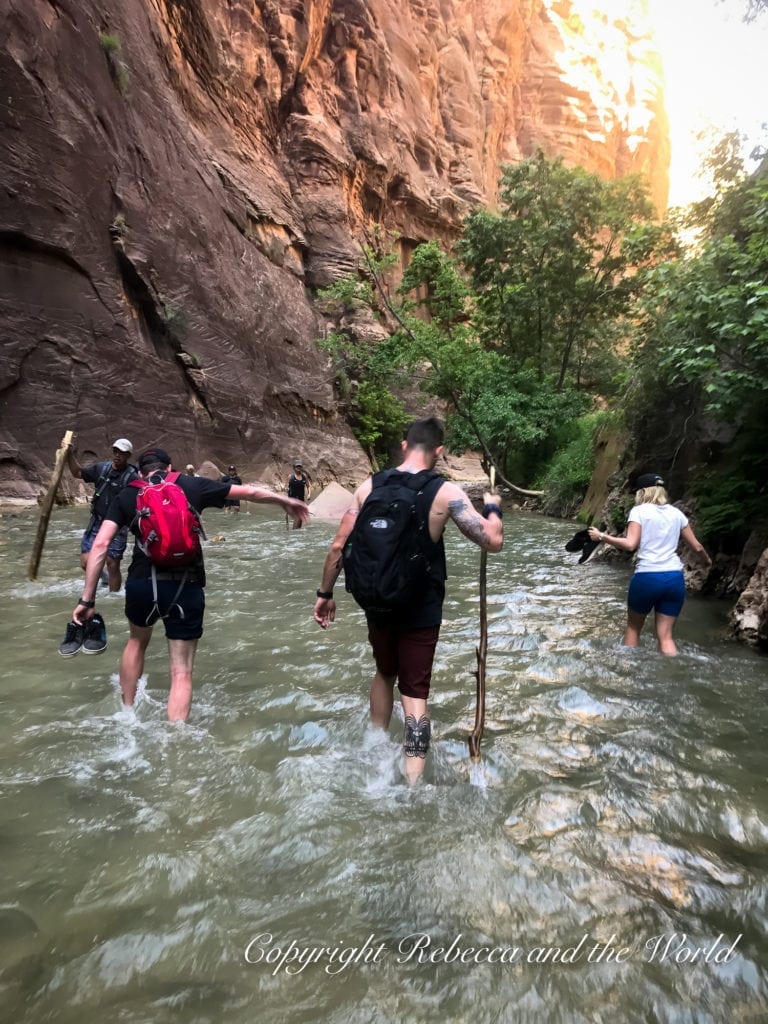
Best hikes in Zion National Park
- Angel’s Landing (5.4 miles, strenuous)
- Observation Point (8 miles, strenuous)
- Canyon Overlook Trail (1 mile, moderate; easier alternative to Angel’s Landing)
- Riverside Walk (2.2 miles, easy)
- Weeping Rock Trail (0.4 miles, easy)
- The Narrows (10 miles (to Big Spring) return trip, strenuous; high water levels and the risk of flash flooding can mean this is closed at some times during the year)
Driving time: 1.5 hours / 75 miles
Leaving Zion National Park on your way to Bryce Canyon , traverse the scenic 12-mile Zion-Mt Carmel Highway , passing through the historic tunnel. It’s a beautiful, winding road that exposes the red rocks of Zion.
It’s time to see just how different Bryce Canyon National Park, with its orange and white hoodoos , is to the deep red rocks of Zion National Park.
In my opinion, Bryce Canyon is the best national park in Utah . The landscape is out of this world and when we visited it was far quieter than Zion.
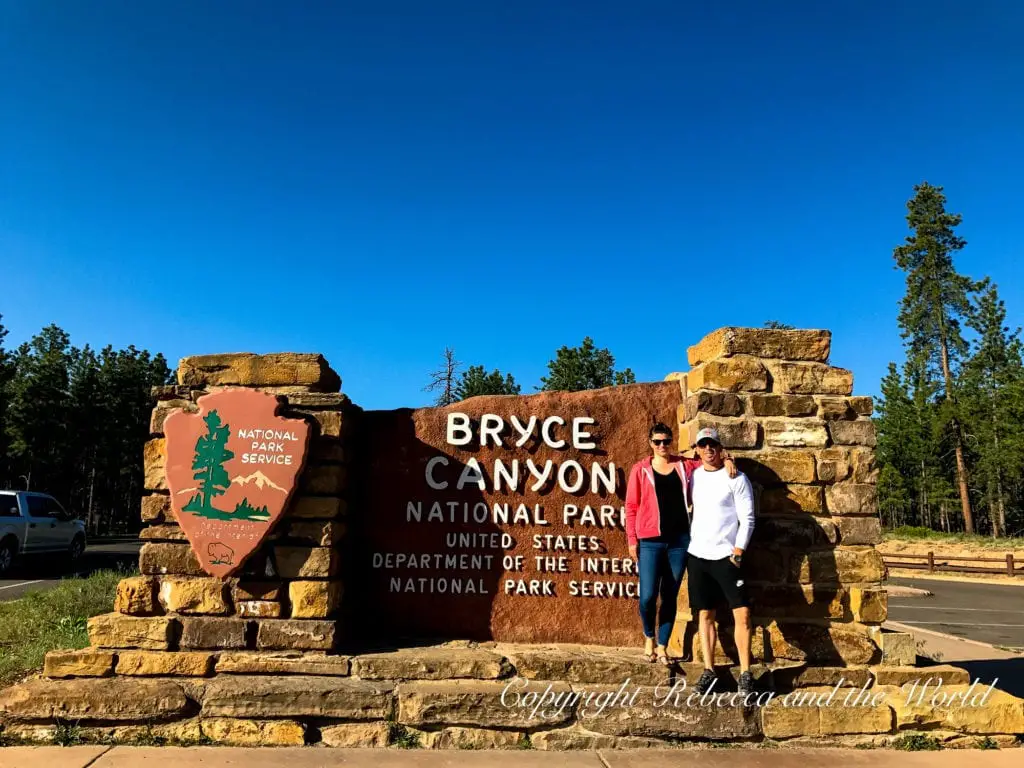
Hike the Navajo Loop / Queen’s Garden trails which take you down into and back up the canyon and past Thor’s Hammer . Later, hike a section of the Rim Trail , and stand above the hoodoos to get an idea of what Mars surely must look like.
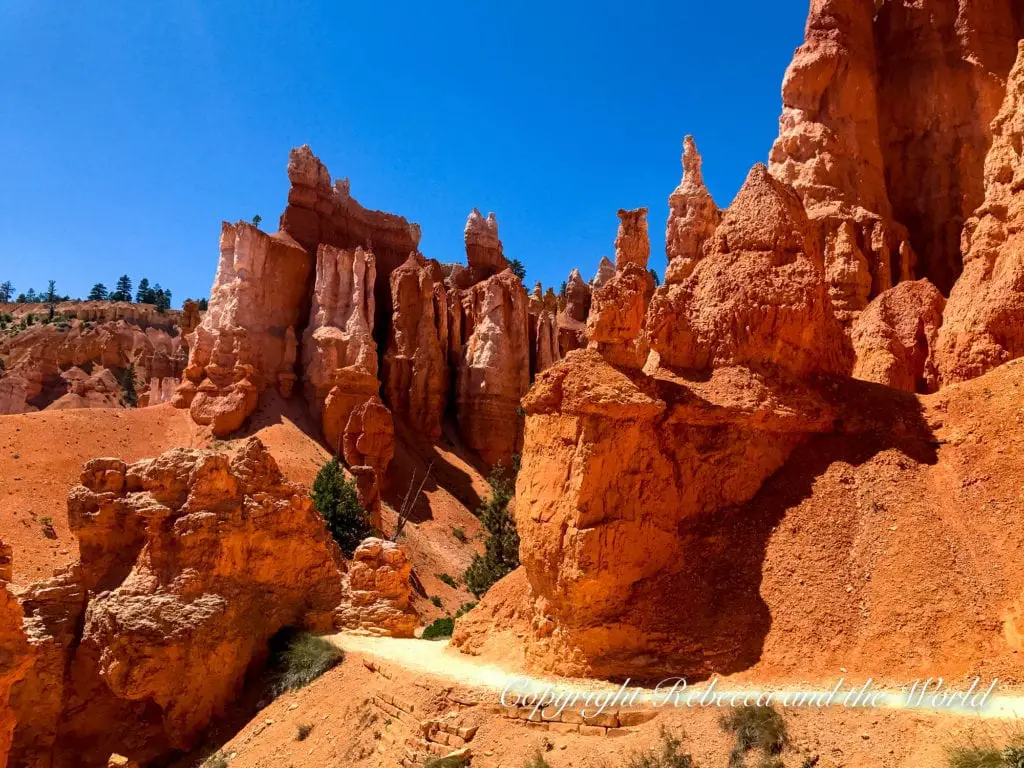
Sunset at Inspiration Point is a must, watching the colours of the hoodoos change as the sun goes down.
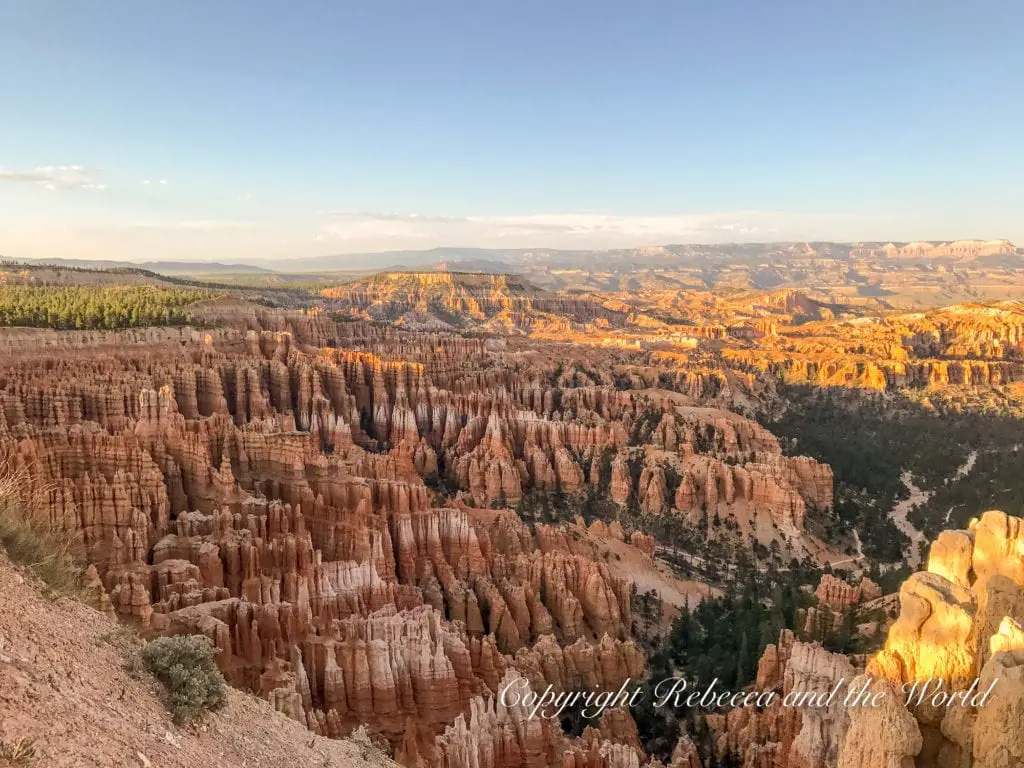
Best hikes in Bryce Canyon National Park
- Navajo Loop / Queen’s Garden (2.9 miles combined, moderate)
- Rim Trail (up to 11 miles, easy; paved from Sunset to Sunrise Points)
- Fairyland Loop (8 miles, strenuous)
Bryce Canyon National Park quick reference guide
Entrances: The only entrance to the park is via UT 12; you’ll pass through the small town of Bryce Entrance fee: Private Vehicle, $35, valid for 7 days Website: Bryce Canyon National Park Tips: Visitors are encouraged to take advantage of the free shuttle bus that operates through the park
Where to stay in Bryce Canyon National Park
Bryce canyon national park campgrounds.
There are two campgrounds in Bryce Canyon: North Campground and Sunset Campground (sites $30 per night). Both are close to the visitor centre.
Campsites at both campground can be reserved between mid-May and early October. For the rest of the year, they operate on a first-come, first-served system.
Outside of Bryce Canyon, Ruby’s Inn has an RV park and campground, which is where we stayed.
Hotels near Bryce Canyon National Park
If you’re not camping, try one of the hotels near Bryce Canyon National Park .
- Ruby’s Inn Best Western Plus is a popular option outside Bryce Canyon National Park (we stayed at the adjoined RV park and campground)
- The Lodge at Bryce Canyon is located inside the park, with 114 rooms and an on-site restaurant
- Stone Canyon Inn has several cabins onsite
Vacation rentals near Bryce Canyon National Park
- This charming country home on a large property – with fruit picking available in the fall
- This incredible chalet halfway between Zion and Bryce Canyon National Parks
Driving time: 4.5 hours / 275 miles
On day four of the Utah national parks road trip, we’re actually heading into another state: Arizona !
As I mentioned earlier, you can skip Monument Valley if you want to stay in Utah and spend more time at the Mighty 5 national parks. But it’s a great detour.
It’s a long day of driving from Bryce Canyon south into Arizona. Stop for pie at the retro Thunderbird Restaurant at Mt Carmel Junction. As an Australian, this place is exactly how I always pictured American diners to be!
Stop at Page , home to the highly Instagrammed Horseshoe Bend , and nervously watch everyone as they perch on the edge to get the perfect selfie.
It’s a hot and dusty walk to the viewpoint, so bring adequate shoes and lots of water and sunscreen . To manage the huge influx of visitors that Horseshoe Bend has recently experienced, you’ll now need to pay an entrance fee of $30 per passenger vehicle.
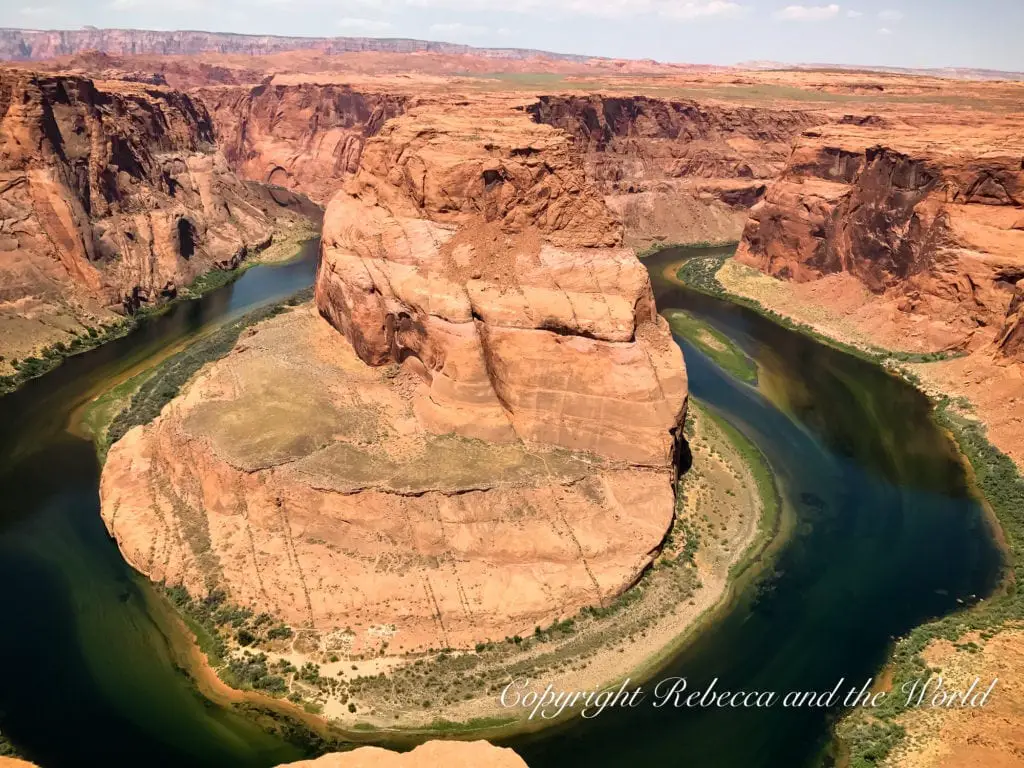
Another popular site in Page is Antelope Canyon . Here you can visit Upper Antelope Canyon, an incredible slot canyon. Reservations are a must. We unfortunately didn’t have time, but photos I have seen are spectacular. If you can make the time, there are tours of Lower Antelope Canyon and Upper Canyon .
If you have even more time, many people add on a trip to the Grand Canyon to their Utah national parks road trip itinerary. You’ll need at least two days, though, to see the park properly.
Continue on to Monument Valley , famous from oh-so-many movies. Drive through the valley ($8 per person, per day; Monument Valley isn’t covered under the America the Beautiful national parks annual pass ) in the late afternoon as the sun is going down for some spectacular silhouettes of the buttes . Early morning is another option for nice light.
You need two to three hours to do the 17-mile self-guided driving tour through Monument Valley (maps available at the Information Center).
There are a few hiking trails (permit required) or you can take an organised tour which will allow you access to a traditional Navajo hogan, a small house. Here’s a good option for a sunset tour , or a 2.5-hour trip with backcountry access where you’ll learn more about Navajo culture.
Be respectful of the land at all times and stick to the trails – this is Navajo land .
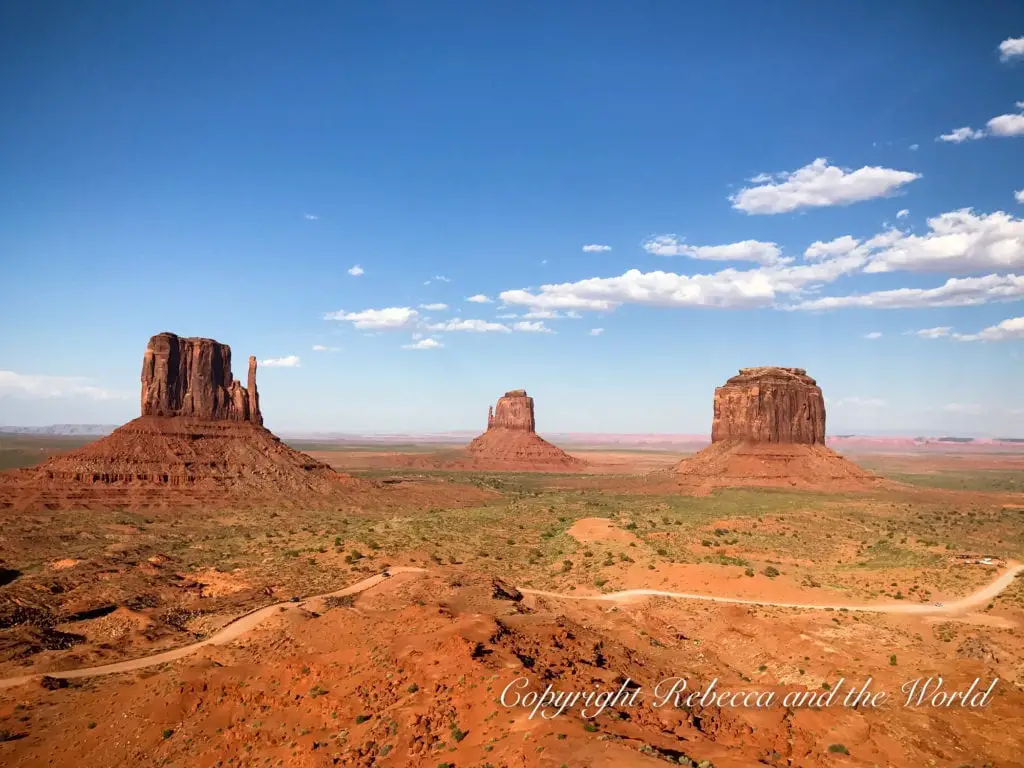
Hotels near Monument Valley
There are a couple of hotels near Monument Valley :
- We parked our campervan at Goulding’s Lodge , which has both a hotel and campground. It’s also got a restaurant, gas station, laundry, trading post and a museum highlighting the history of the area, including about the films that have been shot there. The theatre shows John Wayne movies nightly
- The View Hotel is located within Monument Valley Navajo Tribal Park. As the name suggests, it has great views over the valley
Day 5: The Needles, Canyonlands National Park
Driving time: 5.5 hours / 238 miles
Day five will see you heading back into Utah on your way to Moab . Before you get too far, stop at mile marker 13 on highway 163 for the classic road jumping shot with Monument Valley in the background.
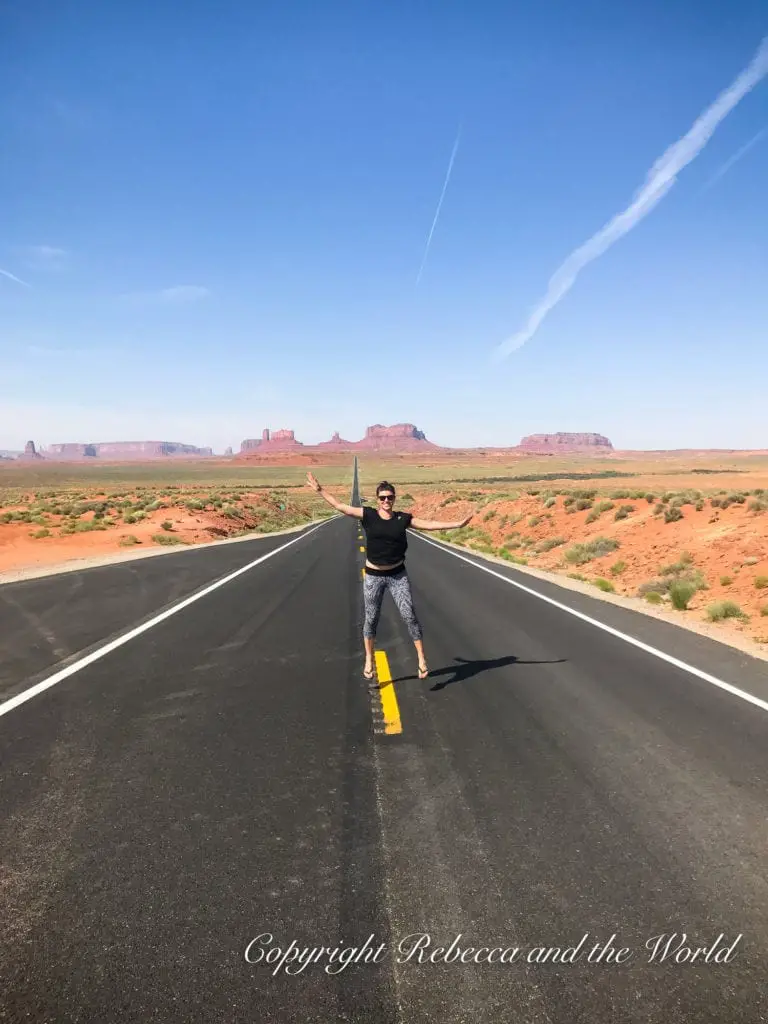
Before getting to Moab, take the long detour to The Needles area of Canyonlands National Park . It’s a side trip off the main road and does add extra time to this Utah road trip itinerary, but it’s worth it. If you’re short on time, then you can skip this and head straight to Moab.
Canyonlands National Park is actually split into three distinct areas by the rivers that run through the park: The Needles, Island in the Sky and the Maze. The Maze is only accessible by 4WD and is very remote. I haven’t included it in this Utah national parks itinerary because we didn’t visit it.
The Needles is far less touristy than the other national parks in Utah. To get a taste of the park, hike the Slickrock trail , which will take you over smooth, mustard-coloured rocks as you follow the cairns-marked trail.
After that, hit up another hike like the Cave Spring trail . This one winds through old cowboy hangouts and up ladders. Again, you’ll be marvelling at just how different the landscape is compared to the other national parks visited on this trip.
We only wish we’d had more time to do some of the longer, more challenging hikes. Unfortunately, there was a spectacular lightning storm starting up as we began hiking, and we didn’t want to be exposed.
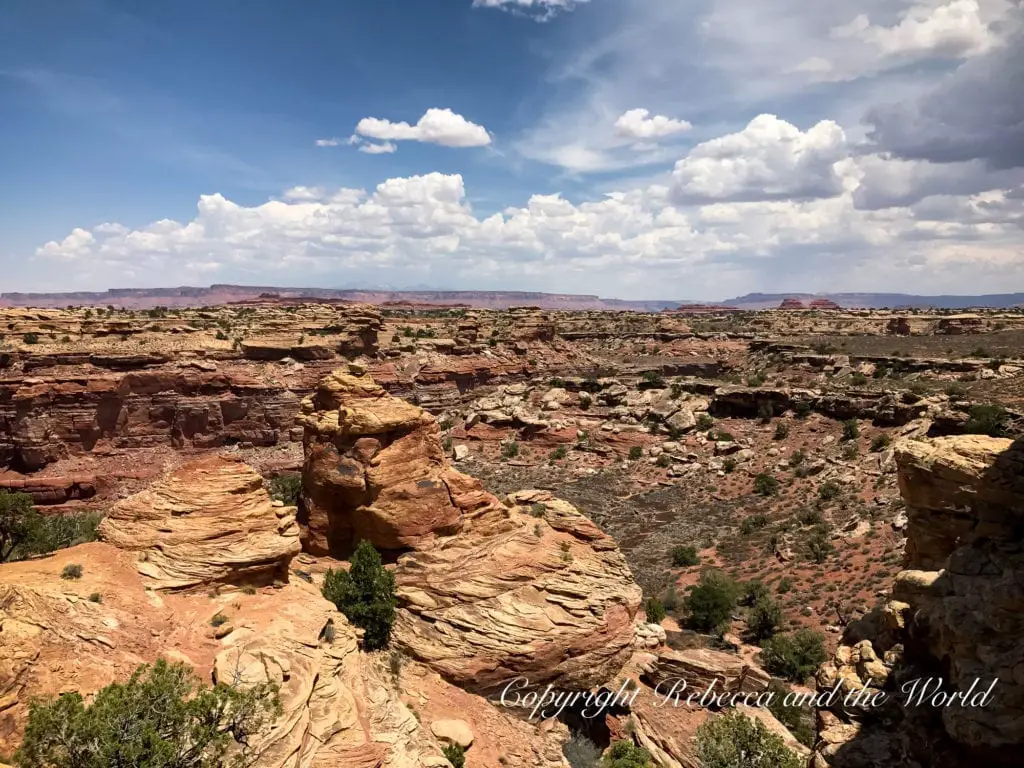
Continue on to Moab and have a late lunch of burgers and peanut butter milkshakes at Milt’s Stop and Eat .
Best hikes in The Needles, Canyonlands National Park
- Chesler Park Viewpoint (6 miles, strenuous)
- Slickrock Trail (2.4 miles, short)
- Big Spring Canyon to Squaw Canyon (7.5 miles, strenuous)
- Cave Spring (0.6 miles, short)
Canyonlands National Park quick reference guide
Entrances: The entrance to Island in the Sky is about 40 minutes from Moab, while The Needles entrance is about a 90-minute drive Entrance fee: Private Vehicle, $30 Website: Canyonlands National Park Tips: Moab is the best place to base yourself to see the two main sections of the park
Where to stay in Moab
Moab campgrounds.
- We stayed at the KOA campground in Moab . Staff were friendly and they have a pool and shop onsite.
Hotels in Moab
Moab is a small town, but its reputation as an action hub means that it’s full of hotels and campgrounds.
- The Gonzo Inn is a popular place to stay in Moab. There’s an outdoor pool which will be a huge relief in the heat of the afternoon – Moab gets really hot
- Red Cliffs Lodge has 115 simple rooms, some with balconies with great views over the river
Vacation rentals in Moab
There are plenty of vacation rentals in Moab , so you’ll have lots of choices. I like the look of:
- This light-filled cabin with a great patio with grill (and it’s dog friendly!)
- This property would be good for groups of up to 6 people
Day 6: Arches National Park and Island in the Sky
Arches National Park is just outside of Moab, and is famous for its variety of sandstone arches.
Tackle some of the shorter hikes to Broken Arch and Sand Dune Arch in the morning.
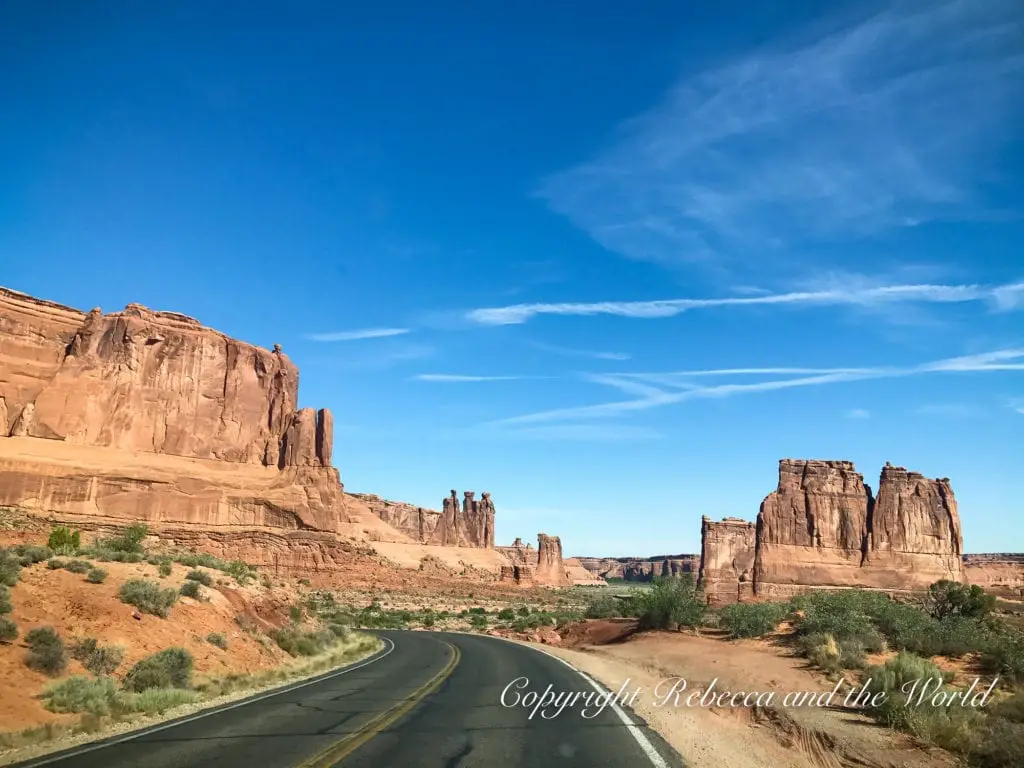
In the afternoon, hike to Delicate Arch . This is a must-do on your visit to Arches National Park. Be aware that this hike has no shade, and the last part is around a cliff face with a sharp drop off. It’s one of the most photographed spots on any trip to Utah.
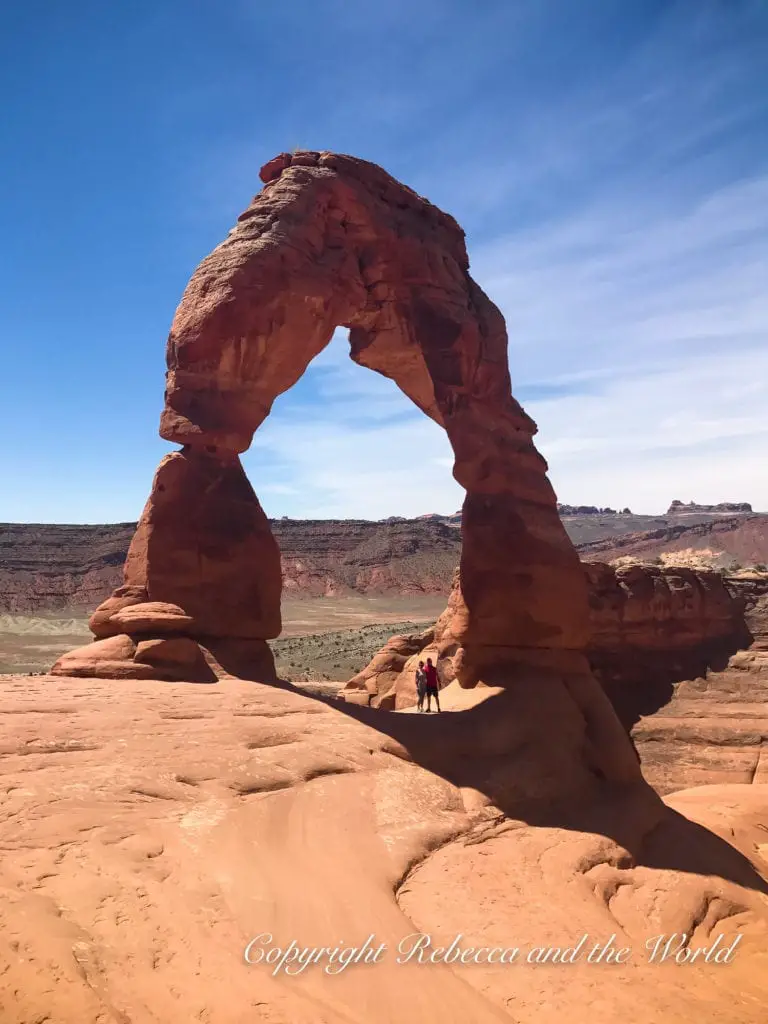
Best hikes in Arches National Park
- Delicate Arch (3 miles, strenuous)
- Double O Arch Trail (4.2 miles, strenuous)
- Park Avenue Trail (1 mile one-way, moderate)
- Devil’s Garden (7.2 miles, strenuous)
- Windows Trail (1 mile, easy)
- Fiery Furnace (reservation necessary, guided by Park Ranger)
Arches National Park quick reference guide
Entrances: The entrance is just a 10-minute drive from Moab Entrance fee: Private Vehicle, $30, valid for 7 days Reservation needed: Between 1 April and 31 October, you’ll also need to book a timed entrance. Book online here Website: Arches National Park
Before sunset, drive out to the other section of Canyonlands National Park, the Island in the Sky . From the viewpoint, gaze out over the land, which looks like a giant dinosaur has left its footprint behind.
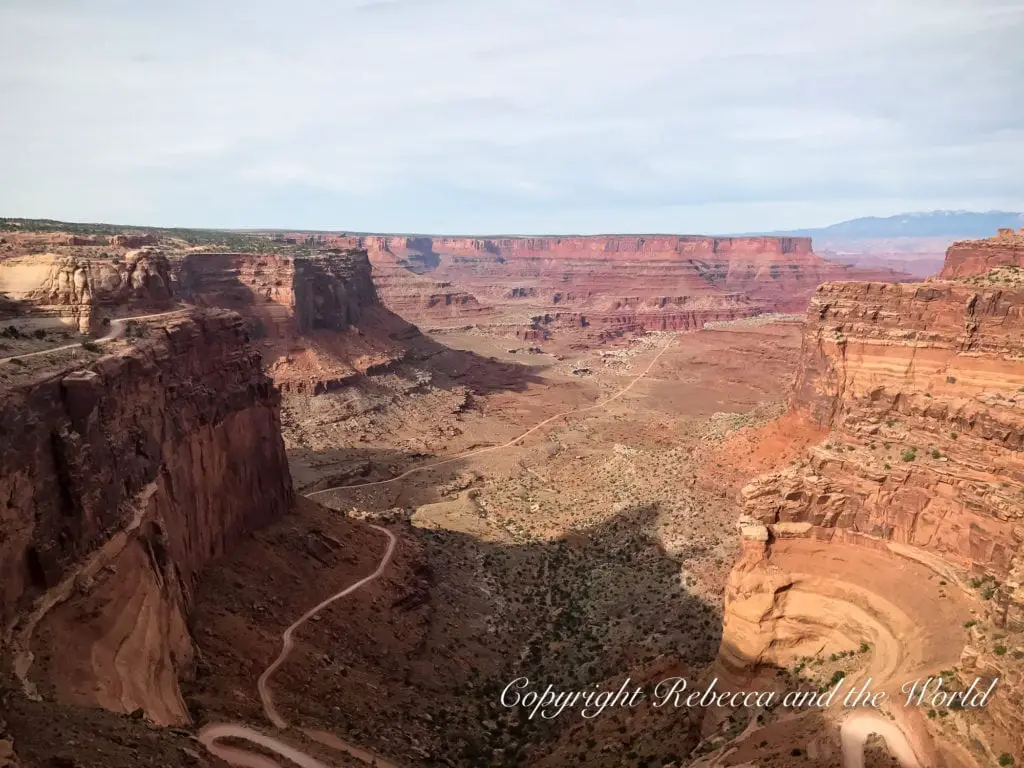
If you’re in luck, you might even have Mesa Arch all to yourselves for a few minutes. Most people recommend to visit Mesa Arch at dawn, but we found it to be just as beautiful at sunset.
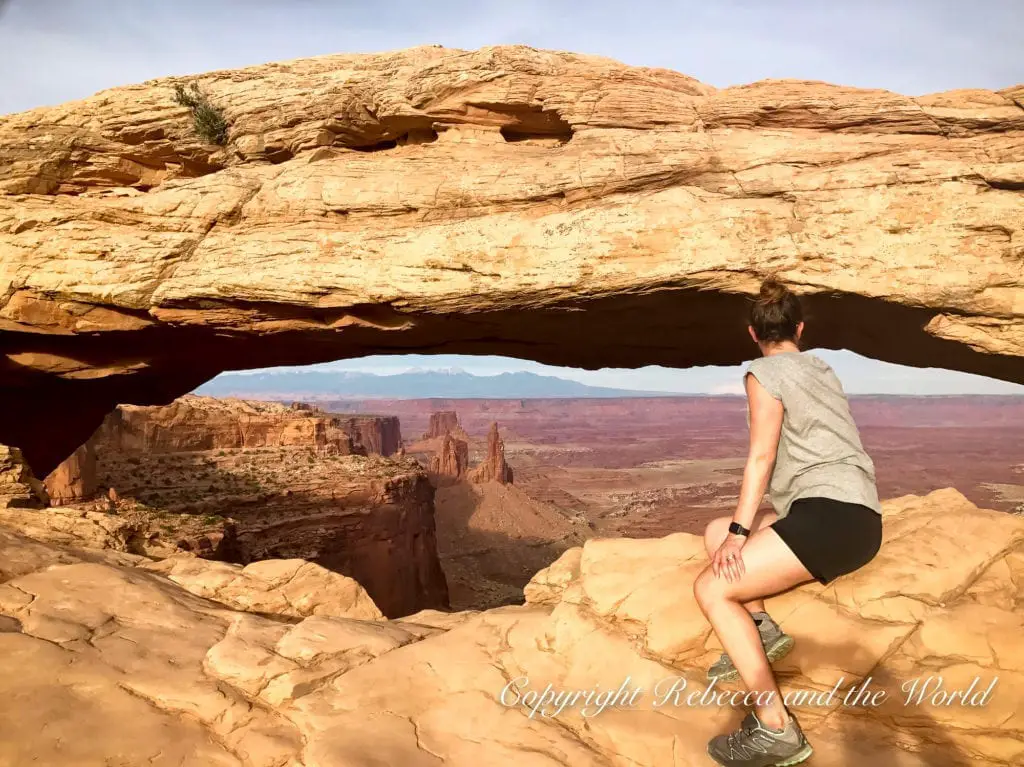
Moab is one of the best places to visit in Utah for adventure lovers , so if you’ve had enough of hiking, you can try mountain bike riding , offroading , 4×4 adventuring , rappeling or rafting on the Colorado River . There are companies throughout Moab that offer all sorts of outdoor adventures.
Best hikes in Island in the Sky, Canyonlands National Park
- Mesa Arch (0.5 miles, easy)
- Grand View Point Trail (2 miles, easy)
- Neck Spring (5.8 miles, moderate)
- Gooseberry Trail (5.4 miles, strenuous)
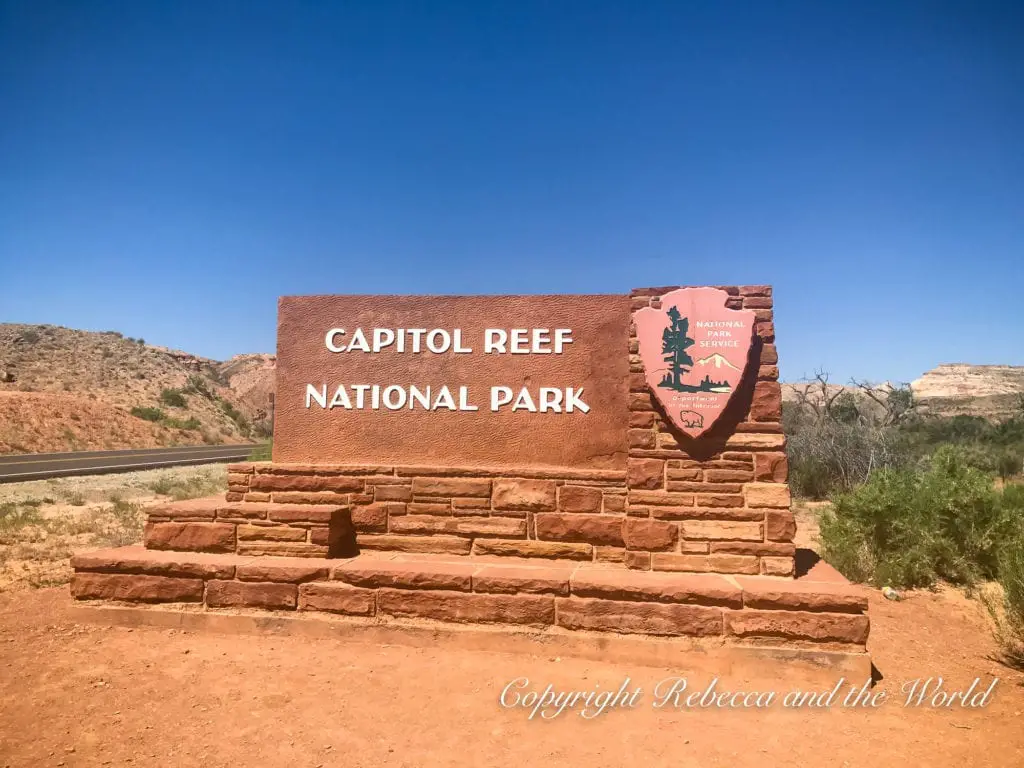
Day 7: Capitol Reef National Park and back to Salt Lake City
Driving time: 5.5 hours / 369 miles
On the last day of the road trip, return to Salt Lake City via Capitol Reef National Park .
As the smallest of the five Utah national parks , you can easily drive through it via the 9-mile scenic drive and stop off to do shorter hikes. We only spent a few hours here, the shortest visit of our trip.
The park also has an old Mormon mission and you can stop by the historic Gifford Homestead to enjoy a fruit pie in the shaded grounds. The perfect sweet way to finish your Utah national park itinerary!
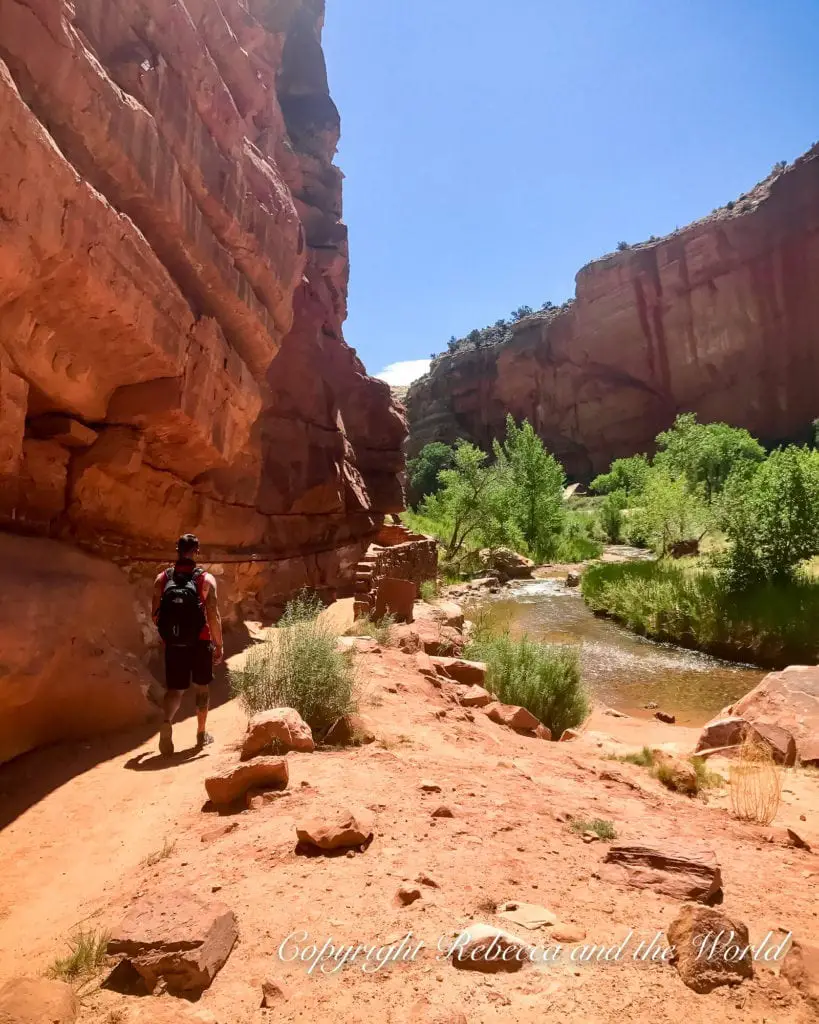
Best hikes in Capitol Reef National Park
- Sunset Point Trail (0.4 miles one-way, easy)
- Hickman Bridge Trail (0.9 miles one-way, moderate)
- Chimney Rock Trail (3.6 miles, strenuous)
- Rim Overlook Trail (2.3 miles, strenuous)
Capitol Reef National Park quick reference guide
Entrance fee: Private Vehicle, $20, valid for 7 days Website: Capitol Reef National Park
Where to stay near Capitol Reef National Park
If you do decide to stay longer than a few hours or one day, here are a few options for sleeping.
Capitol Reef National Park campgrounds
There’s only one developed campground within Capitol Reef, and that’s the 71-site Fruita Campground . The fee is $25 per night, and sites are reservable only between 1 March and 31 October. The rest of the year it’s first come, first served.
Hotels near Capitol Reef National Park
- For something truly unique, book a night in a Conestoga wagon! Peek out your wagon at Capitol Reef Resort in the morning for stunning red rock views. Or, choose from luxury teepees and cabins
- Broken Spur Inn and Steakhouse (located in Torrey) is a simple hotel only a 10-minute drive to the entrance of Capitol Reef National Park
Vacation rentals near Capitol Reef National Park
- This cute cabin is great for couples or small families
- This 2-bedroom home with a great deck in the nearby town of Teasdale
Finally, return your car or campervan in Salt Lake City – 7 days in Utah goes by quickly! This will be a trip you won’t quickly forget – and if you’re like me, you’ll be wanting to go back very soon.
Tips for planning a Utah national parks road trip itinerary
Buy a national parks pass.
If you’re planning to road trip to Utah national parks, buy the America the Beautiful annual pass , which costs $80. Each national park costs between $20 and $35 to visit, so if you visit three or more parks on this Utah mighty 5 road trip, this pass will save you money .
The pass is also valid at any national park in the entire United States so you can use it at other parks for the rest of the year.
Book accommodation in advance
Hotels, lodges and camping sites around the national parks can be booked out months – even a year – in advance, so book accommodation in advance . (I use Booking.com and Expedia to book accommodation, comparing prices across both sites before I book.)
Each campsite has different processes for booking. Some can be booked online in advance, others can only be booked in person on the day, so you’ll need to factor this in to your planning.
Research each park before you visit
Do your research on each park’s website in advance – there’s a huge amount of information available online. This will help you plan your days to get the most out of each park.
And when you arrive at each park, stop by the visitor centre to pick up a map and talk to the rangers . They know the best time to visit each location for the perfect photos and which hikes to do to maximise the time you have.
Best time to visit Utah national parks
We visited in early June and found it to be a great time to visit the Utah Mighty 5 – just before school vacation so the crowds were not quite in full force, and the weather was warm and sunny, but not yet suffocatingly hot.
Spring and autumn/fall
These are the best seasons to visit the national parks in Utah – but also the most popular. Temperatures are milder, so hikes will be more manageable, but you’ll have to battle the crowds.
It goes without saying that summer is the hottest time to visit the national parks of Utah, with temperatures often creeping toward 100 degrees Fahrenheit (40 degrees Celsius). If you must visit during these months, plan your visit carefully and aim to hike either early in the morning or late in the afternoon. And always have plenty of water with you.
The winter months can bring temperatures below freezing at night – and snow . I’ve seen photos of some of the national parks during winter and it looks stunning with snow-dusted peaks and few crowds, but make sure to come with adequate winter clothing.
What to pack for a Utah national parks road trip
When you’re visiting the national parks in Utah, come prepared. Here are a few items I’d recommend packing, and I have a longer road trip packing list guide with more ideas:
- An America the Beautiful annual pass to save you tonnes of money!
- A cell phone mount is helpful for hands-free navigating. Remember to download maps as you’ll encounter areas without service.
- Bring a good backpack for all your gear, and a daypack for hiking.
- Use a water bladder to stay hydrated while tackling the hiking trails.
- Pack sturdy hiking boots .
- Don’t forget plenty of sunscreen ! It gets hot out here, and the sun can be brutal, even in winter.
- If you’re travelling in a campervan like we did or camping in Utah national parks, you may go several days without a shower (pee-yew!). Pack some body wipes to stay fresh.
- If you’re camping or in an RV, pack a power inverter to keep your electronics charged while you’re driving.
- Don’t forget a good first aid kit .
- Pick up a copy of the Lonely Planet guide to Southwest USA or Lonely Planet’s national parks guidebook so that you can learn more about Utah .
For other items you’ll need to bring on this Utah national parks itinerary 7 days, check out this packing list for camping in the national parks .
Utah national park road trip: FAQSs
How many days do you need to see the national parks in utah.
You need at least a week to see all of the national parks in Utah. With 7 days, you can visit each of the state’s five national parks. This will give you 1-2 days at each of the national parks.
Can you see all 5 national parks in Utah?
The great thing about the Mighty 5 is that you can see all of them in a week. Follow my itinerary and you’ll be able to visit all 5 national parks in Utah in just 7 days.
How many national parks are there in Utah?
Utah has 5 national parks: Zion National Park, Bryce Canyon National Park, Arches National Park, Canyonlands National Park and Capitol Reef National Park.
Did you find this article helpful? Consider buying me a coffee as a way to say thanks!
Have you visited Utah? Which is your favourite national park? Let me know in the comments below.
Related posts
Before you go… you might like these USA road trips:
- New Mexico Road Trip Itinerary: Discover the Land of Enchantment
- Plan a Deep South Road Trip Itinerary: What to See, Do and Eat
- Mississippi Road Trip: 7 Fascinating Places to Visit in the Magnolia State
- 17 Fun Things to do in West Texas: An Unmissable West Texas Road Trip
USA TRIP ESSENTIALS
- Book flights to and around the USA online with Skyscanner . I like this site because it shows me which dates are cheaper.
- Find a great hotel in the USA. Check prices on Booking.com and Expedia online.
- Check out the huge range of day tours throughout the USA on GetYourGuide or Viator . There’s something for everyone.
- A copy of the Lonely Planet guide to the USA will be handy.
- One thing I always purchase is travel insurance ! Travel Insurance Master allows you to compare across multiple policy providers, while SafetyWing is great for long-term travellers and digital nomads.
7 DAY ITINERARY UTAH NATIONAL PARKS: PIN IT FOR LATER
Don’t forget to save this Utah national parks road trip itinerary to Pinterest and guide so that you can plan your own road trip!
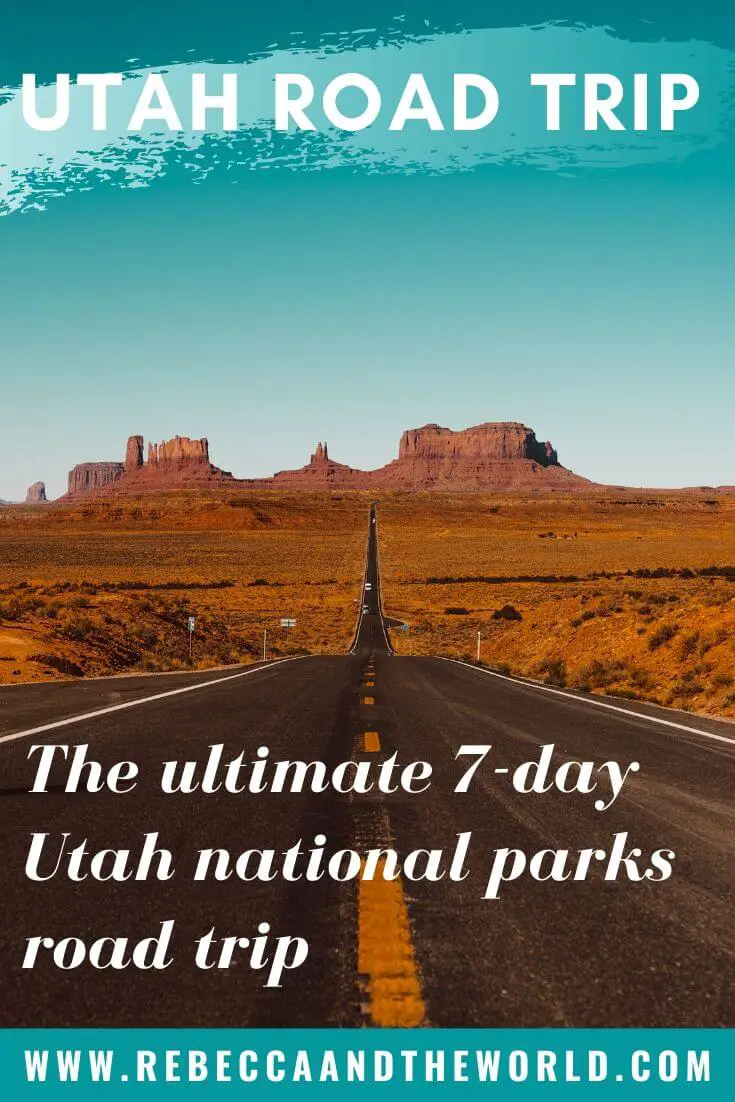
About REBECCA
I'm a travel junkie who started dreaming about seeing the world from a very young age. I've visited more than 40 countries and have a Master of International Sustainable Tourism Management. A former expat, I've lived in Australia, Papua New Guinea, Argentina and the United States. I share travel resources, tips and stories based on my personal experiences, and my goal is to make travel planning just that bit easier.
17 thoughts on “Utah National Parks Road Trip Itinerary: How to Plan a 7-Day Trip to the Mighty 5 in 2024”
Hi Rebecca, I am looking to do a SLC to LV of the Mighty 5 plus GC, Horseshoe Bend, and Antelope Canyon in October. I have 15 days including fly days. Ideas on an itinerary? Thanks so much!
Hi Amy! You could do something like: Salt Lake City (spend a day there if you haven’t already visited), then Bryce Canyon, Capitol Reef, Moab (for both Arches and Canyonlands National Parks), The Needles portion of Canyonlands, Monument Valley, Grand Canyon, Antelope Canyon, Zion, LV. Plan to spend 2 days at least in each of Bryce, GC and Zion, plus 3 days in Moab. That should stretch you out to two weeks without feeling rushed. I’m jealous you’ll have so much time exploring this beautiful part of the world!
Hi…I love this post but I am looking to do LV to LV including a brief visit at GC, Antelope and Horseshoe and then travel on to the Utah parks. I have 10 days including flying. Any ideas on an itinerary?
Hi Joan, how fun! The most efficient route, then, would be Las Vegas – Grand Canyon – Horseshoe Bend/Antelope Canyon – Arches NP/Canyonlands – Capitol Reef – Bryce Canyon – Zion NP – Las Vegas. You could easily do that in 10 days, with one day at each stop (or two days in places you really want to spend a bit more time in). Have fun!!
Dynamite photos, loved looking at them.
Thanks! It’s such a beautiful state, so fun to drive around.
Enjoyed reading this very much. Thanks! Since you did a fair amount of driving around where I’m planning to go, wondering if you had any info/advice to share about using an RV for this trip in the winter. Curious about accessibility with the roads, whether any of the segments between parks make driving difficult because of vehicle clearance, or whether the roads are not paved and may be difficult to traverse in a larger vehicle.
Hey Patrick! So excited that you’re heading this way – it’s a beautiful part of the world. We visited in early June and had no issues with the roads – and there were so many RVs out as well. In winter, I’d say it’d be much the same. The roads between all the parks are paved and well-maintained. Even within the parks the roads are really good so I wouldn’t think you’d have any issues. The only limitation I can see is if you want to get offroad at any time. For example, driving through Monument Valley was quite bumpy in our small campervan, and it might be tough in an RV (depending on how big it is) – check first whether they even allow RVs inside the monument. Happy travelling and let me know if you have any more questions!
Just got back from Zion, but I want to see them all!
What I loved about all the parks in Utah is just how close they were to each other – so it is possible to see several in just a few days!
Such incredible photos – Zion National Park looks like a different planet!! What an adventure – definintely one for the bucketlist!
Absolutely! Was such a great trip 🙂
Rebecca!! Seriously, I cannot thank you enough for opening my eyes to the world of camper vans! We leave in two weeks and last minute Chase wanted to camp (and we pretty much have no camp supplies, although it’s been on my list to get for this summer – to start small and camp close to home LOL, he was ready for a 3000 mile away camp trip), so it left us scrambling to figure out how to get a tent on a plane, oh and then buying a tent, and yadda! We already reserved a rental car, but believe we are returning it and going with the camper van. This post made me even more excited!
Thank you again! <3
Oh I’m so glad I saw your post and commented. It really does make life easier – you don’t have to lug a whole lot of stuff on to a plane, and buy stuff that you might not use again. It will be a bit cold while you’re there, too, so sleeping inside a van will make it a little warmer. Have so much fun – can’t wait to see your pics!!
This post reminds me of your adventure to see Mt Fitz Roy in Patagonia for you took some really great shots at both places! Weather plays an important role in making an outdoor adventure pleasant or not, and you seem to always know when to go. I have to say your photos of those national parks in Utah are some of the best I’ve ever stumbled upon! Btw, in that photo of you and other hikers wading through the icy water at the start of The Narrows, it’s not easy to spot which one your husband is. That bird of paradise reminds me of the days when you were still living in PNG. 🙂
Bama, you always leave the nicest comments!! This really brightened up my day when I first read it and I was in a slump about blogging in general. Thank you! And the fact that you noticed the bird of paradise tattoo! 🙂
Wow Rebecca this is a wonderful blog. I have really enjoyed reading it and will read the others. Elly just told me about it. Glad she did as it gives me an heads up on how you and Matt spend your rec time. Great stuff.
Leave a Comment Cancel reply
MORE INFORMATION
ABOUT WORK WITH ME CONTACT PUBLISHED WORK
AFFILIATE DISCLOSURE
AS AN AMAZON ASSOCIATE I EARN FROM QUALIFYING PURCHASES
© 2024 REBECCA AND THE WORLD
Privacy Policy
I ACKNOWLEDGE THE WURUNDJERI AND BOON WURRUNG PEOPLE OF THE KULIN NATION AS THE TRADITIONAL OWNERS OF THE LANDS AND WATERWAYS OF THE AREA I LIVE ON. I PAY MY RESPECTS TO ELDERS PAST AND PRESENT AND CELEBRATE THE STORIES, CULTURE AND TRADITIONS OF ALL ABORIGINAL AND TORRES STRAIT ISLANDER PEOPLE ACROSS AUSTRALIA.

- Privacy Overview
- Strictly Necessary Cookies
This website uses cookies so that we can provide you with the best user experience possible. Cookie information is stored in your browser and performs functions such as recognising you when you return to our website and helping our team to understand which sections of the website you find most interesting and useful.
Strictly Necessary Cookie should be enabled at all times so that we can save your preferences for cookie settings.
If you disable this cookie, we will not be able to save your preferences. This means that every time you visit this website you will need to enable or disable cookies again.

9-Day Utah National Parks Road Trip Itinerary Through the Mighty 5
Explore Utah National Parks in this road trip itinerary with the best hikes, camping and more in Zion, Bryce, Capitol Reef, Arches & Canyonlands.

Southern Utah’s National Parks are what first drew me to Utah and are ultimately the reason I ended up moving to Salt Lake City. There’s literally nowhere else on the planet like Bryce Canyon or Zion!
Otherwise known as the Mighty 5, these public lands offer stunning red rock scenery, twisting slot canyons, and incredible hiking. They can also be connected to create an epic Utah National Parks road trip, which is an unforgettable trip for any outdoor adventurer.
Because there’s so much to see and do in Utah’s National Parks, I recommend having at least two weeks available if you plan on visiting all five. Alternatively, you can focus on 2-3 parks if you only have a week.
In this 9-day Utah National Parks road trip itinerary, I share my favorite hikes, the best spots to stop along the route, and travel tips for maximizing your time in Southern Utah.
What are the Mighty 5?
The Mighty 5 are the five National Parks in southern Utah. They include:
- Zion National Park
- Bryce Canyon National Park
- Capitol Reef National Park
- Canyonlands National Park
- Arches National Park

The Best Times to Visit Utah’s National Parks
Utah’s National Parks are open year-round and each park’s diverse landscapes and offerings can change based on the weather and season you are visiting. Below is a quick summary of seasons in southern Utan. For more information check out posts on the best time to visit Utah’s National Parks and the best time to visit Bryce Canyon National Park .
Spring and Fall
The most popular (and busiest) times to visit are Spring (April-May) and Fall (September-October). During these milder seasons, the daytime temperatures can range from 60-80 degrees with lows averaging 40-60 degrees. It’s the most comfortable time of year for a Utah National Parks road trip , but with that, you need to be prepared to deal with large crowds.
If you choose to visit any of these Utah National Parks in the summer months, expect daytime temperatures to reach over 100 degrees. Personally, I don’t recommend planning a Mighty 5 road trip during the summer. The parks are still quite busy and you’ll need to do all of your hiking very early or very late in the day to avoid the mid-day heat and scorching summer sun.
If you do decide to do this trip in the summer, be sure to check out our guide on sun protection for hikers and make sure you have a day pack that can carry at least 3L of water.
Similarly, if you plan to road trip during the winter months, you need to be prepared for temperatures ranging from 30 to 50 degrees during the day and then dropping to well below freezing overnight.
That being said, winter is a beautiful time to visit the parks because you’ll get to enjoy these stunning desert landscapes, perhaps dusted with snow, while avoiding the National Park crowds .
Just be prepared with winter clothing and check conditions before heading out. You’ll likely want to book rooms in hotels as opposed to camping if you visit in winter.

Where to Start and End your Mighty 5 Road Trip
Utah’s National Parks are spread across the southern half of the state. If you’re flying into Utah to start your trip, the best airports to fly into are:
- Las Vegas, Nevada (2.5 hours to Zion National Park)
- Salt Lake City, Utah (3.5 hours to Arches National Park)
If you only have one week, I recommend focusing on the east or west side of the state rather than trying to visit all of the parks. I can’t stress enough that visiting all five parks in one week would be A LOT.
Helpful Tip
Book a one-way car rental.
A great way to save time is to book a one-way car or campervan rental . You can fly into either Las Vegas or Salt Lake City, enjoy your Utah National Parks road trip, and then drop your rental off at the opposite airport. There will probably be an additional fee, but it might be worth it so you can spend more time exploring the Parks.
Utah National Parks Road Trip at a Glance
Ready to start planning? I’ve listed my Might 5 road trip itinerary traveling from West to East starting in Zion and ending in Arches. But, you could quickly reverse the itinerary to move East to West.
Where you will visit
- DAY 1: Zion National Park
- DAY 2: Zion National Park
- DAY 3: Bryce Canyon National Park
- DAY 4: Bryce or Escalante-Grand Staircase National Monument
- DAY 5: Capitol Reef National Park
- DAY 6: Arches National Park
- DAY 7: Adventure day!
- DAY 8: Canyonlands National Park
- DAY 9: Return home

Get my Utah National Parks Checklist
Enter your email below to get this PDF guide on your phone, so you don’t miss anything on your Utah Road Trip!
Day 1: Drive to Zion National Park & Hike Angel’s Landing
Day 1 overview.
- DRIVING DISTANCE – 308 miles (from SLC), 160 miles (from Las Vegas)
- DRIVE TIME – 2.5 hours to 4+ hours
- CAMPING OPTION – Zion National Park Campground
- LODGING OPTIONS – Zion National Park Lodge or hotels in Springdale
Zion was Utah’s first National Park, and you’ll see why. The park features high plateaus, a maze of sandstone canyons, and incredible trails with easy access. If you have time, I recommend checking out the Visitor Center and Human History Museum to learn more about the park.
Hike Angel’s Landing
Arriving post-lunch or early afternoon, head straight through the south entrance parking area and hop on a shuttle to Angel’s Landing (the shuttle is free and stops right at the trailhead).
Climbing Angel’s Landing (5 miles round trip) is a bucket list item for most Zion visitors but it is not for the faint of heart. It’s a strenuous trail with almost 2,000 feet of elevation gain. But your hard work is paid off with spectacular 360 views of the entire canyon from high above. However, it’s important to note that there is extreme exposure on Angel’s Landing that some people might find too scary .
Be sure to bring your daypack filled with plenty of water and your hiking essentials .
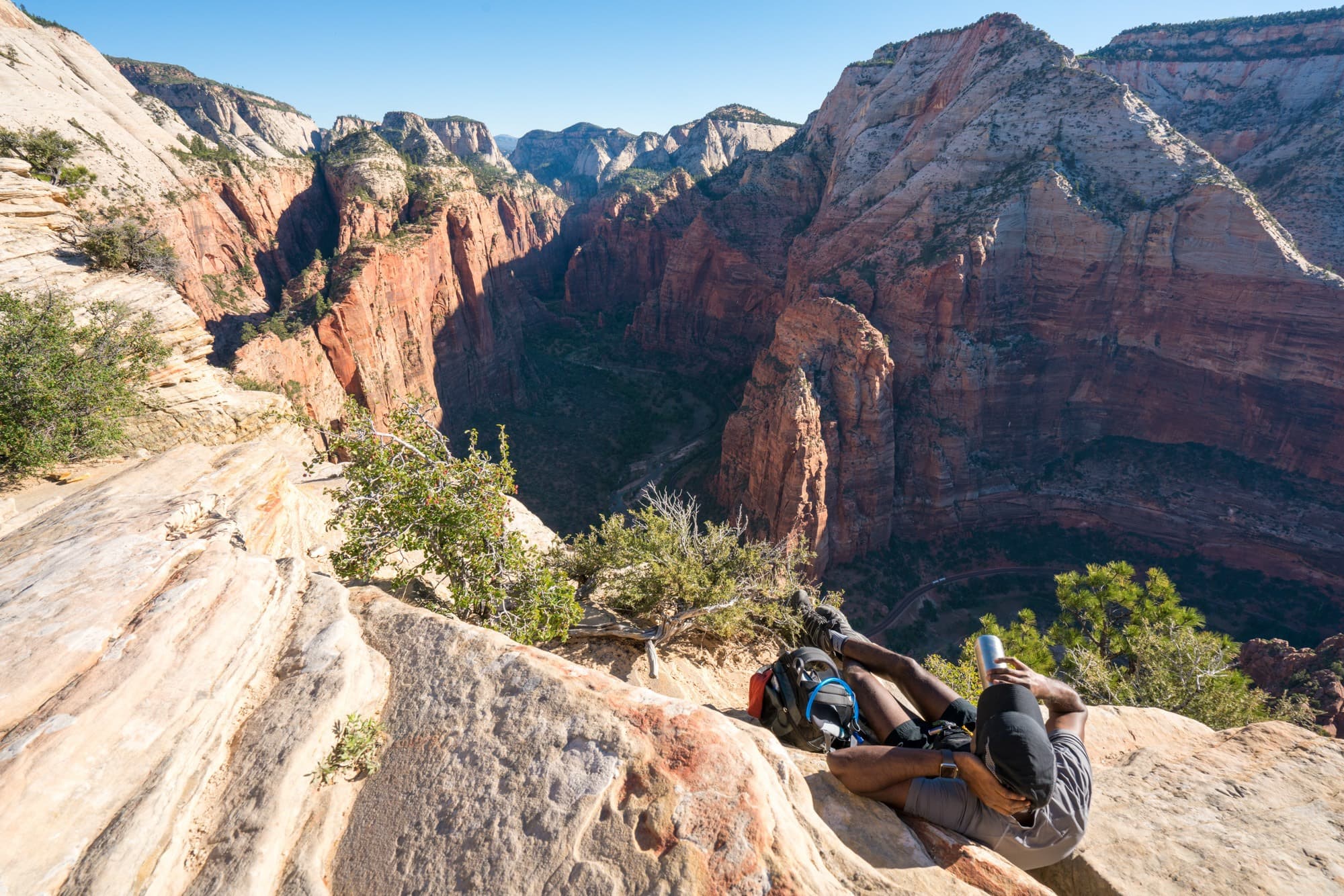
Day 2 – Explore the Narrows & Drive to Bryce Canyon
Day 2 overview.
- DRIVING DISTANCE – 72 miles from Zion
- DRIVE TIME – 1 hour 30 minutes
- CAMPING OPTION – Bryce Canyon Campgrounds
- LODGING OPTIONS – The Lodge at Bryce Canyon, hotels nearby
Spend your second day in Zion exploring The Narrows , one of the top highlights of Zion National Park, especially if you visit in the warmer months. The Narrows is a slot canyon that was formed over centuries from the Virgin River and is still continuously changing today.
This is a great hike to keep you cool since much of the hike requires wading through a river. If you want to hike the entire Narrows from the top-down as a long single-day hike or as an overnight, you’ll need a permit. Alternatively, if you want to explore at your leisure from the bottom-up, no permit is needed. Check out our Narrows hiking guide for more information.
Updated February 2024: There is a toxic cyanobacteria bloom in the Virgin River (where The Narrows is located) so you should not submerge your head or filter drinking water here. Check current updates for Zion National Park before heading out here .

Post-hike, pack up the car and head through the 1.1-mile Zion-Mt. Carmel Tunnel and continue driving towards Bryce Canyon National Park which is 1.5 hours away.
If you can get to Bryce by sunset we recommend heading straight to Sunset Point!
Have more time to spend in Zion?
If you are staying another day or you’ve previously visited Zion and done the things we’ve mentioned, I recommend trying to get a permit to hike The Subway or backpacking the West Rim Trail .
For The Subway top-down route, you’ll need some canyoneering skills, as it requires route finding, rappelling, and swimming skills. The bottom-up route, which leads to a series of beautiful turquoise pools, is non-technical. You will need a permit for both of them.
Check out our Zion Travel Guide for more things to do in the park.
Days 3-4: Bryce Canyon National Park
Days 3-4 overview.
- DRIVING DISTANCE – NA
- DRIVE TIME – NA
Prepare yourself for Bryce Canyon: it is like nothing you’ve ever seen before! Bryce Canyon is famous for its hoodoos – sandstone columns each uniquely shaped by erosion – and it has more hoodoos than anywhere else in the world.

Hike Fairyland Loop Trail
Whether you arrived in Bryce Canyon National Park last night for sunset at Sunset Point or you are arriving this morning we recommend you start the day by heading to the visitor’s center . The park has only one visitor’s center which features a must-see film showcasing Bryce in the winter.
Then skip the crowds and head for adventure on the Fairyland Loop Trail . This trail is an 8-mile route in the northern area of the park, away from the crowds that will guide you past incredible hoodoos and scenery similar to the more crowded Queen’s Trail. If you want to do a slightly shorter loop, the Peek-a-Boo Loop is a similarly spectacular 5-mile loop.

Sunset Point to Sunrise Point Trail
If you’re looking for a more relaxed visit, we recommend the wheelchair-accessible, paved 1-mile Sunset Point to Sunrise Point Trail. This is also the only trail in the park where leashed pets are allowed. Be prepared, though, as this paved path is often VERY crowded.
Navajo Trail
If you have the time and energy we recommend the Navajo Trail for a quick 1.3-mile walk. The trail begins at Sunset Point, goes down into the Bryce Amphitheater, and meanders alongside large Douglas Fir trees. You could also combine it with Queens Garden Trail for a 3-mile loop .
If Bryce Canyon’s Wall Street is on your list, you can climb it via the end of the Navajo Loop Trail.

Have more time to spend in Bryce?
There is no shortage of things to see and do in Bryce Canyon National Park. If you have more time to explore, head over to our post on the Best Things to do in Bryce Canyon for ideas on how to extend your visit.
You can also check out our top picks for the Best Hikes in Bryce Canyon National Park .
Bonus Option: Escalante National Monument
Day 4 alternative.
- DRIVING DISTANCE – 49 miles from Bryce
- DRIVE TIME – 55 minutes
- CAMPING OPTION – Escalante-Grand Staircase National Monument campgrounds or dispersed camping
- LODGING OPTIONS – Hotels in Escalante
If you’re completely captivated by Bryce Canyon you can always spend the day exploring more, but I recommend heading to Escalante National Monument for a visit.
While not a National Park, it is an incredible place to visit with amazing hikes and fewer crowds.
Escalante is also halfway to Capitol Reef – your next National Park – so it’s a great hiking pit stop. Make sure you drive UT-12 E vs. Johns Valley Road/UT-24 E so you pass the town of Escalante.
Hike Lower Calf Creek Falls
The 6.7-mile Lower Calf Creek Falls is one of our favorite (and easily accessible) hikes that is right off the highway. It ends at a beautiful waterfall where you can take a dip if you’re brave (the water is freezing!) or enjoy a picnic lunch.
If you have a high-clearance vehicle and an appetite for a little more adventure, head down Hole-In-The-Rock Road to Peekabo and Spooky Slot Canyon .
For other options and trail details, check out five of our favorite hikes in Escalante .
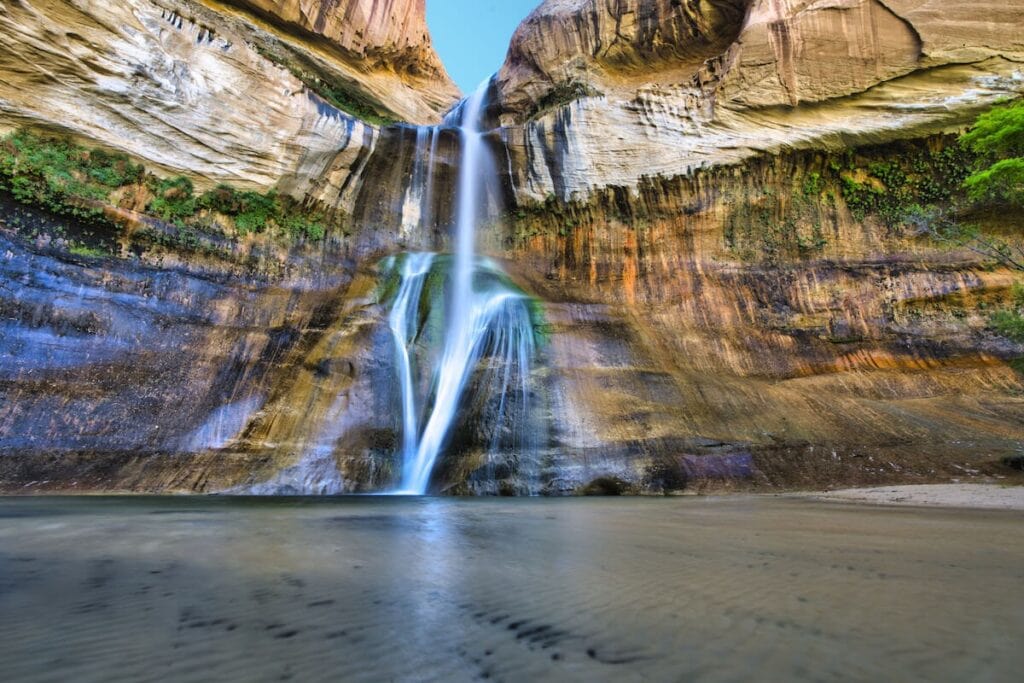
Day 5: Capitol Reef National Park
Day 5 overview.
- DRIVING DISTANCE – 112 miles (from Bryce), 57 miles (from Escalante)
- DRIVE TIME – 1.5 – 2 hours+
- CAMPING OPTION – Capitol Reef National Park campground or Moab camping if you want to continue your drive
- LODGING OPTIONS – Hotels in Torrey or hotels in Moab
Capitol Reef is known for its remote and sprawling backcountry. The park is set up nicely so you can easily drive through it while continuing on to Moab . If you have ample time to explore, there are numerous hikes in Capitol Reef that lead you through gorges and slot canyons to incredible viewpoints.
If you plan to camp in Capitol Reef be sure to pick up a free backcountry camping permit at the visitor’s center.

Drive through Capitol Reef National Park
Capitol Reef National Park has a paved scenic drive as well as two unpaved loops. There is a free online guide that includes information about the 11 stops along the paved drive. The scenic drives are especially nice if you are road-tripping during the hotter months or just want to drive through the park and sightsee from the car.
If you have a high-clearance vehicle, I highly recommend the dirt road drive to the Temple of the Sun and Moon if you have time (or do an overnight bikepacking trip through this remote area!).
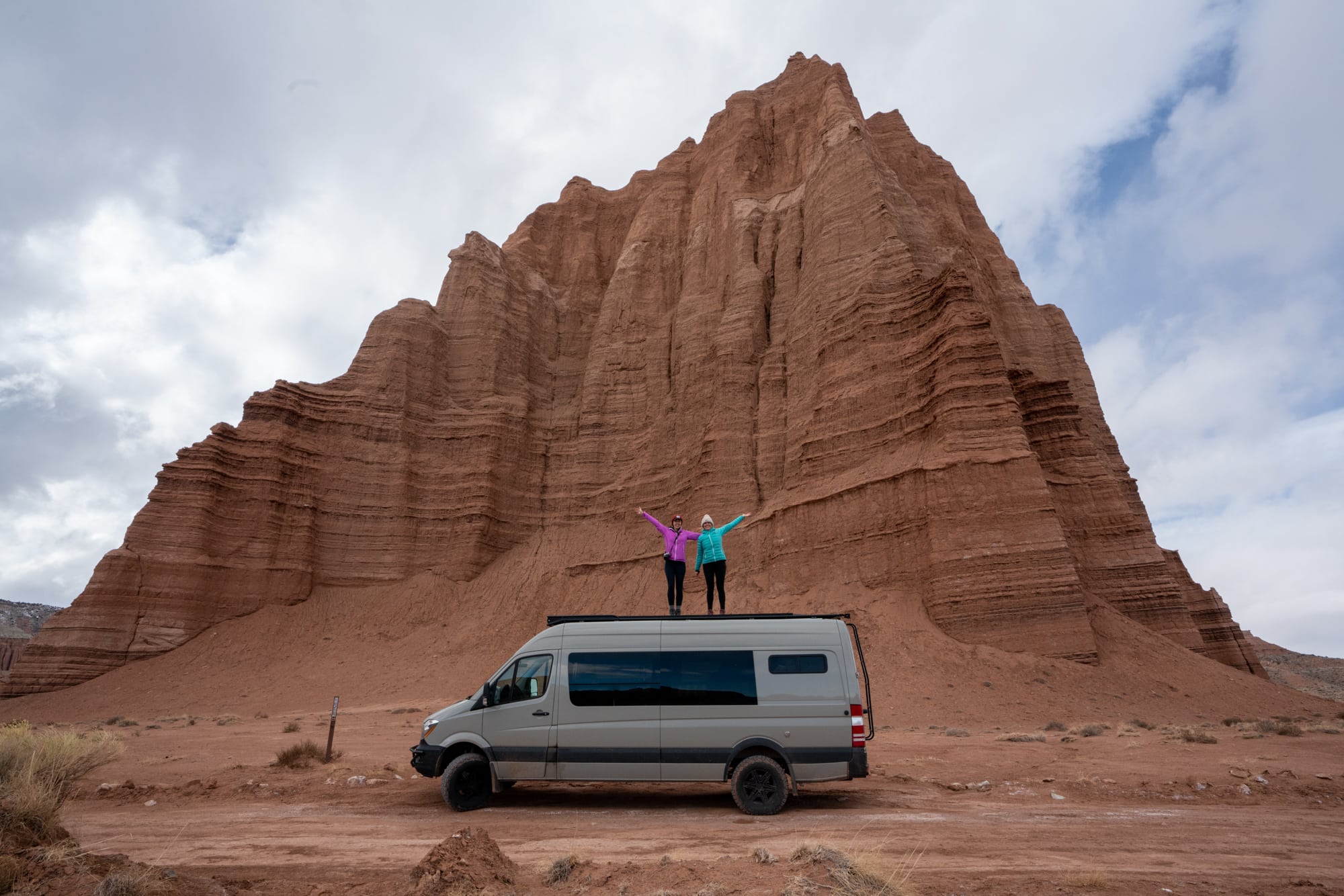
Hike to Hickman Bridge
To stretch your legs, hike the Hickman Bridge Trail (2-mile roundtrip) to a 133-foot natural bridge. This is a nice hike for cooling down as it runs along the Fremont River.
Have more time to spend in Capitol Reef?
If you decide to camp in Capitol Reef and are looking for a full-day hike, the Rim Overlook Trail to Navajo Knobs is a great 9+ mile route that offers 360 panoramic views of the Fruita and Waterpocket Fold area.
Another cool opportunity is to head out to Moonscape Overlook , which is about 40 minutes from Capitol Reef. It does require a high-clearance 4×4 vehicle to get out there, though.
Day 6: Drive to Arches National Park & Hike to the Arches
Day 6 overview.
- DRIVING DISTANCE – 132 miles from Capitol Reef
- DRIVE TIME – 2 hours
- CAMPING OPTION – Arches National Park
- LODGING OPTIONS – Hotels in Moab
Arches National Park is a beautiful and easy National Park to visit. The entrance to Arches is stunning as you’ll climb 1,000 feet and then descend into an almost “Mars-like” world. Navigation is easy also here. There is one visitor’s center right next to the only park entrance on the main park road.
Important Note: During peak season (usually April through October), visitors will need to obtain a timed entry reservation to visit Arches National Park between the hours of 7am-4pm. A limited number of next-day tickets will be available at 6pm the night before. Reservations cost $2 and you will still need a park pass or annual pass to enter.
Explore the Arches
There are some great hikes in Arches for all levels. If temperatures aren’t too hot and you have a full day, the hike to Landscape Arch & Devils Garden (7.8-mile loop) is a must.
If you arrive in the late afternoon, head straight to Delicate Arch (3 miles roundtrip) for a sunset hike you’ll never forget. Or, if this is your second visit to Arches or you’re looking for something off the beaten path, try to grab a permit to explore the Fiery Furnace .

Day 7 – Whitewater Rafting!
Day 7 overview.
- CAMPING OPTION – Arches National Park or Dead Horse State Park
Today, we recommend switching it up so you really get a sense of what southern Utah has to offer. Whitewater rafting on the Colorado River, which flows between Moab, UT and Arches National Park through deep red rock canyons, is an unforgettable and unique experience. Numerous rafting outfitters in town offer half-day, full-day, and multi-day rafting trips on the river.
If hopping on the water doesn’t sound exciting, and you’ve seen all of Arches that you’d like to experience, then head for Dead Horse State Park which is on the way to Canyonlands National Park. Dead Horse State Park even has yurts if you are looking to skip tent set-up for the evening.
Day 8: Canyonlands National Park
Day 8 overview.
- DRIVING DISTANCE – 30 miles from Arches
- DRIVE TIME – 35 minutes
- CAMPING OPTION – Canyonlands National Park
The last on the list of our Utah National Park road trip itinerary is Canyonlands National Park. Canyonlands was made famous by the movie 127 Hours, in which Aron Ralston becomes injured and survives in the backcountry for five days. It’s an extreme park, especially the remote area where Ralston was exploring, known as The Maze.
As you enter Canyonlands, you can drive around and check out the overlooks or you can pick a hike on our Best Hikes in Canyonlands National Park list.
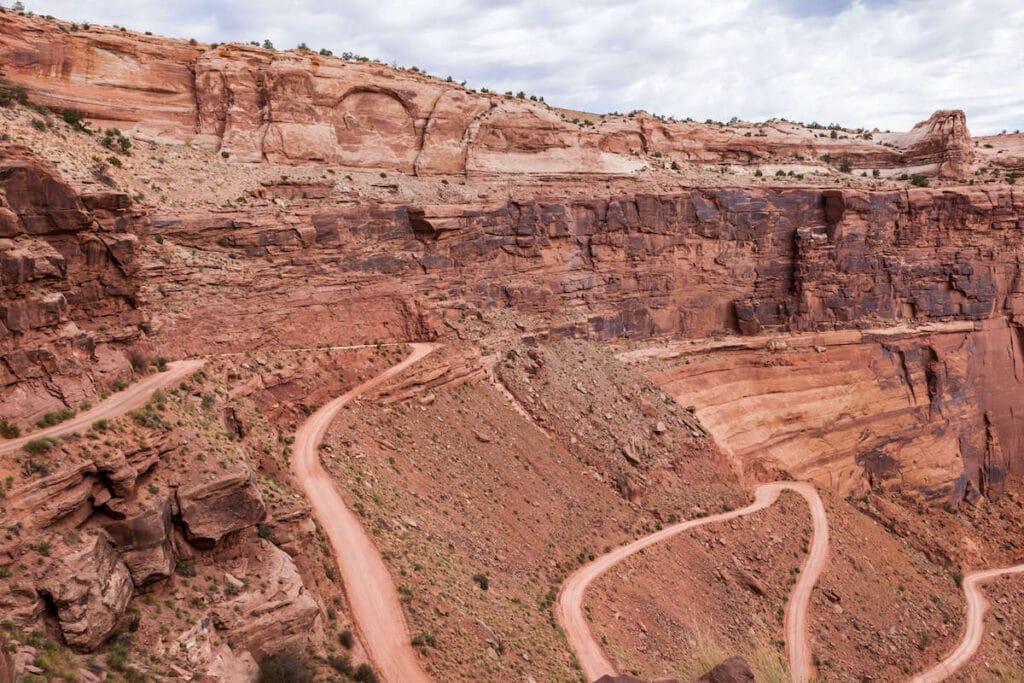
Canyonlands National Park is huge, so to help you get your bearings, here are the four main sections of the park:
- The Island in the Sky area is excellent for those looking for a day hike. Driving time is roughly 40 minutes from Moab. I recommend visiting Island in the Sky if you are short on time.
- The Maze area is very remote and isn’t easily accessible from Moab. Most people who visit the Maze are experienced in the backcountry and have excellent off-road driving skills. If you’re considering heading to the Maze area, I recommend reviewing information & trails on Canyonland National Park’s hiking website .
- The Needles area offers great overnight beginner backpacking options as well as a few short day hikes. The Needles area is about 40 miles south of Moab.
- The Colorado and Green Rivers , as well as numerous tributaries, are considered a separate 4th area of the park. Beginner and relaxed casual float trips through the canyon are available on either river, including Labyrinth Canyon . Downstream of The Confluence, where the Colorado and Green Rivers meet, there is whitewater for adventure seekers.
Both the Island in the Sky and Needles areas have Visitor Centers where you can learn more about what to do in these areas of Canyonlands National Park.
Hike the Island of the Sky area
When you leave Moab, head to the Island in the Sky area of Canyonlands. Peek in at the Visitor’s Center for your first stop and then head to the Grand View Point trailhead and hike to Grand View Point. It is an easy 2-mile walk along the canyon edge to the mesa with incredible panoramic views.
Afterward, challenge yourself on the Aztec Butte Trail, which includes a steep climb that takes you to ancestral Puebloan granaries.
Post-hike, pitch your tent and get ready for an incredible last evening of stargazing . Canyonlands National Park is an International Dark-Sky Park meaning its isolation from city lights makes conditions for viewing the night sky excellent.
This is true for all Utah National Parks, but there is no better way to spend your last Utah National Parks road trip evening than stargazing. During spring & fall, there are frequent stargazing events led by park rangers. Inquire at the visitor center for more information.

Day 9 – Mesa Arch and Return Home
Day 9 overview.
- DRIVING DISTANCE – 244 miles (to SLC), 468 miles (to Las Vegas)
- DRIVE TIME – 3 hours 45 minutes to 6.5 hours
Make the most of your final day! Wake up super early and make an early morning sunrise hike out to Mesa Arch (trust me, it’s worth it).
Then, it’s time to pack up and return home after (hopefully) an unforgettable Mighty 5 road trip!
Have more time to spend in Canyonlands?
lf you enjoy biking, plan ahead and bring mountain bikes for an awesome backcountry road exploration. My first overnight mountain biking experience was a supported trip in Canyonlands National Park on the White Rim Trail . Biking the White Rim Trail requires a permit and campsite reservations can be competitive, so you’ll need to plan ahead.
What to Pack for Your Utah National Parks Road Trip
Your packing list will vary depending on whether you plan to stay in hotels, you want to car camp, or even backpack through some of the parks .
However you decide to explore the Might 5, here are some packing lists to help you gear up for your adventure:
- Car Camping Packing Checklist
- Road Trip Essentials Packing Checklist
- 3 Day Backpacking Checklist
- What To Wear Hiking in the Desert
I also recommend picking up these two resources to help you navigate on your Utah National Parks road trip:
- Utah Benchmark Road and Recreation Atlas : A lot of areas in Southern Utah are void of cell service, so I recommend carrying a paper atlas on your road trip. This atlas shows all of the dirt roads and points of interest.
- Wow – Hiking Utah Canyon Country : This is an excellent hiking book that has helped me discover the best hikes in Southern Utah. Again, with gaps in cell service, a hiking book means you’ll be able to plan on the fly.

Want to explore outside the National Parks in Utah? Check out some of these adventures:
- Best Things to do in Kanab, Utah
- Plan an Overnight Float Through the Ruby-Horsethief Canyon
- Paria Canyon Backpacking Guide
- Packrafting the Escalante River
- Coyote Gulch Backpacking Guide
Save this post to Pinterest
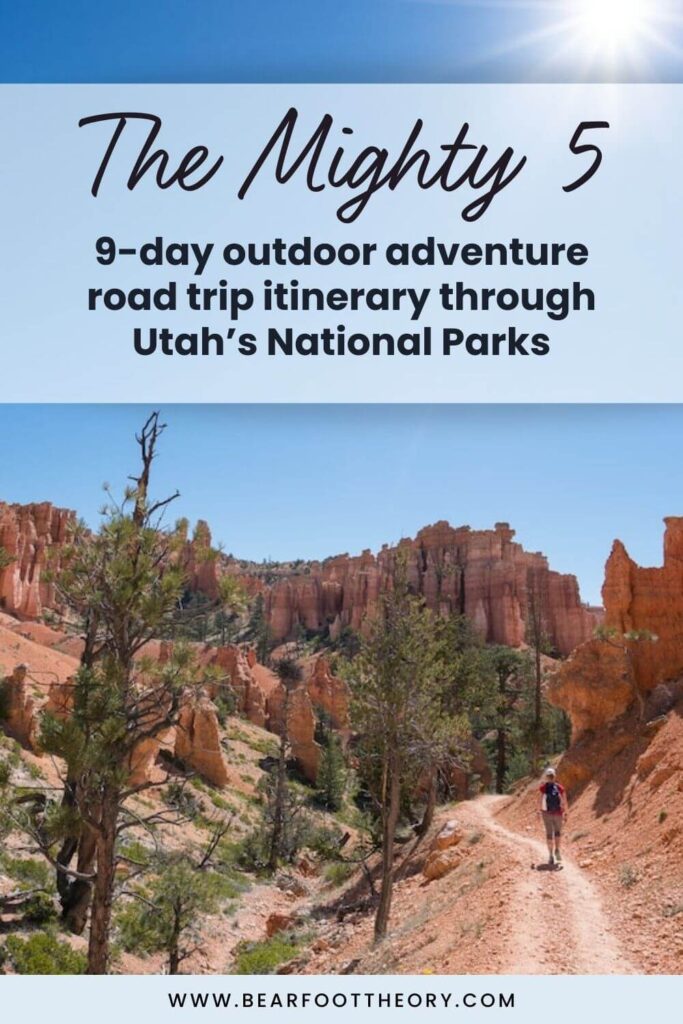
Have you done a Utah National Parks road trip? What are your favorite things to do and see in the Mighty 5? Share your experience in the comments below!

With two decades of hiking and seven years of van life under her belt, Kristen has dedicated her life to helping people experience the positive effects of nature. As a pioneer in the outdoor blogging space, she founded Bearfoot Theory in 2014 and has since authored more than 350 blog posts about outdoor travel, hiking, camping, and van life. Her work has been featured in National Geographic, Outside Magazine, and Backpacker, and when she’s not on the road, she lives in Park City, Utah with her partner Ryan, their son, and two adventure pups.
Leave a Reply Cancel reply
Your email address will not be published. Required fields are marked *
Save my name, email, and website in this browser for the next time I comment.
35 Comments
Great list! Zion and Canyonlands are my favorite, Zion for the hiking and climbing, Canyonlands for the far-reaching vistas and solitude. What dramatic scenery! Thanks for the info.
Great timing!! I am planning a trip for this spring and will be hiking in these areas. Thanks for the info and helping with the planning. You have a great site!
This is an absolutely great post. Thank you for including such information which can really help our beloved adventurers who wants to wander the wonders of Utah. Hiking and camping on any of these sites can be the best option too.
I actually did this trip almost exactly 4 years ago. It was the best thing I’ve ever done. The scenery and hiking are amazing. I suggest flying out of Grand Junction, CO airport, however. It is less than a 2 hour drive.
Thanks, Lynn! So neat to hear about your trip. Thanks for the rec! Hope you have some great upcoming adventures planned.
We just finished this trip plus Grand Canyon and Sedona (12 days)- unfortunately I just now came across this while dreaming of our next adventure! We traveled with two adventurous kids (age 10 and 12) so I’ll add what we enjoyed the most. Zion- swap out Angel’s Landing for a more kid friendly hike and we followed this. LOVED the Narrows (rented neoprene socks and shoes- very glad we did), and Observation Point. Bryce- we did a 3 hour horseback ride in the park- amazing! Capitol Reef- Cassidy Arch trail! It was incredible and you can walk out onto the arch- definitely the highlight of this park. Arches- Delicate Arch hike was awesome. The Windows area is a great stop to see 4 popular arches with little hiking. Canyonlands- we did both Island in the Sky and Needles (not in same day)- we’d skip Needles next time. Lots of great short hikes at Island though. We also stopped at Dead Horse. If we go again we’ll raft in Moab but instead we headed to Arizona for a few days. Did Page-GCNP-Sedona- flew out of Phoenix.
Suzanne, what time of year did you take this trip? BearFoot Theory – how are the crowds in midApril? Is Zion a park that should be done midweek and not on a weekend? Moab parks are they ok to do Jeep Week or will the crowds be unbearable? Thanks in advance! In early stages of planning.
I’m planning to visit in the Christmas this year! Going to keep all these things in mind while I travel. Thank you very much for sharing..:)
Hello, thanks a lot for a great blog! I am planning this trip for next year. When do you think is the best time to visit and, any suggestions for additional places to visit if we have about 3 week? Thanks Yana
Hi Yana, that is awesome to hear you are planning to visit the parks. The best time of year is late Spring or in the Fall. So I would plan for April/May or September/October. You will want to check the weather to make sure it isn’t too cold but try to avoid the crowded and busy summer season. You can easily add on the Grand Canyon to a Utah NP Roadtrip. Arizona also has the Wave and some other great hiking places.
Thanks so much for this post. It makes planning our Utah NP trip so much easier! We’re looking at visiting for 7-8 days at the beginning of March 2019. Any thoughts on what type of weather we can expect? I’ve looked at a bunch of weather websites, but first hand knowledge would be great. We’re hoping to camper van. Thanks so much for the helpful post.
Hey Sherry! We’re glad it helps! The beginning of March can still be pretty cold and potentially a little bit rainy. It’s hard to say this far out but global warming might be on your side to help it not be too cold. Definitely want to make sure you have plenty of layers, beanies and warm blankets if you’re going to camp.
Very well written, thanks for the info. Don’t Forget about Brian Head. Enjoy the off-road trails for ATVs and snow mobiles, Skiing, and much more. Don’t forget to rent a cabin while exploring Brain Head, Utah.
Absolutely AMAZING blog! Thank you to the beautiful Tara for sharing it with me! 😉 I have a question that I’m hoping you can answer! When it comes to hygiene, are there shower areas in any of the camping sites that you could see?
Hi Josh, thanks for dropping us a comment. I don’t recall necessarily seeing any shower areas in the camping sites BUT there are definitely shower facilities in the area. For example, in Zion there are NOT any showers but in Springdale, which is just outside of the park there are pay showers. You can do a simple search on Google for each park to find shower facilities that are nearby.
We have 10 days for a Utah adventure coming up in May. We fly in and out of Las Vegas. I’m considering pretty much your exact itinerary OR, simply exchanging Arches for several days on a houseboat on Lake Powell. What are your thoughts on that?
Hi Maureen, thanks for reaching out! Lake Powell and Arches are both equally incredible–could you split the time & do both? It really depends on what your interested are. You’re going to have an incredible trip no matter what–Utah in May can be absolutely lovely.
hi there,we`re planning our very first american roadtrip next year and this blog is a godsend!! Just amazing!! one question-are the views while you`re driving between the parks better when you start from a particular direction ( if we were to reverse the suggested intinerary and finish in zion )? Or is it good both ways? Thank you for any advice.P.
How exciting! I don’t think you can go wrong, the views all around are fabulous. Make sure to stop at the designated viewpoints to take it all in too. Enjoy your trip 🙂
This is beyond helpful! Thanks for the info. I was hoping to make the trip mid/end Feb and ring in a 40th birthday. Any thoughts on road conditions or accessibility? My map shows some minor route closures in winter. (Won’t be camping).
It really depends on the year and whether storms are passing through. Check the weather and forecast before you head out! That being said, Utah’s National Parks are beautiful in snow 🙂
I was going in circles trying to plan a family hiking trip to southern Utah until I found your advice. I plan to follow it precisely. Thank you so much for your guidance. The extra advise on lodgings and restaurants and driving times is terrific for someone is blindly trying to fit in all five national parks.
Glad you found it helpful, Elizabeth. Have a great trip!
Hi, I’m planning a trip to all of the Parks listed in September. I camped and hiked in all of them as a 20 year old. I want to go back, as a 67 year old! Physically, I’m in good shape but there will be a difference from 40 years ago. Any thoughts on trails. We hike hilly 5-8 mile trails now. We want to walk and take great pictures. Thoughts?
Many of the hikes we listed in this post are great for easy-to-moderate hiking. If you want more suggestions, we have detailed guides on many of the Utah National Parks with additional hiking options.
How crowded and how hot is it to visit all the National Parks in early June? We probably wouldn’t do much hiking- mainly explore with our car.
It really depends on which National Parks you plan on visiting. Most National Parks can get pretty busy during the summer months and temperatures fluctuate greatly depending on the location of the Park.
Thank you so much for all of this valuable information! We plan to pretty closely follow this itinerary this July. My 15 yo son really wants to be able to bike at some of the places. My husband, myself, and kids (ages 15 and 17) would like to do some (easy) mountain biking during the trip. Could you please offer some insight as to which parks we could do this at and perhaps places we could rent bikes? We will be traveling in an RV. Thank you!!!
Hi Amy – mountain biking isn’t allowed in National Parks, but Utah has great mountain biking outside the parks. Hurricane and St. George are popular areas outside Zion (Over The Edge Sports in Hurricane rents bikes) and Moab outside of Aches is also an amazing place to mountain bike with plenty of places for bike rentals.
I really like your itinerary. Do you think it is worth it to add Antelope Canyon? We are thinking of doing that as a loop back to Las Vegas instead of driving up to SLC.
Antelope Canyon is currently closed with no date for reopening as of now. If it does open before your trip, it’s definitely worth checking out.
Hello Kristen Great information! Very helpful! We hope to follow it almost exactly. We have two questions: One is about time in Zion and other is more delicate 🙂 First question: We plan to do Angel Trial, Narrows and Observation Point and then try to make Bryce sunset point to watch sunset. Question is should we plan on 3 days at Zion–a day each for the three things or can we do in 2 days — and leave for bryce. Second Question: We are in our early 70’s and sometime nature calls unexpectedly….are bathrooms frequent along the trials…??
Angels Landing should definitely be one day. Depending on how much time you spend at the Narrows (hiking from the bottom up), you could combine that with the 8-mile Observation Point hike. For bathrooms, there’s usually always a bathroom at the trailhead. There’s one near the top of Angel’s Landing as well.
Planning a trip much like you have here 9-10 days late April- early May. You mention crowds, how crowded is what you call crowded??? like a tourist trap town, dodging people every few steps? or is there room to move without running into someone and waiting for them to move so we can view what they are blocking?
Hi Dennis, it really depends on the park and what hike(s) you plan on doing. The most popular spots will likely be very crowded (lines to take photos at Delicate Arch, for example) but there are always areas where you can find fewer people and more solitude – especially if you go on weekdays or at sunrise. Also, something to keep in mind – Arches National Park is requiring timed entry permits starting April 2nd, which should help with overcrowding. I hope this helps & enjoy your trip!
Turn your travel photos into cherished memories with our Lightroom Presets!

Utah National Parks Road Trip Itinerary from Las Vegas
There may be some affiliate links on this page, which means when you click we get a small percentage of the purchase at no extra cost to you. This allows us to keep this page running. Enjoy!
Last Updated on April 11, 2024 by Sarah Puckett
Welcome to your bucket list guide on how to road trip Utah national parks. Stunning geological wonders, breathtaking vistas, and an unspoken connection with the forces of nature await on this one-week road trip itinerary through Utah’s Mighty Five National Parks.
In this blog post, we invite you to join us on a road trip through the remarkable Utah national parks. We’ll explore the must-visit destinations, share insider tips for maximizing your adventure, and offer insights into the rich history and geological significance that make these parks a true marvel of our world. So, buckle up, pack your hiking boots, and get ready to embark on a road trip that will take you deep into the heart of some of nature’s most extraordinary creations. Utah’s national parks are calling, and the road trip of a lifetime awaits – are you ready?
Follow the seven Leave No Trace principles: plan your hike in advance, stick to designated trails, carry out all your belongings, dispose of waste properly, leave natural areas untouched, minimize the impact of campfires, show consideration for fellow hikers, and avoid approaching or feeding wildlife.

Table of Contents
About our Experiences at Utah’s National Parks
My and Tim’s first trip to Utah was in 2013 when we spent a long weekend exploring Arches and Canyonlands National Parks in Moab. It took us over 7 years to get back to road-tripping Utah’s national parks (mostly because we were out of the country on our long international jaunts!). When we came back in the winter of 2021, we spent 6 weeks visiting all 5 Utah National Parks, diving deep into each. In 2022, we repeated the adventure, but this time stayed for 8 weeks. In 2023, we ended up spending FOUR MONTHS road-tripping the Southwest. We’ve spent countless days exploring Utah’s national parks, and are excited to share our expertise with you!
Utah National Parks Road Trip At-A-Glance
Day 1: arrive in las vegas and drive to springdale, ut, sunrise hike on the watchman trail.
- Pa’rus Trail
- Zion Human History Museum
Emerald Pools Trail
Weeping Rock Trail
- Option 1: Hiking Angel’s Landing
Option 2: Hiking the Narrows
Canyon Overlook Trail
- East Mesa Trailhead/Observation Point Trailhead
Red Canyon Arch
Scenic drive to bryce point, lower inspiration point.
- Navajo Loop and Queen’s Garden Trail
Sunrise Point for Sunset
Gifford homestead, scenic drive, petroglyphs panels, rim overlook trail to hickman bridge, factory butte, sunrise at mesa arch, grand view point, white rim overlook trailhead, sunset at dead horse point state park, sunrise hike to delicate arch, hike to sand dune arch and broken arch.
- Hike Devil’s Garden
Walk the Windows Trail
Hike to double arch, visit the park avenue viewpoint, day 8: return to the airport and fly home, utah national parks road trip map.

Want this map in an interactive format at your fingertips?
This meticulously crafted interactive Google Map showcases an extensive 7-day itinerary through Utah’s 5 national parks , featuring over 50 handpicked locations, along with detailed information about each site. With the Utah National Parks Explorer Map, your exploration becomes a curated and unforgettable experience, guiding you through the awe-inspiring landscapes of Arches, Bryce Canyon, Canyonlands, Capitol Reef, and Zion National Parks. Embark on your ultimate Utah adventure with confidence.
>>> Planning to visit more Utah National Parks? Buy the Utah National Parks Road Trip Map here ⬇

On Day 1 of your road trip to Utah’s Mighty Five National Parks, your main goal is just to arrive and drive to Springdale, Utah where you will be based for your explorations in Zion National Park!
In our experience, the Harry Reid International Airport in Las Vegas, Nevada has the best flight options both in terms of price and in terms of fewer connections. Once you get to Las Vegas, it’s about a 3 hour drive to Springdale, Utah, which is the most popular base for visiting Zion National Park.
Note: You can also fly into Salt Lake City and drive to Springdale instead. The drive from Salt Lake City International Airport to Springdale, Utah is 4.5 hours.
>> Search flights to Las Vegas for your Utah National Park Road Trip here.
Once at the airport, you’ll need to rent a car for your Utah National Parks road trip.
>> Search rental cars from Las Vegas here.
Wondering what kind of vehicle to rent for your road trip through Utah’s national parks? Here’s our take: while a 2-wheel-drive vehicle is completely sufficient for this road trip, if you are able to rent an all-wheel-drive or 4-wheel-drive vehicle, you will have more options for some offroading adventures and side quests down dirt roads. If you plan on spending at least 10 days road tripping Utah, we think that is a good option. If you are only visiting for 8 days like in this itinerary, two-wheel-drive will be just fine!
Where to Sleep in Springdale
- Driftwood Lodge
- Flanigan’s Resort and Spa
- AutoCamp Zion
- SpringHill Suites by Marriott Zion National Park
Where to Eat in Springdale
- Oscar’s Cafe : big portions and local favorite
- Camp Outpost : rotisserie and veggies served fast with a charming outdoor space
- Cafe Soleil : great sandwich choice and located right next to the park entrance
Day 1 At A Glance:
- Fly into Las Vegas or Salt Lake City
- Drive to Springdale, Utah

Day 2: Zion National Park
Zion national park entrance information.
Today you will be adventuring into Zion National Park! The park entrance fee is $35, but we recommend buying an America the Beautiful National Park Pass , which will save you money if you go to every park on this roadtrip through all five Utah National Parks.
>>> Buy your National Parks Pass from REI here
Save Money at National Parks
Get a National Parks Pass
Entry to all US national parks at no additional cost for 12 months

This itinerary allots for 2.5 days of exploring Zion National Park. Because of its size and the array of types of activities and hiking you can do here, I wanted to give you enough time to hike both the Narrows and Angels Landing (if you are able to get a permit – more info below). Even without an Angels Landing permit, there is still plenty to see and do in Zion.
Zion National Park Itinerary:
At a high level, here is what 2.5 days in Zion will look like:
- Day 2: Rent an e-bike or take the shuttle to explore Zion Canyon.
- Day 3:Take a short sunrise hike to the Watchman followed by a water hike adventure in the Narrows
- Day 4: Depart Zion NP via the Zion scenic drive and a spectacular sunrise hike on the Canyon Overlook trail.
Note: If you have a permit for Angels Landing, spend one day of this itinerary doing that. You can simply swap it out for any of the other days listed above. Or, if you’re the high energy type, add it to Day 2’s activities on this itinerary.
Getting Around Zion National Park
While you can drive your own vehicle on the Zion Scenic Byway and the Kolob Canyons regions of Zion National Park, private vehicles are NOT allowed in Zion Canyon itself during the shuttle season. The shuttle season, according to the National Park Service, is generally March through November and during the holiday season. So, if you plan on visiting Zion National Park most times of the year, you will need to plan for one of two options for getting around Zion Canyon: taking the shuttle, or renting an e-bike (electronic bike).
Zion Canyon Shuttle Option
The free Zion National Park shuttle is the most popular way to get around Zion Canyon. It makes multiple stops throughout the canyon and runs every few minutes.
The shuttle system consists of two main routes:
- Zion Canyon Shuttle: This route takes visitors along the Zion Canyon Scenic Drive, stopping at key trailheads, viewpoints, and attractions. It runs from the park’s south entrance through the main canyon to the Temple of Sinawava, where you can access the trailhead for The Narrows hike.
- Springdale Shuttle: This route connects various lodging properties and campgrounds in the town of Springdale to the Zion Canyon Visitor Center, providing visitors with convenient access to the park’s entrance and shuttle system.
Shuttles run frequently throughout the day, allowing visitors to hop on and off at different stops. The system operates from early morning until evening, accommodating both early birds and those who prefer to explore during the cooler hours of the day.
The shuttle system is designed to accommodate visitors with disabilities. Accessible shuttle buses equipped with ramps or lifts are available to ensure that everyone can enjoy the park’s attractions.
If you plan to use the shuttle system, park your vehicle in Springdale’s designated parking areas or at the Visitor’s Center in Zion Canyon (but note parking fills up quickly). Many accommodations in Springdale also offer shuttle service to the park entrance.
You can find more information about the Zion National Park shuttle here.

E-Bike Option
Our favorite way to explore Zion Canyon, and what I recommend for you, is renting an e-bike in Springdale and biking into Zion National Park. Because private vehicles are not allowed in the canyon, the only vehicles you have to worry about sharing the road with are the shuttles. Each trailhead has a bike rack you can lock your e-bike to, so you can thoroughly explore each stop the shuttle goes to, plus any other location you feel inspired to check out during your ride!
We rented e-bikes from Zion Adventures on our most recent trip to Zion National Park and it was the PERFECT way to spend the day.
Regardless of whether you e-bike or take the shuttle, here’s how we recommend spending your first day in Zion National Park and Zion Canyon.

Start your day with a sunrise hike at The Watchman . This is one of the only trails in Zion Canyon that doesn’t require using the park shuttle (or bike) to get to. The trailhead begins right by the parking lot at the Zion National Park Visitor Center.
The trail is slightly steep as it traverses up the canyon walls via gradual switchbacks. At the top of the trail, you will be awarded spectacular views over Zion Canyon, including the Watchman rock formation for which the trail is named.
The Watchman Trail
- 3.1 miles round trip
- 636 feet of elevation gain
- AllTrails Link

Pa’rus Trail
After your sunrise hike at the Watchman, grab a quick breakfast at Soleil Cafe or one of the other shops within walking distance of the Visitor’s Center. Then, either walk or bike the paved Pa’rus Trail. This trail provides a great overview of Zion’s unique landscapes.
It’s an incredibly pleasant trail, very flat, and provides awesome views of the red cliffs and Virgin River!
- 1.6 miles one way
- 134 feet of elevation gain
The Emerald Pools trail leads to a number of waterfalls, some seasonal, at the Upper and Lower Emerald Pools. This hike is VERY popular and as such tends to be quite crowded. Plan to arrive very early to avoid most crowds, and be considerate of your fellow hikers. When we went, it was absolutely packed, but seeing a 90-year-old woman making the trek and loving every minute made any annoyance about the crowds completely evaporate. Smile, make friends, and enjoy the stunning views!
The best time to see waterfalls flowing at Zion National Park is in the spring when snow melt increases water flow. We were lucky to see three flowing during our visit.
- 3 miles round trip
- 620 feet of elevation gain

After your hike to Emerald Pools, make your way to Weeping Rock trailhead. On the shuttle system, this is Stop 7: Weeping Rock .
The short path to Weeping Rock is one of our favorite spots in the park because you get to go behind the waterfall! Like the waterfalls at Emerald Pools, Weeping Rock has the most water in the springtime. The paved trail leading up to the waterfall is steep but short.
- 36 feet of elevation gain

After hiking the Weeping Rock Trail, either bike back to Springdale or take the shuttle back. Get a delicious dinner in town – we recommend Oscar’s Cafe – and stroll the shops in downtown Springdale. Then, return to your hotel for the night to rest up for another big day in Zion National Park tomorrow!
Day 3: Zion National Park
Today, you have options! How your second day in Zion National Park unfolds will depend on whether or not you are hiking Angels Landing.
Option 1: Hiking Angel’s Landing
Obtaining an angel’s landing hiking permit.
In order to hike Angel’s Landing, you need a permit issued in advance. You can obtain the permit (issued via online lottery) the day before you want to hike Angels Landing, or in a seasonal lottery ranging from 1-5 months in advance of when you want to hike.
You can find more information about obtaining a permit to hike Angels Landing here.
Sunrise Hike at Angel’s Landing
Assuming you have a permit for Angel’s Landing, start your hike as early as possible. The earliest shuttle departs from the Visitor’s Center at 6 am until September, and 7 am after that and before May. You’ll want to get off at Stop 6: The Grotto.
If you want an earlier start, plan to take a bike and lock it to the bike rack at the trailhead for Angel’s Landing.

The Angel’s Landing trail often wins the title of “scariest hike” among outdoor enthusiasts, because of the steep drop-offs on either side of you as you climb the chains portion of the hike. This is definitely not a hike I would recommend to those who are very afraid of heights, but if you take it slow and steady, this hike is not necessarily dangerous. With the permit system in place, the trail is also less crowded than it was in previous years. This is great news because some of the most unnerving experiences on the trail to Angel’s Landing occur when having to cross someone going the opposite way as you on the chains.

The views at the top are spectacular and worth the effort of tackling the over 20 switchbacks known as Walter’s Wiggles and conquering your fear of heights.

Angel’s Landing Trail
- 1827 feet of elevation gain

Temple of Sinawava
After hiking Angel’s Landing, take the shuttle or a bike to Stop 9: The Temple of Sinawava .
The Temple of Sinawava is where the popular Narrows hike starts, as well as the short and pleasant Riverside Walk trail. In spring, look for the ribbon waterfall on the cliffs!

Riverside Walk
If you have some energy left over from hiking Angel’s Landing, take a short stroll on the Riverside Walk. We especially recommend hiking the Riverside Walk if you don’t plan on hiking the Narrows, since you can still get a sense of what the canyon is like as it narrows around the Virgin River.

Riverside Walk Trail
- 193 feet of elevation gain
If you don’t have the permit or the desire to hike Angel’s Landing, we recommend hiking the Narrows. This bucket-list Zion National Park hike is famous for its unique trail, which has hikers literally wading through the Virgin River, sometimes in water up to chest high (but usually around knee height), between towering cliff walls that become increasingly narrow as you continue your hike.

Preparing for Hiking the Narrows
Gear up! It’s time to tackle a bucket list hike through the iconic slot canyon Narrows of the Virgin River. Hiking the Narrows requires walking in the water pretty much the entire time, so it’s important to rent gear from a local outfitter in Springdale if you don’t have your own dry suits/bibs/boots. You also need a walking stick to help you keep your balance in the water!
Here are some local shops we’ve used to rent gear in Zion National Park:
- Zion Adventure Company
- Zion Outfitter
Additionally, the Narrows frequently closes in springtime and the rainy season when water flow is too high for hikers to safely hike the Narrows. Sometimes the Narrows will be open, but with a high risk of deadly flash floods. Under no circumstances do we recommend hiking the Narrows when there is a risk of flash flooding or any rain in the forecast. If you are unsure if it’s safe on the day of your visit, ask a park ranger! You can also check for closures on the park’s official website here.
Don’t let this information scare you, though! The Narrows is a fun and safe hike in good weather conditions and with the right gear.

Hiking the Narrows Bottom-Up
The trailhead for the Narrows starts at the Temple of Sinawava for those hiking “bottom-up”. The “top-down” route through the Narrows is a canyoneering route, so be sure you know what you’re getting into if you choose that option! We hiked the Narrows Bottom Up, so that is what this blog post will focus on.
You will first hike the Riverside Walk all the way to the end. There, you run out of trail and there’s nothing else to do but start walking in the Virgin River.
Hike the Narrows as long as you wish. Depending on how high the water is, making it all the way to the end may not be feasible or fun. The good news is, you don’t have to hike all the way to experience the towering canyon walls surrounding you.
Once you are ready, turn back the way you came. Don’t forget to drop off your rental gear back in Springdale when you return!

The Narrows Bottom Up
- 8.9 miles round trip
Day 4: Zion National Park and Bryce National Park
On your last day in Zion National Park, I recommend hiking at least one more trail, this time on the Zion Scenic Byway on your way toward Bryce Canyon National Park. The drive on the byway itself is incredibly scenic, and since it is not located within Zion Canyon, you may drive your own vehicle versus having to take the shuttle. Be sure to check out of your accommodation this morning, as you will be moving to your next overnight stay today.
The Canyon Overlook Trail is one of our favorites because it’s short with a huge view at the end, making it an ideal choice for early mornings. I recommend timing your hike for sunrise! Plus, the parking area for this hike is fairly small so it helps to get in super early anyway.
Note that this trailhead is NOT in Zion Canyon, so the shuttle system does not run here. Instead, you should plan to self-drive your own vehicle.

- 187 feet of elevation gain
Bonus: East Mesa Trailhead/Observation Point Trailhead
After your sunrise hike, we recommend driving to the trailhead for the East Mesa/Observation Point trail. You’ll technically exit the park and re-enter for this one. This trail is very off-the-beaten-path and delivers amazing views of Zion Canyon at the end. It rivals the views at Angels Landing, in our opinion!
East Mesa/Observation Point Trail
- 702 feet of elevation gain
On your drive from Zion to Bryce Canyon National Park, don’t miss this awesome landmark along the way. You will actually get to drive through two rock arches on the road to Bryce. There’s a small pull-off area where you can stop for photo ops. Just be careful of vehicles and don’t hang out in the road!

Enter Bryce Canyon National Park
Welcome to Bryce Canyon National Park! The entrance fee to Bryce Canyon National Park is $35 per vehicle, or free if you have the America the Beautiful National Parks Pass.
Here’s how we recommend spending an afternoon and evening in the park as part of your Utah National Parks road trip from Las Vegas.
Drive the Bryce Canyon Road from the Visitor Center to Bryce Point. We recommend driving all the way to Bryce Point first and then stopping at each of the overlooks and viewpoints that will be along the right-hand side of your vehicle as you drive back towards the Visitor Center.
Stop here on your drive back in the direction of the Visitor Center for a view over Lower Inspiration Point and the Grand Staircase! It’s also worth the short walk on the Rim Trail to Upper Inspiration Point nearby.
Navajo Loop and Queen’s Garden Trail
The Navajo and Queens Garden Loop Trail is our favorite for seeing the highlights of Bryce Canyon National Park’s iconic orange hoodoos. It’s short and easy enough for families with kids, and makes the most of a short visit to the park!

Note that Bryce Canyon National Park sits between 8,000 and 9,000 feet of elevation above sea level, which means you will likely feel the impacts of the altitude. Symptoms most frequently include shortness of breath, headache, and fatigue. Drink a lot of water and take your hike slow and steady if you find you’re feeling altitude sickness! And don’t worry, your symptoms should recede as your body adjusts or when you descend back down to lower elevations.

- 649 feet of elevation gain
After your hike, catch the sunset at either Sunrise Point or Sunset Point. Both are near each other, just a short walk apart from the same parking lot and provide slightly different facing views and angles.
After sunset, drive to Escalante, Utah, and check into your accommodations for the night.

Additional Things to Do Near Bryce Canyon National Park
Kodachrome basin state park.
Kodachrome Basin State Park is worth a visit if you have extra time on your Utah National Park road trip. This is a great place to see more of the unique geology of the “Grand Staircase”, which refers to the way the landscape descends in a stairstep-like pattern over the hundreds of miles south from the top of the staircase here down to the Grand Canyon. Note that the entrance fee for Kodachrome Basin State Park is $10 per vehicle.

Devil’s Garden of Grand Staircase – Escalante National Monument
Another awesome and easy add-on to the portion of your Utah road trip between Bryce Canyon and Capitol Reef National Parks is the Devil’s Garden in Grand Staircase – Escalante National Monument.
No hiking is required to appreciate the beautiful and bizarre rock formations here, but you are free to explore the unique hoodoos and arches along the trails that meander through the “garden”.
Lower Calf Creek Falls
While not within any of Utah’s National Parks, Lower Calf Creek Falls is one of the best hikes we’ve done in the state. If you have 3 hours to spare, we recommend stopping here for the moderate 6-mile hike to a stunning waterfall deep in the canyon. You will also see petroglyphs on the cliff walls along the way! This hike is also part of the Grand Staircase – Escalante National Monument.
Note that there is a $5 parking fee for this hike.

Lower Calf Creek Falls Hike
- 531 feet of elevation gain
Where to Sleep in Escalante
- Escalante Yurts Luxury Glamping (where we stayed)
- Slot Canyons Inn Bed and Breakfast
- The Inn of Escalante
- Canyon Country Lodge
- Yonder Escalante Glamping

Where to Eat in Escalante
- Ranch Dog Kitchen
- Circle D Eatery
- Kiva Koffeehouse
- Hell’s Backbone Grill & Farm
Day 5: Capitol Reef National Park
With one full day in Capitol Reef National Park, we recommend visiting the Gifford Homestead, driving the Scenic Drive, hiking to Cassidy Arch and Hickman Bridge, and checking out the impressive petroglyphs. As with all of the other National Parks in Utah, Capitol Reef charges an entrance fee to visit. This fee is $20 per vehicle or you can use your National Parks Pass for free entry.
If you have extra time in the area as you make your way to Moab and your final two Utah National Parks, we recommend visiting Goblin Valley State Park as a bonus adventure!

Steeped in history, the Gifford Homestead is a well-preserved pioneer-era farmhouse that offers visitors a glimpse into the past. Built in the early 1900s, this historic homestead is now a charming country store and bakery. If you want to snag one of their coveted fruit pies, you should plan to arrive right when they open because they do run out!
Allow an hour and a half to visit all the stops along the 8 mile Scenic Drive , the highlights of which are described below.
Cassidy Arch Trail
The hike to Cassidy Arch is one of the most popular day hikes in Capitol Reef National Park. It’s only 3 miles roundtrip with a little over 600 feet of elevation gain, and your reward at the end of the hike is an impressive rock arch!
- 665 feet of elevation gain
Capitol Gorge Road
Our favorite part of the Scenic Drive drive is when you get to enter the narrow road in Capitol Gorge Spur Road. It’s like driving through a slot canyon, and is such a wild experience! Don’t do this drive in rainy conditions, however.
After the Scenic Drive and back on the main road through Capitol Reef National Park, be sure to stop at the Petroglyphs Panels for an impressive display of rock art from the Fremont culture. Please respect the petroglyphs by not touching or defacing the rock.

End your visit to Capitol Reef National Park with one last hike. The views along the Rim Overlook trail to Hickman Bridge are simply mind-blowing, and the natural rock arch at the end is impressive.

Hickman Bridge Trail
- 416 feet of elevation gain
While driving from Capitol Reef towards Moab, you can’t miss the tall towering butte on the left-hand side of the road. This rock formation is Factory Butte . Several dirt roads lead to closer vantage points, but this is just the tip of the iceberg for what this part of the Utah desert holds.
Continue your drive to Moab, Utah, where you will check into your accommodation for the next 3 nights.

If you have time: Goblin Valley State Park
Goblin Valley State Park looks oddly like it sounds – a rock valley with small, stumpy hoodoos that look a bit like, well, goblins! We love this state park for sunrise photography and just exploring the formations.
Enjoy the view from the viewing platform, or walk down the steps into the valley to explore amidst the hoodoos!
If you visit, please follow the principles of Leave No Trace and do not climb, carve, or otherwise break/damage any of the rocks.
Note that the Entrance Fee for Goblin Valley State Park is $20/vehicle.

Where to Sleep in Moab
- Sorrel River Ranch Resort and Spa
- Hoodoo Moab, Curio Collection by Hilton
- Radcliff Moab
- Sun Outdoors Moab Downtown
>>Read our review from our stay at Sorrel River Ranch Resort and Spa
Where to Eat in Moab
- Sabaku Sushi
- Quesadilla Mobilla
- Desert Bistro
Day 6: Canyonlands National Park
One day is plenty of time to see the main highlights of Canyonlands National Park. We recommend three short hikes, that each provide a different experience and perspective over the canyon. The Entrance Fee for Canyonlands National Park is $30 per vehicle, or free with your National Park Pass .
Start your Canyonlands National Park visit with sunrise at Mesa Arch. It will likely be crowded (yes, even at sunrise), but when the light’s rays hit the canyon below it will all be worth it. It is just a short walk from the parking area to Mesa Arch.

Mesa Arch Trail
- 98 feet of elevation gain
After sunrise, drive to Grand View Point and then walk the short trail to the Overlook. We absolutely cannot get over this view over the canyon because you can see a lot of the ridges and crevasses which highlight how dramatic this landscape is!

Grand View Point Overlook Trail
- 3 feet of elevation gain
For another short but highly rewarding hike in Canyonlands National Park , check out the White Rim Overlook trail. This trail provides a different view and perspective over the canyon that the others you have seen so far today.
White Rim Overlook Trail
- 160 feet of elevation gain
For sunset, visit Dead Horse Point State Park for one of Utah’s most iconic views.
The entrance fee is $20 per vehicle. Note that National Parks Passes do NOT work at Dead Horse Point State Park (or any other state park). State parks are not part of the National Park Service and are not covered by the America the Beautiful Pass.
>> Do you want to explore ALL of Utah’s National Parks? Check out our Utah National Park Itinerary and Map here!
Day 7: Arches National Park
With one day in Arches National Park , you can explore all of the best hiking trails to unique arch formations, and catch a bucket-list-worthy sunrise and sunset. Make sure you have a timed entry permit if you are visiting during peak season and if you plan to enter the park after 7 am. As of 2023, timed entry permits are not required for entering Arches National Park before 7 am. All visitors must pay the $30 per vehicle entrance fee OR have a National Park Pass.
Kick off your visit to Arches National Park with a hike to the iconic Delicate Arch! Sunrise here is worth the early wake-up call. Plus, if you enter the park before 7 am, you don’t need a timed-entry reservation. By hiking to Delicate Arch for sunrise , you can beat the crowds (a little bit) and avoid having to have a timed entry permit!
If sunrise isn’t an option for you, make your timed entry reservation here.

Delicate Arch Trail
- 629 feet elevation gain
After sunrise, drive back onto the Arches Scenic Drive and head to Sand Dune Arch trailhead. There are three arches you can see here, all on a short hike!
Broken Arch Trail
- 165 feet of elevation gain
Hike Devil’s Garden
Devil’s Garden is a very arch-dense area of the park where you can see several arches of various shapes and sizes! This is one of the best low-effort/high-reward hikes in the park because you can hike as far as you’d like all the way to Double O Arch, or explore the arches closer to the trailhead like Tunnel Arch or Pine Tree Arch.
Devil’s Garden Loop
- 1085 feet of elevation gain
The arches on Windows Trail are particularly photogenic and worth the short walk!

Windows Trail
- 154 feet of elevation gain
Your last arch hike in Arches National Park is to Double Arch. This impressive and unique two-banded arch is a must-see in the park.
Double Arch Trail
- 95 feet of elevation gain
Cap off your visit to Arches National Park with sunset at Park Avenue. Enjoy the view from the viewpoint, or hike down along the rock formations.
Park Avenue Trail
- 298 feet of elevation gain
On Day 8, head to the airport from which you will be returning home, whether it be Salt Lake City, Las Vegas, or Grand Junction. Driving times from Moab to each location’s airport are listed below.
- Grand Junction Regional Airport: 1 hour 40 minutes
- Salt Lake City International Airport: 3 hours 50 minutes
- Harry Reid International Airport – Las Vegas: 7 hours
How many days do you need to visit Utah’s Mighty 5?
We recommend no fewer than a week to visit all five of Utah’s National Parks. The itinerary outlined here is 8 days long, which is really the fastest you can still see quite a bit in each park. If you have more time, we recommend extending your trip to 10 days or more and taking advantage of some of the additional nearby hikes and state parks along this route and outlined in the Utah National Park road trip map !
When is the best time of the year for a Utah National Parks road trip?
The best time of the year to road trip to Utah national parks is late winter through early spring. Summer sees triple-digit temperatures throughout the state, as well as peak crowds at the more popular parks. We always time our road trips in Utah to be from January through April, as this is when the climate is most mild and visiting the parks is most pleasant. Additionally, late spring sees heavy snow melt and surging water in the Virgin River, which can lead to the Narrows closing. This is why late fall through winter is best for hiking the Narrows (just be sure you rent the appropriate winter gear). Lastly, nothing beats the contrast of white snow against the orange hoodoos of Bryce Canyon National Park.
What are the entrance fees for Utah’s national parks?
- Bryce Canyon: $35
- Capitol Reef: $20
- Arches: $30
- Canyonlands: $30
- Total for all 5 Utah National Parks: $150
- Save $70 by purchasing an annual National Parks Pass (America the Beautiful Pass) instead
What should you pack for a Utah National Parks road trip?
Check out our comprehensive road trip packing list below and sign up for our email newsletter to get a printable road trip packing list PDF straight to your inbox!

Stuck in a packing quandary?
Check out our ultimate Road Trip packing list!

Final Thoughts on How to Road Trip Utah National Parks
I hope this blog post outlining the perfect Utah National Parks road trip has you feeling excited, inspired, and prepared for the adventure of a lifetime!
If you’re exploring more of the US Southwest, don’t miss these blog posts!
- Best Things to Do in Capitol Reef National Park
- Guide to Cathedral Valley Scenic Drive
- Colorado Utah Road Trip Itinerary
- Unique Things to Do in Sedona
- Best Easy Hikes in Sedona
- Ultimate Guide to Hiking Havasupai Falls in 2023
- Guide to the Wave (North Coyote Buttes Arizona)
- Sedona Hiking Itinerary
Level Up Your Travel Photography
Get our Lightroom Presets
Transform your photos into cherished memories in just a few clicks!

Similar Posts

14 Best Sunset Spots in Moab, Utah + Map

Why Biking is the Best Way to See Zion National Park and How to Do It

Stewart Island Itinerary – New Zealand’s Other Island

How to Visit Factory Butte

18 Best Hikes in Arches National Park

Things to Do in Bozeman, Montana for Outdoor Lovers
Leave a reply cancel reply.
Your email address will not be published. Required fields are marked *
Save my name, email, and website in this browser for the next time I comment.
This site uses Akismet to reduce spam. Learn how your comment data is processed .
- Plan Your Trip
- Utah Itineraries
The Mighty 5: Ultimate Journey
10 Days • 1040 Miles
Grab a national parks annual pass for the best access to The Mighty 5®.
Ready for the journey of all journeys? This 10-day itinerary is the granddaddy of all itineraries. You’ll hit The Mighty 5® — every national park in Utah — as well as state parks, national monuments, Monument Valley and several stunning spots in between. You’ll find tranquil sunrises, fiery sunsets and unadulterated views of the Milky Way. You’ll gape at technicolor cliffs, massive arches and brilliant-hued hoodoos. You’ll discover wide-open spaces, tight slot canyons and vertiginous views. You’ll experience magical mountain biking, big time off-roading and monumental Jeep tours. You’ll explore ancient ruins, pioneer homesteads and slickrock labyrinths. You’ll wind through world-renowned scenic drives, thrilling rapids, and more world-renowned scenic drives. One day of this trip could set you up with enough adventure for a year. These 10 days will fill you with enough adventure for a lifetime. Are you ready to catch the first few rays of sunlight streaming through Mesa Arch in Canyonlands National Park? Or to gape at the sheer scale of the narrow walls that surround you as you wade through the river that carved them in Zion National Park? Get out there.
Start: Moab, about three and a half hours southeast of Salt Lake City by car. End: Zion National Park
Read these resources to learn how to travel thoughtfully and experience Utah most fully on your journey.
Consider taking pit stops along your journey. You need to refuel, eat, answer the call of nature, and stretch your legs anyway, so why not make them into mini-adventures ?
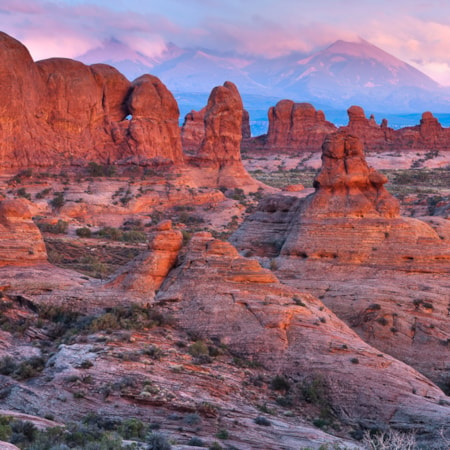
Moab to Arches
- Arches Scenic Drive
- Fiery Furnace
- Delicate Arch Hike
Adventure in Arches National Park where 300 million years of erosion has resulted in unbelievably dramatic landscapes that look like they were sculpted by giant mythological beings rather than the processes of time. Arches National Park contains about 2,000 windowed arches, towering spires, harrowing hoodoos and precarious pinnacles on display, including Delicate Arch, perhaps Utah's most iconic feature. A paved 36-mile scenic drive from the park entrance provides numerous parking areas for trail access and scenic overlooks. Tip: If you're planning to visit Arches between April and October, you'll need to reserve a timed entry ticket for access to the park. Visitors without a timed entry ticket may enter the park before 7 a.m. or after 4 p.m. Overnight in Devils Garden Campground or Moab . (Read: How to Visit Arches )
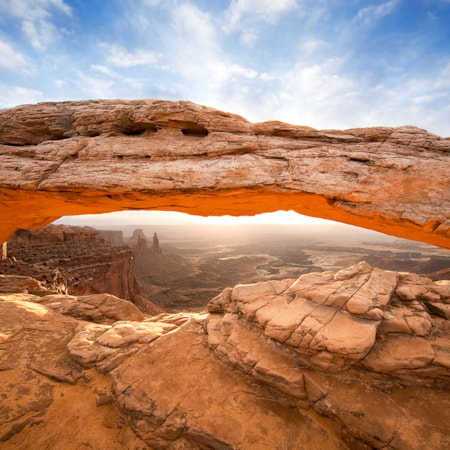
Moab to Canyonlands
- Grand View Point
- Dead Horse Point State Park
Imagine wave after wave of deep canyons, formed by the currents and tributaries of Utah's Green and Colorado rivers, divided with towering mesas, pinnacles, cliffs and spires, and spread out over tens of thousands of acres of some of the world's most breathtaking red rock country. Though Canyonlands National Park is made up of three distinct land districts, today focuses on the photogenic Island in the Sky and neighboring Dead Horse Point State Park. Camp in the parks or return to Moab.
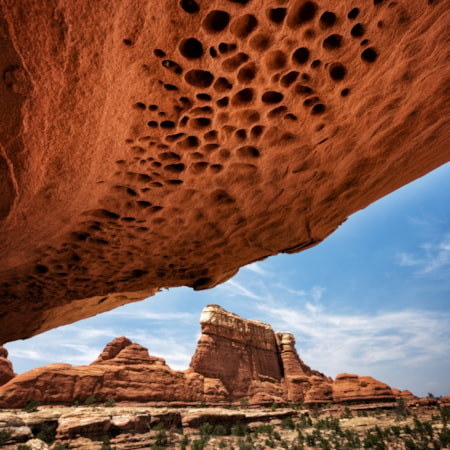
Canyonlands and the La Sal Loop
- White Rim Trail
- La Sal Loop Drive
- Grandstaff Hiking Trail
- Rafting in Utah
A solid hike up Grandstaff Trail will give your legs a good stretch before continuing along a scenic loop into the very mountains that Delicate Arch frames. There’s also access to the thrilling Porcupine Rim Trail from up here. For even bigger adventure, consider a 2-5 day rafting trip on the Colorado River to extend this trip to its logical extreme. (Don’t worry, there’s the popular Moab Daily stretch for just a taste of the Colorado.) Two or more days on the White Rim Trail is another great way to linger in Moab.
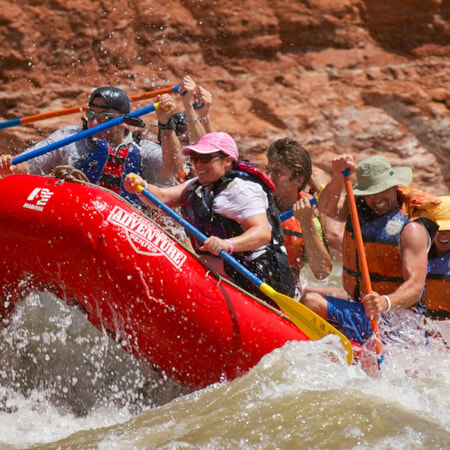
Adventure Epicenter
- Colorado White Water
- Hummer Tour
- Restaurants in Moab
Use this additional day in the Moab area to hit the rapids if you haven’t yet, pick up trails you may have missed in either of the national parks, or take an off-road tour with an experienced guide at the Sand Flats Recreation Area. Enjoy the legendary slickrock from the vantage point of an all-terrain vehicle in this off-road enthusiast's paradise. Save time for a relaxing meal in Moab to refresh yourself for the second half of this Ultimate Journey.
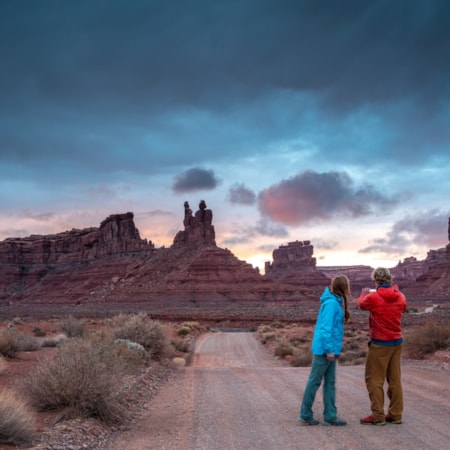
Moab to Monument Valley
- Newspaper Rock
- Bluff Fort Historic Site
- Goulding's Lodge
The large petroglyph panel of Newspaper Rock is on the scenic road to the the Needles District of Canyonlands. It’s worth an early start to sneak in a hike here, but be warned: You may not want to leave so soon. Except what awaits is Monument Valley Navajo Tribal Park, an iconic symbol of the American West and the sacred heart of the Navajo Nation. The rugged landscapes are infused with ancestral spirits, yet they are hauntingly familiar thanks to Hollywood's long love affair with this land. Tour Edge of the Cedars State Park and Bluff Fort along the way. Overnight in Monument Valley.
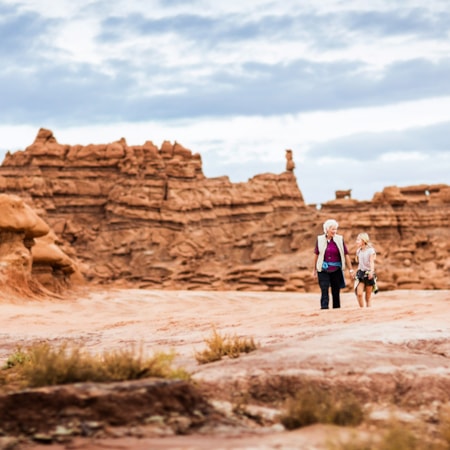
Monument Valley to Goblin Valley
- Monument Valley Jeep Tour
- Natural Bridges National Monument
- Goblin Valley State Park
While Goulding Film and Cultural History Museum at Goulding's Lodge provides a great introduction to the area, guided jeep tours and hikes will get you up close and personal with Monument Valley's incredible landforms. Next, head north on S.R. 261 up the switchbacks of the Moki Dugway and across Cedar Mesa for a stop at Natural Bridges National Monument. You may only have time for the scenic overlooks if you lingered in Monument Valley. Continue to Goblin Valley State Park where you can overnight in a yurt or grab a room in Hanksville or Torrey .
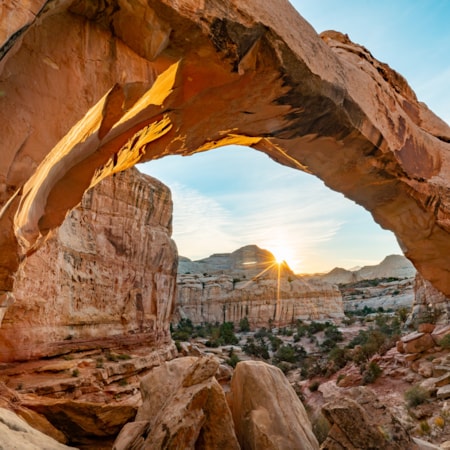
Capitol Reef Country
- Things to Do in Capitol Reef
- Gifford Homestead
- Hickman Bridge + Navajo Knobs
The contrast of red Entrada and white Navajo sandstones and the magnificent warp in the crust of the Earth create surreal landscapes unlike any you have seen. Capitol Reef National Park splashes color for 100 miles through an inviting wilderness of sandstone formations, rock art petroglyphs telling the story of the early indigenous people of the Fremont Culture, and the large fruit orchards of Fruita, an early pioneer settlement. With a high-clearance vehicle, you can explore the backcountry, but there’s also plenty to see and miles of unique trails in the front country along S.R. 24 and the Capitol Reef Scenic Drive. Overnight in Torrey .
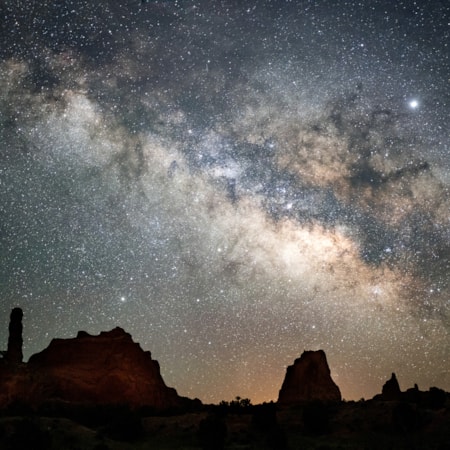
Torrey to Kodachrome Basin
- Lower Calf Creek Falls
- Anasazi State Park Museum
- Kodachrome Basin State Park
- Escalante Petrified Forest State Park
Utah's All-American Road Scenic Byway 12 is a spectacular experience by itself, and this itinerary gives you breathing room to slow down and experience a little more of what this stunning route through Grand Staircase–Escalante National Monument has to offer. Boulder, Utah, is home to the renowned Hell’s Backbone Grill and the starting point of the Burr Trail Scenic Backway. Consider stops at Anasazi, Escalante Petrified Forest and Kodachrome Basin state parks, and definitely plan time for the hike to Lower Calf Creek Falls. Charming towns dot the highway for overnight options or land at Bryce Canyon for the night. (Read: Dining Between the Mighty 5 )
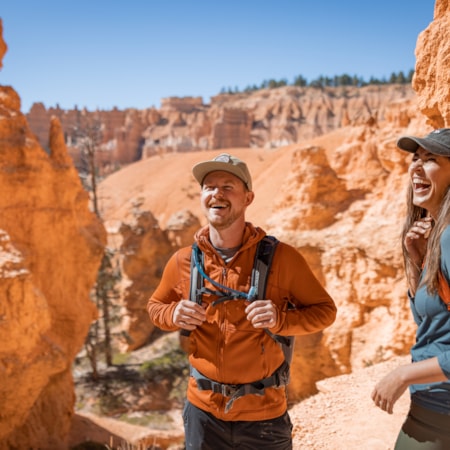
Bryce Canyon
- Queens Garden to Navajo Trail
- Bryce Canyon Lodge
- Dark Skies of Bryce Canyon
Bryce Canyon National Park is a series of natural amphitheaters sunk into pink cliffs and filled with delicate red rock "hoodoos." The most brilliant hues of the park come alive with the rising and setting of the sun. Summertime offers a myriad of walking and hiking trails and a 37-mile scenic drive overlooking incredible vistas (with a summer shuttle option to avoid driving in traffic). Historic Bryce Canyon Lodge’s location within the park means great access to the sites, hikes and starry skies of the park. Overnight in the lodge or Bryce Canyon City.
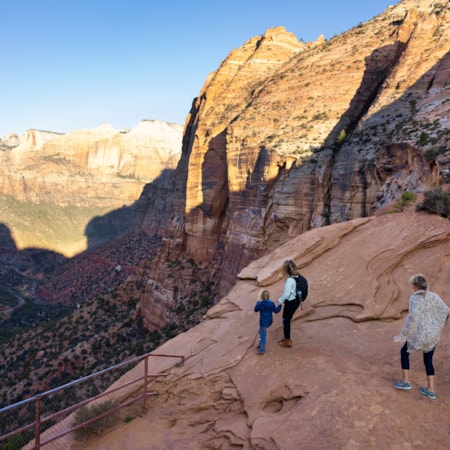
Bryce Canyon to Zion
- Zion-Mt. Carmel Drive and Hikes
- Angels Landing
- The Narrows
Zion translates to "The Promised Land," and for you that means some of the most spectacular hiking of your lifetime and impossibly beautiful landscapes you will never forget. Carved by water and time beyond the stretch of the imagination, Zion National Park is a canyon that invites you to participate in the very forces that created it. Park at the visitor center and take the multi-passenger shuttle through the canyon to as many stops as you have time and energy to enjoy. One day will give you a taste of Zion. But if you have some extra time, add an another day or two to explore additional hikes , the surrounding Springdale community, or even venture north to Zion's Kolob Canyons .
Well-prepared travel is responsible travel.
Do your part by planning ahead

- Destinations
Wild Junket

Utah Road Trip: A 2-Week Utah National Parks Itinerary
Last Updated on March 7, 2024
Dreaming of the perfect Utah road trip? Check out this epic 2-week Utah itinerary from national parks expert, James Ian from Parks Collecting .
Welcome to the most rugged state in USA! From red-rock mesas to skinny slot canyons, powder-bound slopes and slick rock trails, Utah’s diverse terrain will stun you. Utah is best known for the “Big Five”: five spectacular national parks including Arches, Canyonland and the famous Zion National Park . Throw in the legendary Monument Valley , the iconic Antelope Canyon and the adventure capital of America, Moab — a road trip to Utah promises plenty of adventure and outdoor adrenaline.
As a national parks expert, I’ve compiled a perfect Utah road trip itinerary that packs in all of my favorite national parks. Join me as I show you the best hangouts in Salt Lake City, awesome hiking trails in Moab, awesome viewpoints in monument Valley, and scenic drives in Bryce Canyon and Capitol Reef .

Table of Contents
- How to Get to Utah
How to Get Around Utah
Best time to go on an utah road trip, wander around temple square, visit the capitol hill, where to stay in salt lake city, visit dead horse state park, try an adventure activity.
- Where to Stay in Moab
Stop at Park Avenue
Hike the windows section, do the fiery furnace hike, explore the devil’s garden, catch sunset at the delicate arch, visit the island in the sky, hike the needles, drive the valley of the gods road, monument valley instagram moment, see a panoramic view of the monument valley, hike the monument valley wildcat trail, where to stay in monument valley, do the monument valley scenic drive, visit the navajo national monument, where to stay in page, see the horseshoe bend at sunset, hike the narrows, where to stay in springdale, hike angel’s landing, observation point , do the bryce canyon scenic drive, hike the rim trail, walk the queen’s garden loop trail, where to stay at bryce canyon national park, fruita scenic drive, where to stay in capitol reef national park, visit the temples of the sun and moon, utah itinerary day 14: salt lake city, enjoy your utah road trip, utah road trip guide.
How to Get to Utah
This Utah road trip itinerary starts and ends in Salt Lake City, the biggest city in Utah. Most major airlines fly to Salt Lake City Airport (SLC), including American Airlines and United. You can find cheap flights from New York to Salt Lake City for just $110 each way, and from Los Angeles to Salt Lake City for only $59 each way.
For those flying to Utah from Europe, you can get pretty good deals from London to Salt Lake City for around $650 return with a stopover in San Francisco.
Search for Flights to Salt Lake City

Utah is a road tripper’s dream. In order to drive on some of the dirt roads on this itinerary, it’s best to get a high clearance vehicle, preferably a 4WD.
A 2-week car rental in Utah costs around US$420 which equates to $30/day (with pick-up and drop-off at the Salt Lake City Airport). I always book my car rental on Discover Cars as they’ve consistently given me the best rates and customer service.
Nevada and Arizona are so close to Utah that you can easily extend your road trip as long as you have a car. Check out our recommended Nevada road trip itinerary .

The best time to travel Utah is during the spring (March-May) or fall (September-November) . Late spring offers moderate temperatures in Utah with gorgeous weather for traveling in the rest of the state. It’s also a great time as you avoid the summer crowds.
Utah has pretty warm temperatures in summer. The average summer temperature in Salt Lake City is around 68 to 89°F (20 to 32°C). Winters can be snowy and cold. The average winter temperature is around 26 to 39°F (-3 to 4°C).

Utah Road Trip Itinerary
Utah itinerary days 1-2: explore salt lake city.
This Utah road trip will start in Salt Lake City. Take the first two days to relax and explore the city at a leisurely pace before heading out into the backcountry. Many people often underestimate the amount of things to do in Salt Lake City. It’s got plenty of history, great restaurants, entertainment & the arts, and scenic drives.
One of the most iconic landmark in Salt Lake City is to visit beautiful Temple Square, home to one of the oldest temples in church history. There are free tours of temple square daily, or, if you aren’t interested in an organized tour it’s an absolutely beautiful place to walk around and enjoy the grounds year round.

Take a tour of the Utah State Capitol Building, the beautiful house of government for the state of Utah. Built between 1912 and 1916, this Corinthian style building sits atop one of my favorite neighborhoods in Salt Lake City, Capitol Hill. You can walk the capitol grounds or better yet schedule a free tour, Monday thru Friday.
Nearby is the Pioneer Memorial Museum, which houses the world’s largest collection of artifacts on one subject. Admission is free of charge and the museum is opened Monday through Saturday.

Budget: Comfort Inn Downtown Salt Lake City
This Comfort Inn has a great downtown location, comfortable rooms and indoor hot tub. Affordable prices and updated amenities. Check rates here.
Mid Range: The Little America Hotel Salt Lake City
A short five-minute drive to Temple Square, this mid range hotel has an indoor and outdoor swimming pool, and onsite shops, spa and restaurant. Check rates here.
Luxury: Kimpton Hotel Monaco Salt Lake City
A great accommodation choice in Salt Lake City is this chic, five-star hotel (pictured) just a ten-minute walk from Temple Square. Check rates here.

Utah Itinerary Day 3: Drive to Moab
This is the longest driving day you will have. The drive to Moab covers around 285-mile (450km) and takes around 5 hours.
If you leave Salt Lake City early in the morning, you should get to Moab around lunch time. Check into your hotel — I recommend staying here for the next couple of days and do day trips to the nearby national parks. The town of Moab is a small desert city, but it’s a gateway to spectacular red rock formations.
If your main focus is to see the incredible nature in Utah, head to Dead Horse State Park . The view from Dead Horse Point is one of the most photographed scenic vistas in the world. Towering 2,000 feet above the Colorado River, the overlook provides a breathtaking panorama of Canyonlands’ sculpted pinnacles and buttes.
The park is a 45-minute drive from Moab. It costs $20 per vehicle to enter. From the park’s Visitor Center, you can drive or hike to Dead Horse Point Overlook.

Moab is the self-titled adventure capital of the world. Some of the most famous and thrilling mountain bike trails in the country are around Moab, including the truly epic Slick Rock Trail . If you prefer four wheels to two, there are also plenty of mind-blowing trails for off-roading. Book this 4×4 adventure at Hell’s Revenge !
If you seek a more vertical thrill, try your hand at rock climbing or rappelling/ canyoneering. Expert climbers and canyoners travel from all over America to conquer the hills and canyons around Moab – but there are also rock climbing experiences for beginners too!

Where to Stay in Moab
Budget: The Hotel Moab Downtown
With a great location in the heart of Moab, this budget hotel offers good value for money with spacious rooms, an outdoor seasonal pool and cable TV. Check rates here.
Mid Range: Moab Springs Ranch
For a few more $ per night, stay at this ranch with charming rustic cabins, a lovely garden with barbecue facilities and its own restaurant. Check rates here.
Luxury: Hoodoo Moab, Curio Collection By Hilton
With an outdoor swimming pool, bar, restaurant and king-sized beds, this luxury hotel (pictured) not only has the best amenities in town, but it’s also got a location that’s hard to beat. Check rates here.

Utah Itinerary Day 4: Day Trip to Arches National Park
Next day, do a day trip to the first of Utah’s Big Five national parks. Arches National Park is home to over 2,000 natural arches and hundreds of soaring pinnacles, massive rock fins, and giant balanced rocks. This red-rock wonderland will amaze you with its formations, refresh you with its trails, and inspire you with its sunsets.
The entrance to Arches National Park is just 5 miles (8km) from downtown Moab. There is only one road in and out of the park, so get an early start and beat the crowds.
The first stop along Arches Scenic Drive is a small canyon called Park Avenue . From the first parking lot, there is a scenic overlook. If you are up for a short hike, you can hike down into the canyon and walk along a trail with the towering walls on both sides. You will soon realize why the area was named after the skyscrapers of New York’s Park Avenue.

In the Windows Section of the national park, there are two easy hikes with huge payoffs. In one direction, a short 1.2-mile loop trail takes you to North and South Windows, and the nearby Turret Arch. Climb up to the bottom of North Window for views through the arch.
In the other direction, a 0.5-mile roundtrip trail takes you to the spectacular Double Arch. Not one, but two, huge arches interlock in an amazing natural display. Be sure to look up and through the arches.

The Fiery Furnace area of Arches National Park can only be visited with a special backcountry permit or on an organized ranger-led tour, which is not scheduled for 2021. You will need to squeeze through narrow cracks, leap over deep crevices and shimmy your way over large rocks. Along the way, you will see Skull Arch and narrow passageways and fins that few visitors to the park get to see.
This section of the park is at the far end of the road. If you visit all of the other areas in the park, you will probably only have time for the first section of this trail, the easy paved path to Landscape Arch . This is the largest single span arch in North America!
The full Devil’s Garden Trail takes about six hours. If you are up for a longer and truly amazing hike, head straight here and skip some of the other parts of the park. You will see eight arches, including the breathtaking Double O Arch.

The most famous arch in the national park adorns the state’s license plate. The beautiful 52-foot-tall free-standing arch is reached at the end of a three-mile round trip hike. Time your trip for sunset, when the arch glows golden in the last rays of sunshine. Bring a headlamp or flashlight for each hiker to return in the dark. (Cellphone light is not enough.)

Utah Itinerary Day 5: Day Trip to Canyonlands National Park
Day 5 brings you on another day trip to second national park on your Utah road trip. Canyonlands National Park has three distinct sections, which are not interconnected. Two of them are close to Moab, so you can choose which section you’d like to visit.
The Island in the Sky region of Canyonlands National Park is the easiest to visit. It’s just a 40-minute drive north of Moab. The main feature is the Island in the Sky mesa. You can see the main highlights along the paved drive around the top of the mesa. There are plenty of places to pull over and enjoy scenic views of the surrounding canyons.

This part of Canyonlands National Park is named after the thin natural rock spires that look like needles. There are several canyons in this section that you can either hike or drive through.
A ten-mile hike takes you to Confluence Overlook , where there are views of the Colorado River and Green River as they join together. As an alternative, an eleven-mile hike takes you to the Chesler Park Viewpoint , with amazing views of the needles.
If you have a 4WD drive vehicle, this is a great place for off-road adventures. Elephant Hill and Horse Canyon are more advanced trails that require some off-roading experience. For an easier road, try the Colorado Overlook Road. You can hike the last 1.5 miles to the overlook.

Utah Itinerary Day 6: Drive to Monument Valley
Check out of your hotel in Moab and prepare for the highlight of this Utah road trip. The 162-mile drive to Monument Valley takes about 3 hours, but you will break your trip with a scenic drive through the Valley of the Gods.
This 17-mile scenic drive near Mexican Hat is much less visited than Monument Valley, but totally worth it. The dirt road loops through a wide valley with sandstone spires, buttes and mesas. Allow at least a couple of hours to drive the Valley of the Gods road , as you will stop frequently for photos.

If there is one photo you need to take of Monument Valley, it is the classic shot of a long straight road stretching to famous shapes of Monument Valley in the background. Approaching from the north as you do on this road trip, you will see this view very clearly.
There will probably be several other vehicles pulled up on the side of the road as people take photos. The best photos are near the top of the hill , as you get more of the road in your shot that way. If you want to pose in the middle of the road, watch out for oncoming traffic!
Monument Valley straddles the border between Utah and Arizona. The valley is part of the Navajo nation and is officially called Monument Valley Navajo Tribal Park. The entrance fee is $20 per vehicle or $10 per person (children under 10 are free).
Stop and enjoy the panoramic view of Monument Valley at The View , a complex with a hotel, restaurants, visitor center, cabins and campground. This is a good spot to freshen up and have lunch.
The only hiking trail in Monument Valley that you can do without a Navajo guide is the Wildcat Trail . The trail starts near The View campground. The 3.6-mile trail loops around the West Mitten butte. Best done in the late afternoon, when the entire valley glows with the last rays of sun.

Budget: Wetherill Inn
The best budget option is the Wetherill Inn in Kayenta, just a 40-minute drive from Monument Valley. It has an indoor heated swimming pool and includes continental breakfast. Check rates here.
Mid Range: Goulding’s Lodge
Goulding’s is a comfortable 3-star lodge just outside the Tribal Park, with views of Monument Valley in the distance. It’s a short drive to Monument Valley. Check rates here.
Luxury: The View
The best place to stay in Monument Valley is The View (pictured), since it is perched on the edge of the valley with breathtaking views from some of the rooms. I’ve stayed here several times and loved it! Check rates here.

Utah Itinerary Day 7: Head to Page
This day of the Utah road trip dips into northern Arizona – but is a worthwhile addition to your Utah trip. Stay two nights in Page and do a daytrip from there the next day. If you have some extra time, I recommend extending your trip with this Arizona itinerary.
The main part of Monument Valley can be visited on self-guided scenic drive. The 17-mile dirt road loops around the most famous buttes, including Merrick Butte, the Three Sisters, Elephant Butte, Totem Pole, and Artist’s Point.
A popular highlight is John Wayne’s Point. Here, you can pose on a horse while gazing out from a cliff top, with Monument Valley spread out behind you. The cliff is not tall and the horse doesn’t move, but no one will know that when they see your photos!

After lunch, hop back in your car and hit the road again. An hour’s drive from Monument Valley is Navajo National Monument . The easy paved 1.3-mile Sandal Trail takes you to an overlook where you can see the Betatakin Cliff Dwelling.
The Ancestral Puebloan people build their villages in alcoves in the side of cliffs hundreds of years ago. It is amazing to see them, and Betatakin is very well-preserved. You can see the cliff dwelling clearly across the canyon. From there, it is a 1.5-hour drive to Page.

Budget: Knights Inn Page
With a great location, seasonal outdoor pool and free WiFi, the Knights Inn Page is a solid budget choice. Check rates here.
Mid Range: Desert Canyon Inn
This is my go-to place to stay in Page. This inn has clean rooms, with WiFi, private bathrooms and flatscreen TVs. Its location in downtown Page means you can walk to restaurants. Check rates here.
Luxury: The Lake Powell Resort
This upscale resort has its own marina and you can dine in their restaurant with a lake view or on a dinner cruise. There is a seasonal outdoor pool, fitness center and they even have powerboats you can rent. Check rates here.

Utah Itinerary Day 8: Day Trip to Antelope Canyon and Horseshoe Bend
In the morning, drive out to Antelope Canyon from Page. This is quite possibly the most stunning slot canyon in the world. A narrow winding canyon has been carved out of the layered sandstone by flash flooding over hundreds of years.
The canyon is a photographer’s dream. The colors are mind-blowing oranges, reds, blues and purples. The walls of the canyon swirl and swoop and form fantastical shapes.

From there, it’s a short hop to the picturesque Horseshoe Bend in the Colorado River, an icon of the region. Get here early if you want a good spot for sunset photography. It’s only about a 10-minute walk from the parking lot to the overlook itself. There are no railings, so be careful on the edges.

Utah Itinerary Day 9: Drive to Zion National Park
From Page, it is a 2-hour and 15-minute drive to Springdale, the gateway town to Zion National Park. This route enters Zion National Park at the East Entrance. The first section is along Checkboard Mesa, where natural rock formations create amazing straight checkerboard lines.
Do the Mount Carmel Scenic Drive
The 26-mile road is a stunning way to enter the park. You’ll pass through the historic 1920’s Mt. Carmel Tunnel, which is an engineering marvel at over 5,000 feet (1524m) above sea level.
Soon after the tunnel, jaw-dropping views of the canyon spread out below you. Take your time – there is a pullover where you can safely stop for photos. There is also a short one-mile Canyon Overlook Trail hike that provides wonderful views.

The Narrows is a unique hike that involves wading through a narrow slot canyon in a river. It’s not uncommon to hike beside a river, but much rarer to hike the length of a river in the actual water. The sheer canyon walls rise right up next to the river on both sides.
First take the shuttle to the end of Zion Canyon and walk along Riverside Walk to the start of the Narrows slot canyon. You then enter the water and spend the day crossing back and forth as you head upstream, constantly seeking the best route. The canyon gets narrower and narrower as you go.
In the narrowest section, called Wall Street , the canyon walls are hundreds of feet tall and just a few yards wide across. This is where most people turn back and return to the start of the trail. Wear waterproof clothing and take a hiking stick to steady yourself in the flowing water.

Budget: The Holiday Inn Express Springdale
Springdale is a lovely town with great restaurants and plenty of accommodation options. This Holiday Inn has a seasonal outdoor pool, hot tub and lovely terrace with a view. Check rates here.
Mid Range: Cable Mountain Lodge
This is a top mid-range option, with an outdoor swimming pool, a hot tub with canyon views and a location right next to the park’s Visitor Center. Check rates here.
Luxury: SpringHill Suites by Marriott Zion National Park
This 5-star hotel (pictured) has a stunning restaurant/ lounge with a floor-to-ceiling glass wall looking on to Zion’s red cliffs. There is also an outdoor pool and hot tub. Check rates here.

Utah Itinerary Day 10: Hike in Zion
For your second day in Zion, there are a couple of different hikes you can choose from. If you’re up for a challenging hike with steep drop offs, then opt for Angel’s Landing. If that seems too intimidating, then hike to Observation Point.
Angels’ Landing is the most famous hike in the park. If you have a fear of heights, this may not be for you. The last section of the 4.8-mile roundtrip hike goes along a narrow ridge with steep drop offs. You need to hold on to a chain as you inch along this narrow section. The reward? Absolutely stunning views of Zion Canyon.

A much easier trail but with even better views is the easy hike to Observation Point. You need to drive out of the East Gate to the East Mesa trailhead. From there, it is a flat easy 6.4-mile roundtrip hike to the rim of Zion Canyon.
This has arguably the best view in the entire park. A 230-degree view along the entire length of Zion Canyon more than 2,100 feet below. You will actually look down on to Angel’s Landing 700 feet below you.
There are some great restaurants in St George to visit after your hikes.

Utah Itinerary Day 11: Explore Bryce Canyon National Park
Today you’ll leave Zion and drive 86 miles (about 2 hours) to Bryce Canyon. This leaves you most of the day to enjoy Bryce Canyon National Park . Definitely one of the best national parks in USA , Bryce Canyon is famous for the orange hoodoos (sandstone spires) that form a unique, alien-like landscape you can’t find anywhere else in the world.
Start your visit to Bryce Canyon National Park with the 38-mile (61km) roundtrip scenic drive along the length of the canyon. There are 13 viewpoints along the way, so allow about 3 hours for the whole drive.

Now it’s time to get out and hit the trails. The most spectacular section of the park is the Bryce Amphitheater. You can walk along the rim, taking in several stunning views along the way.
The entire trail is 5.5 miles (8.8 km), but you can just hike part of it, so that you have time to also head down among the hoodoos. Highlights are Sunrise Point, Sunset Point, Inspiration Point and Bryce Point.

Don’t miss the chance to hike down into the canyon, with the amazing hoodoos all around you and towering above you. The best hike is the loop down to Queen’s Garden returning via the Navajo Trail .
The hike to Queen’s Garden takes you past several famous hoodoos including Thor’s Hammer. At the bottom, you can see a hoodoo that looks like a statue of Queen Victoria (hence the name). The return trail goes up a series of steep switchbacks in a narrow section called Wall Street.

Budget: Red Ledges Inn
The cheapest option near to Bryce Canyon National Park is this refurbished motel that has a cool wild wild west exterior and renovated rooms. Check the rates here.
Mid Range: Bryce Valley Lodging
About a 15-minute drive from the park, this budget motel has air-conditioned rooms that feature comfortable beds and a small kitchenette. Check the rates here.
Luxury: The Best Western PLUS Bryce Canyon Grand Hotel
Nestled among the red rock cliffs of Bryce Canyon National Park , this hotel (pictured) offers exceptional amenities, including a free hot breakfast , a restaurant, fitness center and swimming pool. Check rates here.

Utah Itinerary Day 12: Visit Capitol Reef National Park
The day starts back on the road as you drive from Bryce Canyon to Capitol Reef. The drive to the Fruita area of the park takes about 2.5 hours. On arrival, check in at the park’s Visitor Center to check the state of the roads, river level, and flash flood warnings.
The Fruita valley is the heart of Capitol Reef National Park. There are plenty of easy hikes to do, a short scenic drive and several historic buildings. Be sure to visit the historic Gifford Homestea d and Fruita Schoolhouse.
This 8-mile drive on a paved road takes you past the main Capitol Reef escarpment. The name of the national park comes from the rock formations along this escarpment that look like a series of domed capitol buildings forming a long ‘reef’.
There are two unpaved side roads you should take as part of this scenic drive. Grand Wash is a narrow canyon with steep walls. Park at the end and hike into the narrowest part of the canyon. Capitol Gorge is another short side road that takes you to some of the domed rock formations that inspired the park’s name.

Budget: The Rim Rock Inn
The Rim Rock is a comfortable motel just ten minutes from the Visitor Center. It has nice views and an onsite restaurant, and reasonable prices. Check rates here.
Mid Range: The Red Sands Hotel
Just 3 miles from the national park, this mid range hotel has an indoor heated swimming pool and hot tub with awesome views. Check rates here.
Luxury: Capitol Reef Resort
Located at the entrance to Capitol Reef National Park , this luxury resort has unique accommodations such as teepees and Conestoga wagons. It’s also got an outdoor pool and hot tub. Best location! Check rates here.

Utah Itinerary Day 13: Drive the Cathedral Valley Loop
Within Capitol Reef National Park, Cathedral Valley is a large valley just north of Fruita with incredible red rock formations with white tops. The best way to see this stunning part of Capitol Reef National Park is to drive the 58-mile scenic loop. You will need a high clearance vehicle, and a 4WD is strongly recommended, as the dirt road can be rough in parts.
It takes about 5 hours to drive the loop, but with stops and short side trips, it will take a full day. The drive starts from Highway 24 at Hartnet Road (mile marker 91), about 12 miles east of the Visitor Center. If you drive in a clockwise direction, you ford the Fremont River at the start of the drive.
There are many scenic viewpoints and places of interest along the way. Lower and Upper South Desert Overlooks are both reached by very short 0.25-mile walks and give great views for opposite sides of the valley. Upper Cathedral Valley Overlook has perhaps the best panoramic views over the valley and its amazing red sandstone cliffs and church-like monoliths.
The Temples of the Sun and Moon, are enormous sandstone monoliths rising straight up out of the valley floor. They are reached down a short side road. Other highlights include Gypsum Sinkhole and the historic Morrell Cabin.

The last leg of your Utah road trip itinerary is a 3.5-hour drive north back to Salt Lake City. I suggest driving back early to avoid the traffic and to catch your flight home. There are quite a few airport hotels at Salt Lake City in case you need one for an early morning flight.
Hilton Garden Inn – Salt Lake City Airport is the best hotel by the airport — rooms are on the top end and amenities are impressive. Holiday Inn Express Airport East is the nearest hotel to the airport. For budget traveler, Motel 6 Salt City UT West Airport is the cheapest option near the airport.
I’ve designed this Utah itinerary to include the best places this state has to offer: from outstanding national parks to Navajo land and cute charming towns. I hope this will help you plan your Utah road trip and allows you to see the best sights in the state!
If you’re interested in exploring more of the US, check out other articles I’ve written:
- Route 66 Road Trip Itinerary
- Arizona Road Trip Itinerary
- California Road Trip Itinerary
- Nevada Road Trip Itinerary
- Florida Road Trip Itinerary
- Weekend in Seattle
- Weekend in Los Angeles
- Weekend in San Francisco
- Weekend in Miami
Disclaimer: This post contains affiliate links i.e. I make a small commission when you purchase something through my links, at NO extra cost to you. Thank you for your support!
About the Author: James Ian
James Ian has been to 82 countries and more than 30 states in the US. He is a national parks expert and helps people have incredible vacations to US parks through his website Parks Collecting .
Inspired? Pin it!

Nellie Huang
Nellie Huang is the founder of WildJunket. Originally from Singapore, Nellie has traveled to over 150 countries across 7 continents. She is a book author and Lonely Planet guidebook writer. As an adventure travel blogger, she has a special interest in unusual destinations and deep experiences. Follow her travels on her Facebook and Instagram .
Leave a Comment Cancel Comment
Save my name, email, and website in this browser for the next time I comment.
This site uses Akismet to reduce spam. Learn how your comment data is processed .
You May Also Like
Most remote places in the us, awesome things to do in palm springs, weekend in boston: the perfect 3-day itinerary.
- WORK WITH US
Photo Presets
The Mandagies
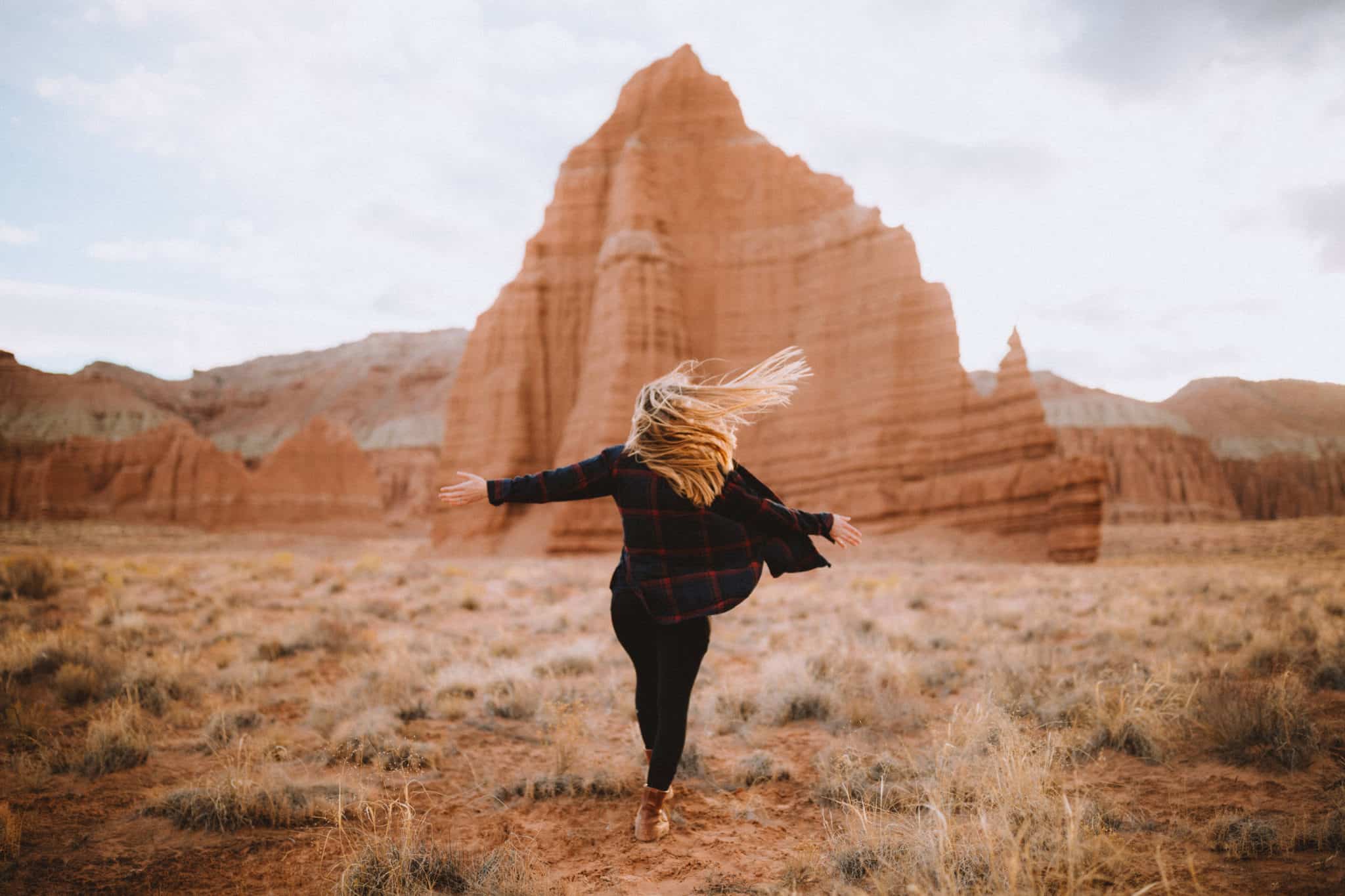
The Complete Utah National Parks Road Trip Itinerary (Hikes, Photo Spots + MORE!)
Post Summary: The Best Utah National Park Road Trip Route + Tips For An Epic Trip!
Cleverly marketed as “The Mighty 5”, the collection Utah national parks are pretty much a staple on any adventure-lovers bucket list. From the towering hoodoos of Bryce Canyon to the deep valleys of Canyonlands , the possibilities and activities are endless!
There is everything from hiking, camping, kayaking, climbing and so much more to do in Utah.
Berty and I wanted to experience everything the state had to offer, so we mapped out the perfect Utah national parks road trip to see everything along the way!
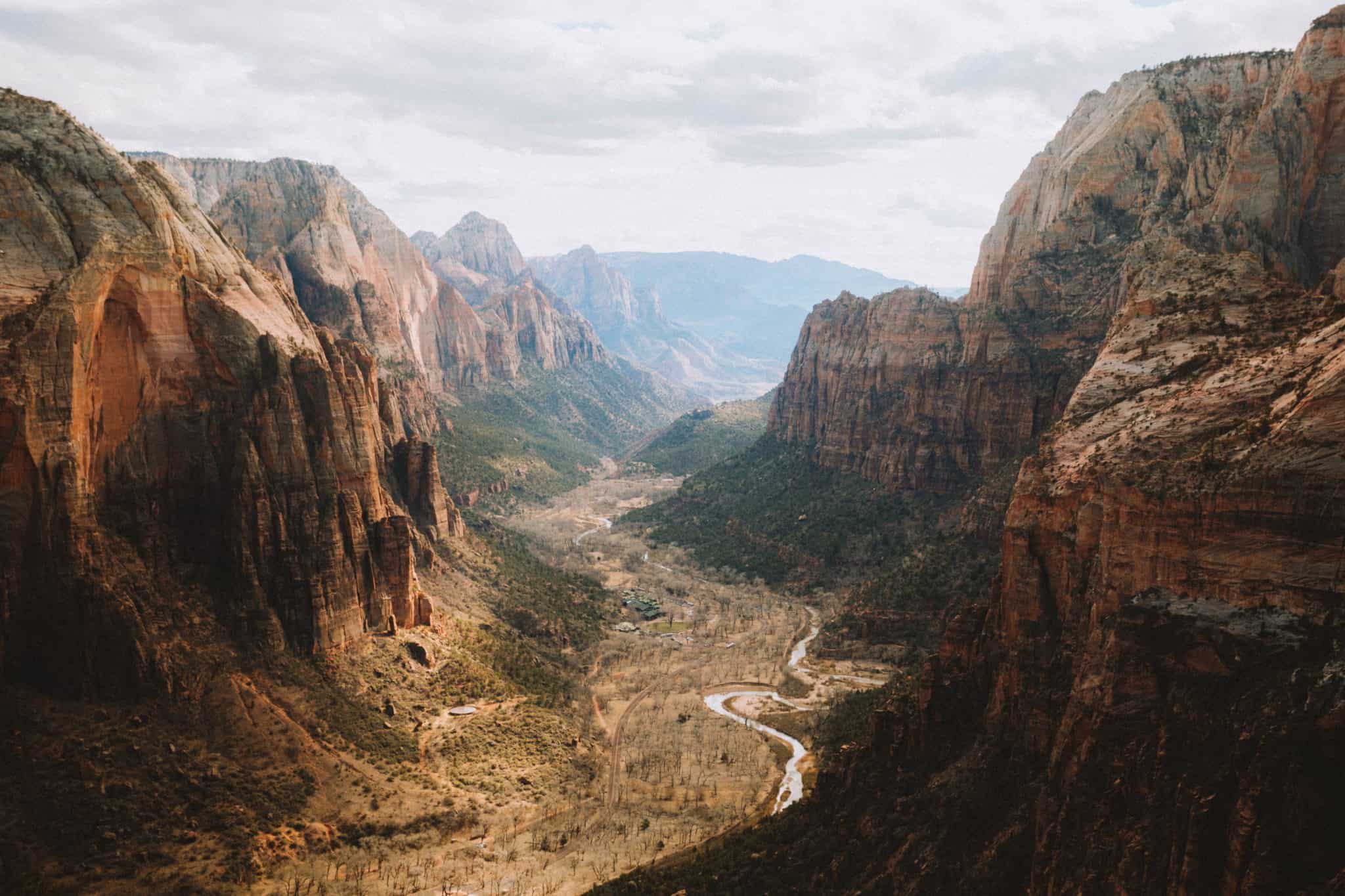
The Ultimate Road Trip To All 5 Utah National Parks
This post contains affiliate links, chosen and vetted by yours truly at no extra cost to you!
Note: If you are coming from the Pacific Northwest (like we did) you will most likely start near Salt Lake City.
If you live south of Utah, like in big cities like Las Vegas, Phoenix, or Albuquerque you can do a smaller loop by taking Highway 70 that goes East-West to shorten your trip but still see all the parks! Here’s another example of a Utah National Parks road trip route starting in the Southwest:
UTAH ROAD TRIP MAP STARTING IN LAS VEGAS
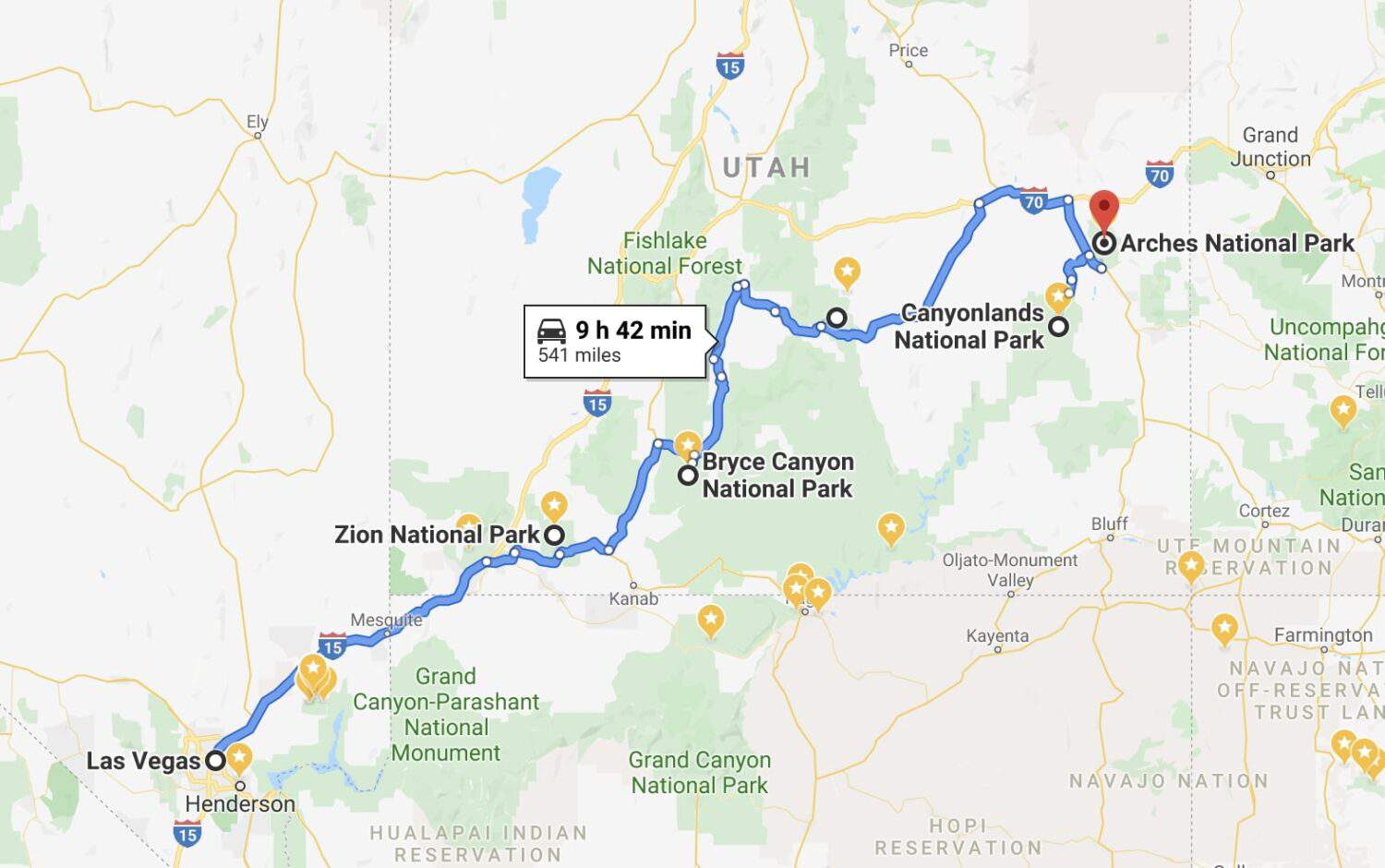
When Is The Best Time To Take A Utah National Parks Road Trip?
Each season brings its own unique take on a Utah National Parks road trip. Depending on the activities you’d like to do, there may be an ideal season to go for you and your group! Read below for a quick summary 0f what you might expect on a Utah road trip during each season:
Visit Utah National Parks in Winter: Taking a Utah road trip in the winter will provide you with the opportunity to have plenty of peace and quiet! You’ll run into very few crowds, but many of the popular attractions ( like Angels Landing Trail in Zion ) will likely still be closed because of snow.
Visit Utah National Parks in Spring: We think springtime is the best season to take a Utah National Parks road trip. This is because the weather is mild and the crowds are few, so you’ll have places like Delicate Arch Trail to yourself! The downside is that things still might be closed because of snow, and nights can still be very cold!
Visit Utah National Parks in Summer: This is the most popular time to visit Utah National Parks, because you’ll have the most daylight hours, and nearly every attraction in the park is open. The downside? You’ll be sharing it with the largest visitors crowds the parks will see all season!
Visit Utah National Parks in Fall: In our opinion, a Utah road trip in the Fall is the second best option! The family crowds have dissipated in anticipation for school starting, so you’ll have fewer people to share it with. Unfortunately, you may run into very cold nights and a high chance of bad weather at the end of the season.
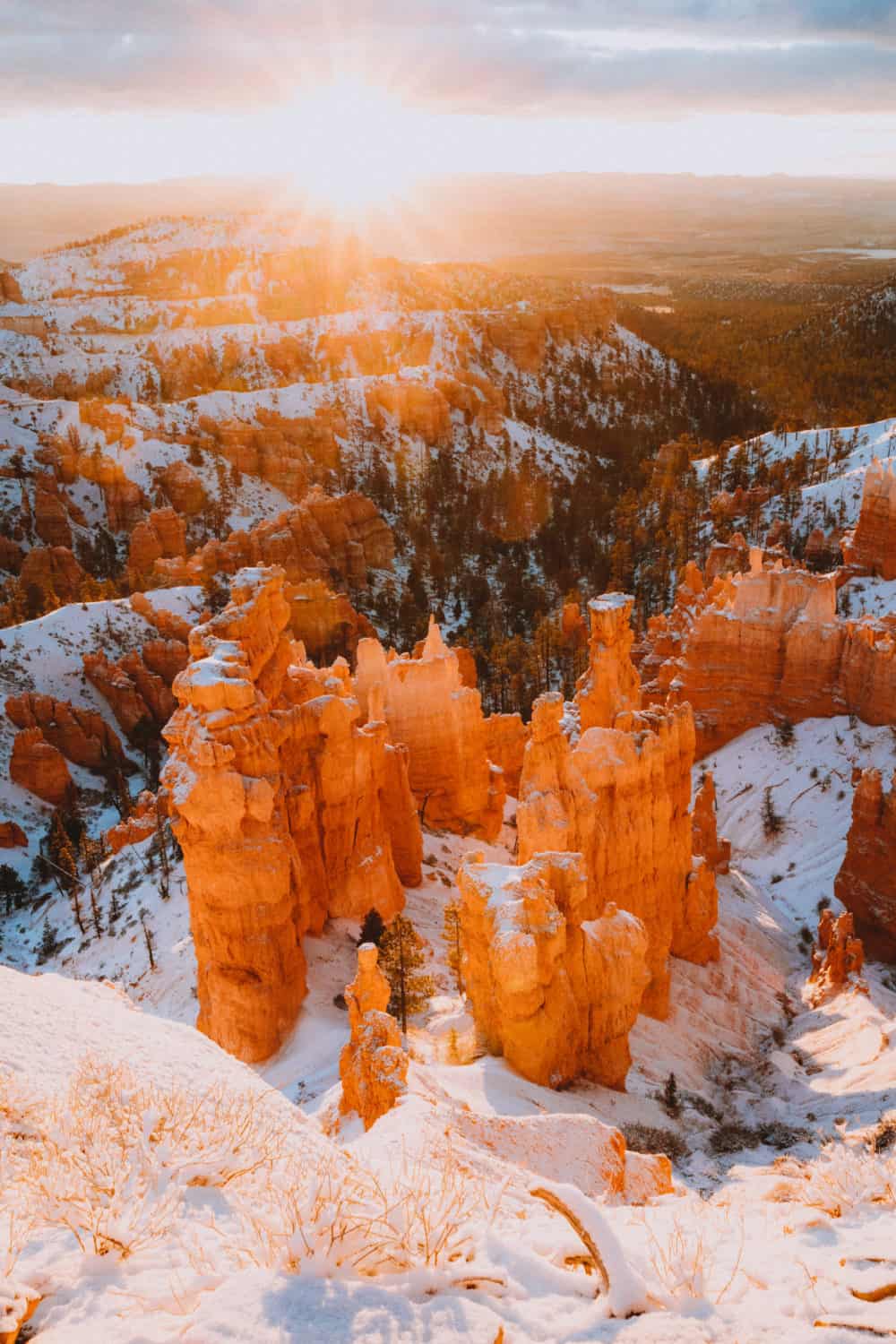
The Best Car Rentals For Your Utah National Parks Road Trip
One of the most important aspects of your Utah National Parks road trip is picking the right car for your adventure. Your set of wheels can determine where you will be staying, how much money you spend overall, and which parts of the parks you can access. Here are our suggestions for each level of adventure:
For Convenience And Comfort (Staying In Hotels/Airbnbs): We recommend a regular , full-sized sedan to fit in hotel parking lots and small spaces! These types of cars should give you plenty of room for those long drives, and plenty of trunk space between hotels and resorts! Looking for inspiration? Here are some charming cabins for rent in Utah !
For Budget Savvy Travelers And Campers: We highly recommend checking out campervan rentals at Outdoorsy . Think of it like Airbnb but for recreation vehicles! You can choose anything from cool vintage VW buses to tricked-out Sprinter Vans for a big dose of van life for your Utah road trip.
For Adventure and Thrill-Seekers: If you’re trying to explore deep into BLM land around the parks or off-road adventures like in the MAze in Canyonlands, you’ll want to make sure you have a high-clearance vehicle like a Jeep .
Where To Stay On Your Utah National Parks Road Trip
Throughout this Utah National Parks road trip post, we’re giving suggestions to nearby camping spots around each national park.
However, if you are looking for a way to keep track of all your camping reservations or need help finding spots along your route, we recommend planning out your trip with The Dyrt’s Road Trip Planner !
The Dyrt is the largest campground database, and with their Road Trip planner tool on the pro membership, you can mark your route and find the best campgrounds on the way. We’ve used it to plan our last trip to the Pacific Northwest and we loved discovering new spots along the way!
The Dyrt gave us a code for you, our epic reader, to try the pro membership for 30 days free! Click here and use the code Mandagies to unlock your 30-day free trial!
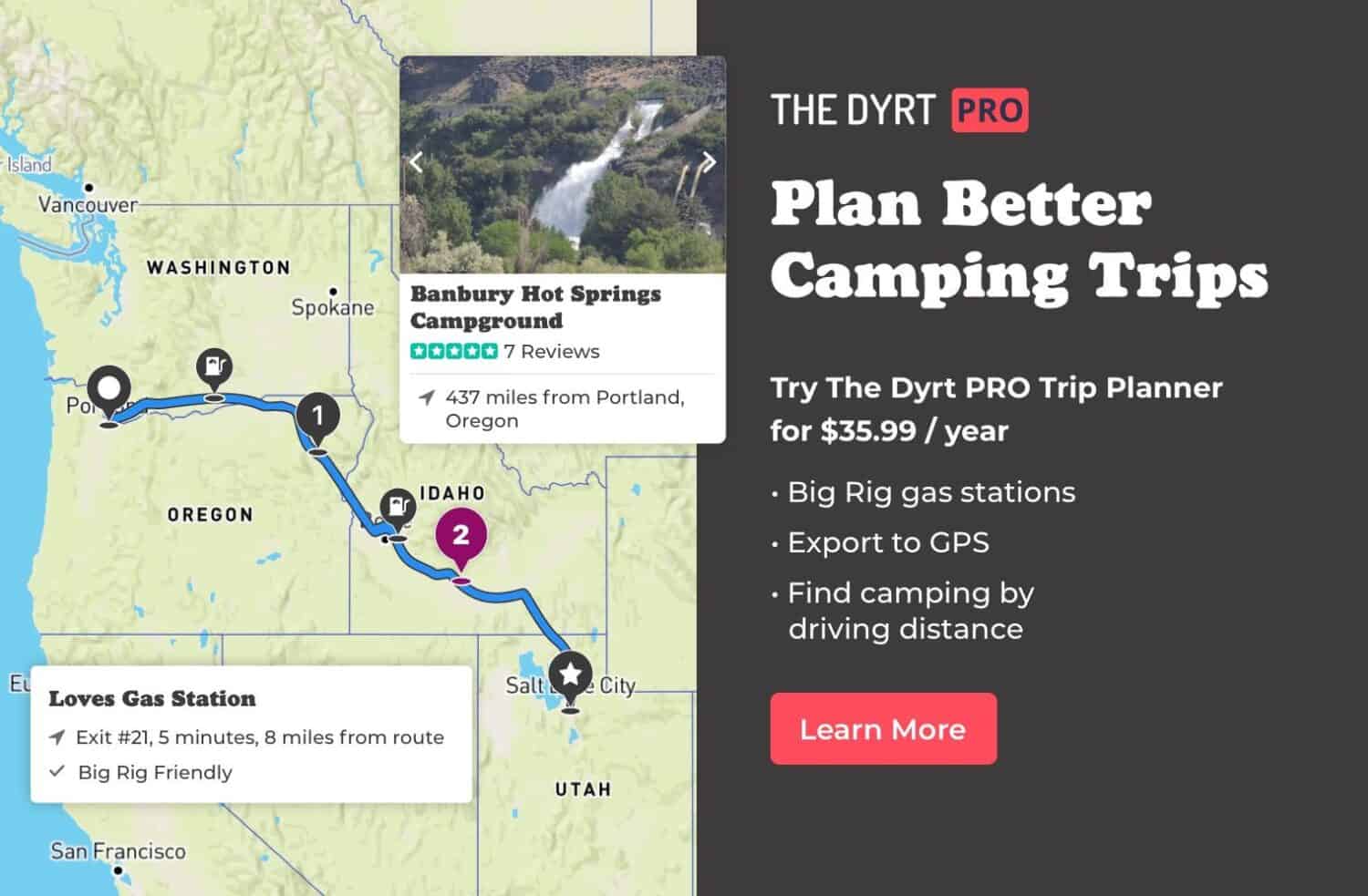
Utah National Park Stop 1: Zion National Park
Established in 1919, Zion is one of the most popular parks in the US , and naturally so! Its red cliffs, slot canyons, and amazing hikes will keep you busy for weeks.
Best Hikes In Zion National Park
It’s important to plan to give yourself adequate time and preparation for some of these epic hikes in Zion National Park. Some of the most popular trails in Zion are Angels Landing Trail, Observation Point, hiking through The Narrows, the Court of the Patriarchs and Towers of the Virgin.
One Day In Zion National Park
Being one of the most visited parks in the United States, be prepared for crowds and reserve accommodations and activities EARLY to avoid last-minute stress!
If you have only one day in Zion National Park, consider taking the shuttle bus on its full route through the park loop, and stop to see the attractions in each area. An easy hike would be the Pa’rus Trail, which is . 3.5 mile paved bike/walking path along the river.
Have Some Extra Time?
If you are looking for more solitude, come during the off-peak months (November – March) or explore Kolob Canyons, which is a lesser-known area of the park.
Where To Stay Near Zion National Park
For the most convenience to the park, book your hotel in Springdale, Utah . From the city, you can easily take a shuttle bus into the park to maximize your time in Zion.
To save a little money, consider booking a place on Airbnb ( and if it’s your first time booking, get $40 off here! )
Looking for a little backcountry camping in Zion? Check out the The West and East Rim Trails, which offer incredible opportunities to stay in the wilderness of Zion.
Best Photo Spots In Zion National Park
Nearly every corner of Zion National Park is photo-worthy! However, some of the best spots for photos in Zion include The Watchman, the view from the top of Angels Landing, The Narrows, Observation Point, and anytime during sunrise!
Read More: Hike Zion’s Dangerous Angels Landing Hike
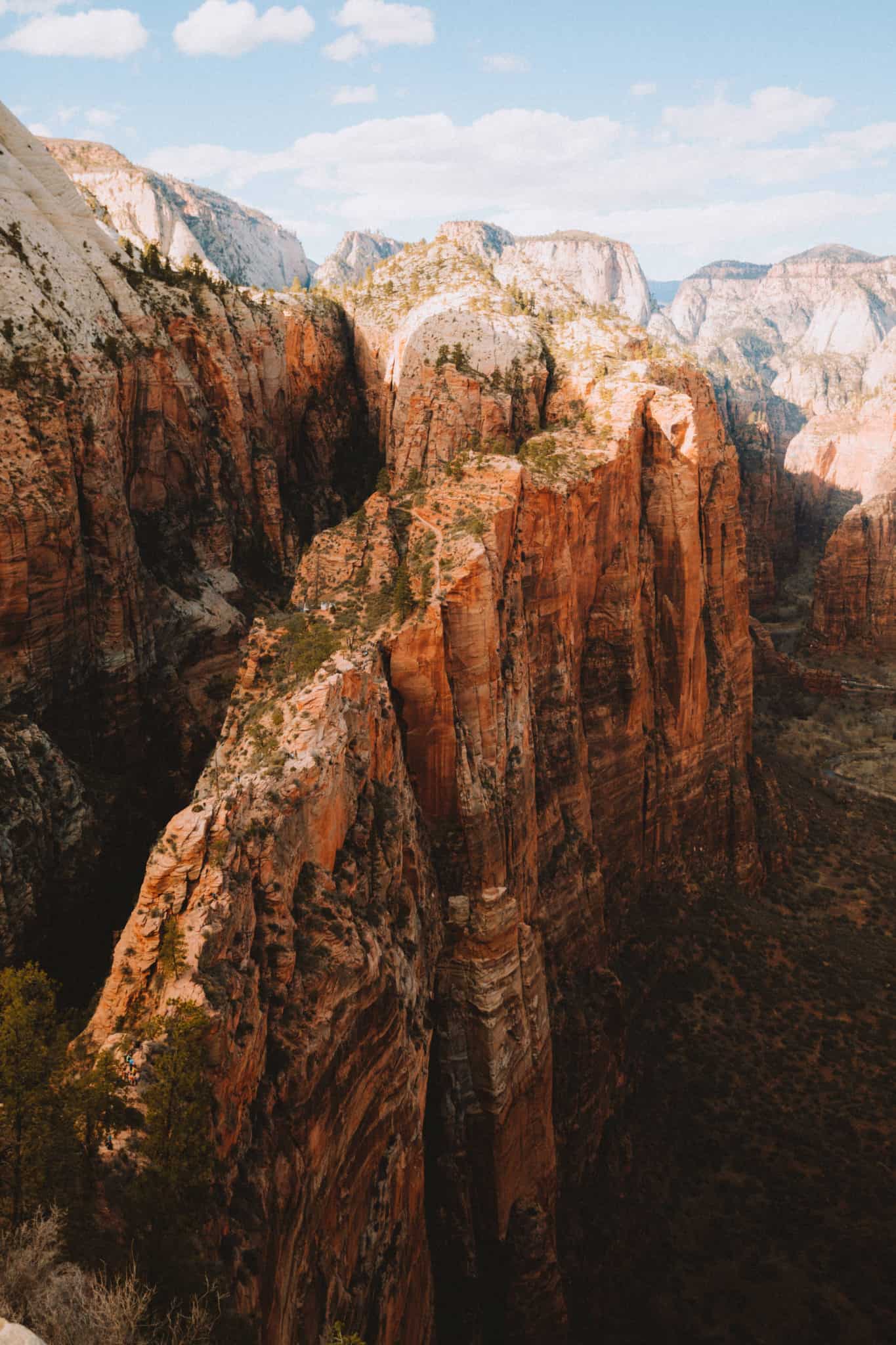
Utah National Park Road Trip Stop 2: Bryce Canyon National Park
Bryce Canyon National Park was created (and is still being formed) by a combination of ice, weather, and erosion. Bryce Canyon has the largest assortment of hoodoos in the world, which makes this place an iconic stop on any Utah national parks road trip.
Best Hikes In Bryce Canyon
Here, there are lots of hikes within the canyon and several scenic overlooks to keep you busy for a long time. Try taking the Queen’s Garden Loop, Mossy Cave Trail, and Bristlecone Loop Trail for easy and beautiful ways to get up close to the Bryce Canyon hoodoos.
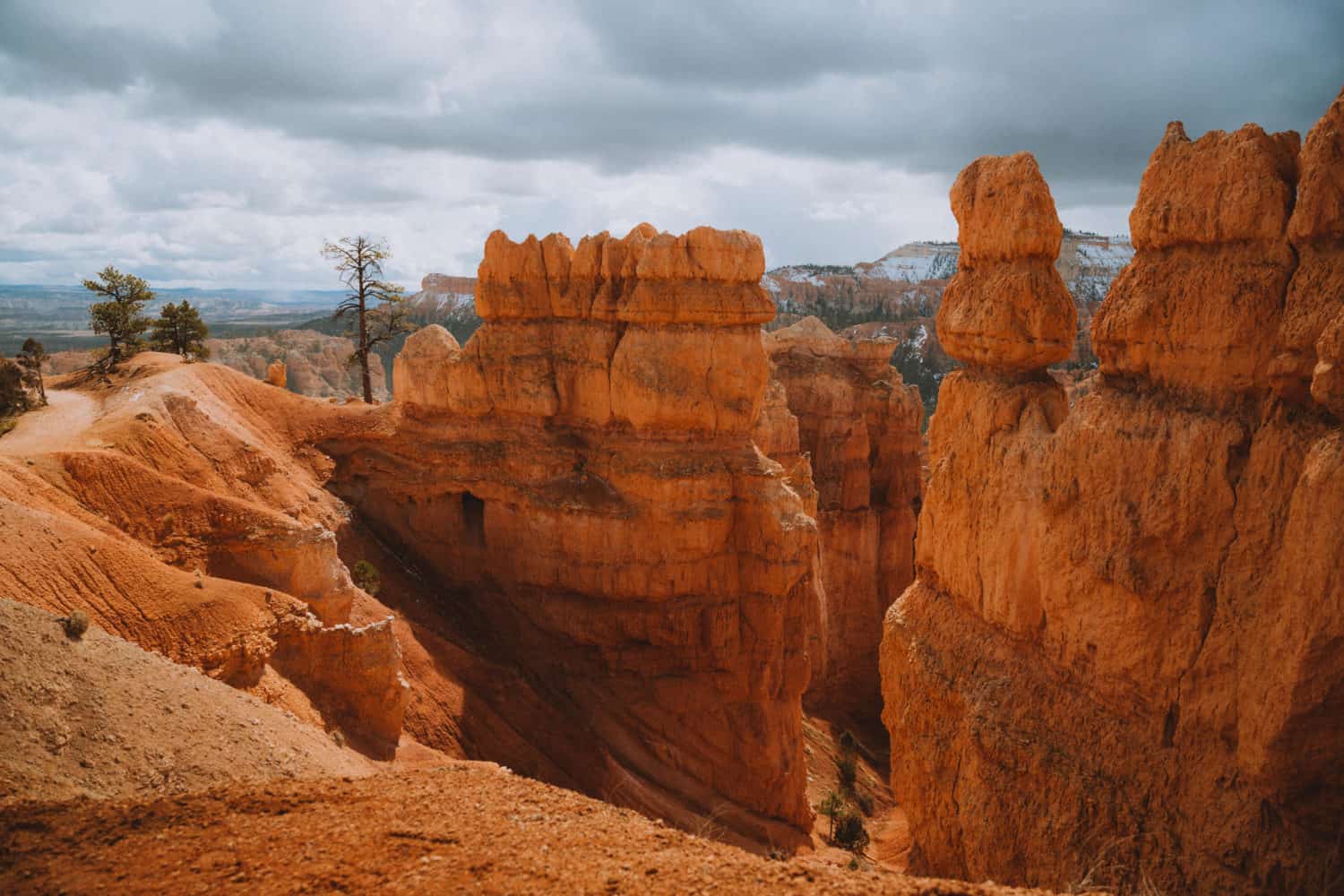
One Day In Bryce Canyon National Park
You can easily see Bryce Canyon in one day! You may have to prioritize one hike (or maybe two) but prepare to spend plenty of time in the car, stopping at various points along the 30 mile stretch of the canyon rim drive.
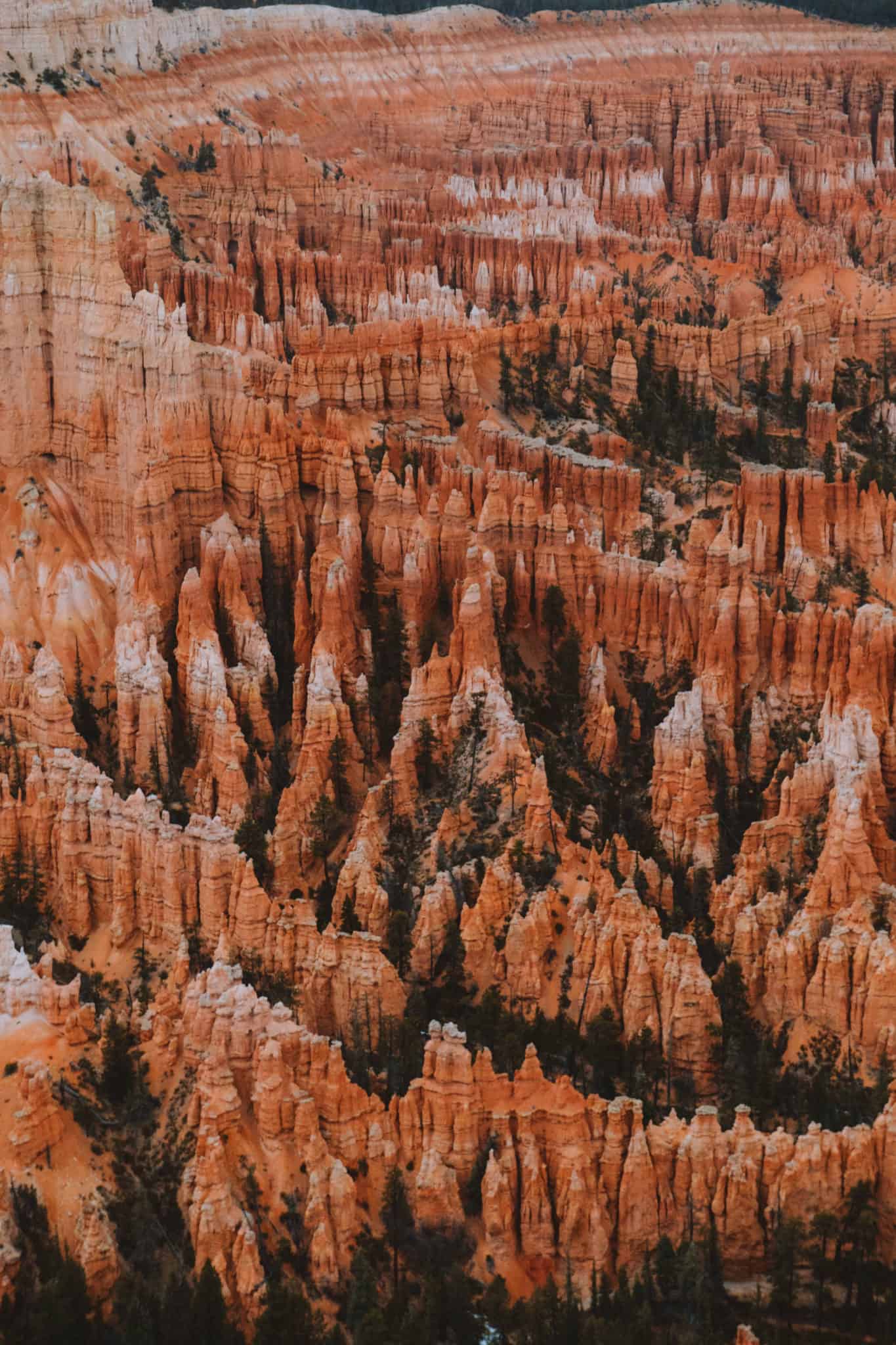
Coming To Bryce Canyon In The Shoulder Season?
If you’re visiting Bryce Canyon in the shoulder season or off-season (Fall, Winter or Spring), make sure to pack warmer clothes when visiting here – the high elevation causes this area to have variable conditions, on top of already having an average of 200 days per year with a chance of below-freezing weather.
If you decide to take a winter road trip to Utah , you might be able to see Bryce Canyon is a beautiful blanket of snow!
Where To Stay Near Bryce Canyon National Park
The most convenient place to stay near Bryce Canyon is at Bryce Canyon City . Here there are tons of hotels to choose from!
If you want to stay in the park, consider the two campgrounds in Bryce Canyon, North Campground and Sunset Campground . They are first-come-first-serve in for the tent sites, so come early to claim a spot!
Best Photo Spots In Bryce Canyon National Park
For some of the best photo spots in Bryce Canyon, watch the sunrise/sunset on the Canyon Rim trail!
Read More: 5 Things To Do at Bryce Canyon National Park
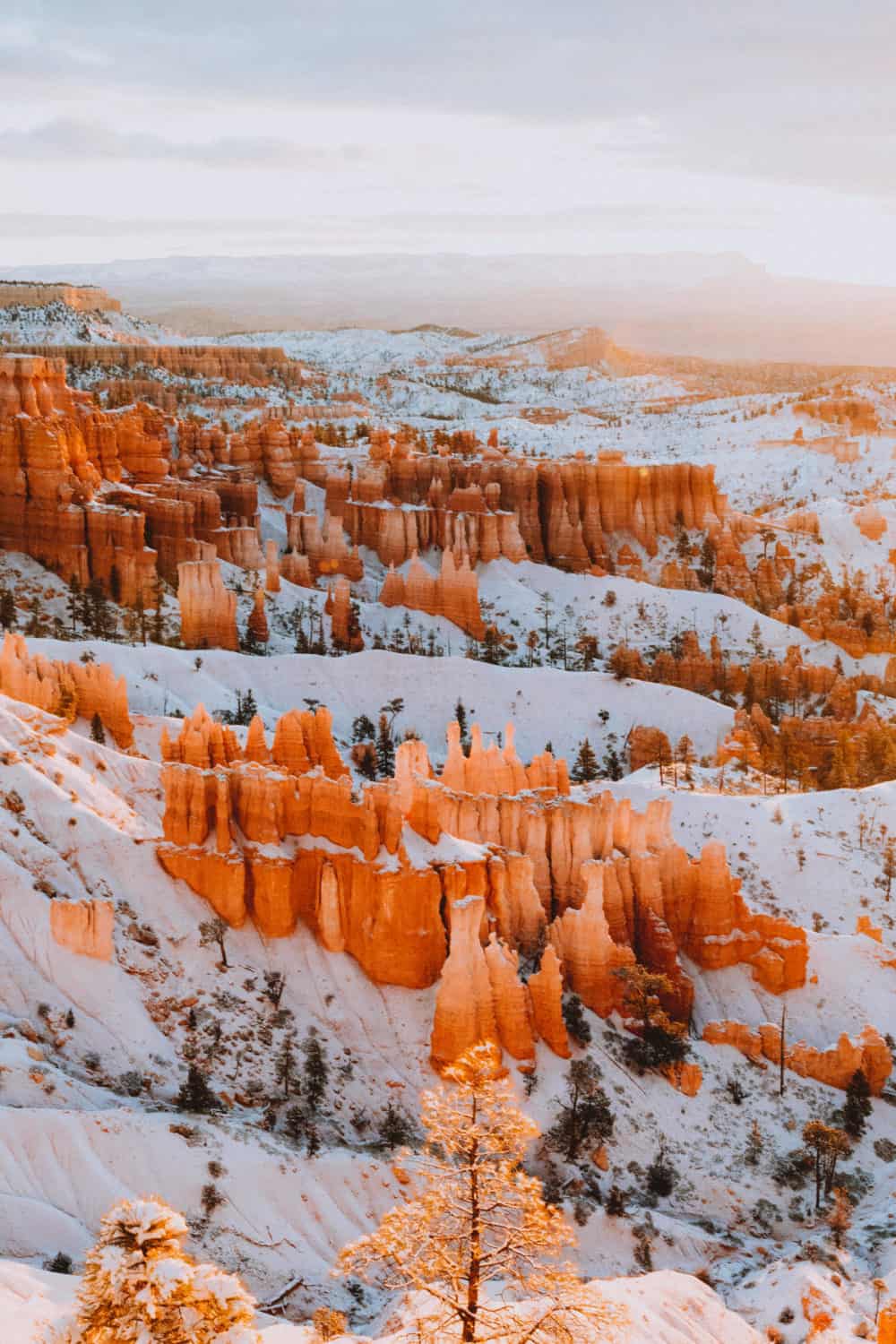
Utah Road Trip Stop 3: Capitol Reef National Park
The underdog of the five parks, still, Capitol Reef National Park shouldn’t be missed! It’s one of the most beautiful photography locations in the American Southwest!
Best Hikes In Capitol Reef National Park
- Cassidy Canyon
- The Grand Wash
- Chimney Rock
- Frying Pan Trail
- Capitol Gorge
One Day In Capitol Reef National Park
If you have only one day in Capitol Reef National Park, we suggest sticking to the main roads to see the most attractions in the shortest amount of time. You can easily visit the main attractions right off Highway 24.
Some of these attractions include the Gifford Homestead in the Fruita Historic District, Hickman Natural Bridge, the Grand Wash, Capitol Reef Visitor Center, and Panorama Point.
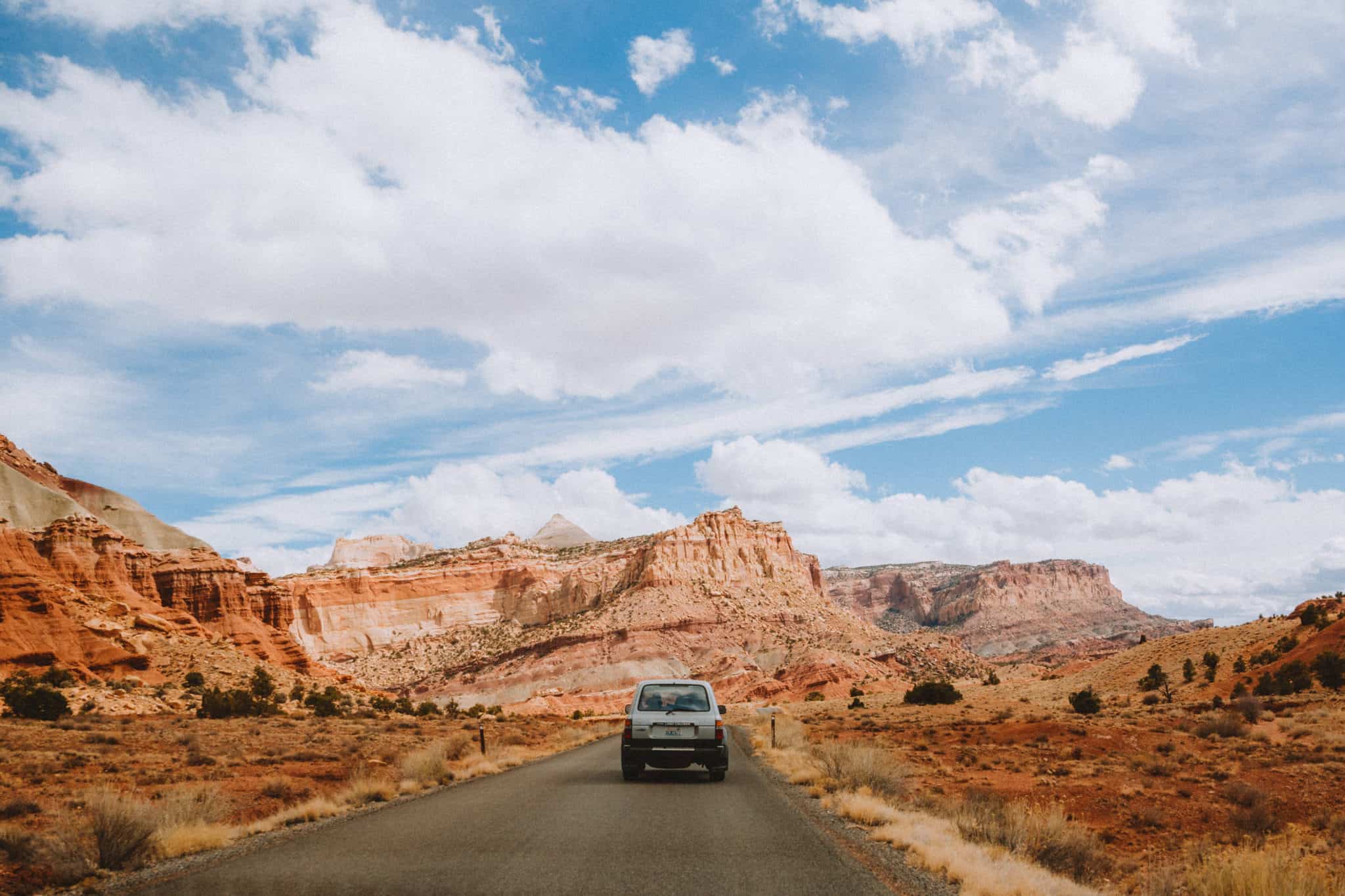
This is the least visited of the Utah national parks, so if you are looking for solitude, you’ve found it here at Capitol Reef. To venture out even further into the park, consider taking the off-road adventure the Cathedral Valley, a section of the park with towering structures that very few see with their own eyes!
Where To Stay Capitol Reef
For the comfort of a warm bed in a hotel, consider staying in the nearby town of Torrey near Capitol Reef National Park.
Looking for a bit more adventure under the stars? There are plenty of backcountry dirt roads ready for the most adventurous of visitors! If you want to camp, there is plenty of BLM lands to spend the night near the park borders. Make sure to read our guide to free camping in the USA here!
Best Photo Spots In Capitol Reef
With its own unique set of natural arches, petroglyphs, canyon hikes, and more, this area of Utah has some of the most spectacular photo opportunities in the state.
Some other beautiful photo spots in Capitol Reef include Hickman Natural Bridge, Cassidy Arch, Capitol Dome, and Chimney Rock.
Read More: Discover Capitol Reef National Park’s Hidden Gems
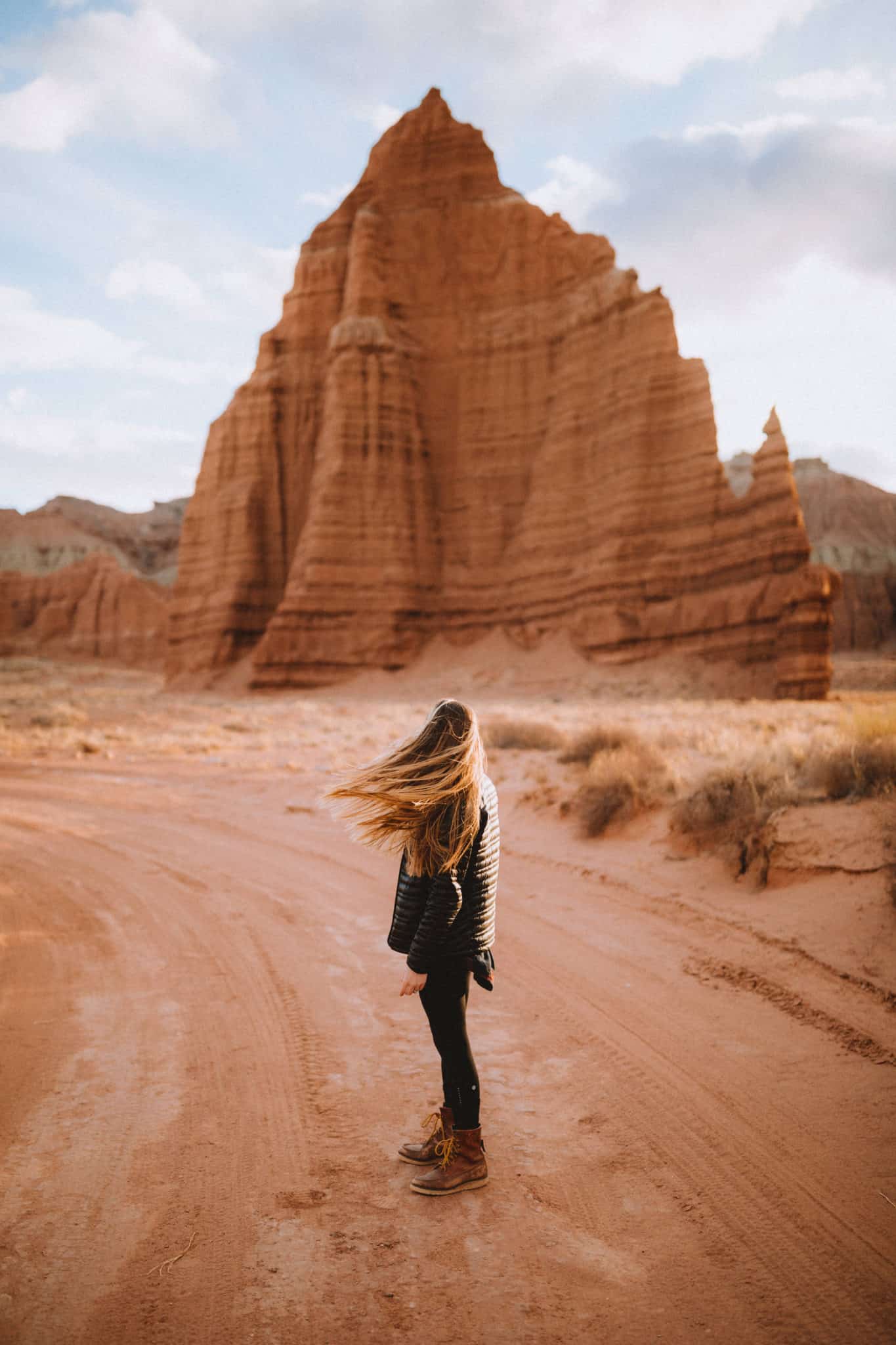
Utah National Parks Road Trip Stop 4: Canyonlands National Park
Canyonlands National Park is exactly what it sounds like. The main part of the park consists of a few roads on a long mesa which towers above the enormous surrounding canyons. There is very little light pollution within the park, so we actually suggest visiting Canyonlands in the day AND night!
Officially named a “Dark Sky Park” by the International Dark-Sky Association (IDA) this place is world-renowned for its summertime Milkyway viewing and star-gazing.
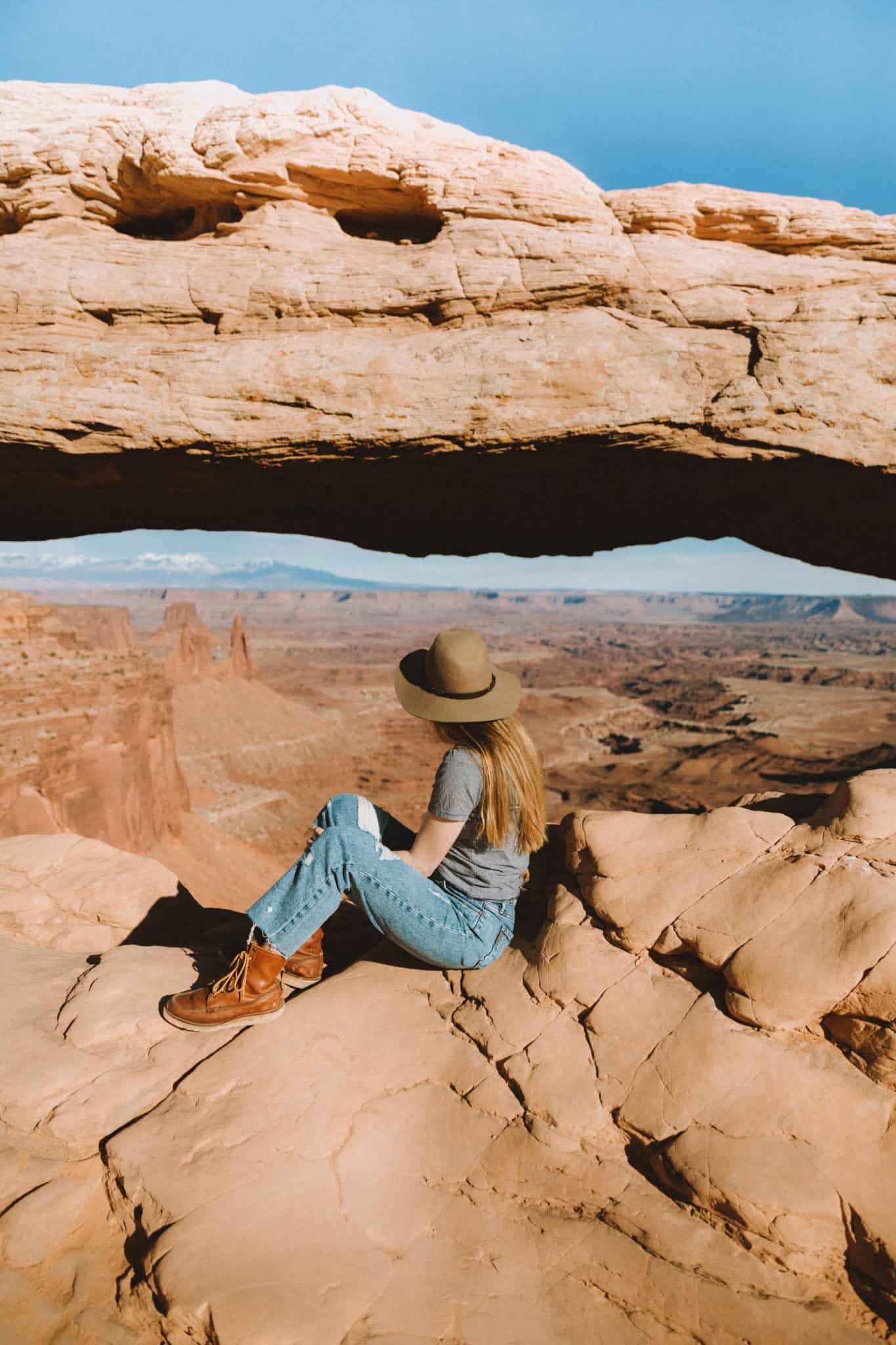
Best Hikes In Canyonlands National Park
There are some incredible hiking trails in Canyonlands National Park! The most popular would be the short trail to Mesa Arch, but other great trails include Aztec Butte Trail, Gooseberry Trail, Wilhite Trail, and Grand View Trail.
Make sure to pack a sun hat and wear plenty of sunscreen – there is absolutely NO shade in this park!
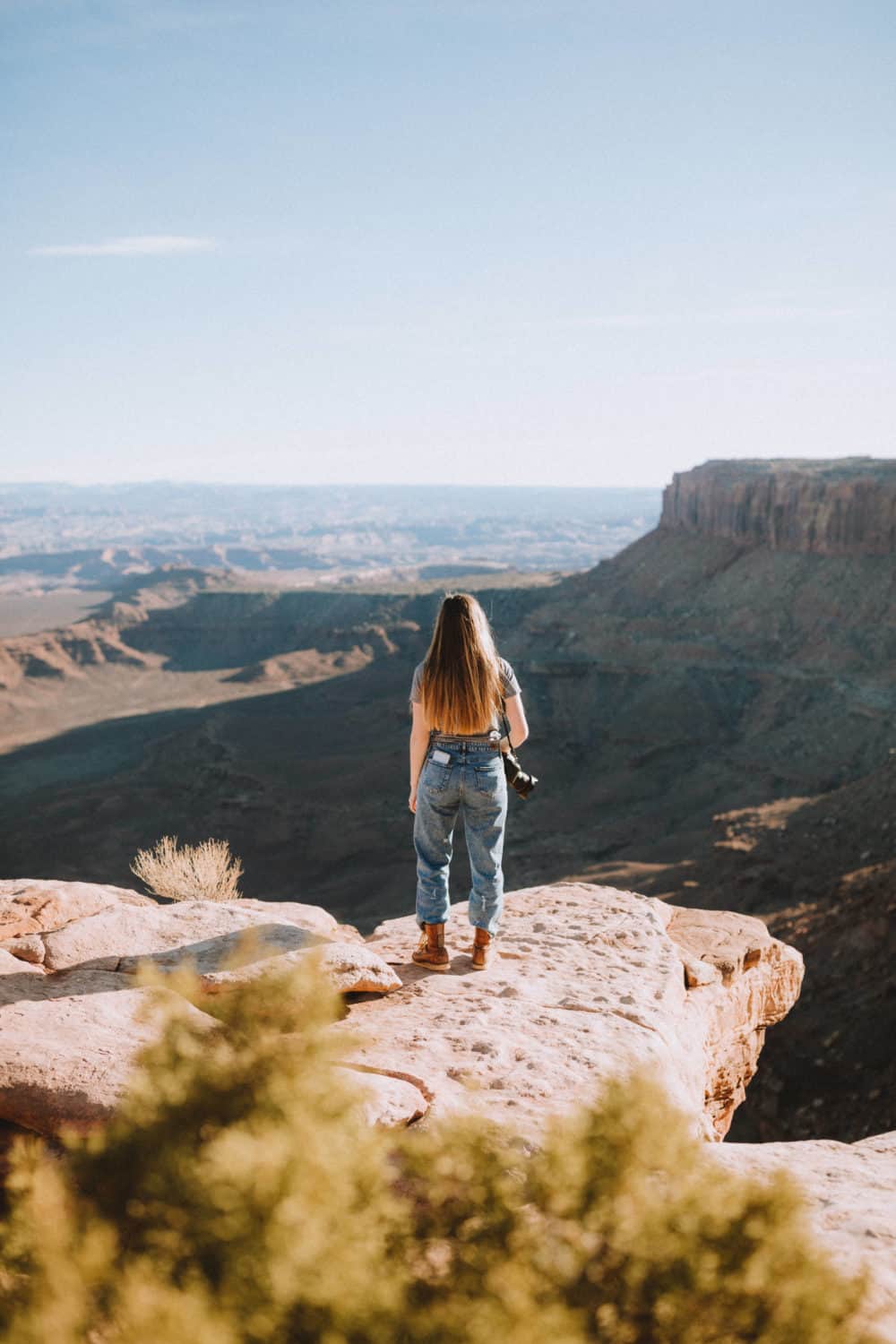
One Day In Canyonlands National Park
The park is divided into four areas – The Island In The Sky, The Needles, The Maze, and the rivers themselves. Each has its own unique set of activities, but the one with the most accessibility would be the Islands In The Sky.
If you only have one day to spend in Canyonlands National Park, we highly suggest spending your time in the Island In The Sky Section. This section brings you to some of the most iconic views in the park, as well as the most easily accessible places.
Try checking out the nearby Dead Horse Point State Park. Here, you can find iconic views of the Colorado River that winds through the canyon.
Where To Stay Near Canyonlands National Park
The easiest and most convenient place to stay near Canyonlands National Park is in the nearby town of Moab, Utah .
Best Photo Spots In Canyonlands National Park
If you’re looking for iconic photos spots in Canyonlands National Park, Mesa Arch during sunrise can’t be missed. Additionally, Candlestick Tower during sunset and Grand View Point during the day are excellent options for photos.
Read More: Sunset At Canyonlands National Park
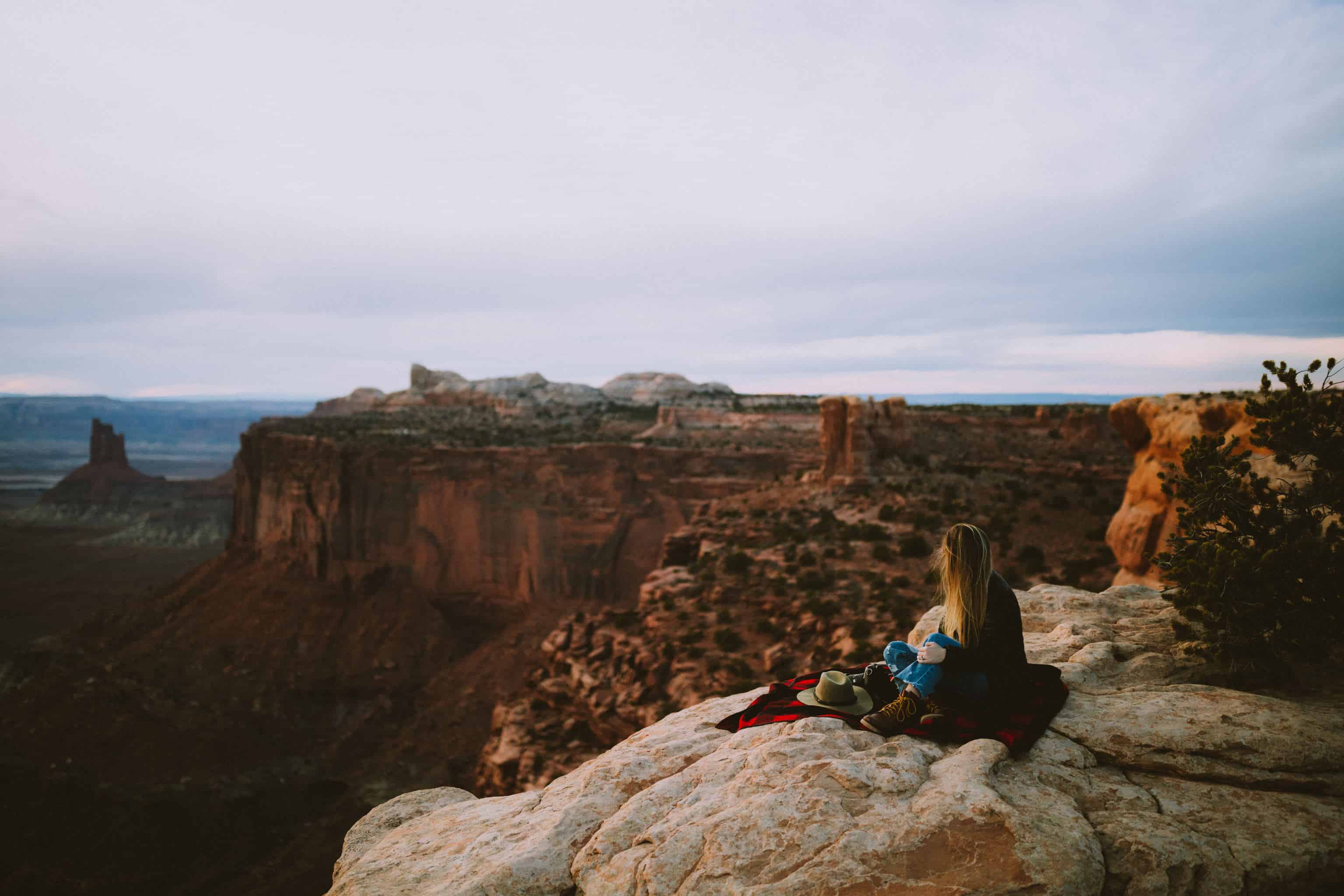
Utah Road Trip Stop 5: Arches National Park
With over 2,000 natural stone arches in the park, there won’t be a dull moment during your time in Arches National Park. Whether you are taking a day hike, overnight camping, or simply just passing through, Arches is guaranteed to leave an impression on any adventurous spirit.
We’ve created a 24-hour guide for those who have just a short amount of time to spare, a hiking guide , and a photo journal of Delicate Arch during sunrise !
Best Hikes In Arches National Park
There are plenty of amazing hiking trails in Arches National Park to choose from! Some of our favorite hikes include a sunrise hike to Delicate Arch , Fiery Furnace, Double Arch, Park Avenue Trail and the Windows Loop.
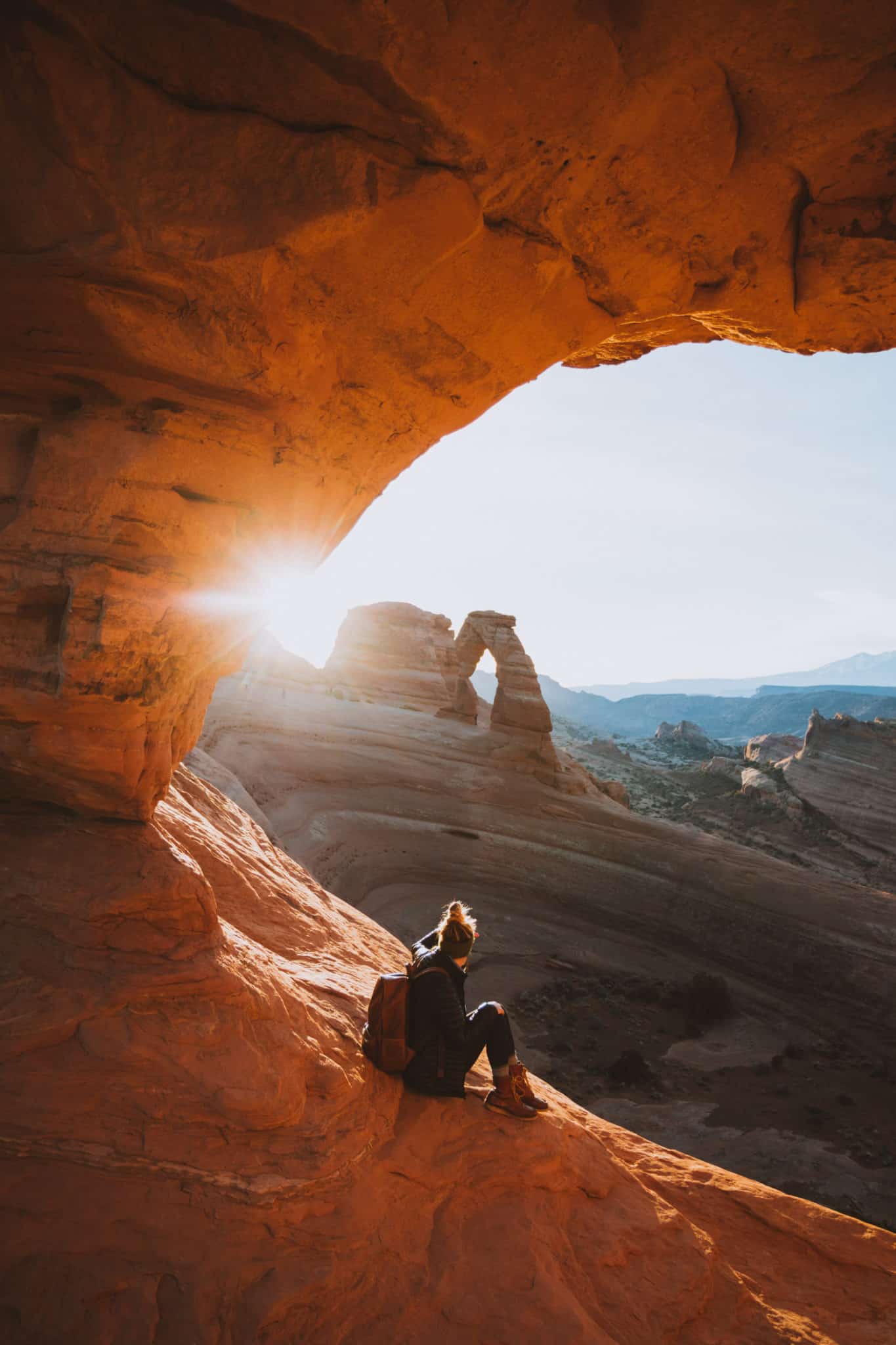
One Day In Arches National Park
Only have one day in Arches National Park? Spend some time driving the Arches Scenic Drive , the 36-mile round trip road. This road connects nearly all the major sections of the park, so you can easily stop to quickly explore a section, or pull over for a photo. We also made a 24-hour guide to Arches National Park!
If you have a little extra time to spend in the park, consider taking the Devil’s Garden Loop trail , a 7.5-mile path that connects seven iconic arches, including Landscape Arch (the longest one in the park), Navajo Arch, Double Arch, and more!
Where To Stay Near Arches National Park
Similar to Canyonlands, the most convenient place to stay near Arches National Park is in the nearby town of Moab, Utah .
Best Photo Spots In Arches Canyon National Park
Some of the most iconic photo spots in Arches National Park include Delicate Arch, the Windows Loop, Balanced Rock, the Courthouse Towers, and Park Avenue.
Read More: How To Spend 24 Hours In Arches National Park
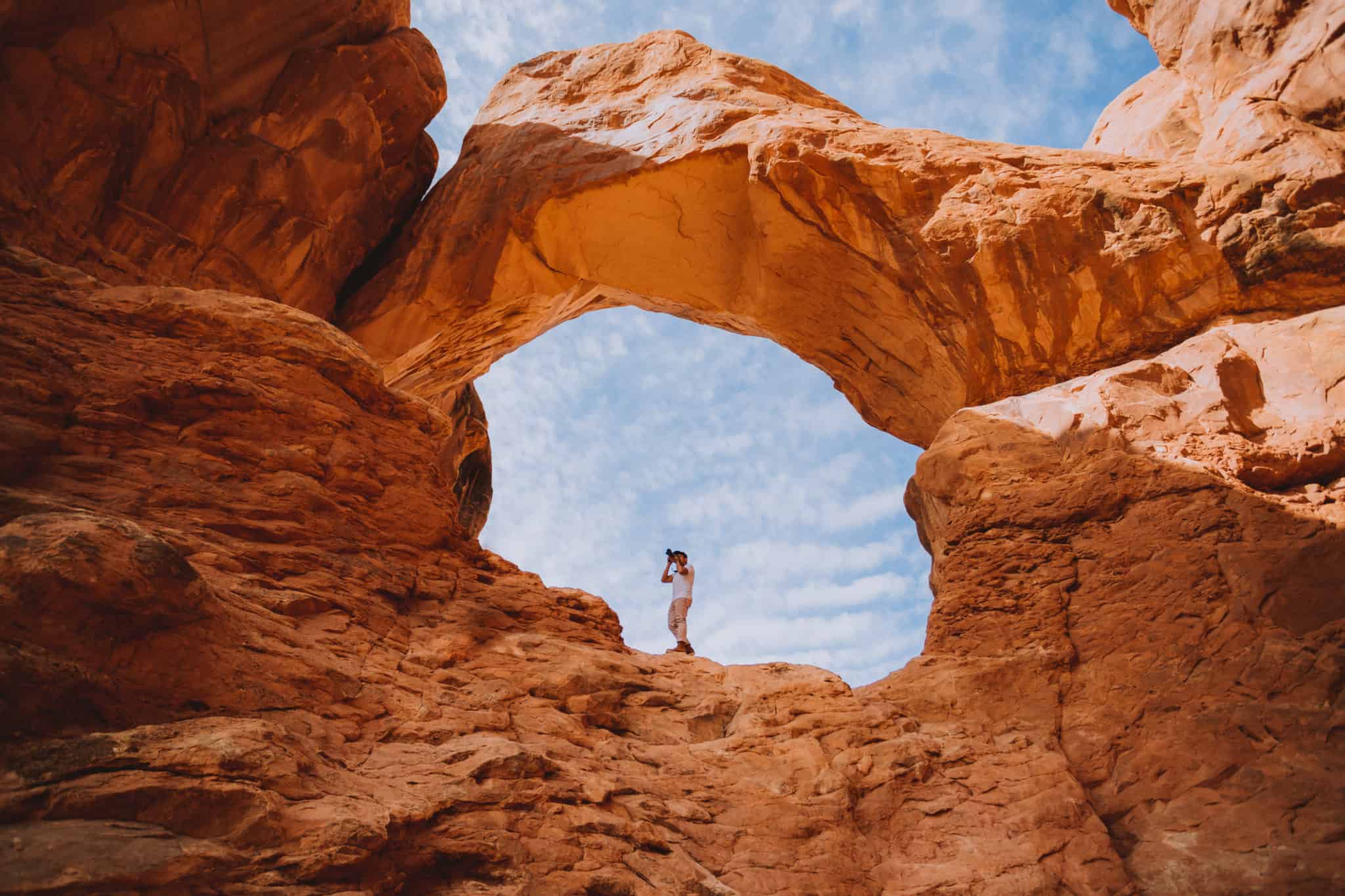
UTAH NATIONAL PARKS ROAD TRIP FREQUENTLY ASKED QUESTIONS
What are the best utah national parks.
Ranking the Utah National Parks form best to worst isn’t quite a fair comparison, because it implies we think some are bad. That’s certainly not the case! Here they are in order of popularity, according to PlanetWare .
- Zion National Park
- Arches National Park
- Canyonlands National Park
- Bryce Canyon National Park
- Capitol Reef National Park
What Else Is There To See Beyond The Utah National Parks?
Want to see more than just the stops on your Utah National Parks road trip? There are plenty of other amazing Utah and Arizona features to discover! We connect nearly everything in our Southwest Road Trip Itinerary here, which we highly recommend if you’ve got some extra time.
In the meantime, here are some other amazing places to see in the American Southwest , near Utah National Parks:
- Goblin Valley State Park
- Corona Arch near Moab, Utah
- Grand Staircase-Escalante National Monument
- The Grand Canyon
- Page, Arizona
- Monument Valley
- Amazing Hikes In Sedona, Arizona
- …or take several other west coast road trips nearby!
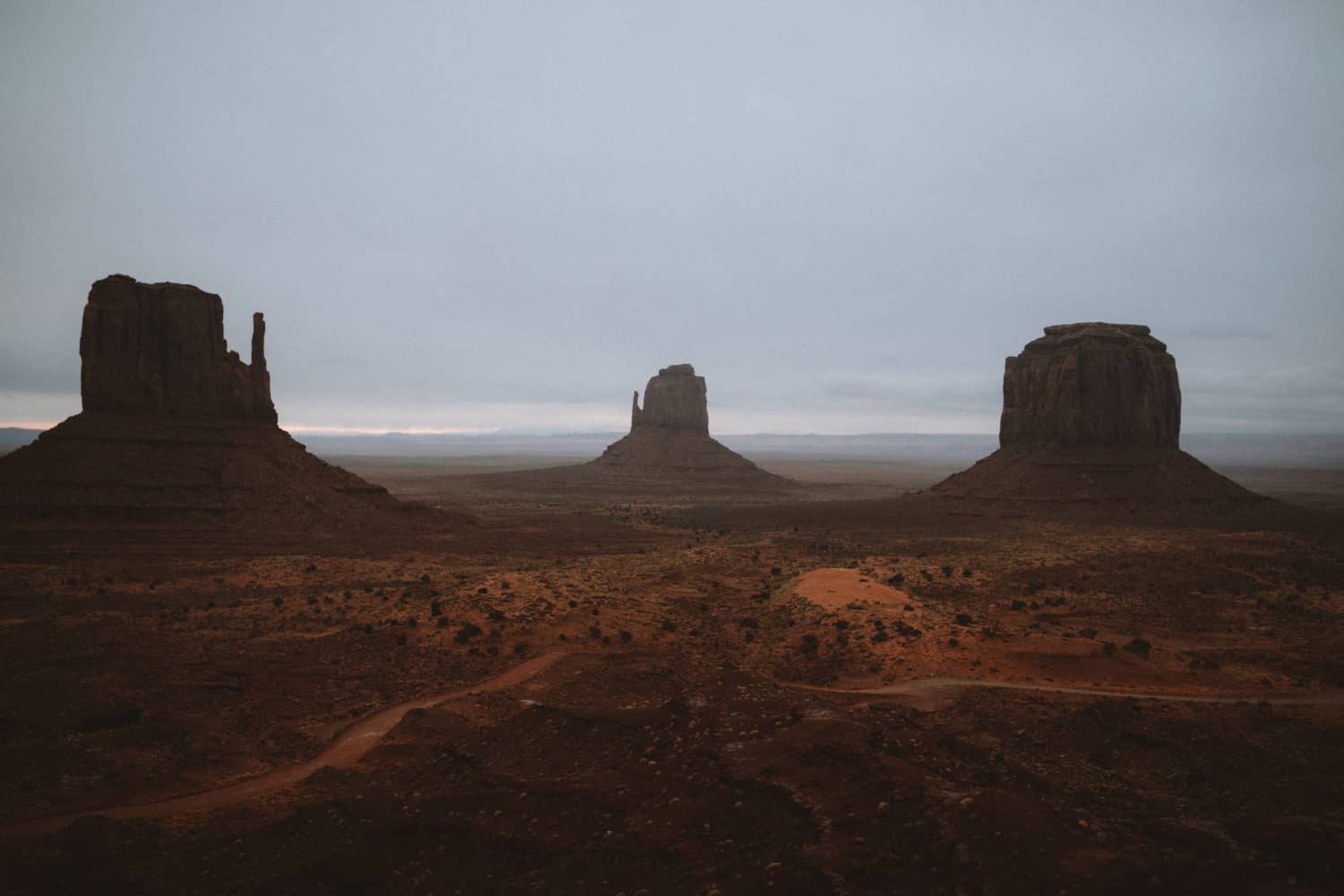
Have you ever taken a Utah National Parks road trip? What was your experience like? Tell us about it in the comment section below!
Read more utah / road trip posts.
Delicate Arch Hike During Sunrise (Beat The Crowds!)
10 Amazing Hikes In Arches National Park
10 Insanely Useful Road Trip Planner Tools and Apps
Car Camping 101: The Complete Guide To Sleeping In Your Car
30 Necessary Road Trip Essentials For Your Next Trip
101 Fun And Random Road Trip Questions To Ask Your Friends
20 Brilliant Car Camping Hacks For Your Best Trip Yet
Want more inspiration for your Utah National Parks road trip? Follow our Southwest board for more ideas and tips for your journey!
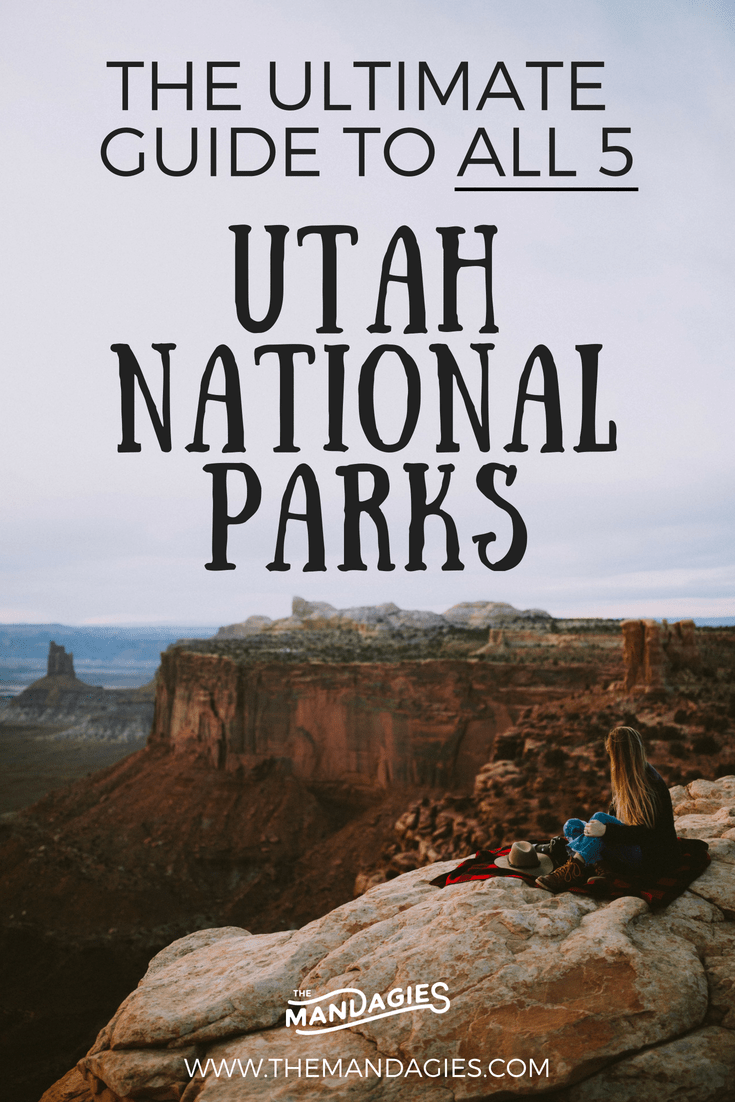

Utah National Parks Road Trip Itinerary: Your 2024 Guide
Utah’s National Parks are simply stunning. And planning a Utah National Parks road trip is the best way to see and enjoy them.
From lush green valleys and sandstone formations in every shade of orange to deep canyons and expansive panoramas stretching as far as the eye can see, Utah’s National Parks will take your breath away, transport you to another planet, and inspire your inner sense of adventure all in one fell swoop.
You could spend an endless number of days exploring Utah’s National Parks and still leave hoping for a return visit. But if you’ve got a week (or even a bit longer), you can experience Utah’s unbelievable beauty on an unforgettable road trip.
In this in-depth Utah National Parks trip guide, find detailed and travel-tested itinerary planning advice and tips based on my own experiences from traveling throughout Utah and the American Southwest . This includes maps, important driving information, where to stay, and the best things to do in each National Park.
Plus, you’ll find several Utah National Park itinerary ideas so you can plan your ideal trip!
How to Plan a Utah National Parks Road Trip Itinerary
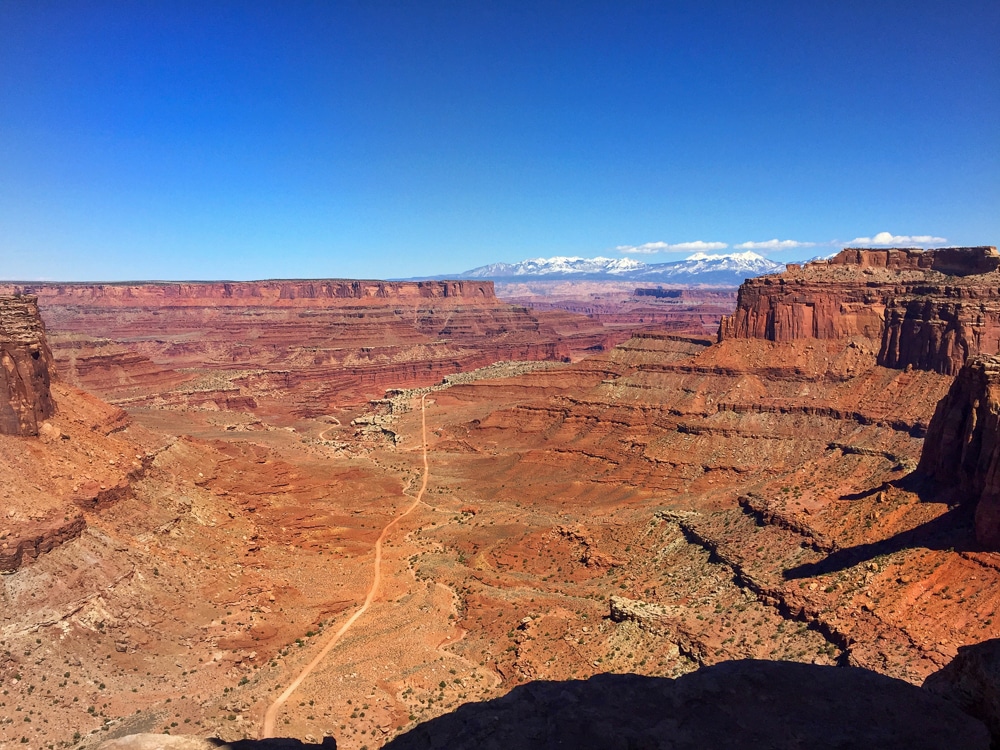
This Utah National Parks road trip guide is a true labor of love. I’ve traveled throughout Utah and the southwest, as well as to National Parks in nearby states like Colorado and Arizona. There’s no part of the United States like this corner of the country!
Quite simply, the natural beauty is jaw-dropping and the landscape offers an endless number of outdoor adventures to enjoy, from hiking and ATVing to wildlife watching and scenic drives.
Of course, the Utah National Parks steal the show, but it’s important to understand there are many State Parks and National Monuments that are equally worth seeing. If you’re like me, the problem isn’t necessarily planning a Utah road trip but having enough time to visit all the places on my list!
So, in this Utah National Parks trip guide you’ll find a few different ideas for how to plan your itinerary. Just remember, these parks are vast. If you want to do several hikes in a particular park or there are a bunch of activities that you’d like to do in a certain area, go for it!
Your Utah National Park itinerary can be about seeing Utah’s Mighty 5 or it can be about dividing your time among a couple of National Parks and the nearby State Parks and Monuments. Either way, you’ll want to return for sure! So, focus on the goal of just enjoying whatever places you add to your itinerary. You can’t go wrong!
Where to Start Your Utah National Parks Road Trip
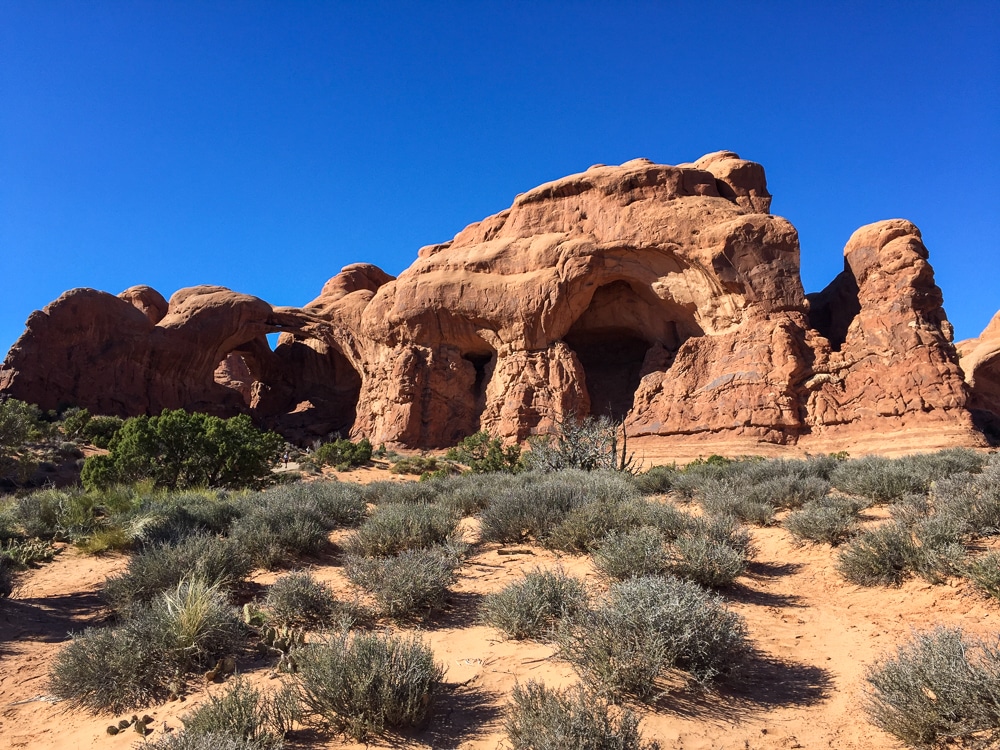
Salt Lake City and Las Vegas are the best places to start and/or end your trip to the Utah National Parks. These 2 cities have major airports with plenty of flights in and out each day. Most major U.S. airlines fly in and out of these airports but it’s good to remember that Delta has a lot of flights to and from Salt Lake City while Southwest Airlines is very active at the airport in Las Vegas.
It’s great to have both options because you can search for cheap flights with some flexibility. The same is true if you’re using miles and points to book an award flight as there may be available seats in one starting point but not the other.
I recommend flying into one of these airports and out of the other, especially if you have just 1 week for your Utah National Parks trip. Generally, airlines don’t charge more for multi-city bookings, although you should always do your homework. You likely can fly into Las Vegas and out of Salt Lake City, for example, for roughly the same price as a classic round trip.
As for rental cars and pesky one-way rental fees, they do exist. However, they’re not universal and they are applied or not according to a range of factors. So, I recommend pricing it out because you could find there is no one-way fee for your travel dates or that it’s nominal and worth saving the time driving back to your original airport.
I started my very first Utah National Parks road trip in Salt Lake City and Moab and would gladly do so again.
Renting a Car for Your Utah National Parks Road Trip
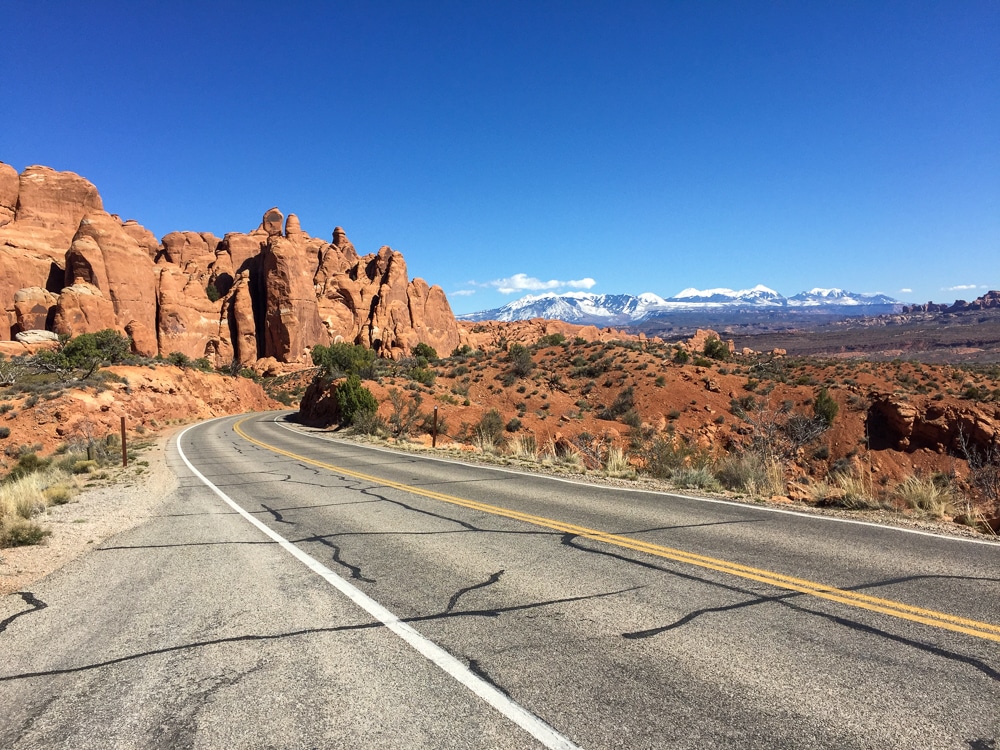
Whichever airport you fly into, you’ll need to rent a car. Both Salt Lake City and Las Vegas are major airports with plenty of car rental options.
For all my road trips, I use Kayak to search rental car costs because it compares prices on many sites all at once.
Consider the time of year of your trip. Some of the parks have steep and narrow roads. If you want to do any off-roading, definitely rent a vehicle with 4-wheel drive and preferably one with some clearance underneath. That being said, my first Utah road trip was in the spring and I rented a basic sedan-style car and had no problems.
ProTip: Unless your road trip is coming up right away and you’re renting a car last minute, never pre-pay for your rental. Instead, book a pay-at-the-counter rate and then hopefully save money with this car rental hack.
Alternatively, if you’re planning to drive to Utah from where you are, be sure your car (and everyone in it) is ready and prepared with this travel-tested road trip packing list .
How Many Days Do You Need for a Utah National Parks Trip?
Your Utah road trip should be at least 7 days. One full week gives you the chance to see all 5 Utah National Parks or a combination of National Parks and other places like Monument Valley or Grand Staircase- Escalante National Monument.
If you can spare a few more days for a 10-day itinerary for the Utah National Parks, you’ll have time to see all 5 National Parks plus make a couple of more stops to more fully take advantage of the incredible natural beauty in the area.
I would be leaving something major out by not pointing out how close you are to the Grand Canyon when you’re in southern Utah. From Grand Staircase, the Grand Canyon’s south rim entrance (and the rim with the best views) is just under 3 hours by car. From Zion National Park, it’s about a 4 1/2 hour drive.
How to Save Money on Utah National Parks Admission
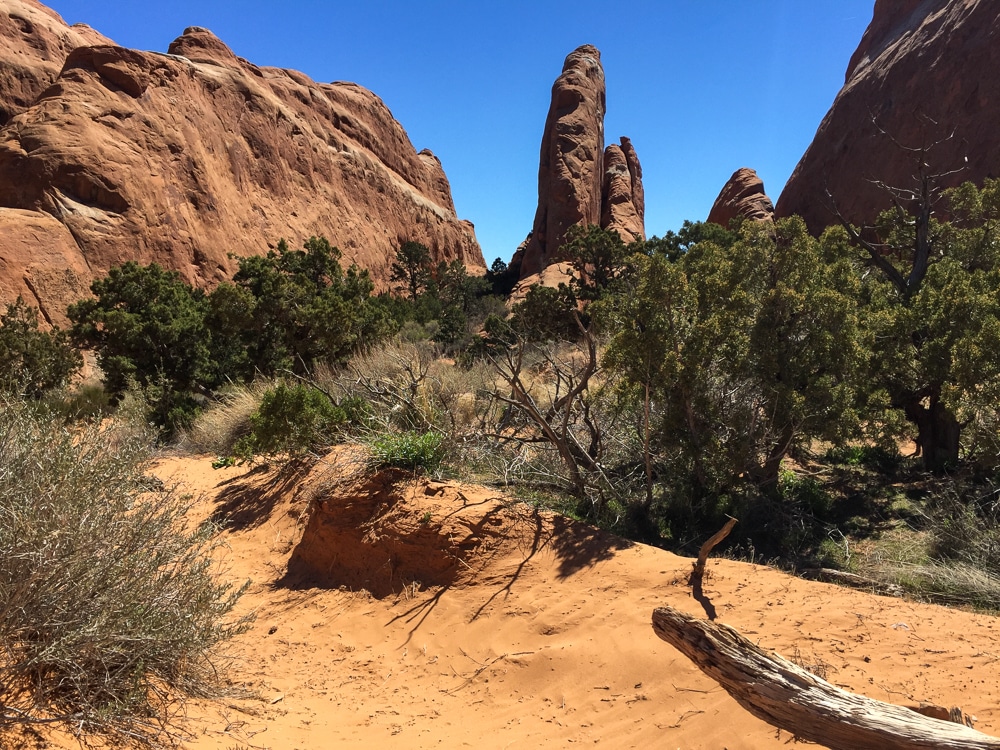
Buy the America the Beautiful Pass before your trip to get entry to any National Park for 1 year.
The pass is also valid at all places managed by the Forest Service, National Park Service, including National Monuments, the Fish and Wildlife Service, the Bureau of Land Management, the Bureau of Reclamation, and the Army Corps of Engineers.
After visiting just a few National Parks, the pass will pay for itself. Not to mention, many National Parks have separate lines for Pass holders and visitors needing to buy an entry pass. Needless to say, the lines to buy entry passes tend to move slower than those for pass holders no matter where you are.
The Pass admits a car-load of people which includes a driver and all passengers in a personal vehicle at places that charge by the vehicle. For sites that charge for each person, a total of 4 adults can enter with the pass. Kids 15 & under are free at National Parks and other related sites.
Keep in mind, the America the Beautiful Pass pays only for admission. If you need things like a campsite or an RV hookup, you’ll still need to pay the fees for these things.
Alternatively, you can find out before your trip if you qualify for another way to save money on National Park entrance fees .
1-Week Utah National Parks Road Trip Itinerary
With a 7-day itinerary for the Utah National Parks, you’ll be moving at an energetic, but totally doable, pace. You want to be efficient and maximize your time. The Utah National Parks road trip map above shows you how to do just this by limiting, or removing altogether, any backtracking between parks and streamlining where you start and end your Utah trip.
It also means arriving in Salt Lake City and departing from Las Vegas. You’ll save nearly 2 hours of driving by NOT returning to Salt Lake City to fly home. In my opinion, these hours are worth saving.
Imagine a scenario where you depart from the airport in Las Vegas at around midday. Making the drive from Zion National Park makes it possible to stay in or near the park the night before your return home to fully enjoy that day. Whereas a longer drive could mean cutting the previous day short to position yourself for your flight. Not to mention the hassle of needing a hotel near the airport for a night.
From a more dramatic standpoint, starting with the 2 National Parks in and near Moab, Arches, and Canyonlands, is an awe-inspiring start. While ending with Zion is like the magnificent grand finale of the best fireworks display you’ve ever seen.
This itinerary does not allow time for stopping at National Monuments or State Parks. Nor does it include time in Monument Valley or the Grand Canyon. You could absolutely tailor the itinerary to include 1 or more of these places but with 7 days, you’ll have to eliminate at least 1 Utah National Park.
With all that said, here’s a day-by-day look at this Utah National Parks itinerary.
Day 1- Fly into Salt Lake City –> Drive to Moab
Driving time: 3 hours 44 minutes / 239 miles.
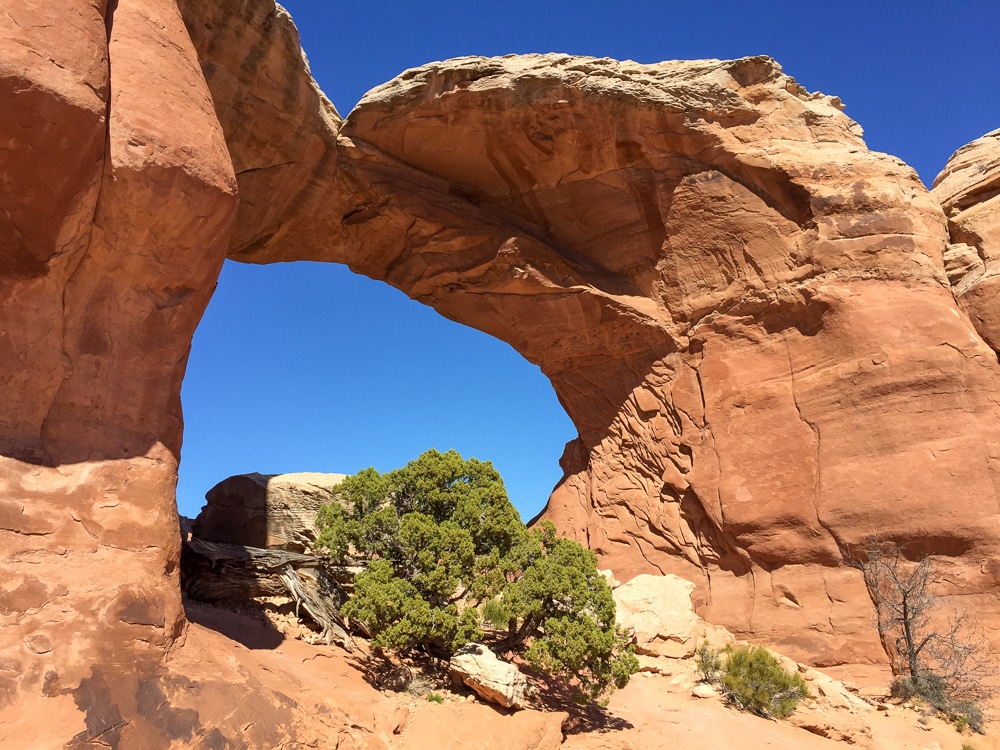
Once you’ve picked up your rental car at the airport, head southeast for just under 4 hours from Salt Lake City to Moab, Utah.
Your rental car should have a full tank of gas but, if it doesn’t, fill up at one within the first 2 hours of the drive. Likewise, stop for snacks or something to drink for the drive within this timeframe. After that, you won’t find many rest stops or exits with services until you get closer to Moab.
Once you’re in Moab, you’ll find everything you need from food to gas to lodging. If you’ve arrived with some daylight still in the sky, you’ll get your first unbelievable glimpse at the red rock landscape towering along the town’s fringes.
Use what’s left in the day to settle into your accommodations and get ready for a fresh start in the morning!
ProTip: You could also fly into Las Vegas and do this road trip in reverse, as mentioned above. It’s part of the beauty of this road trip route compared to others I’ve taken like this Oregon Coast road trip itinerary that must be done from north to south.
Where to Stay in Moab:
Stay in moab for 2 nights..
Of all the times I stayed in Moab, I enjoyed staying at the Hyatt Place Moab the best. It’s on the main road through town, close to 2 National Parks, and comes with a free breakfast. Perfect when you’re planning a day of hiking and outdoor fun!
If you’re a miles and points enthusiast like me, it’s also one of several loyalty program hotels in Moab. You can use Hyatt points to book the Hyatt Place.
Whichever Moab hotel you choose, book it for 2 nights.
Day 2- Arches National Park
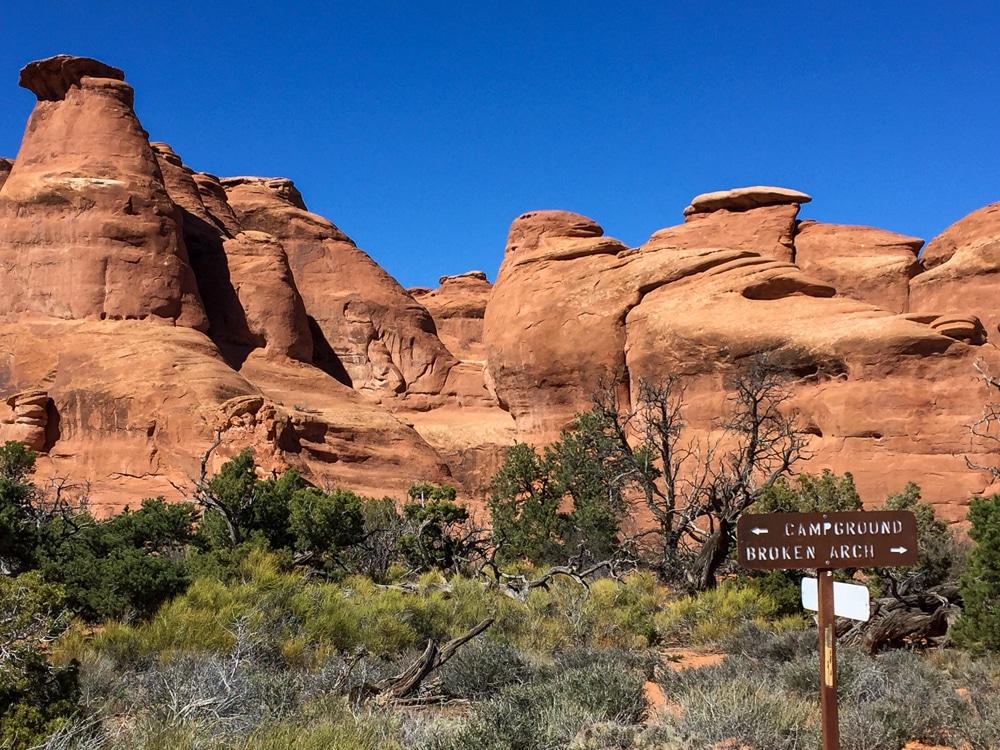
Important Info About Arches
** IMPORTANT! From April 1-October 31, you need a timed-entry reservation to enter Arches. Do this as soon as you can once the booking window for your travel dates opens. ** The park’s entrance is 5-10 minutes by car from the main road in Moab. ** Admission is $30 per private vehicle with up to 15 passengers. ** Check the official Arches National Park website for info and alerts.
If you arrived in Moab after dark, prepare yourself! The morning light reveals the orange and red rock formations surrounding the city. What’s more, it’s just a glimpse of the stunning red rock landscape and sandstone arches that await in the National Park.
Before heading to the park, pack water and lunch/snacks for the day. Moab has plenty of places to stock up. Arches heats up even in the spring and fall. The rocky desert landscape has no cover from the sun and only a couple of spots to drink from a water fountain. You want to enter the park prepared.
Be on time and arrive at Arches National Park for your timed entry slot. Luckily, the National Park is just 5-10 minutes from downtown Moab so it’s easy to reach from Moab’s main road.
Arches National Park Highlights
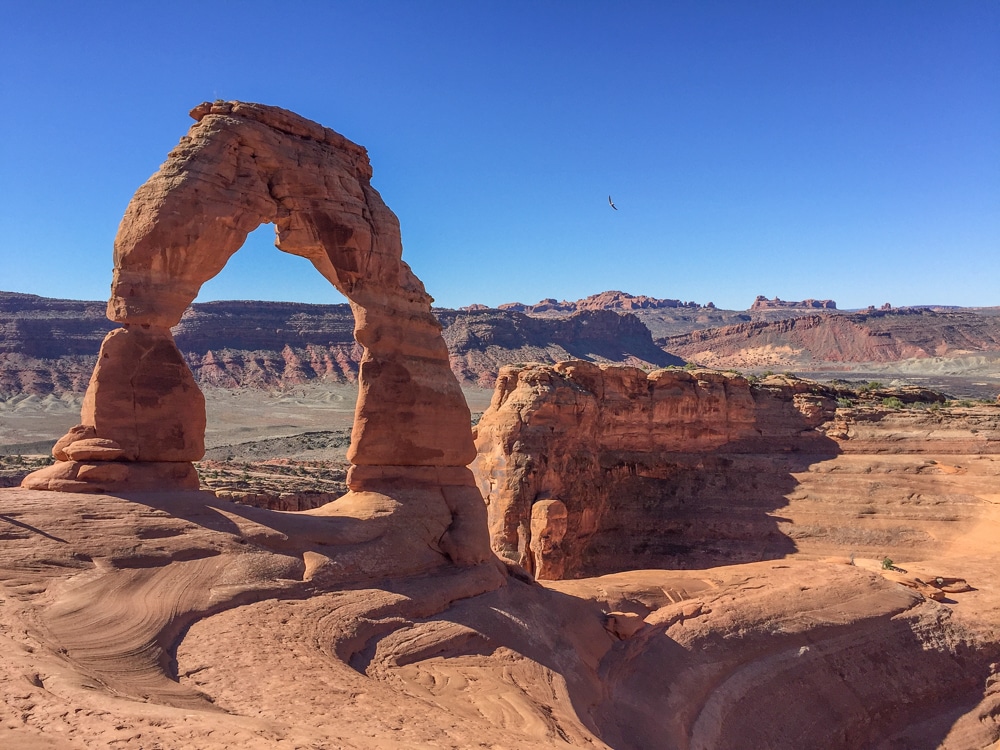
Arches National Park is appropriately named for its 2,000+ arches! Combined with balancing rocks, ridges, slopes, and towering rock faces, the park absolutely dazzles. One gorgeous vista is replaced by the next whether you’re driving along the park’s main road or hiking one of the many trails.
The park has so many things to do, it’s not possible to hike every trail in 1 day. But, with a morning start, it’s possible to see a lot and hike some of Arches’ most famous trails.
Don’t miss these top things to do in Arches National Park.
Moab Travel Tips
For a detailed arches national park guide, check out:.
How to Plan 1 Awesome Day at Arches National Park
Day 3- Canyonlands National Park –>Head to Capitol Reef Area
Driving time moab to canyonlands: 35 minutes / 31.5 miles driving time canyonlands to capitol reef area: 2 hours 50 minutes / 167 miles.
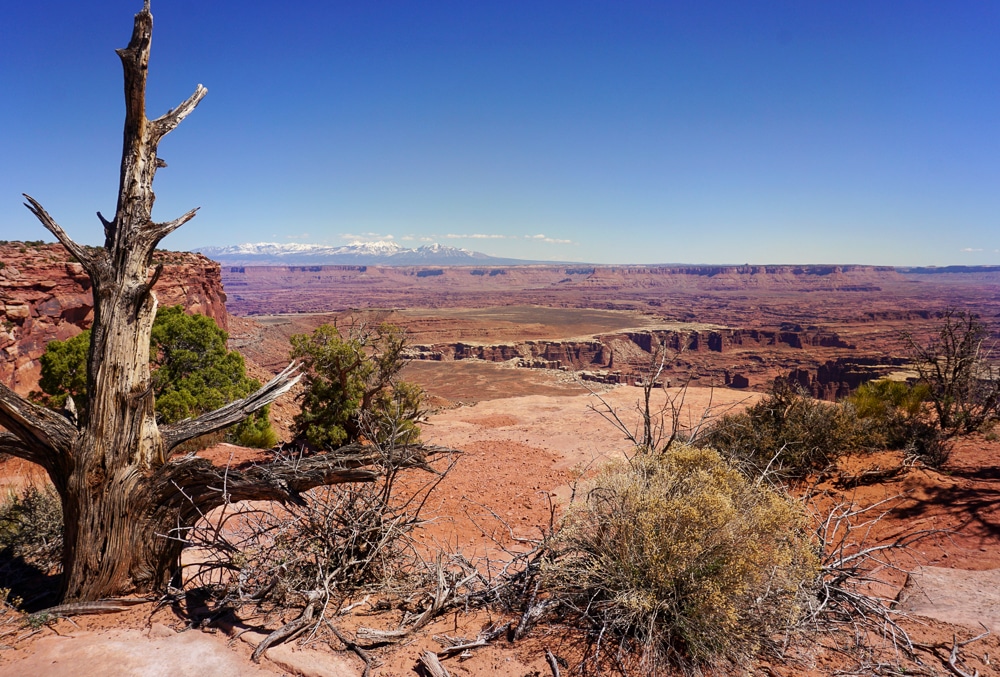
Important Info About Canyonlands
** No timed-entry reservation is needed for Canyonlands. ** Admission is $30 per private vehicle with up to 15 passengers. ** Check the official Canyonlands National Park website for info and alerts.
This morning, you’ll check out of your hotel in Moab and drive to Canyonlands National Park. It’s less than an hour from Moab, leaving you a good amount of time to enjoy a day in the park.
Before leaving town, gas up and make sure you have anything you need for lunch, snacks, and drinks so you’re set for the day because you won’t find service at Canyonlands other than a water station at the visitor’s center.
Canyonlands National Park is divided into 3 land districts. The Island in the Sky section of the park is by far the most visited area and the one you’ll be heading to today. I’ve also spent time in this part of the park. The Maze and Needles Districts are more rugged and better suited for backcountry pursuits and those who are experienced in that type of terrain.
Just before reaching Canyonlands entrance and visitor’s center, take a detour into Dead Horse Point State Park. The lookout at Dead Horse Point Overlook is a must-see!
After this brief stop, return to the main road and on to the entrance of Canyonlands National Park.
Canyonlands National Park Highlights
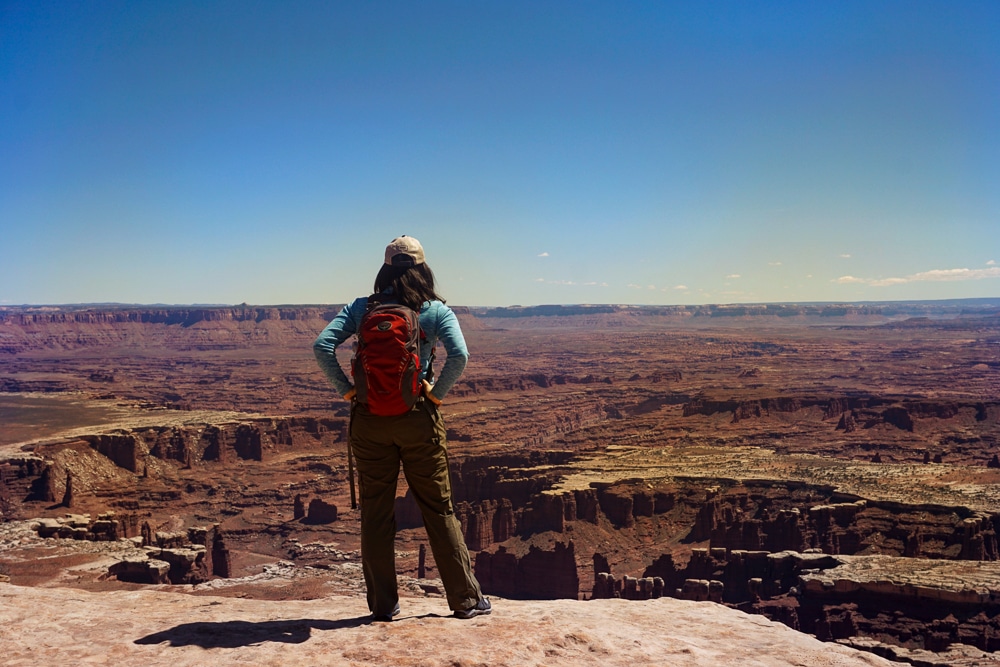
Canyonlands sits in the high desert. Its canyons, arches, mesas, and rock formations were painstakingly shaped by water, gravity, and the elements over millions of years. Compared to Arches National Park, Canyonlands is much more rugged and wild.
Whereas arches like Delicate Arch or Double Arch look as if they were shaped by the hand of a skilled sculptor, the rock formations and desert landscape at Canyonlands has a harsher, rougher feel.
Canyonlands Island in the Sky District can be visited and enjoyed in 1 day. The park has some of the best off-roading anywhere and numerous challenging hikes but fortunately those of us who stay on top of the Island in the Sky mesa don’t miss out on anything.
Aside from hikes or short walks, Canyonlands has one beautiful scenic overlook after another. No need to rush. Simply enjoy your time in the park today.
Here are some of the best things to do at Canyonlands National Park.
Canyonlands also has off-roading but you need to have the right vehicle and potentially a permit as is the case with White Rim Road. But if you’re looking for a thrill and you have an SUV or a vehicle with high clearance, you could take a drive below the rim of the mesa along Shafer Canyon Road. It’ll take a couple of hours and doesn’t require a permit.
Canyonlands Travel Tips
For a guide about 1 day at canyonlands, check out:.
How to Spend an Inspiring Day at Canyonlands National Park
Where to Stay Tonight:
Stay near capitol reef national park for 1 night..
By late afternoon, say goodbye to Canyonlands and begin the drive to the Capitol Reef National Park area. The drive is just under 3 hours. The park’s visitor center is in the tiny town of Torrey.
There, you’ll find hotels and places to have some dinner before calling it a (fantastic) day.
I recommend the Skyridge Inn because the rooms are cozy and a hearty breakfast is included in your stay. And sitting just 7 miles from the Capitol Reef, you’ll get to the park easily in the morning. Not to mention, the property views are gorgeous!
Torrey has accommodation options for all budgets so compare hotel prices to see which matches your budget.
Where to Stay Tonight Alternative- Monument Valley
Stay in monument valley for 1 night..
As you plan your Utah National Parks road trip, it’s hard to decide what to see and do especially if you have just 7 days. This area of southern Utah and into northern Arizona is jam-packed with incredible sights.
I’ve followed the route above going to each of Utah’s “Mighty 5” National Parks and I’ve also gone from Canyonlands to Monument Valley. The drive is just 3 hours and 15 minutes to Monument Valley and brings you to one of the most iconic natural landmarks in the entire United States.
If you’d rather see Monument Valley, it’s an easy switch. Instead of driving from Canyonlands to Capitol Reef, head south on Route 191 to Monument Valley. (Be sure to have a full tank of gas and snacks as rest stops are far and few between.)
When you arrive in Monument Valley, you’ll have only a couple of hotel options. I highly recommend The View Hotel in the Navajo Nation or the Goulding’s Lodge just 2 minutes away. These hotels are directly in Monument Valley so it’s very convenient for exploring Monument Valley the next morning.
Plan to stay 1 night at either hotel. You can compare prices and availability here .
ProTip: On the way from Canyonlands to Monument Valley, stop to see Mexican Hat Rock and Forrest Gump Point if you have the time. They’re both along the way and don’t require a detour. If it’s already late, you see them tomorrow.
Day 4- Capitol Reef National Park –>Drive to Bryce Canyon
Driving time capitol reef to bryce canyon: 2 hours 13 minutes / 117 miles.
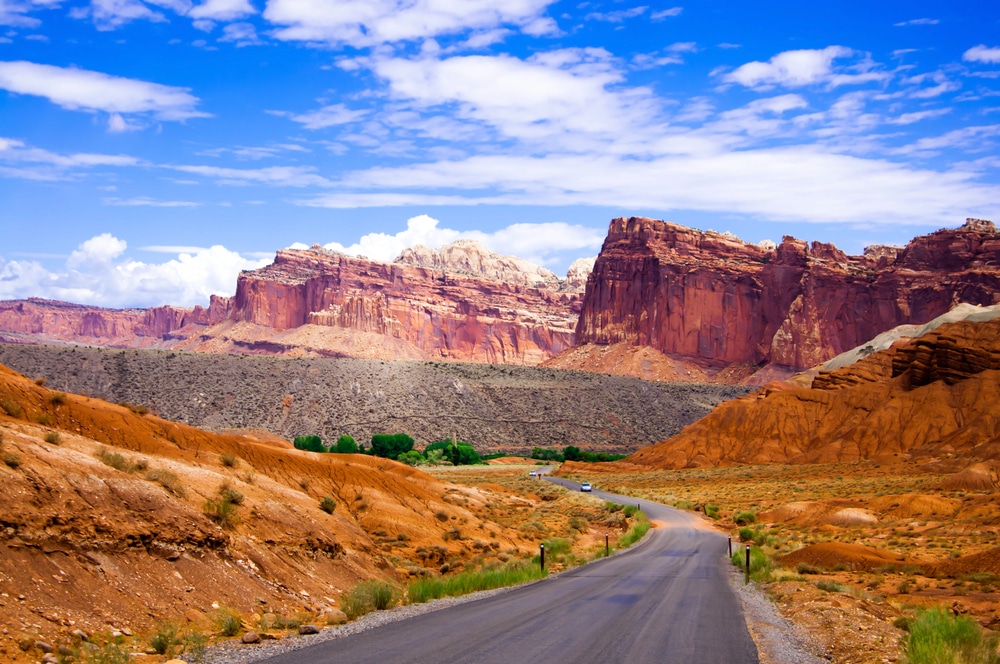
Important Info About Capitol Reef
** No timed-entry reservation is needed for Capitol Reef. ** Admission is $20 per private vehicle with up to 15 passengers. ** Check the official Capitol Reef National Park website for info and alerts.
Capitol Reef sits along a “wrinkle” in the Earth’s crust. Officially, it’s called a monocline which is a waterpocket fold and in this case, runs for 100 miles. The National Park itself is 60 miles long but only 6 miles wide
When the fault lines in the Earth shifted millions of years ago, the sides weren’t equally lifted. In Capitol Reef’s case, the crust on the west side ended up higher than on the east side. As a result, water sits in the fold and wears away the layers of rock and things like domes, canyons, and even fossils come to light.
It’s hard to imagine how all of this geology happens. But it’s actually when you visit Capitol Reef and try to put this scientific knowledge in context as you stare at the gorgeous landscape in front of you.
For me, it was even more mind-blowing to realize that a canyon, dome, or arch was only in plain sight because of the layers that had been worn away all because of the uneven shifting in the Earth’s crust!
Capitol Reef Highlights
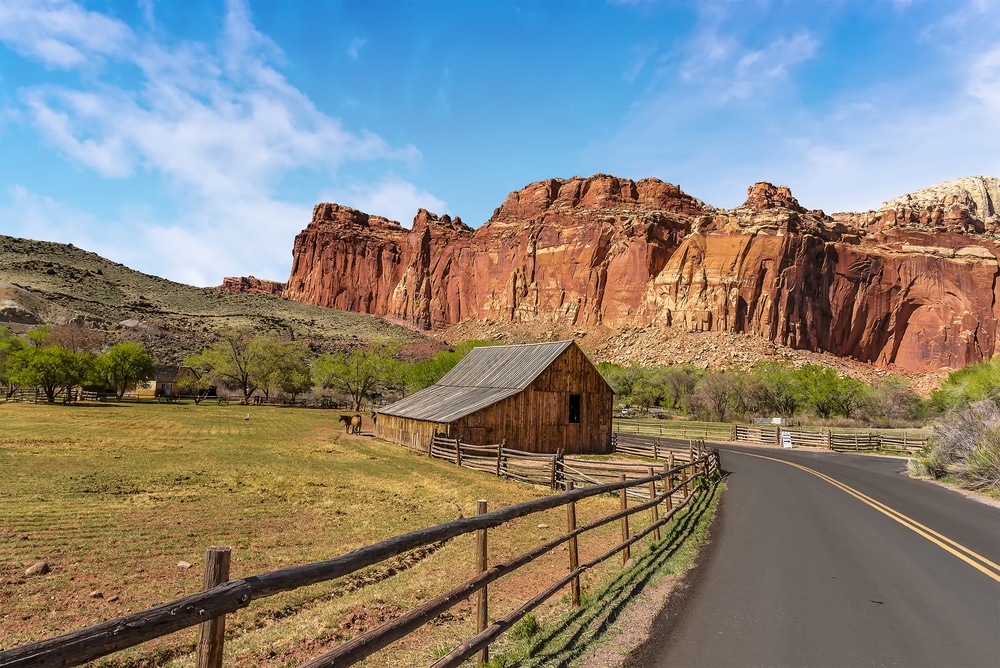
Capitol Reef has fantastic hikes and scenic landscapes as you drive along the part of the park along Highway 24. The rock formations together with the desert panorama create some of the most striking views among Utah’s Mighty 5. And in many areas of the park, you’ll find trails that feel light years away from the crowds at Arches National Park.
The main part of Capitol Reef also has a historic settlement called the Fruita District. It was here where the first Mormon pioneer settlers came. In 1 day or part of a day, you can see some of these natural and historic highlights.
Here are some of the best things to do at Capitol Reef.
Capitol Reef Travel Tips
Day 4 alternative- monument valley –> drive to bryce canyon, driving time monument valley to bryce canyon: 4 hours 33 minutes / 274 miles.
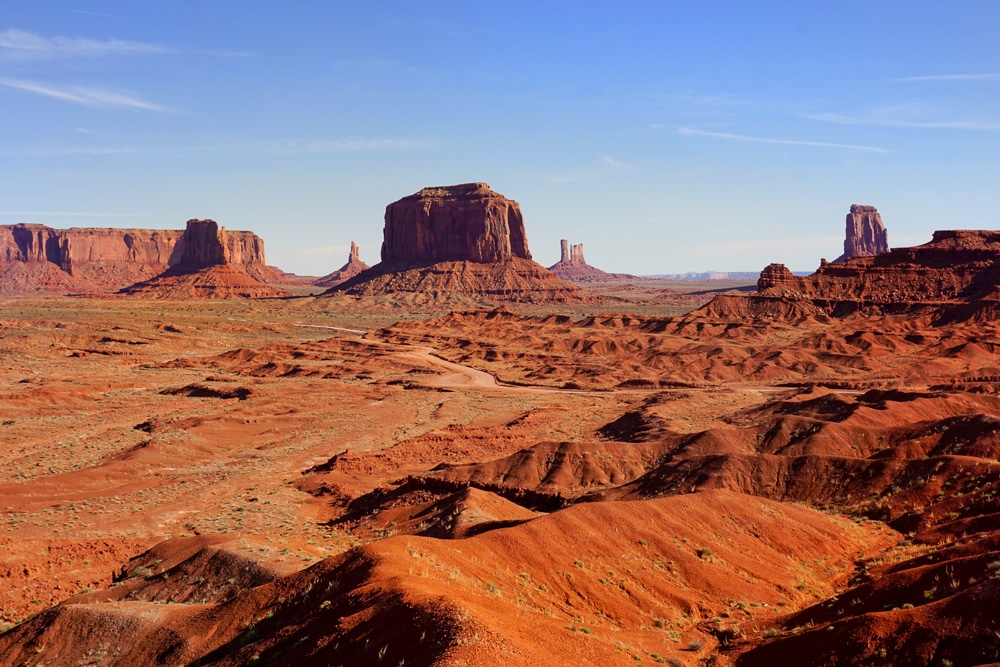
Tumbleweed blows across the open valley. Iconic sandstone monuments dot the landscape. You’ll feel as if you’ve stepped into a scene from an old Western with a bunch of cowboys chasing down a group of thieves! (Or perhaps you’d like to take your perfect Forrest Gump shot.)
The most popular mesas, buttes, and spires are along a 17-mile loop within the Monument Valley Navajo Tribal Park. You can join a guided tour or drive yourself.
I drove my small rental car with no problem. Yes, the road is rough and bumpy, but if you drive slowly and carefully, you’ll be fine. Choosing the self-driving option also allowed me to enjoy the views at my own pace.
However, the upside to a tour with a Navajo guide is you can access more of the tribal park. Some areas are closed to visitors and can only be visited with a guide. Plus, you’ll get more context of what the rock formations in Monument Valley symbolize in the Navajo culture.
Here are the best things to do in Monument Valley.
For a detailed Monument Valley Guide, check out:
Everything You Need to Know for an Epic Visit to Monument Valley
Where to Stay Tonight- Bryce Canyon
Stay in bryce canyon for 1 night..
ProTip: Your hotel in Bryce Canyon should be among the first things you book for your Utah National Park road trip. There are only a few hotel options in Bryce. Once they sell out, there aren’t really any other options in the immediate surrounding area.
No matter what you choose to do for Day 4 of your Utah National Park itinerary, you’ll stay the night in Bryce Canyon to position yourself for tomorrow’s visit.
If you’re driving from Capitol Reef, the drive is straightforward. You can comfortably enjoy the day at the National Park and later in the afternoon start the drive to Bryce.
If you’re driving from Monument Valley, you’ll be heading west and then north to Bryce. Along the way, look out for Page, Arizona, home to the famous Horseshoe Bend.
If you can manage a quick stop, you’ll have gotten a bonus and checked off a fantastic spot that’s a must for every Arizona road trip . Plus, it comes at about the halfway point in the drive, so it’s a perfect time to stretch your legs and find bathrooms. A short hike (1.4 miles round trip on a flat, paved path) at Horseshoe Bend leads to the popular scenic overlook.
Afterward, continue to your hotel in Bryce Canyon. Depending on what time it gets dark when you visit, you may even make it to Bryce Canyon to see the hoodoos lit up at sunset.
Bryce is a tiny town right at the edge of the National Park entrance. I stayed at the Best Western Plus Ruby’s Inn and had a comfortable stay. I’ve also looked at the Best Western Plus Bryce Canyon Grand just across the street but the availability didn’t fit what I needed.
Whichever you choose, book a room for 1 night.
Day 5- Bryce Canyon National Park –> Zion National Park
Driving time bryce canyon to zion: 1 hour 45 minutes / 82 miles.
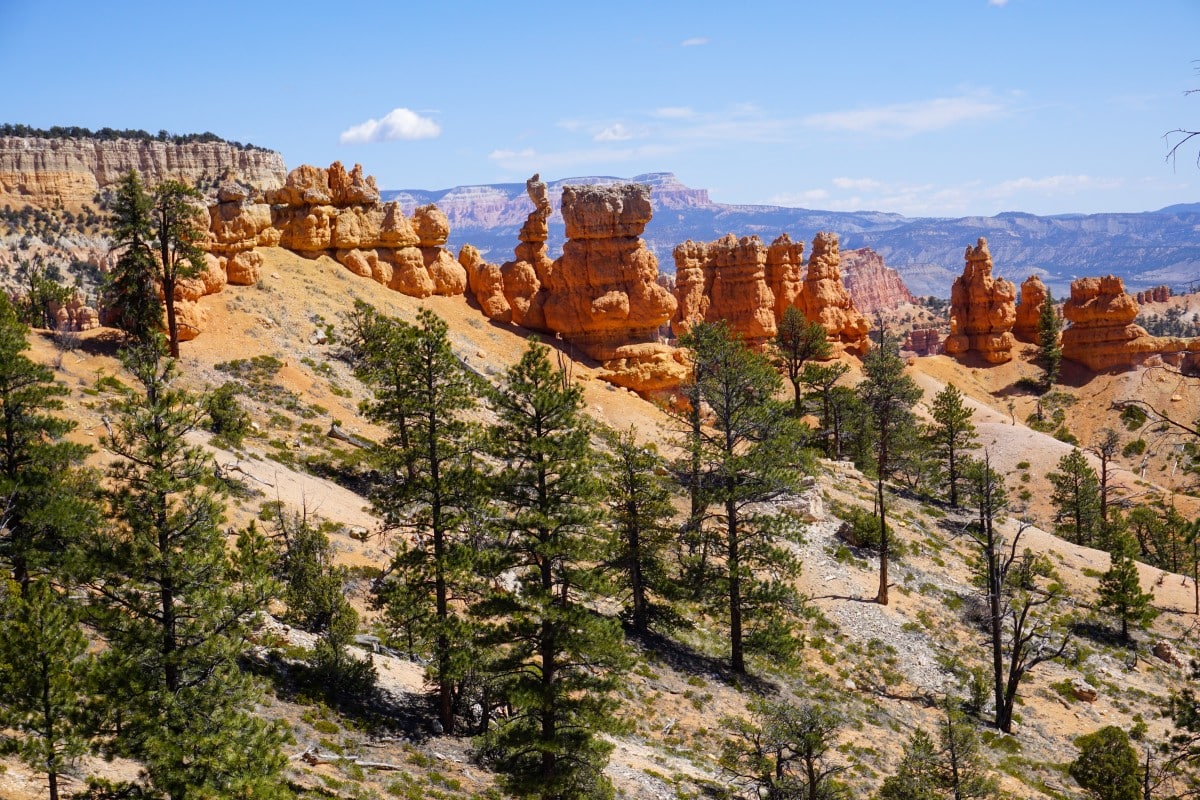
Important Info About Bryce Canyon
** No timed-entry reservation is needed for Bryce Canyon National Park. ** Admission is $35 per private vehicle with up to 15 passengers. ** Check the official Bryce Canyon National Park website for info and alerts.
Bryce Canyon National Park is like descending into a fairytale land where sandstone hoodoos stare up at you from a natural amphitheater and show off their brilliant shades of orange, pink, and red.
If you’ve never heard of a hoodoo before, it’s the geological name for irregular columns of rock. And Bryce Canyon has more hoodoos grouped together than any other place on the planet.
No matter how many National Parks you’ve visited, once you visit Bryce you’ll understand what I mean when I say, this National Park is like no other. Bryce Canyon and its hoodoo amphitheater are beyond impressive!
Bryce Canyon Highlights
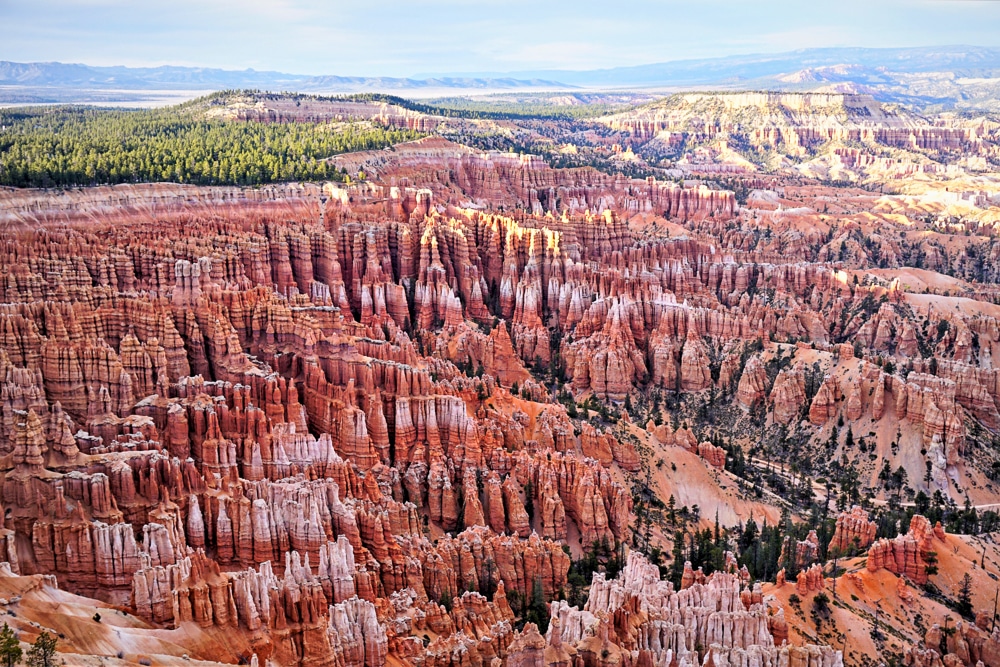
The National Park’s main road sits up on a plateau and runs for 18 miles from north to south with the Hoodoo amphitheater visible from a series of viewpoints and overlooks. Some of these pull-offs and parking areas also have trailheads. Some hiking trails wind along the rim of the canyon. Others lead down into the canyon.
The best part of this layout is that everyone can enjoy the jaw-dropping beauty of Bryce Canyon, either by hopping from overlook to overlook in a car, hiking along the park’s trails, or a combination of both.
Depending on how early you start your day and how much (if any) hiking you’re planning in Bryce Canyon, you can spend half a day here or more. Even with 1 of the hikes below, you still have plenty of time to see the amphitheater from several viewpoints and leave by early afternoon.
That being said, you can also spend the full day in Bryce Canyon National Park. There are plenty of trails and photography opportunities to enjoy.
I would also factor in whether your trip to the Utah National Parks ends on Day 7 or you can fly home on Day 8. Ultimately, you want to make sure you have enough time for magnificent Zion National Park.
Here are the best things to do in Bryce Canyon National Park.
Bryce Canyon Travel Tips
For more bryce canyon inspiration and tips, check out this guide..
25 Photos to Make You Want to Visit Bryce Canyon National Park
Where to Stay Tonight- Springdale, Zion National Park
Stay in springdale canyon for 2-3 nights depending on when you fly home..
Make your way from Bryce Canyon to Springdale Utah. Be sure to use the Mount Carmel Highway and Tunnel to enter Zion and the town. It’s an engineering marvel but the views before and after the tunnel are incredible.
Springdale, Utah is the park’s gateway town . You’ll find everything you need from lodging and food to tour and gear shops. Not to mention, it’s a cute little town that has everything you’d want after a day spent in the National Park.
I highly recommend the Holiday Inn Express in Springdale. Not only was it the nicest Holiday Inn Express I’ve stayed in, it had a pool, free breakfast, and the free town shuttle bus to Zion stopped just outside.
Outside of the winter months, cars aren’t allowed to drive into Zion. Instead, visitors take the Zion’s shuttles to enter and move around the park. The town shuttle bus outside the Holiday Inn Express brings you to these Zion shuttles which is a logistical life-saver. There’s absolutely nowhere to park near Zion’s entrance so it’s smarter to keep your car parked at the hotel and make use of the shuttles.
The town shuttle makes stops along the main road through Springdale. You can compare prices at hotels along this road to find the best option for your travel dates.
Days 6 & 7- Zion National Park
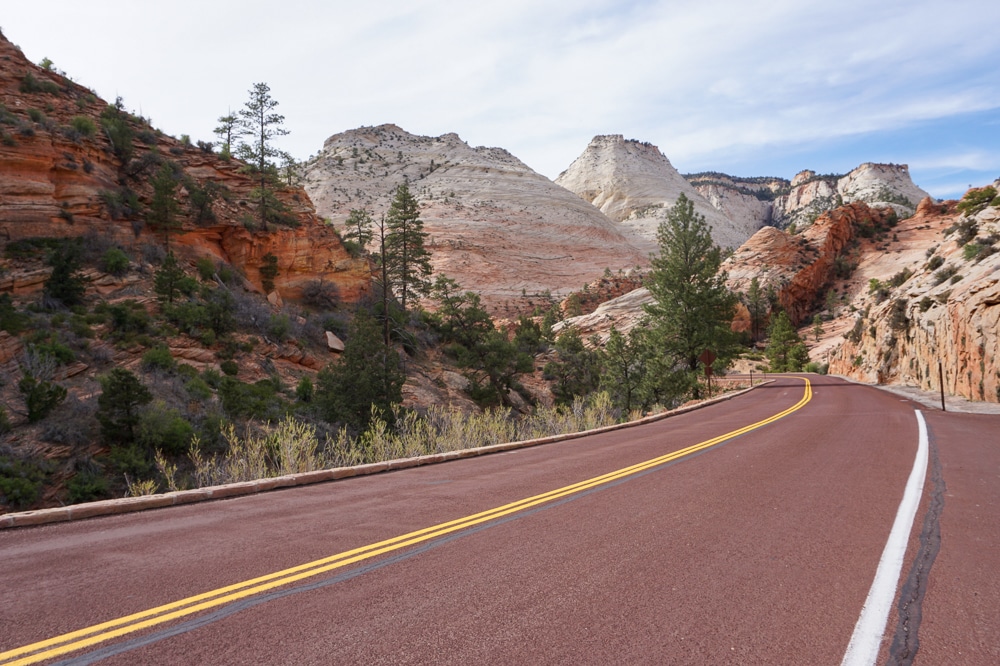
Important Info About Zion
** No timed-entry reservation is needed to enter Zion National Park. **You DO need a permit to hike Angels Landing to the Canyon overlook. ** Admission is $35 per private vehicle with up to 15 passengers. ** Check the official Zion National Park website for info and alerts. **Since you won’t be in your car, remember to bring your America the Beautiful Pass if you have one to enter the park.
Zion National Park grabs you by the senses and overwhelms you with its magnificence. You’ll understand how special Zion truly is from the moment you drive along the Mount Carmel Scenic Highway with its towering mountains on all sides.
Despite all the red rock landscapes you’ve seen up to this point on your Utah National Parks road trip, Zion will leave you in awe. The towering walls of rock with the Virgin River flowing and the greenery complementing the backdrop combine for absolute natural perfection.
Zion Canyon was shaped over millions of years. The landscape that we see today is home to all different types of plants and animals. I saw more animals in Zion than at any other Utah National Park, including lots of babies on my spring visit! So when you’re driving the Mount Carmel Scenic Highway or out on the hiking trail be mindful and respectful.
Zion National Park Highlights
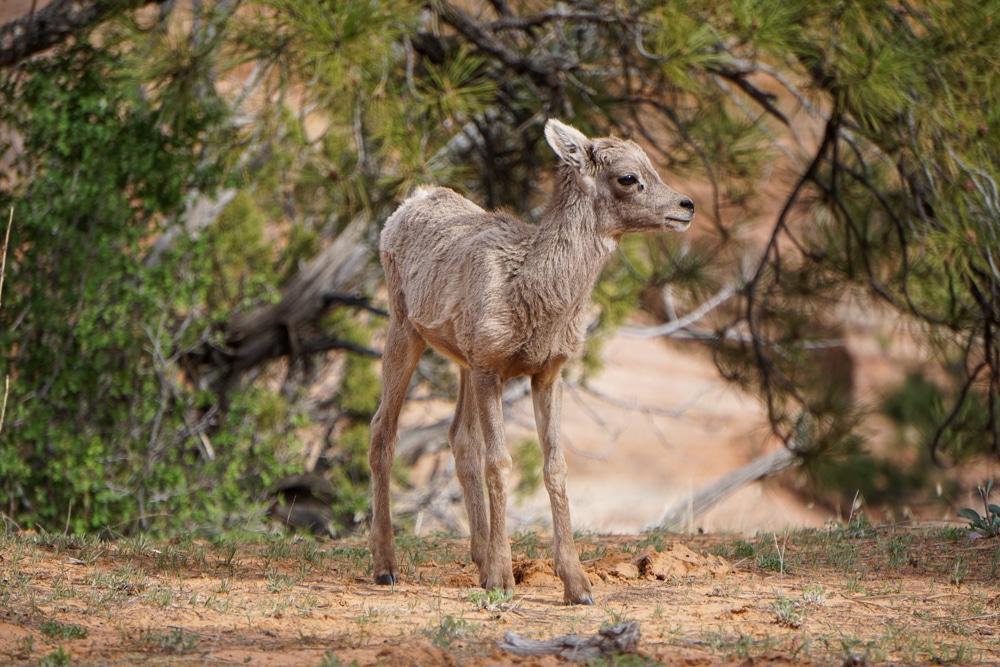
Zion offers an endless number of activities for every type of adventurer across its 230 square miles of outdoor heaven. Hike, horseback ride, mountain climb, and spot wildlife to your heart’s content. There are also guided excursions into Zion’s slot canyons and The Narrows .
Zion National Park’s most famous hike is to Angels Landing. This strenuous and steep hike takes you to the lookout over Zion Canyon. As mentioned above, you must get a permit for Angels Landing as the park works to limit the number of people on the narrow and rocky climb to the top. Apply for a permit as soon as you’re able to get the date and time you want.
If you’re physically fit and not afraid of heights, I highly recommend giving Angels a try! It’s a tough climb and you absolutely have to be careful. But, the view and the accomplishment are worthwhile rewards.
To enter the park, catch the Zion National Park Shuttle from the entrance in Springdale to different points within the park. Shuttles run continuously to pick up and drop off park visitors at popular sights and trails throughout the park.
Here are the best things to do in Zion National Park.
Zion National Park Travel Tips
For a complete zion national park guide, check out:.
What You Need to Know for a Successful Zion National Park Visit
8 Spectacular Things to Do at Zion National Park
Climbing Angels Landing Hike at Zion National Park
Day 7-8 Zion National Park –> Las Vegas Airport
Driving time zion to las vegas airport: 2 hours 35 minutes / 170 miles.
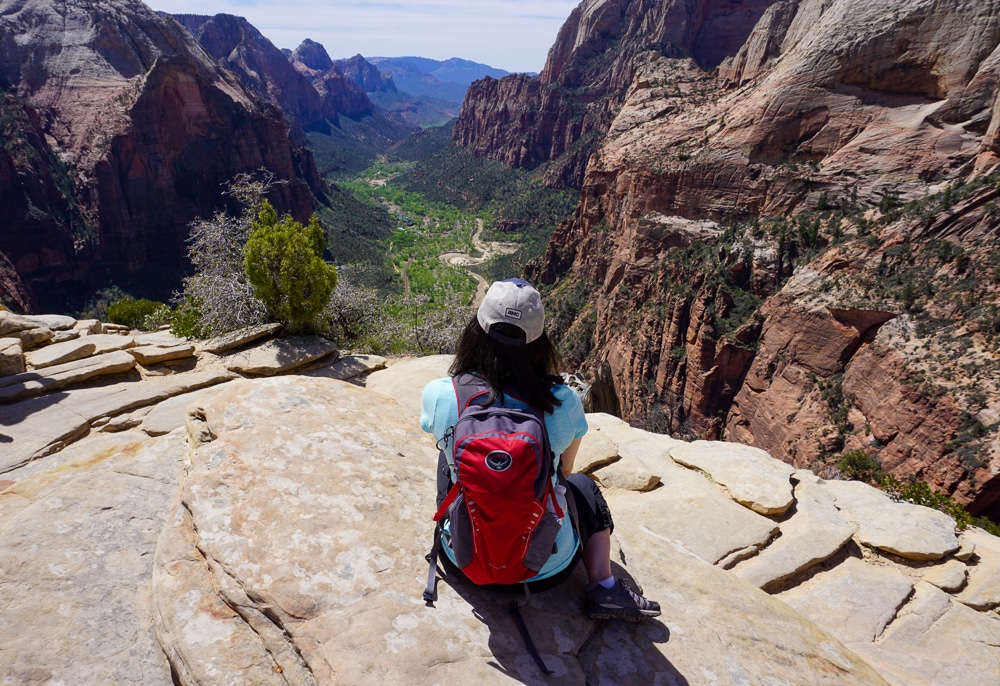
If you’re like me sitting on top of Angels Landing at the end of my time in Zion, you won’t want to leave! But unfortunately, it’s time to check out of your hotel in Springdale and end your Utah road trip.
Depending on when you need to fly home, you could plan to depart on the evening of Day 7 so that you can still possibly have a couple of morning hours in Zion before heading to the airport.
If you can, head home on the morning of Day 8 so you can enjoy all of Day 7 at Zion.
Tearfully, say goodbye to Zion and make the 2.5-hour drive to Las Vegas. Plan to return your rental car at the airport. Then, head for home with unforgettable memories from your fantastic Utah National Parks road trip!
Planning a longer Utah National Parks Trip?
Lucky you! There’s so much more to see and do at each National Park than what you’ll be able to cover with just the week itinerary above. And the area around the National Parks in Utah and Arizona has so many iconic natural icons.
So while you could simply plan to spend more time in one or more of the above National Parks, you could also look to expand on your Utah itinerary. The ideas below give you an idea of how to do this.
Utah’s Mighty 5 + Monument Valley & the Grand Canyon
Day1: Fly into Las Vegas Day 2: Zion Day 3: Zion Day 4: Bryce Day 5: Capitol Reef Day 6: Arches Day 7: Canyonlands Island in the Sky Day 8: Monument Valley Day 9: Grand Canyon South Rim Day 10: Grand Canyon South Rim Day 11: Fly out of Las Vegas or Phoenix
Utah’s National Parks + Monument Valley & Page, AZ
Day1: Fly into Salt Lake City Day 2: Arches Day 3: Canyonlands Island in the Sky Day 4: Capitol Reef Day 5: Monument Valley Day 6: Page, AZ: Horseshoe Bend & Antelope Canyon Day 7: Bryce Day 8: Zion Day 9: Zion Day 10: Fly out of Las Vegas
Zion, Bryce, Natural Landmarks, Monument Valley, & Grand Canyon
Day1: Fly into Las Vegas Day 2: Zion Day 3: Zion Day 4: Bryce Day 5: Grand Staircase-Escalante National Monument Day 6: Page, AZ: Horseshoe Bend & Antelope Canyon Day 7: Monument Valley Day 8: Grand Canyon South Rim Day 9: Grand Canyon South Rim Day 10: Fly out of Las Vegas or Phoenix
More Ideas to Plan Your Road Trip to Utah & Beyond
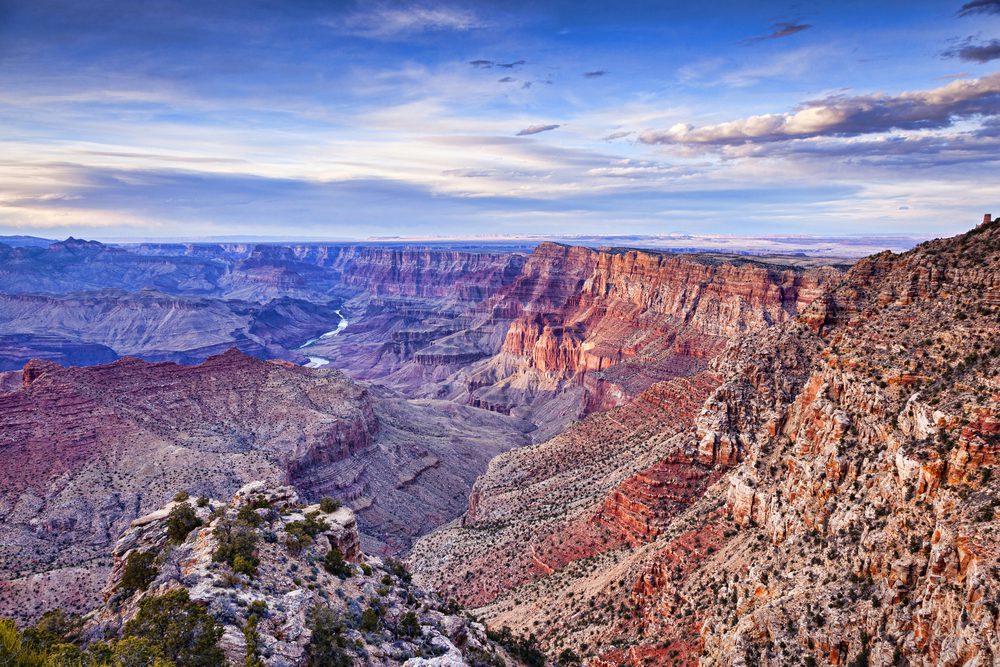
Plenty of visitors add a few days to their trip to see Flagstaff and the Grand Canyon . You could include these places along with Monument Valley and/or Zion National Park, and more Utah National Parks depending on how much time you have.
Antelope Canyon is a natural wonder between Monument Valley and Bryce and Zion National Parks. Why not plan extra time in the area to take a guided tour ? You could also visit Horseshoe Bend!
Arizona and Utah are great road trip partners! Why not do part of an Arizona road trip along with seeing some of Utah’s National Parks? You could even head south towards Tempe and Tuscon.
Spend 1-2 days in Las Vegas. After a week of outdoor fun in Utah’s National Parks, a posh Las Vegas hotel, fine food, and some nightlife might be the perfect way to end your vacation.
Looking to do an extended road trip out west? You could easily start with a Colorado road trip and then cross the border to reach Moab to begin your Utah road trip itinerary. You could fly into Denver and out of Salt Lake City, for example, while seeing National Parks like Rocky Mountain, Black Canyon of the Gunnison, Mesa Verde, Canyonlands, and Arches plus Monument Valley.
When is the Best Time to Do a Utah National Parks Road Trip?
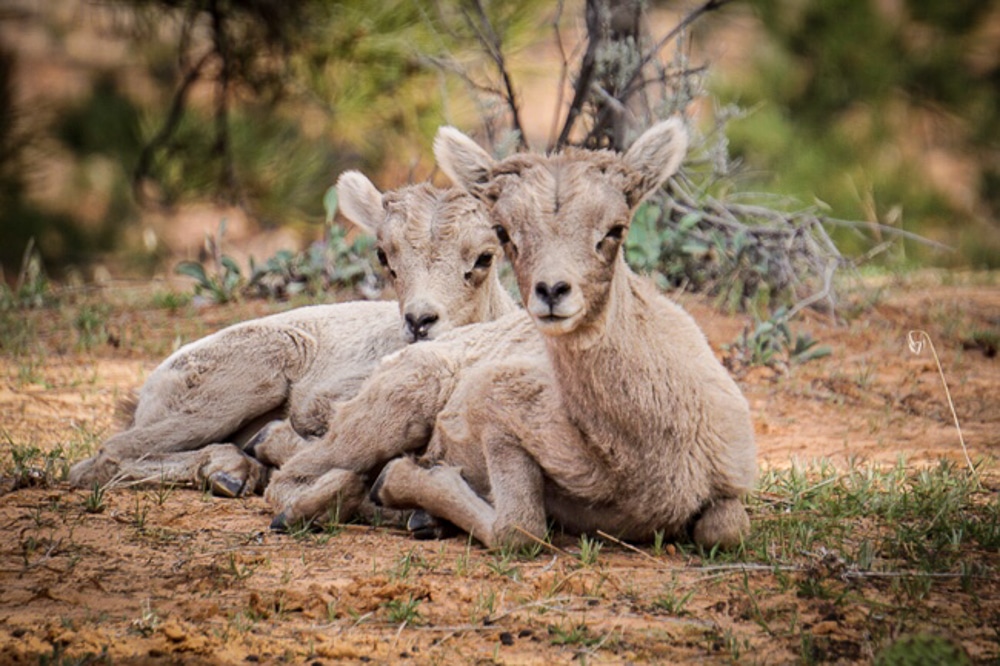
Spring and Fall are the best times to do a Utah National Park road trip. The temperatures are more pleasant and most snow (in spring) will be melted, clearing the way for hikers and park visitors to once again use most trails.
That being said, you should try your best to plan a spring or fall Utah trip outside of school holiday weeks, long weekends, and free National Park Days. The parks have large crowds around this time. And with higher demand comes higher prices for everything from flights to hotels to rental cars.
Also, keep in mind that spring snowmelt can create elevated water levels and stronger currents and rivers and streams. So popular hikes like The Narrows in Zion National Park could be closed if the conditions are unsafe.
What about Visiting the Utah National Parks in the Summer?
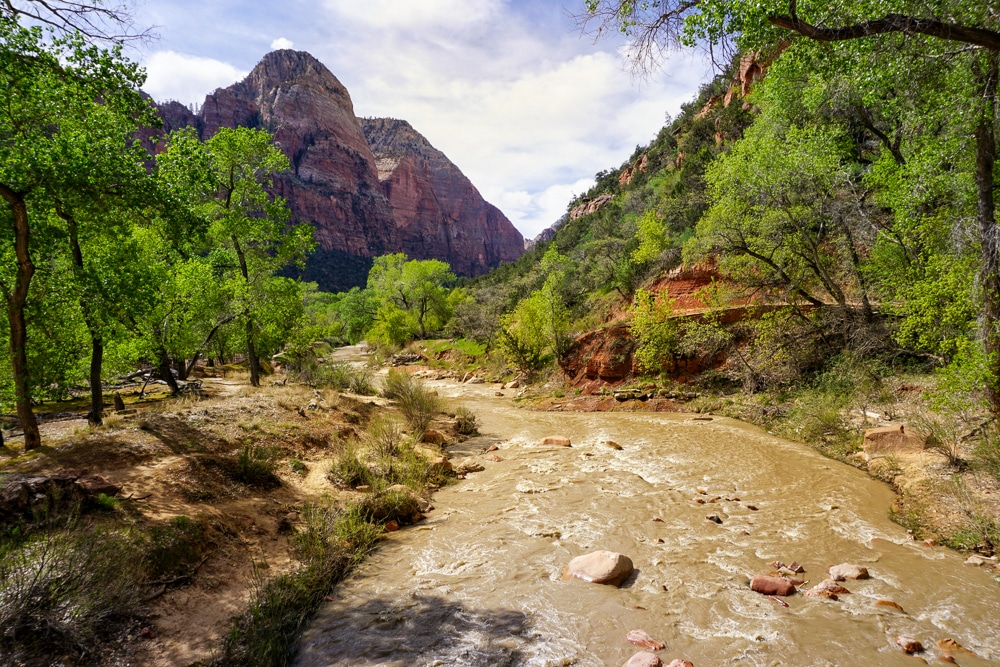
Both of these seasons have their pros and cons. But I’ll cut right to the point and say that given the choice, I’d visit in winter over summer. Here’s why.
The summer months come with extremely high temperatures like 95+ degrees. This doesn’t factor in the real feel temperature that comes from the strong sun exposure. Because of the terrain, most areas of the Utah National Parks get full sun with few areas to find shade. This can make the midday hours unbearable for hiking and other outdoor activities.
Summers are also quite busy given that families take vacations while students are off from school. As mentioned above, Arches National Park requires a timed-entry reservation to help manage the number of visitors.
What about Visiting the Utah National Parks in Winter?
On the other hand, winters come with no crowds and don’t require reservations. You’ll feel like you have the parks to yourself! Less demand also means it’s a much more affordable time to visit. You’ll find the best prices for hotels, especially, during the winter.
Of course, the truth that we can’t overlook is the temperatures that hover from the 30s-50s in December, January, and February. Snow is possible, although days tend to be sunny and dry. More likely, you’ll see a possible lighter dusting of snow in higher elevations while much of the red rock terrain and iconic arches are just as beautiful as any other time of year.
The one exception here is Zion, which tends to be wet during the winter. This could lead to snow or ice accumulating on the trails, forcing the park to close them until they are safe again.
I’d much rather layer up and hike on cooler sunny days. With the right hiking clothes and a combination of body heat, the temperatures are more ideal than those in summer.
If you decide to visit Utah’s Mighty 5 in winter, check the conditions in each park before your visit to know, too, if any roads or trails are closed because of snow or ice.
Is It Possible to Do 2 National Parks in 1 Day?
While it might be logistically possible, like with Arches and Canyonlands or Zion and Bryce, because of their proximity to each other. However, I would not recommend this at all.
Not only would you miss seeing and doing many things in each National Park, but you’d also likely feel very rushed and quite unsatisfied. At this pace, you’d never get a feel for any place you were in or truly be able to enjoy the beauty of a National Parks road trip…to be outdoors and connect with nature.
Utah National Parks Road Trip Bottom Line
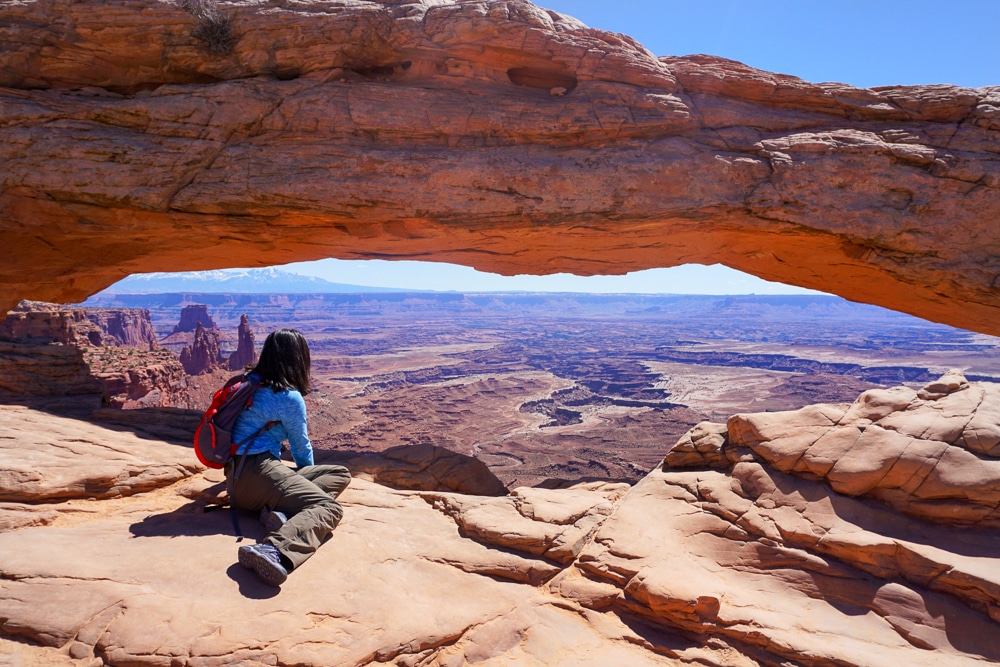
Planning a Utah trip is an absolute bucket list experience! You get to see and enjoy some of the most iconic National Parks, natural places, landmarks, and monuments in the United States.
Whether you have a week, 10 days, or more, there is an endless number of Utah itineraries that you can plan. Having traveled extensively through this part of the country, I can assure you that you can’t go wrong no matter what your Utah road trip looks like! So, let’s get planning!
What are you planning to see and do on your Utah National Parks road trip itinerary?
Like this post? Please share it on social media using the share buttons below.
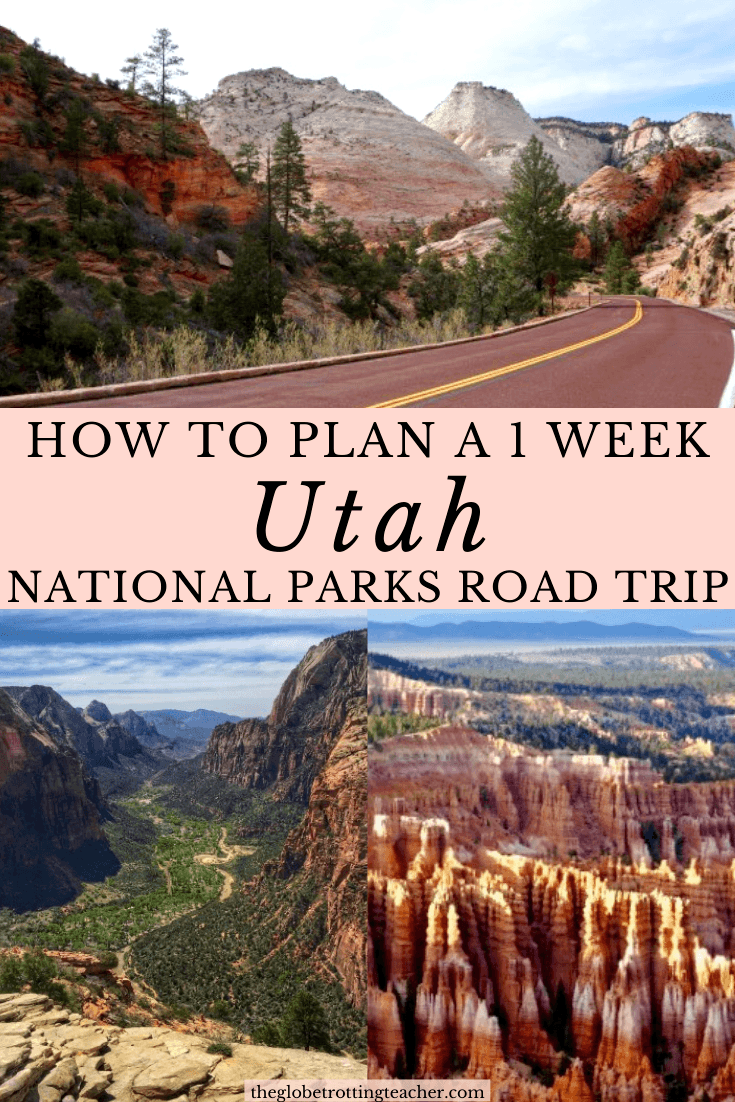
Related Posts

Why You Should Drive the Icefields Parkway + Trip Planning Tips
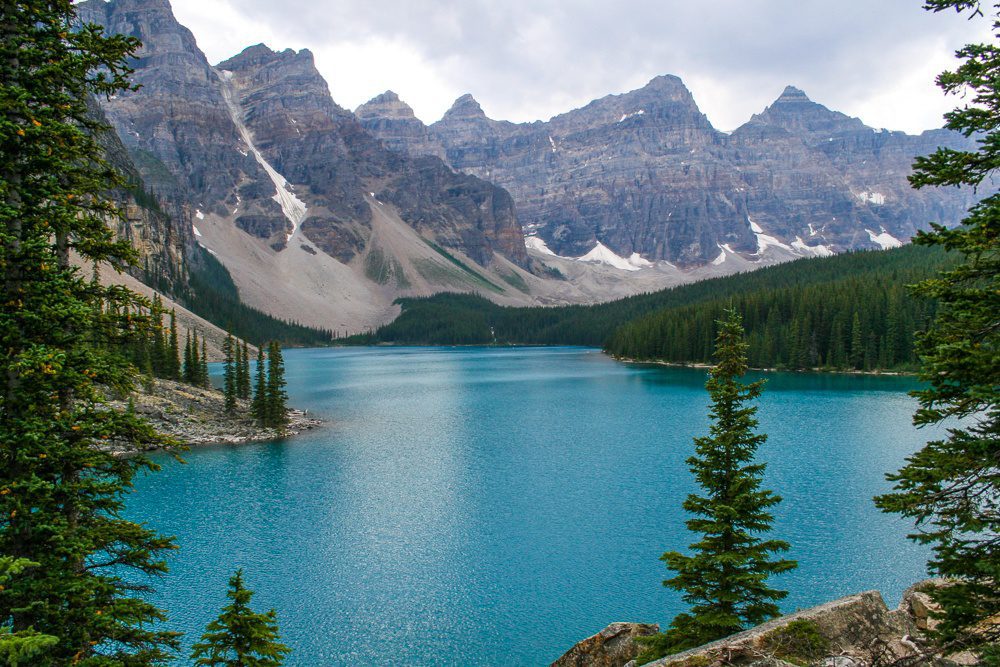
3 Reasons to Visit Banff National Park Immediately
128 thoughts on “utah national parks road trip itinerary: your 2024 guide”.
I don’t know when Utah will happen in my life. You have triggered my travel pangs to the place. The itinerary is well detailed but at the same time I could not choose one over the other.
Luckily, Indrani, you can see and explore these parks with just a week. Plenty of time to visit other places in the USA, too.
What a remarkable landscape. Utah National Parks is one of the prime reasons I want to visit USA for. This post makes it look very do-able…thanks for this.
Thanks for reading, Punita.The Utah National Parks would have to be up there in the top 5 or 10 USA experiences to have.
We briefly ventured in to Utah when we lived in Arizona and did visit Monument Valley, which is gorgeous. But we’d love to go back and Arches NP, Canyonlands NP and Moab are all on our Utah bucket list. Thanks for this itinerary. We’ll keep it in mind when we get around to finally planning our Utah trip.
Hope you can plan it soon, Jennifer! Arches and Canyonlands are great! 🙂
Sounds like a very busy week. There are so many amazing National Parks in Utah I am always torn between the epic road trip and a deep dive explore of one or two parks. Sounds like you put together a trip that you get to see everything and perhaps, make a choice what to come back to and explore later.
It was busy but so much fun, Jen. If I had to pick one to go back to for a deeper dive, I’d go with Zion. It’s so majestic. Truly a one of kind National Park.
This is awesome and a must save because I would love to see many if not all of these places.
You’d love a Utah road trip, Holly! Gorgeous part of the USA.
What a beautiful place! More I see photos such as this and read articles on Utah more I want to go now. I once was browsing thru a book on all the national parks of US. It is just truly amazing.
Thanks, Nisha. Yes, the U.S. has so much open space to explore in its National Parks. There are so many gorgeous spots to explore. Hope you make it soon!
Such great tips! We love Utah but have quite a few parks to check out still. We’ve only made it to Arches and Zion, but I’d love to explore them all sometime, especially Canyonlands! Your photos are great and make me want to plan another road trip out there again soon!
Thanks, Jenna. 🙂 Canyonlands, I think, is a hidden gem. You hear so much about the other parks, but then Canyonlands just quietly captivates and overwhelms you. Hope you can make out west again soon.
I love Utah’s National Parks! Fabulous itinerary, thanks for putting each of these parks into an itinerary we can do in a week 🙂 We were in Utah two years ago now though didn’t have nearlly enough time to properly explore the state. We hit up a couple of State Parks which were in our area, and then did Arches, but Bryce, Zion and Monument Valley are still on the list. Going for at least a full week next time!
Aren’t they so great, Meg?! Everyone really needs to spend some time out there and even with a week can have a great experience. Hope you make it back in the near future!
Totally just what I need! This roadtrip is on my bucketlist. I really hope I can do it this 2017. Saving this and thanks for sharing. Can you also share with me the car rental cost? I am not sure I can use my friends car for the whole week so I might rent.
You’ll love this road trip, Carla. It’s really fantastic. So my car rental cost was a bit different because we rented one in NYC and drove across country first. But, I recommend making a car rental reservation with any site (Kayak, Car Rentals, etc), then tracking your reservation with Autoslash. Autoslash is my secret weapon for saving money on car rentals . They’ll search for a better price continuously and let you know when they find one. As long as it’s not a last minute reservation, I all but guarantee they’ll find you a better price. I’ve done better every single time, as have my readers, family, and friends. Good luck!
This kind of trip has been on my bucket list forever now. You’ve given me so many great ideas! I’ve always wanted to go to Bryce, but there’s so much more!
Utah is a treasure trove, Lauren. Bryce is just the beginning! Hope you can take a road trip soon!
Thanks for the great write up. I’ll have a couple days to spare. Did you feel that any of these parks were rushed at all? Would you stay at any other than Zion for an extra day?
Hi Matt, Thanks for reading and great question! I absolutely would have spent more time at Zion to do a bit more hiking. It’s such a beautiful park, though, it’s hard to leave no matter how many days you’re there. Enjoy!!! 🙂
I’m so much into going but how can I find travel mates? I am not looking for dating just people whom I can trust to travel with. where can I find them and plan the trip together? One woman would be just fine
THanks so much for reading. I’d look for Facebook groups with like-minded travelers looking for travel buddies and go from there. 🙂 Don’t underestimate solo travel, though. It’s such an opportunity for personal growth.
This is exactly what I needed! I am taking my mom and one of her friends (in their 70s) and my 12 yr old son on this trip in May. Your itinerary and tips are really going to help. Do you have any suggestions for hikes for seniors? They are both in good shape, but they don’t need to do anything too rocky.
Thanks for reading, Dana! How exciting to be planning a Utah National Parks trip. So, I loved this trip so much that my mom and several older relatives did this trip after me following my itinerary. They were all in their 60s-70s and were able to hike on most trails I talk about in the posts on each individual park, with the exception of the last bit of Angel’s Landing in Zion. I’d say more than trail difficulty (which is clearly marked by the National Parks Service), the key was starting early. The heat was more of a concern, with much of the parks’ landscape being dry, with few trees to take cover. Hope that helps and you have a fantastic trip! 🙂
Thank you so much!
I do have another question- I saw that you would have stayed longer in Zion if you could….you would pick an extra day in Zion over Arches? Just checking before I decide..
Hi Dana, I’m so glad you’re finding the guides helpful. 🙂 I would absolutely spend the extra day in Zion over Arches. There’s so much about Zion to take in. The more time there the better. Let me know if you have more questions. Happy to help. Jackie
Am thrilled to find your blog! Your week-long tips for traveling through the Utah canyons has been so helpful. We just booked and will explore these canyons this coming June! I am a teacher as well and won’t retire for 6 more years. My husband and I LOVE to travel, but are starting to worry about spending money on traveling rather than saving for retirement. We have never used miles and points b/c we don’t travel that often, but I’m wondering if we should start. I know nothing about it.
Thanks so much for reading! I love to have fellow teachers following along. 🙂 I’m glad the Utah tips are helpful. The National Parks out in Utah are just incredible. My whole approach to miles and points is making the money you’re already spending on bills and everyday life work harder by giving a return in the form of travel rewards. If you’re interested in learning a bit more, check out my free basics course at theglobetrottingteacher.teachable.com/p/travel-hacking-basics There’s no obligation of anything and it’ll give you the basics. Whether you take 1 trip a year or many, miles and points can help you save money on travel costs. Enjoy Utah!!
I’m trying to plan a trip for my family to Utah in March and this itinerary is perfect and saves me a lot of time! It got me so excited. Thank you!! With one day at each park would you say it’s sort of rushed or is that definitely enough time to see what you’d like at each place?
Hi Leah, Thanks so much for reading and glad the itinerary is helpful for you! It depends on how much you want to go off-the-beaten-path or not? I was definitely glad to stay in Zion for a couple days. Arches and Canyonlands were fine for the day. For Bryce Canyon, I did a day and a half. I was glad to do the drive through the park on the afternoon of my arrival for the sightseeing. The next day was for hiking and was fine for my April visit. (Keep in mind for a March visit (like mine in April), Bryce may still have snow in spots closing off some of the hiking trails.) Hope that helps and you have an amazing trip!
HI- We are planning a trip this summer ( I too am a teacher) and I was wondering about the rental car. We have been told that it is more expensive to return it to another airport. We could fly into Vegas or SLC but we thought we had to do a loop because of the rental car. Did you run into this? Thanks
Hi Robbi, Thanks so much for reading. I love chatting with fellow teachers about their travel plans. 🙂 To be honest, we drove back and forth across the country as part of our adventure. However, I have rented a car and returned it to another location. It depends on the location and time of year so fees vary. I use a website called Autoslash to track my car rental reservations. Make a reservation with any website. Then enter the details at Autoslash. They’ll let you know if they find a cheaper price. I’ve always saved money with them. Hope that helps! Have a great trip!
We weren’t able to fit Moab and canyonlands into our Great Southwest Adventure instead opting for a round trip out of Vegas and doing the north and south rims of the Grand Canyon. My biggest tips would be to stay IN the parks if you can to be right in the middle of the action (but you can’t use points) and if you’re going to hike The Narrows rent the water boots and poles from the adventure shop in Springdale. Water sandals weren’t sufficient. Makes me want to go back!
Thanks for reading and for the tips, Angie! Sounds like you had a great trip. 🙂 Hope you can make it back to visit Moab someday.
Great write up, thanks for sharing. We are planning a trip this fall maybe October, coming from Vermont, and are looking forward to hit the road again. We did the Big Sur, and route 66 a couple of years ago, great time. One question, did you have to make any lodging reservations on your trip? And if not, did you have any problems finding lodging close to where you were exploring and hiking? D
Thanks so much for reading, Don. I did make lodging reservations, but they were all fairly last minute. So for example, we were in Moab/Arches NP already when I booked the hotel for Bryce NP. So, we didn’t just show up but it was spontaneous. We also traveled during spring break time so I was more mindful that just arriving with nowhere to stay could be problematic because of the busier time of year. As for the drive across country to get to Utah, we just found places along the way. Hope that helps and happy travels! 🙂
Wow. What a great resource for planning this trip. What is a better time? Late April or Late September. Thanks for the article.
Thanks for reading, Steve. Honestly, they’d both be great times to go. Weather-wise, it should be more moderate compared to the high temps in summer. Crowd-wise, both times are during the regular school calendar. If I had to choose, maybe late September. Maybe you’ll see the leaves starting to turn a little in Zion NP and it’s probably more comfortable hiking the Narrows in Zion if that’s on your list. Have a great trip! 🙂
Great itinerary and sounds great even with teenage kids, which is my plan. Would this trip work for roundtrip from Salt Lake City? How far is Zion, last stop, back to SLC? I am flying in and the car isn’t my concern but roundtrip tickets from same airport tend to be cheaper.
Thanks for reading, Lizzie. It’s a great trip for teenagers! Zion to SLC is about 4 1/2 hours by car. Not bad, but still may be worth it to search multi-city itineraries flying into SLC and out of Las Vegas, for example. 🙂
Hi! Thanks for the info! I enjoyed this post. I live in Las Vegas and we are getting ready for a 6 day Utah trip: Zion, Coral Pink Sand Dunes, Monument Valley, Natural Bridges, Capitol Reef, and Bryce. We decided to skip Arches/Canyonlands on this trip so we wouldn’t be rushed.
Thanks for reading. So glad the guide was helpful. Enjoy your trip! 🙂
Hello Jackie,
Wonderful, wonderful post. Thank you so much. So glad you included Monument Valley.
We are a family of 5 (kids 16/14/12) and I am putting together my itinerary for 9 actual days + 2 flying days, flying in and out of Salt Lake City. Where would you spent the extra two days? We would like to go down to the North Rim of the Grand Canyon which looks like it is a 2.5 hour journey from either Bryce hotels or Zion Hotels. So North Rim would likely be an extra day and then if we add an extra day to Zion, and finally a day in Salt Lake City at the end to recover and see Antelope Island, then we have the three additional days. Thoughts?
1) Since we arrive late into SLC, we will stay night 1 there and drive to Moab early the next morning which would be Day 2. 2) Seems that it makes sense to either drive down to the North Rim after leaving Page AZ. Or from lodging in Springdale AZ. I think from Zion makes sense. 3) One of our friend families went on a family ‘canyoneering’ adventure at Zion for a day. Is such a thing worth it for a half or whole day? 4) How long should we plan for at the North rim? 5) I hear that Route 12 from Torrey to Bryce is one of the most scenic drives. How would you incorporate this into one of the days?
Tips you may want to add. Friends tell me there is a ‘ghost town’ /cemetary on the way out of Zion called Grafton Cemetary. Driving back to SLC, Mona Utah has a Lavender Farm that could be a nice stop.
Thank you so much for any detailed comments. I realize I have asked several questions.
Your blog is very much appreciated.
Further as I look at things, it may make sense to stay overnight in Page AZ when coming from Monument Valley, check out the Antelope Valley area there, then the next morning go to the North Rim of the Grand Canyon. After that go to Zion and spend two days. Then last go to Bryce, why because then when done at Bryce, we could drive Route 12 through Escalante toward Torrey and then back to SLC so there would be no backtracking. Thoughts?
Have a fantastic day!!
Thanks so much for reading, Mike. Glad the post is helpful. 🙂 You have so many great ideas for your trip! You asked where I would have spent more time and I can easily say Zion. The Grand Canyon was tempting for us, as well, but it just felt too big to do it any justice with just a day. But I can easily see adding it because we almost did. Since you’re flying in and out of SLC, I’d stay as much as you can in Zion (yes, canyoneering is worth it!) and route back via through Escalante. I hope you have a great family vacation!! -Jackie
Thank you Jackie. Can I ask another question on logistics and your leanings having been there?
So I am using your rough order of things–after Monument Valley and staying in Lake Powell, Day 5 will be the North Rim and drive back to stay over night in Springdale. Then I have 5 days left for the best! So how to divide…. I think Day 1 Fly and arrive evening Day 2 Arches (3 hr drive in morning then to park) Day 3 Canyonlands (as you suggest drive to The View) Day 4 Monument Valley (as suggest & stay in Lake Powell) Day 5 North Rim (2.5 to, hike, 2.5 hour to Springdale) Day 6 Zion — recover and hiking etc Day 7 Zion — Canyoneering 9-4pm Day 8 Bryce hiking and enjoy Day 9 Bryce for another half day, then drive through to torrey then on to night in Richfield 4 hours plus stops (6 hrs) Day 10 Drive 3 hours to Antelope Island for 4-6 hours. We would have time to stop at the Lavendar farm. Day 11 Fly very early
The question remains, is Antelope Island worth half a day? Or should we stay a third day at Zion or two full days at Bryce?
Any comments appreciated.
I wish you a fantastic day!!!!
Jackie one more. Wow, I have read some more in other forums and your advice to spend more time at Zion is right on. I think I will adjust to stay at Zion 3 days, and one day at Bryce. If we one day at Bryce, then do we clip the day at Bryce by driving the Torrey route at the end of that day, or dedicate the entire day, and make the next day long doing Torrey route back to SLC and optionally see Antelope Island…..Or Bryce for 2/3 of the day and then Torrey route and night in Richfield UT (free hotel night there).
So many questions but you have a great itinerary that you have shared.
Thank you!!!
Hi Mike, 3 days in Zion will be amazing. You’ll have a day for canyoneering. But, then 2 other days to hike, explore, do the park’s scenic drive, etc. (Angel’s Landing is a challenge but worth it! The Narrows is on my list when I return. It was closed when I was there.) I wouldn’t clip Bryce. The park’s scenic drive and stop-offs are already a few hours. Not to mention doing a hike down into the hoodoos! If anything, because Zion and Bryce are relatively close. You could do 3 full days in Zion but sleep that 3rd night in Bryce. The sunrise over the hoodoos the following morning is gorgeous. -Jackie
Thank you again Jackie. Great comments.
I have all my hotels booked but having trouble with availability now in Bryce on June 12 for one night. We may need to stay in Tropic or out at Panguich but some reviews of hotels are scary.
The ones you recommended are full at this point.
Wish I could help there, Mike, but I don’t know anything about hotels in those towns. But Good luck! I’m sure something will work out. Have a good one!
I’d like to suggest the Muley Inn Bed and Breakfast outside of Bryce in Teasdale ?
Thanks for that tip! 🙂
Roughly how much did this trip coast you?
Hi Michelle, thanks for reading. Unfortunately, I don’t have that number. We didn’t fly. We drove and need a car rental. We booked hotels as we went and made use of some cash back rewards on a credit card to erase some of the charges. The America the Beautiful Pass got us into all the National Parks and it cost $80. Hotels and food were really the biggest expense. Sorry I couldn’t be more accurate in my estimating.
This is an amazing post – Kudos! I am planning to do a solo trip to Utah over the July 4th week, but I am going to take your advice of flying into Vegas and doing the whole thing in a reverse order. Any tips/recommendations for a solo traveler?
Best, Dev C
Thanks so much for reading, Dev. I would check each Park’s website for any alerts and pay careful attention to wildlife warnings and/or areas where it’s recommended you go as a few people together versus solo. And, definitely be prepared with plenty of water, food, a charged cell phone, and a basic first aid kit. While I haven’t hiked solo in Utah, I have in Patagonia and the Canadian Rockies. It can be awesome but I always take these precautions, plus let people know my plans. Have so much fun!!
Jackie – I just had the most amazing week in Utah, all thanks to your post. Bryce and Zion were truly astonishing, almost other worldly!! Thank you so much for this blog, you did an awesome job! Take care!
Aww, Dev! I’m so happy to hear that! Thanks for checking in and sharing about your amazing trip. 🙂
Hey, Jackie, wanted to say I just started my search for info on southern Utah and this is fantastic. I’m going to read your post again and then all the comments for additional guidance. I’d really like to see the Grand Staircase and I’m thinking maybe doing that instead of Monument Valley. (I couldn’t figure out from Google Maps how to get in there). Do you know anything about weather in late October/early November there? I’m in between going in September, which may be more crowded, or going later in the fall. One more question: I’d like to do the Angel’s Landing hike at Zion but my husband is not that much of a hiker (he’s doing some of the smaller hikes). 1) is it safe for a woman to hike it alone, and 2) are there enough things to do in town so he won’t be bored? I’m going to start reading some of your other posts about other places to go. Amazing set of details. Thank you, Jan
Thanks for reading, Jan. So glad the guide is helpful. Grand Staircase is just about a half hour from Bryce and a little longer from Zion. You could easily get there from either of those parks. I don’t have any direct knowledge of the weather in October/November other than the average highs and lows for that time shown on weather websites. Personally, I think hiking when the temps are in the 60s, even 50s, is ideal. As for Angel’s Landing, I hiked it solo and felt totally comfortable. I was there in April so not peak summer season and there were plenty of people around. Springdale is a cute town with some shops and places to eat. The main street is certainly walkable but also accessible by a free town shuttle. Even our Holiday Inn Express had a pool which was great for my hubby who was a little under the weather to relax by while I went off hiking. Hope you have a great trip!!
I appreciate your additional info in your reply to my note. We are going last week in September! I’m checking out your site for other vacation ideas.
Fantastic, Jan! Have a great trip. 🙂
Hi Jackie, this is just what I was looking for. My mother-n-law highly recommended this trip. Do you think I should plan this trip in mid July or is it to hot that time of year? Do you approach a trip like this differently that time of year? This is the only time we have open.
Thanks for reading, Mike. It most certainly will be hot. I’d say hotter in Arches and Canyonlands because there aren’t as many places to find shade. It’s wide open, rocky, desert-like terrain. Zion and Bryce will be hot but there are ways to escape constant direct sun either from the trees or the hoodoos when down among them. I don’t necessarily plan differently, but I am more cognizant of starting my days early and, if need be, taking a break for the hottest midday hours before fitting more in as the sun lowers in the sky. I hope you have a great trip!!
Hello!! So happy to stumble upon this site written by a fellow teacher! 🙂 I am a 4th grade teacher in Ohio and will be heading to Utah in a couple weeks. I have set a goal to visit all 50 states before I’m 50 and Utah will be state number 44! 🙂
We are flying into Las Vegas and would love to do Zion NP, Bryce Canyon, and Arches. We have also heard from others that the Grand Canyon is just a 2-3 hour drive from Zion and we should include this… Neither of us have been there and it, too, is on our bucket list. Advice?!?! What MUST we do? We are open to other locations as well…but knew these were great spots that all seemed able to be driven within our time frame.
We will be there from a Wednesday to Wednesday. We arrive late on the first Wednesday, however. Any and all advice from anyone is welcome!! THANK you so much from one teacher to another!! 🙂
Thanks so much for reading, Jenni. It’s always nice to meet a fellow teacher and one who has a fantastic travel goal! 🙂 That’s such a tough choice! Zion and Bryce are musts. Are you also flying out of Las Vegas? If yes, then I might actually stick to Southern Utah and make a visit to the Grand Canyon. If your intention is to drive toward Arches and then fly out of Salt Lake or continue to drive back home from there, I’d say don’t rush to squeeze in the Grand Canyon. In my opinion, the Grand Canyon is a destination all to itself, even though I know plenty of people visit for the day. Grand Escalante, Monument Valley, and even Dead Horse State Park Point (near Canyonlands and Arches and even looks a bit like the Grand Canyon) have so many things to offer in addition to the National Parks on your trip without making the drive to the Grand Canyon. But I know how tempting it is because we almost did it too with the itinerary, but in the end felt we needed more days. I hope that helps and enjoy your trip!! 🙂
Thank you so much for the advice! We are going to hold off on the Grand Canyon and do that with Flagstaff in the future. ?? Planning to head from LV to the Moab area to see Arches/Canyonlands and others. Then back down to Bryce and back to Zion for 2-2.5 days. Yes, we are flying out of LV as well, so this plan seemed to make sense to make the most of the area. Really looking forward to it!! Thanks again for posting your awesome travel experiences and tips for all of us. ??⛰
I think that’s a great choice, Jenni. Utah has so much to see and do. Thanks again for reading and enjoy your summer travels! 🙂
Any chance you can post a map that shows the trip on it, just to show an overview of where each night is spent?
Also we are wondering if there is time to stop at the Antelope canyons near Page, and if it’s worth it.
Thanks for reading, Scott. Yes, I will add a map in the coming days. I definitely think it’s worth it to see Antelope Canyon. But, I’d add a day to the overall trip. Antelope Canyon will take a half a day and you wouldn’t want to shave off time at Bryce or Zion to make it work. 🙂
My wife and I decided to make a trip to Utah in September, and your suggested itinerary sounds great for us – Thanks. Two questions: Do you know if September is a busy month there for tourists? And I love touring through the mountains in a convertible, so any reason not to ? (high temps appear to be around 90.)
Thanks for reading, Richard. Glad the itinerary will come in handy for you and your wife. September is still likely to be busy, but not nearly as busy as the months of June, July, and August. If your visit coincides with weekdays instead of weekends even better. Convertibles are so fun! Besides the sun, I’d think about having a car with 4 wheel drive. Not that you need an SUV or anything, but depending on where you’re driving in Utah, 4 wheel drive could come in handy. Hope you have a great trip! 🙂
Traveling from SLC 5 -6 days to see parks then heading to Mesa verde, Durango , telluride to Denver for 4 days. Should we drive from SLC straight to Zion, then Bryce, Capitol Reef then onto Arches and Moab? Can we fit that all in? Any suggestions would be helpful before booking our stays. Coming in October. Thanks
Thanks for reading, Michele. If you have 6 days, you could do it. Luckily, Zion and Bryce are close to each other. And, Canyonlands and Arches can be accessed from Moab so you don’t have to move hotels. If possible, I’d arrive in SLC, do the drive to Zion (4ish hours) and then have the 6-day visit start the following day. Depending on what hikes/activities you want to do, I’d stay in Zion for 2 days, Bryce 1-1 1/2, Canyonlands 1, Arches 1, give or take + you have to factor in travel time. Looks like an amazing itinerary continuing into Colorado. I’d love for you to check back in and let us know how it goes. 🙂
This is such a helpful resource–thank you so much! I’ll definitely be returning for more travel tips.
Question: We’re planning to make this trip in mid to late March (unfortunately, our dates aren’t flexible because of spring break dates). What do you think of that time for this area? Do you think the roads will be closed, icy, or safe? As for hiking, if a few hikes are closed because of snow, that’s fine, but if all of them were closed, that would be a bummer. So any tips on that time of year would be great (or if you think this itinerary wouldn’t work for those dates, do you have another suggestion?)
Thanks for reading, Sam. So exciting to be planning a trip to Utah. I was there right about the same time in early April. Arches and Canyonlands were ideal with comfy temps (60s) and sunny. Bryce was the chilliest because of the elevation. Some of the hoodoos still had a dusting of snow but the majority of it had melted. One trail was partially closed due to ice. Zion was warm with afternoon temps in the 80s. The Narrows, though, was closed because of snow and ice melt making the river higher than at other times of the year. Hope that helps and feel free to come back with any other questions. 🙂
Any trouble renting a car in Utah and returning in Nevada? I’ve been socked for extra fees before.
Thanks for reading, Jane. One-way fees depend on location, time of year, and even whether or not the car rental company needs cars in a specific place. A one-way fee can be just a few bucks or several hundred. Whenever I make a car rental reservation, I always take all the reservation info and input it into Autoslash’s reservation tracker. They’ll search for a cheaper price for you up until the time of the rental. While it might not eliminate drop fees, I often save 20-25% overall with Autoslash. Hope that helps! 🙂
Hi jackie what an excellent blog here , i was hoping you can help me with some things biulding my Interniary this april 3rd week i have my wife with me with 9 and 4 yr old , driving a rental from PHX to sacramento in 7 days any helpful suggestion with this
day 1 Phoenix Sky Harbor International Airport Grand Canyon National Park
day 2 Antelope Canyon, Arizona 86040 lake powell
day 3 Bryce Canyon National Park
day 4 Zion National Park
day 5 Las Vegas, Nevada
day 6 and 7 going home to sacramento which is about 8 hrs drive
———- i wanna go to monument valley but i think it is too far it will add about 2.5 hrs of driving or 3 , im confused about this ,
Thanks so much for reading, John. Monument Valley is a bit out of the way and I’d focus on what you already have in your itinerary. I’d want to wake up in the places I’d end up for the day, especially with Bryce and Zion. So that would mean seeing Antelope Canyon/Lake Powell and driving to Bryce at night so you have the full day in Bryce. You can easily drive after a day at Bryce to Zion and check in to your hotel that night so you have the whole day at Zion. Depending on what time your flight arrives into PHX, I might build in a little more time to start. Flagstaff is just 2 hours from Phoenix and 90 minutes from the Grand Canyon South Rim. There’s some really cool stuff to do in Flagstaff , but it also could be a way to get settled and ready for the next day at the Grand Canyon without feeling rushed. Have a great trip! You have so many great things awaiting on this itinerary! Enjoy!
This is a great iteniary! My husband and I took a week road trip 3 years ago that ended up lasting over 3 months and spent a good deal of time visiting all of these besides Zion (who wouldn’t allow our dog, lol)! We were in love the minute we camped in Moab and continued North. We did this in a frugal budget and more amazing scenery and landscape than I could have ever imagined. Camping, a new passion and stargazing! Take the next left while finding some off the map beauty that we loved! Ashley National Forest is a must, Sheep’s Head Pass is incredible! Fishlake National Park has the most scenic foliage of the alpine trees in fall I have seen! We moved to Utah and there are too many to list! Well done and thanks for sharing with others!
Thanks so much for reading, Chris. Appreciate all your expert tips! Utah is just gorgeous with so much to see and do. The stargazing is amazing!
Utah’s National Parks seems to be the eighth wonder! Yes; I could spot you under the massive arch. thank you for writing such a detailed article on the park.
Thanks for reading, George. I had a good laugh that you spotted me under that massive arch! 😉 The Utah NPs are a wonder, for sure. Hope you enjoy your visit.
Jackie: Love your trip. How would this trip be in March ? Would weather be a problem ?
Thanks for reading, Steve. Temperature wise I think you’ll find it comfortable for hiking and being outdoors. (Utah can get pretty hot in summer!) One thing to keep in mind is Zion and Bryce may still have snow on some trails or on the hoodoos. I was there in early April and Zion was actually really warm with no sign of snow. Although, the Narrows was closed because of snowmelt making the river current too strong. Bryce was a bit chillier because of elevation and there was 1 trail that was partially closed due to ice and snow still in a few spots. Otherwise, I had no issues. Hope that helps and you enjoy your trip! 🙂
We’re older, yet active. We walk ALOT! Hiking? Is there time for that? That being said, no climbing .Weather wise , end of May beginning of June? My husband would do all the driving, i’d Want him to enjoy the drive.
Thanks for reading, J. There’s absolutely time for hiking. We hiked Delicate Arch and a few other trails on our visit to Arches. We hiked along the canyon rim in Canyonlands. At Bryce, we did a partial rim trail and Navajo Loop trail hike, while at Zion we hiked Angel’s Landing and a few of the shorter hikes off the main stops of the park shuttle. A May trip should be warm and sunny. Hope you enjoy this gorgeous part of the U.S!
Four ‘retired’ adults planning to head to the big 5 in mid May. Starting from Vegas. Very loose itinerary. Main concern is overnight accommodations availability. Am I overthinking this?
Thanks for reading, Joe. It’s hard to say, but I think you should be ok. The one exception is in Bryce. The town is small and has few places to stay just outside the park. I did this trip in April around school break time and booked many of the hotels in a similar way as you’re planning to do and it worked out. I have to imagine my April week was busier than May because school is still in session. However, I’d definitely book ahead if any of your dates coincide with Memorial Day weekend. Enjoy Utah! It’s such a beautiful state!
I’ve planned a trip based to Utah starting this weekend, based on this blog post. I’m excited! I’ll let you know how it went!
Thanks for reading, Aseem! So excited to hear about your trip to Utah! Happy travels and hope you enjoy the itinerary. 🙂
Thank you so much for his article! I really appreciate your advice and your encouraging attitude. I am hoping to take this road trip with my 10 year old daughter soon. We live in Albuquerque.
Thank you, Noelle!
Appreciate the kind words and I hope you guys make the trip soon!
Thanks for this post as it provided us an informative start on planning- just did the trip in early August. We opted to go to Capitol Reef NP instead of Monument Valley- it was more direct and turned out to be one of my favorites. MV is a bit out of the way, with few lodging options and restrictions on what you can do there compared to Capitol Reef.. Again, thanks so much for this post as it really inspired me.
Thanks for reading, Sean. So glad you loved Capitol Reef and so glad the post inspired you! 🙂
Hi. Thanks a ton for sharing and the detailed layout of your trip. This information is great, as we plan our visit to these National parks.
We will be flying into Denver, and then driving down passing through Mesa Verde. Once we get into Utah, the plan is to follow your lead from Arches National Park on. If there is one thing we get from your post (and descriptions), it seems this road trip of ours will be an experience of a life time, for which we are super excited. You have been a great help!
Cheers! – Naz & Faz!
Thanks for reading, Naz and Faz. You will certainly have an amazing trip! The Utah National Parks are just gorgeous. Enjoy! 🙂
Jackie, Thank you very much for this website. I am flying into Salt Lake City in October and meeting a friend – we are going to visit a National Park in Utah. Would it be possible for me to correspond with you directly?
Thanks, Travis Matthews
Thanks for reading, Travis. I’m happy to answer your Utah NP question. You can post it here or contact me through the blog’s contact form. 🙂
I actually have some fans on a facebook page related to this stuff. I’ll share your post with them and see what they have to say. I’m sure they’ll love it though.
Thanks for reading and sharing, Matthew.
Thank you so much for your tips. We’ll definitely follow your itinerary during our trip in May 2020. One thing I wonder, isn’t it better to fly to Moab when planning to go to Zion and Bryce, so we save a few hours driving? We are flying from Minneapolis and our trip will be for a week. We’d like to use our time and see as much as possible of Utah.
Thanks again!
Thanks for reading, Elena. Not sure I completely understand your question. There’s a small airport about 20 miles from Moab that services flights on a United/Sky West from Denver. No other commercial airlines fly in or out. Also consider, Zion and Bryce are roughly 2 1/2 hours from Las Vegas which has a much larger airport. Moab is nearly 5 hours from Zion and Salt Lake City is 4 1/2 hours. If you’re only doing Zion and Bryce, I might fly into Las Vegas instead and drive to the parks from there. Hope that helps! 🙂
Hi, Jackie Me and my husband in Utah at the moment and tried to add Antelope Canyon driving from Monument Valley to Bryce Canyon, but unfortunately all tours were sold out. I love colored stones, do you know any Canyon similar to Antelope Canyon? Also have you visited Wave? Is Wave even better than lower Antelope Canyon? These weren’t included in your tour, so you don’t think Antelope Canyon is as good as other ones in Utah? We think we missed out big deal not be able to go
Thanks for reading, Abby. Sorry to hear you missed the chance to see Antelope Canyon. I didn’t include it my week itinerary only because we didn’t have enough time. If you can, take a look at Horseshoe Bend Slot Canyon. It’s similar to Antelope Canyon but not as crowded/well-known. Good luck!!
Love this! Planning to take the train in February from Chicago and get off at Grand Junction. Shall I do the trip as you set it out and then have a long day of driving back to Grand Junction to get back on the train, heading to CA? Any suggestions would be greatly appreciated. Thanks much. Shelley
Thanks for reading, Shelley. You could add one last thing to your itinerary to make it more of a loop. Start in Moab and do Arches and Canyonlands area. Head south to do Monument Valley, Bryce, Zion area. Then loop back north to do Capitol Reef National Park before head back to Grand Junction. Good luck on your drive! So many great things to see in that area! 🙂
My girlfriend and i are from Melbourne Australia and travelling to Utah in April 2020. I really like the itinerary that you have created and was wondering if you thought it would be possible to add in Capitol reef as well? I really want to drive there on highway 12 from Bryce canyon. We would only have the same number of days as your itinerary but was thinking of skipping Canyonlands to hopefully accommodate Capitol reef? What do you think?
Thanks so much for reading, Al. You could absolutely do that, swap out Canyonlands for Capitol Reef. You could also leave out Monument Valley and get in all 5 National Parks instead. Once you’re in Moab for Arches, Canyonlands is so close from there. And it sounds like you’re thinking Zion, Bryce, Capitol Reef and if so, Monument Valley might be going out of your way. Just depends what are your must-see places…Hope that helps and you have a great road trip! 🙂
As I have researched for our trip at end of March 2020, this is is the most helpful article out there in my opinion! Thank you so much! One question. If you had to shorten it by one day (we only have 7 days) what would you do differently. We are travelling with our 16 yo and 21 yo boys and we are all very active hikers.
Thanks for reading and for your kind words, Kara. If you had to skip something, I’d say leave out Monument Valley. Focus on the National Parks and hiking to your hearts’ content. Hope you have a great trip!
Good Morning. Your website was so helpful when I went out with a friend to Utah in October – we saw Arches and Canyonlands and just had a blast. I am planning a trip for late April or early May as we speak. I was planning the trip with my friend Jon, but he has just pulled out (we had not yet booked hotel rooms or plane tickets). Jon is married with 2 kids and I know trips like that are not easy for him. I am single (47) and I wondered if you knew of any travel groups that might be heading out to Utah? I could go by myself, but when you are single, you spend more time alone and it is nice to take trips with people. Any suggestions?
Thanks so much for reading and so glad to hear the website was helpful for your last trip. I don’t know of any travel groups heading out to Utah. But, what I do when I travel solo is to join in a few day tours. At the very least, you can enjoy the experience with others. But sometimes, you even end up with a friend that’ll join you for dinner or even another activity at some point on the trip. I use Get Your Guide to book day tours and they have a few good ones in Utah like the chance to explore Arches by 4×4 or ATV. You might also look at the website Meetups. They have groups that meet regularly for hiking and other activities in Utah. Maybe your dates will align. Hope that helps and you decide to make the trip! 🙂
Our family is planning a Utah trip this summer, flying into SLC and out of Phoenix. I am trying to map out our days using a portion of your itinerary as well as some of the previous comment’s suggestions. We have a total of 9 days/ 8 nights. Is what I have mapped out accurate? Day 1 – Leave SLC at lunch time and drive to Moab Day 2 – Canyonland/Dead Horse Point Day 3 – Arches Day 4 – Drive to Bryce via Hwy 12 and hit Capital Reef NP along the way Day 5- Bryce Canyon NP; drive to Springdale Day 6 – Zion Day 7 – Drive to Grand Canyon area with stops in Page, AZ Day 8 – Grand Canyon Day 9 – Drive to Phoenix and fly home
Is there a different way you would work this timeline/stops. I love these kind of trips, but mapping it all out is a nightmare for me! Our flights and rental car are booked, but I have yet to book lodging. I appreciate any advice you may have!
Thanks so much for reading, Bekah. Your itinerary looks great! In addition to this itinerary, I’ve done the Grand Canyon and then drove to Phoenix to fly home. We loved the Holiday Inn Express in Springdale for Zion NP. When I was in the Grand Canyon, I stayed in Flagstaff, which is a great town all on its own. In Moab, we stayed in the Holiday Inn Express as well and liked it. Its location is convenient to the town but just near the entrance of Arches. Hope that helps but reach out with more questions if you have them! 🙂
Thank you for all of these tips, Jackie. My family and I are planning a road trip this summer to stay at a dude ranch in Utah that’s actually right near Bryce Canyon and I’m so excited to see the sunrise over the hoodoos. Do you have any recommendations on hikes in the area? Already considering planning another trip because all of your suggestions sound so fun.
Thanks for reading, Jamie. I can only suggest hikes within Bryce. The Navajo Loop Trail and the Queens Garden Trails are good ones!
My cousin has been thinking about going on a trip to the Zion national park to have some fun hiking with her kids. She would really like to get some help from a professional to be more effective, and have more fun. I liked what you said about how she should try to climb angels because it is a touch climb but should be really rewarding.
Thanks for reading, Adam. Angel’s Landing is tough but definitely an accomplishment…with great views. 🙂
I really like your website. Can you recommend a shuttle service from the Las Vegas Airport to Bryce Canon City?
Thanks for reading and for your kind words, Travis. I don’t know of a specific shuttle service but there are very small group tours that operate from Las Vegas to Bryce. Not sure if that will help but I’ve linked to it just in case.
Hello, thanks so much for detailing out this 1 week trip! I just booked it exactly as you suggested as a high school graduation gift/family trip for my son in August. Used all suggestions and hotels. THANK YOU!
Thanks so much for reading, Jen! That’s so awesome! I’m sure you’ll have a great time. The Utah National Parks are amazing. Enjoy. 🙂
Leave a Comment Cancel Reply
Your email address will not be published. Required fields are marked *
Save my name, email, and website in this browser for the next time I comment.
This site uses Akismet to reduce spam. Learn how your comment data is processed .
Privacy Overview

Utah National Parks Road Trip: 10 Epic Days To Explore the Mighty 5
H ands down, there is nothing as exciting as a epic Utah National Parks Road Trip. Visiting the “Mighty 5” on a road trip through Utah was the highlight of our West Coast RV adventure. This article will take you through the best-of-the-best for your national parks excursion, with several options for people who like to travel a little differently than we do.
We’ve outlined the must-do activities for you in a 10-day itinerary, but it’s easy to take it to 7 days with the modifications we highlight below. We also take you off the national park scene a little with a few suggestions, if you’re up for it.
BEFORE YOU PLAN YOUR UTAH NATIONAL PARKS ROAD TRIP
Before you begin mapping your itinerary, there are a few things to need to consider:
- Which airport will you be flying into? Las Vegas and Salt Lake City are the most popular, so we’ve included drive times for those from each park below.
- How will you travel around? Before you book your flight, you might consider calling both airports about rental cars. They are very expensive and supply is low, so this might make a difference in where your adventure should begin.
- Another alternative is to rent an RV for your road trip. It will be more expensive, but can save you money on hotels, car rental and even food (if you have a kitchen in your rig).
- Order your American the Beautiful Pass if you haven’t already. It will save you money, and it will allow you to get in lines that move faster as you enter the park. Also, it covers far more than just the national parks. Finally, get it now because there is not a downloadable version available; it must be mailed.
- Pick the time of year for your visit. Small crowds and more friendly temperatures make April–May or September–October the best time to visit Utah National Parks. We visited in Spring and found it to be idyllic, with plenty of wildlife sightings and blooming flowers on our scenic drives.
- After you plan your itinerary, make your park and/or activity reservations. Apply for the lottery for Angel’s Landing if you desire. Reservations might include Zion Adventure Company, Red Rock Astronomy, Cathedral Valley jeep rental, mountain bike rentals at Deadhorse, etc.
HOW TO USE THIS GUIDE FOR YOUR MULTI-DAY JOURNEY
We’ve outlined 10 days of exploring on your Utah National Parks Road Trip, but you’ll also need a day prior and after for travel time. That is not included in this itinerary.
You might also choose to reorder the way you visit the parks. For example, if you fly into Las Vegas then you might decide to start with Zion. The park activities listed below are made to accommodate a shuffling of the order of experiences.
We’ve included our favorite side junkets, as well. If you have the time, we highly recommend extending your stay to explore beyond the national parks. It took us an entire month to visit all the side trips, and it was magical.
YOUR UTAH NATIONAL PARKS ROAD TRIP ITINERARY AT-A-GLANCE
Here is your 10-day Utah National Parks itinerary at a glance. Need to make it a 7-day Utah road trip itinerary? Remove days 3, 6 and 10.
DAY 1: ARCHES NATIONAL PARK
- Delicate Arch
- Landscape Arch
- Navajo Arch
- Fiery Furnace Viewpoint
- Panorama Point, Balanced Rock and Courthouse Towers
- Redrock Astronomy
DAY 2: CANYONLANDS (THE NEEDLES) + ARCHES NATIONAL PARK
- Chesler Park Viewpoint
- Roadside Ruin and Wooden Shoe Arch
- Double Arch, Turret Arch, and North Window and South Window Arches
- Slickrock Trail
- Cave Spring Trail
- Pothole Point Trail
- Big Spring Canyon Overlook
DAY 3: MOAB AREA
- Dead Horse Point State Park
- Potash Road
DAY 4: CANYONLANDS NATIONAL PARK
- Grand Viewpoint Overlook
- Green River Overlook.
- Aztec Butte
- Shaffer Canyon Overlook
DAY 5: CAPITOL REEF NATIONAL PARK
- Cassidy Arch
- Gifford House
- Cohab Canyon
- Panoramic Point, the Goosenecks, and Sunset Point
- Historic Fruita School, the petroglyphs, the fruit tree groves
- Hickman Bridge
- Rim Overlook
DAY 6: CAPITOL REEF NATIONAL PARK
- Cathedral Valley
DAY 7: BRYCE CANYON NATIONAL PARK
- Fairyland Loop
- Natural Bridge and Rainbow Point Overlooks
DAY 8: BRYCE CANYON NATIONAL PARK
- Navajo Loop to Queen’s Garden
- Rainbow Point or Peekaboo or Sheep Creek Hiking Trails
- Figure Eight Loop
- Rainbow Point
DAY 9: ZION NATIONAL PARK
- The Narrows
DAY 10: ZION NATIONAL PARK
- Emerald Pools
- Red Desert Adventure
ARCHES NATIONAL PARK
Can’t-miss experiences at arches nps.
Website: Arches National Park
- Fiery Furnace Viewpoint
- The Three Gossips
- The Broken Arch, Sand Dune Arch, Skyline Arch balloon trail
- Double Arch
- North Window and South Window Arches
Ideal Itinerary
Arrive in Moab, grab a bite to eat and hit the sack early. You’ll be up well before the sun tomorrow.
Wake early and hike to Delicate Arch for sunrise. It will take you about 30 minutes to get to the trailhead from the park entrance. Add that calculation into your timeline once you look up the time for sunrise during your stay.
Even if you miss sunrise a few minutes like we did, it’s worth the effort because there are so few people there in the morning. If you’re lucky like we were, people will wait a good while before starting their “selfies” in front of the arch…it’s a magical time.
Eat breakfast there, grab your photos when it’s time, then head back to the car. Drive further into the park to Landscape Arch . Be sure to go the entire way on the trail because the view as you get closer is so much better.
From there add Navajo Arch to your itinerary.
Time to grab lunch outside the park. It’s hot and the park is very full now, so it’s a good time to take a break. On your way out of the park, stop to see the Fiery Furnace Viewpoint (it was closed for hikers when we visited), Panorama Point , Balanced Rock and Courthouse Towers (and see The Three Gossips ).
In Moab, grab some lunch. We’ve got recommendations below.
Spend your evening with RedRock Astronomy , if you can. Depending on sunset times on the date of your visit, this adventure will start between 5pm and 9pm.
Morning and Afternoon
You’re going to visit another national park today — Canyonlands. The Needles section is located about 1.5 hours South of Moab.
Your visit here now because this section of Canyonlands isn’t accessible via the entrance you’ll go into to visit the “main” part of that park. Also, very few people see The Needles section of Canyonlands. It’s the ideal way to spend time that is “high peak” within Arches.
Just a note: You’re heading into No Man’s Land so pack extra water, lunch and plenty of snacks. And fuel up the car!
Option 1: A long hike and some overlooks
This is my personal favorite. Hike the Chesler Park Viewpoint trail. There are varying versions of this, but because of the long drive we suggest the short version – a 6 mile hike, round trip. It’s “moderately strenuous” so consider that in your time estimates.
Afterward, you’ll still have energy (and day light) to see Roadside Ruin and Wooden Shoe Arch
Option 2: Several shorter hikes
If you’re worried about daylight or you prefer several shorter hikes then you can stop to see R oadside Ruin and Wooden Shoe Arch .
After that, take the Slickrock Trail loop, which is 2.4 miles and takes about 2.5 hours. From this trail you can really get a beautiful view of The Needles.
Still have some time? Hike two additional easy .6 mile round trip trails: Cave Spring Trail and Pothole Point Trail . Then head to the end of the road to see views from Big Spring Canyon Overlook .
Head into Moab for some dinner (see our suggestions below) and then be sure to be in Arches about 45 -60 minutes before sunset. Why? Because Double Arch and the Windows are great this time of evening!
Take the 30-ish minute drive to the parking lot. You’re able to get to Double Arch , Turret Arch , and North Window and South Window Arches from here. Start with Double Arch. End with the windows for sunset! It will take your breath away.
Drive Times
- From Salt Lake City Airport: 3 hours 40 minutes
- From Las Vegas Airport: 8 hours
- From Canyonlands NPS: 30 minutes
- From Capitol Reef NPS: 2 hours 15 minutes
- From Mystic Hot Springs : 2 hours 45 minutes
Where To Stay Near Arches National Park
There are no lodging options inside Arches. All the lodging (and restaurants) are in Moab, which is only about 5 minutes from the entrance.
Staying Outside The Park
- UPSCALE STAY: Moab Springs Ranch
- BUDGET-FRIENDLY: Homewood Suites by Hilton
- BOONDOCKING IN YOUR RV: Willow Springs Trail Dispersed Camping
- FAVORITE FROM OUR FRIENDS AT 2 TRAVEL DADS: Hoodoo Moab, Curio Collection Hotel
Our Favorite Eats Near Arches
- Sunset Grill ; Amazing views of Moab and yummy dinner. Closed Sundays.
- Moab Brewery ; When you need a burger and beer after a long hike.
- Jailhouse Cafe ; Affectionately known as “Moab’s Breakfast Place”
- Josie Wyatt’s Grille ; Located inside the Diamond Hotel, but not your average hotel food.
- Moab Food Truck Park ; When your with a group and can’t come to a consensus.
Exploring Outside The Park
- RedRock Astronomy for taking in the amazing dark sky.
- Dead Horse Point State Park is amazing! We loved mountain biking the canyon rim with rentals from the park.
- Go white water rafting down the Colorado.
CANYONLANDS NATIONAL PARK
Website: Canyonlands National Park
Can’t-Miss Experiences at Canyonlands NPS
- Aztec Butte Trail
- The Needles
- Indian Creek Falls
It is most common to stay in Moab while exploring Canyonlands. There are no hotels or restaurants in the area near the park. However, if you’re in an RV, then consider moving to Dead Horse Point State Park to save commute time.
You can also grab a tent spot or yurt here, but you’ll need to figure out your plans for meal time.
We stayed in Dead Horse Point in our RV, but still drove in to Moab for dinner a few times. It’s about a 30-minute commute.
Morning/Afternoon
If you need to shorten this itinerary by a day then you can skip “Day 3” and head straight to Day 4. You’re not visiting a National Park today, but exploring an amazing state park.
You’re going to be visiting Dead Horse Point State Park today, starting with a mountain bike adventure.
Reserve your bikes from Bighorn Mountain Biking , and pick them up inside the park right near the trailhead. You have to be at the rental pick-up location before noon, and you’ve got three hours to enjoy on the trails. We fully planned to spend all three hours out there, but as novice riders we were spent after about 2.5 hours. But, we saw everything we wanted to see in that timeframe.
The team here will give you a trail map and guide you on the path that suites your experience level. For those who like to plan ahead, consider the route we took: Intrepid to Raven Roll…Keep going to Big Chief (with the very best views) and then head back to home base via Pyramid.
I note for wary parents…this biking adventure allows you to bike along the rim of the canyon. I was very nervous about it, especially because my guys are new mountain biking. The truth is that the trails are not too close to the edge. I felt safe the entire time along the trails I mention above. Anxious parent? You got this!
Now, before you leave the park after your mountain biking adventure, be sure to follow the main road to the end of the park for a view of Head Horse Point. It’s a great place to have a picnic lunch.
Later Afternoon/Early Evening
If you’re visiting during spring or summer, with longer daylight hours then take a tour along Potash Road. Along this spectacular corridor you’ll find lush canyons, dinosaur tracks, ancient rock art, arches, and more.
Be sure to stop at Wall Street, so named because of the amazing canyon walls. Pull off and grab some fun views of climbers on the slickrock.
Look for the pullout with a sign that says Indian Writing . You’ll find a 125-ft panel from the Formative Period (bring binoculars) plus if you keep your eyes peeled you’ll see three-toed allosaurus tracks on the north side of the road. The spotting tubes are a clue.
Further down you’ll also see a marker for the Gold Bar camping area. Find a parking spot in here for the Corona Arch trailhead. This trail is 2.4 miles and labeled moderate. It’s not too difficult, but there is an area on the slickrock that includes safety cables to help you climb, but it’s only one small section.
Afterward you can grab some dinner in Moab. If you’re staying in Dead Horse Point then be sure to look up when you get back for the evening. You’re far enough from Moab that the sky is pitch black and the stars put on a show.
You’ve already explored The Needles section of Canyonlands. Today you’ll explore the most popular section: Island in the Sky .
Much like Arches, getting up early is worth the effort. Start your day with a sunrise hike to Mesa Arch .
From there you’ll visit several overlooks. Start with Grand View Point Overlook where you can take in the overlook and hike the easy but beautiful 1.8 mile trail.
Keep heading North on Grand View Point Road then continue North on Upheaval Dome Road to the Green River Overlook .
Many people recommended Whale Rock trail to us since we were with the kids. You’ll keep going on this road to Whale Rock if you want to take on that 1 mile hike. We skipped it, though, in favor if Aztec Butte , which is just beyond the Green River Overlook.
Aztec Butte is 2 miles, round trip..but it took us about 2.5 hours because we explored every nook and cranny along the route.
We didn’t make it all the way to the top of Aztec Butte because it was super steep and very very windy on the day we visited. It didn’t seem safe to do that last 10 yards with the kids…but WOW! It was still so beautiful.
A spur trail off the main trail takes you to ancestral Pueblo granaries are over 1,000 years old! They are a little hard to find because they are kind of “under” the trail. Don’t give up; it’s so worth it!
Finally, on your way out, visit Shaffer Canyon Overlook near the Visitor Center.
We recommend you move this evening toward Capitol Reef. You’re going to want to get an early start tom
- From Salt Lake City Airport: 3 hours 50 minutes
- From Las Vegas Airport: 6 hours 45 minutes
- From Arches NPS: 30 minutes
- From Capitol Reef NPS: 2 hours 30 minutes
- From Mystic Hot Springs : 2 hours 55 minutes
Where To Stay Near Canyonlands NPS
There are no lodging options inside Canyonlands. Most people stay in Moab (the largest city in the area) and drive the half-hour to visit Canyonlands.
STAYING OUTSIDE THE PARK
- If you don’t want to stay in Moab, then consider a campground site or yurt at Dead Horse Point State Park .
Our Favorite Eats Near Canyonlands NPS
There are ZERO restaurants in the area. Bring your own groceries or head into Moab for good eats.
- Goblin Valley State Park , with its towering hoodoos is spectacular.
- The slots in Little Wildhorse Canyon in the San Rafael Swell are not technical and not too narrow, and very close to Goblin Valley.
CAPITOL REEF NATIONAL PARK
Website: Capitol Reef National Park
Can’t-Miss Experiences at Capitol Reef NPS
- Pies from Gifford House
- Panoramic Point, the Goosenecks, and Sunset Point overlooks
- Cathedral Valley Road
There are plenty of things to see as you enter the park, but much like Arches, you are going to come back to all of that later. First, head straight to the trailhead for Cassidy Arch.
No need to get up before sunrise, but you do want to start your day early because it can get super hot and crowded hiking Cassidy Arch . But man, is it worth it!
It was my favorite hike over all five parks in Utah. Every turn, every viewpoint, every rock…is just breath-taking. And if you’re not too scared, be sure to get a photo standing on top of the arch. It’s one of the few places you are able to do this.
After you’re done, head back to Gifford House for a few pies. Don’t wait until later, because they sometimes run out of pies in the peak season. These small pies have been making history here for decades. We left with an apple, wild berry and cherry. They will hold for you in the car just fine, but if you want to try them early then bring a fork with you.
Option 1 – Head into Torrey for lunch. After that, come back to the trailhead for Cohab Canyon , just a little South of your pie stop.
The Cohab Canyon trail is 3.5 miles, but you don’t have to do all of it to see the best parts. The first 15 minutes is very hard because of the elevation…but then it gets easier (Not easy, just easier.)
When you hit the junction with the Frying Pan Trail, be on the look out for two scenic overlooks: North Overlook and South Overlook. Don’t miss these for sensational bird’s-eye views of Fruita. After seeing those, you can head back or keep going until you reach Hwy 24 (the end of the trail) before turning back.
Use this hottest time of day to do some easy “hikes” by visiting the overlooks: Panoramic Point , the Goosenecks , and Sunset Point are your must-dos.
Option 2 – Bring your lunch with you (but you still need pies – don’t skip that!) and hike the longer and more strenuous trail called Rim Overlook .
It’s 4.6 miles round trip, and the views of Fruit and the waterpocket fold are unmatched anywhere in the park. The waterpocket fold is the 10-mile “wrinkle” in the earth’s crust. Be sire to compare the left side to the right side…one of these is about 7,000 feet higher than the other!
If you’re visiting in Spring or Summer when the sun sets late, then you still have time for a few more stops like Historic Fruita School , the petrogyphs , the fruit tree groves and any overviews you missed.
If you didn’t hike the Rim Overlook then you’ll also enjoy taking the Hickman Bridge hike this evening. The Freemont River runs along the trailhead, and it’s a good place to cool off before and after the hike.
Today you’ll be exploring Cathedral Valley . This is a 4×4 road. Even though we have a 4WD truck, we heard this was a very bumpy road and didn’t want to take the risk with our primary vehicle. We opted to rent a 4WD Jeep from a nearby vendor and were very glad we did.
If you go this route then plan to pick up your Jeep in the morning. You won’t head back into the main entrance of the park, but to the Cathedral Valley road. Plan to spend about 6 hours exploring.
Highlights here include enjoying a picnic high above Cathedral Valley at the CV Overlook, Glass Mountain, Temple of the Sun (and Moon), the Bentonite Hills, and of course fording the Freemont River!
After you return your Jeep, it’s time to move to Zion for tomorrow’s adventure.
- From Salt Lake City Airport: 3 hours 30 minutes
- From Las Vegas Airport: 5 hours 20 minutes
- From Canyonlands NPS: 2 hours 20 minutes
- From Arches NPS: 2 hours
- From Bryce Canyon NPS: 2 hours 10 minutes
- From Mystic Hot Springs : 1 hour 30 minutes
Where To Stay Near Capitol Reef NPS
- There is no lodging inside the park, but Capitol Reef Resort is just outside. Pick from guest rooms, cabins, teepees or Conestoga wagons.
- We stayed at Duke’s RV Park and Campground and really liked it.
- The Noor Hotel is clean with great views and affordable.
- The Snuggle Inn is a little further out, but the rooms are huge and include a kitchen if you’re looking to save on meals.
Our Favorite Eats Near Capitol Reef NPS
- If you’re in Hanksville, Duke’s Slickrock Grill is fantastic….and across the street is Outlaw Roost , where we had drinks and dinner every night.
- Do NOT forget to pick up a pie inside the park at Gifford Homestead . Even if you don’t usually eat sweet treats, this is a must.
- In Torrey, Capitol Burger is where to fuel up! It’s a food truck, so check their FB page to see where they are parked.
- If you missed Goblin Valley and Little Wild Horse Canyon then its not too late to visit them.
BRYCE CANYON NATIONAL PARK
Website: Bryce Canyon National Park
Can’t-Miss Experiences at Bryce Canyon NPS
- Navajo Loop Trail to Queen’s Garden
- Rainbow Point
While you don’t have to get up before the sun this time, consider an early start as you head out to the Fairyland Loop. Parking here (and at the Navajo Loop tomorrow) is hard to get.
Fairyland Loop is one of the best hikes in Bryce Canyon National Park and it’s one you have to do, if no other. It’s officially 7.8 miles, but we’ve heard others call it closer to 9 miles, and that’s what we experienced, too. You’ll walk through the hoodoos, see Tower Bridge , catch gorgeous views along the rim, and more.
Be warned: it’s not easy. The 2300 ft in elevation change is a doozy. But hey, even our kids were able to make it happen.
Your next hike actually starts outside the park, so plan to have lunch in one of the restaurants that line the road into the park…or in Tropic, which is the direction you’re heading.
After lunch, it up Mossy Cave . It’s a Bryce hike but it is outside the ticketing gate – super short, but oh so sweet.
We loved the water flowing here in the creek as well as at the waterfall. Be sure to hike up and see the cave (more like a grotto) and touch the moss, and then as you’re coming down, overlooking the waterfall, you’ll see Turret Arch . Even though this hike is only a mile, we were probably here about 2+ hours.
At this point, the crowds have dissipated. You can go back into the park and drive the long road through the park, checking out the overlooks, or you can decide to do that tomorrow afternoon.
The benefit of doing it today is that you can leave for your next destination tomorrow (after a long hike), but we also know from experience that by Day 7 of this journey an early evening is welcome for the family.
If (when) you take the drive, be sure to stop at Natural Bridge and get a selfie with the arch, and Rainbow Point (at the very very end) where you’re over 9,000 ft in elevation and can really see the rock layers change colors.
Today’s plan depends on a few things: Are you ready to hike another 7-ish miles, or do you want the “package” version of this hike in a short – but not easy – 3 miles? Did you drive the road to Rainbow Point yesterday, or are you doing that today? How early do you need to leave for your next destination?
One of Bryce’s can’t-miss hikes is the “ Figure Eight ” hike…but our kids would have killed us if we made them walk another 7-9 miles. Instead we hiked 2 of the three trails in the Figure Eight: Navajo Loop to Queen’s Garden . If you’re low on time (or energy) then I recommend this approach, which is also a loop.
You can go either direction on this loop, but we ended our hike through the Queen’s Garden and I feel like that was the least strenuous direction. Don’t miss the side spur to see the Queen!
This hike includes the most important overlooks along the rim like Sunset Point , Sunrise Point , and Observation Point .
Afternoon/Evening
If you ask me, the very best itinerary option here is to drive the road (if you haven’t) and then pack it up and head to Grand Staircase Escalante (specifically Kanab) for two days before heading to Zion.
We’ve got a great article about Kanab that will show you what to do . Hike several of Utah’s best slot canyons: Peekaboo, Zebra and Buckskin Gulch. Ride a board down pink sand dunes, climb the Moqui caves…and more.
Can you add an additional week? From Kanab, it’s relatively easy to get to Antelope Canyon , Lake Powell and the North Rim of the Grand Canyon.
Can’t extend your stay?
Hike another of the beauties in Bryce like Peekaboo Loop (if you didn’t do the Figure Eight), the Rainbow Point Hike , or Sheep Creek and Swamp Canyon Loop .
Read More: 13 BEST HIKES IN BRYCE CANYON FOR FAMILIES
- From Salt Lake City Airport: 4 hours
- From Las Vegas Airport: 4 hours
- From Capitol Reef NPS: 2 hours 10 minutes
- From Mystic Hot Springs : 1 hour 45 minutes
Where To Stay Near Bryce Canyon NPS
STAYING IN THE PARK
- The Lodge at Bryce Canyon is the only hotel inside the park. Reserve a cabin or several room types include suites and studios.
- We boondocked near the park at Tom’s Best Spring . It was fantastic!
- Try an affordable rental home with plenty of space only 6 miles from the entrance.
- This luxe rental sleeps 10 and is only 1 mile from the park.
Our Favorite Eats Near Bryce Canyon NPS
- Stone Hearth Grille was our go-to spot for steaks and meals to really fill up our belly.
- Hell’s Backbone Grill offers food from local farmers in the area.
- Boulder Mountain Guest Ranch ‘s Sweetwater Kitchen is a great lunch or dinner option, and you’re welcome to visit even if you’re not staying there.
- Grand Staircase-Escalante and Kodachrome Basin State Park are not too far. If you can add time on to your visit then I highly recommend a few days in Kanab to explore Escalante.
ZION NATIONAL PARK
Website: Zion National Park
Can’t-Miss Experiences at Zion NPS
- Angel’s Landing (though I admit to skipping it out of fear of doing it with my kids)
Today you’re hiking The Narrows of Zion. It’s an all-day event, so have a good breakfast and pack a lunch.
We hiked The Narrows in 2021 when the plague made things a little weird, so your experience may differ, but here are a few notes that will help.
- We rented shoes from Zion Adventure Company which kept our feet warm …highly recommend this
- Pre-booked tickets for the shuttle are no longer necessary. We walked right on to the shuttle in both directions with no issues (and there were 10 of us!), but I am hearing this is an anomoly.
- Parking in Springdale to get into Zion is not easy. It took forever to find a spot. Plan for that. Finding a parking spot, getting shoes for the hike, and riding the shuttle into Zion (to catch the park shuttle) took us about 2 hours.
- The Narrows is the last stop in the park shuttle
- There was a bacteria blooming at high levels in the river when we visited. It was still safe to hike, but keep your head out of the water and don’t drink it, even with a filter.
- We all agreed that the large, thick sticks worked better for staying dry than regular hiking poles would. And yes, I fell in. Kept my face out of the water but lost my phone for a while. Thankful I have the more water-resist iPhone 11. If you don’t, bring a waterproof case.
- The park is the most crowded we visited but don’t give up. The Narrows are worth it.
Unless Angel’s Landing is the reason for your visit then my recommendation is to skip it (especially if you have kids). In 2022, a permit system was enacted for the hike and only those who win the lottery will be eligible to hike it. There is a seasonal lottery and a day-before lottery. ( Permit application )
Spend the morning hiking to the Emerald Pools instead. To see all three pools is 6 miles round trip, and as you can imagine the furthest pool is the most gorgeous.
After your hike, head out of the park and grab some lunch, then meet up with the team from Red Desert Adventure . Yes, you’ll need to make a reservation ahead of time, so don’t forget that. But you’re going to LOVE a canyoneering adventure with them.
Our first two canyons were 75 feet drops, and the remaining ones were about 50 feet drops. Sometimes we went by ourselves, and other times two people went down at a time.
Even though it was a hot day, the canyons were cool and welcoming! The boys gave this day a 12 (on a scale of 1-10!)
Our guides really made a difference – and we could tell how great they were as we spied on other groups. They were fantastic with the kids…and they made sure that even though there were 10 of us we did tons of rappels – 5 total!
There were other groups of 2 that only did two rappels – I can’t even imagine! By the second one you’re a pro and ready for more more more!
- From Salt Lake City Airport: 4 hours 35 minutes
- From Las Vegas Airport: 2 hours 45 minutes
- From Capitol Reef NPS: 3 hours 10 minutes
- From Mystic Hot Springs : 2 hours 25 minutes
- From Grand Escalante (Hole in the Rock Road): 3 hours 10 minutes
Where To Stay Near Zion NPS
Staying In The Park
- Zion Lodge is a gorgeous in-park option with rooms, suites and cabins.
- Zion Wildflower is a little ways out but has adorable tiny homes and glamping tents.
- Cliffrose Springdale is a Hilton property with amazing views and gorgeous rooms.
- We boondocked at Hurricane Cliffs
Our Favorite Eats Near Zion
- There is nothing like the Classic Pad Thai at Thai Sapa .
- Cafe Soleil offers vegan and vegetarian options.
- If you need a hearty meal after your hike, try King’s Landing .
- The Bit and Spur for live music, local beers and good eats.
- Canyoneering with Red Desert Adventur e is not inside the park (tour companies cannot run canyoneering trips there) but just outside. It was one of the highlights of our Zion adventure.
- If you ask my kids they will tell you that their favorite of all the things to do in the area was sandboarding at Coral Pink Sand Dunes State Park . It’s about 45 min away.
- Snow Canyon State Park is about an hour away, and it was named the best state park in Utah. Just beware…it gets HOT here!
UTAH NATIONAL PARKS ROAD TRIP FAQ
- WHAT IS THE BIG 5 IN UTAH? This is what people affectionally call the five national parks in Southern Utah: Arches, Canyonlands, Capitol Reef, Bryce Canyon and Zion. It was the name given by the state of Utah as a marketing push in 2012 – and boy did it work. You can read more about how the name came about here .
- WHAT IS THE MOST BEAUTIFUL PARK IN UTAH? Most people say Zion is the most beautiful, but I’d have to disagree simply because of the vast number of people visiting there. It’s almost impossible to see it for what it is. Capitol Reef was my favorite – for the beauty of the park and the lack of people.
- WHAT IS THE MOST VISITED NATIONAL PARK IN UTAH? Zion, which was also the state’s first national park. And the least visited? Canyonlands (Also the largest!) Which is a shame since it’s so close to Arches that you can knock them both out with one hotel stay.
- HOW CAN I SPEND 7 DAYS IN UTAH? Totally doable! Use our itinerary above for 10 days, but skip days 3, 6 and 10.
- WHAT ARE THE BEST PLACES TO VISIT ON A UTAH ROAD TRIP? Want to see more than just the national parks? Try Escalante (especially Kanab), Mystic Hot Springs, Goblin State Park and more.
- WHICH IS THE BETTER PARK: ARCHES OR ZION? Zion is the most popular and considered the most beautiful, so it might be considered “better.” I enjoyed Arches more because there were fewer people and more hiking opportunities for our entire family. I also really enjoyed the town of Moab and the other nearby attractions: Dead Horse Point State Park, Canyonlands, Potash Road, and more.
- WHERE CAN I CAMP FOR FREE IN UTAH? We did this – a lot! It’s easy with the vast amount of BLM land in the state and around the parks. A good source for where to camp is Campendium , because it lets you know about cell service, dump stations (if you’re in an RV) and more.
MORE INFORMATION FOR YOUR TRIP TO UTAH
- BUCKSKIN GULCH: Tips & Tricks for Navigating Utah’s Best Slot Canyon
- ST. GEORGE: 12 Awesome Things To Do In St. George Utah
- BRYCE CANYON: 13 Best Hikes in Bryce Canyon for Families
- SALT LAKE CITY: 20 Fantastic Things To Do In Salt Lake City
- UTAH NPS: 13 Epic Utah National Parks

- Las Vegas Tourism
- Las Vegas Hotels
- Las Vegas Bed and Breakfast
- Las Vegas Vacation Rentals
- Flights to Las Vegas
- Las Vegas Restaurants
- Things to Do in Las Vegas
- Las Vegas Travel Forum
- Las Vegas Photos
- Las Vegas Map
- Everything You Need to Know About Visiting Las Vegas Right Now
- Ultimate Guide to the Las Vegas Monorail
- Las Vegas to Grand Canyon
- All Las Vegas Hotels
- Las Vegas Hotel Deals
- Last Minute Hotels in Las Vegas
- Things to Do
- Restaurants
- Vacation Rentals
- Travel Stories
- Rental Cars
- Add a Place
- Travel Forum
- Travelers' Choice
- Help Center
Hotel/itinerary recommendations Las Vegas. - Las Vegas Forum
- United States
- Nevada (NV)
- Las Vegas
Hotel/itinerary recommendations Las Vegas.
- United States Forums
- Europe Forums
- Canada Forums
- Asia Forums
- Central America Forums
- Africa Forums
- Caribbean Forums
- Mexico Forums
- South Pacific Forums
- South America Forums
- Middle East Forums
- Honeymoons and Romance
- Business Travel
- Train Travel
- Traveling With Disabilities
- Tripadvisor Support
- Solo Travel
- Bargain Travel
- Timeshares / Vacation Rentals
- Nevada forums
- Las Vegas forum

8 replies to this topic

Friday and Saturday nights usually have the highest hotel rates any week of the year. Then there are also conventions, holidays, and very special events that can also raise regular hotel rates.
Thanks for indicating that you are looking at the last week of September, as this will help many of us to check and recommend locations for you…
Do you have membership with casino-hotel programs? As having such memberships generally gets you the best prices when booking direct. If not, you can apply for the free memberships online.
Thank you for the response. I have applied to Fontainebleau so far, but it’s away from center strip where I think would be preferable to stay for my purposes. I will apply to MGM. I don’t know what other memberships there are. ( the dates are 9/20/24 to 9/22/24 with check out on 9/22/24)
Correction to the above: the dates are from Thursday night 9/19/24 or Friday 9/20/24 and to check out from the hotel on Sunday, 9/22/24. Thank You.

Phoensam,thank you. Will do. I was looking at Horseshoe on YouTube. Great location and good rates. Their lobby, though looked so strange, almost office building like ( to me). I was hoping to stay in a place with nice lobby with resort feel to it like in Belagio or Ceasar’s ( but of course I do understand that’s the part of price difference).

Consider signing up rewards memberships with Wynn/ Encore , Venetian/Palazzo, and Cosmopolitan as well. Hilton and Marriott will stir things up too for you. Then you will have almost every often-visited property relatively near center Strip at your fingertips.
Now, on to your conundrum. I would definitely do 3 days rather than 2 or 1. Also, Is there any way that you can eliminate the Friday and Saturday nights from your stay in Vegas ? Say like a Sunday-Wednesday, or Tuesday-Friday? This will get you more bang for your buck with nightly room rates.
I think phoensam has the right idea with joining Caesars Rewards as most of those hotels are center strip. I think PH, Paris or Horseshoe will be your best bet. I don't think weekend rates at Bellagio or Caesars Palace will be around the $250 dollar threshold, but maybe weekday rates could? September tends to be a popular month because the weather starts getting a little nicer and Football season is starting.
- Aggravated at Aria 1:37 pm
- Tier Match Success & a nice walk 1:31 pm
- Hotel/itinerary recommendations Las Vegas. 1:09 pm
- Gambling in 50 casinos in 24 hours, walking only. 1:07 pm
- We are arriving Saturday night of Memorial weekend. Help? 12:27 pm
- MGM’s “Play More, Get More” Challenge 11:51 am
- Luxor v Excalibur 10:25 am
- 25th Anniversary Trip Report: Bellagio 10:07 am
- Games 9:57 am
- Downtown and the GN 4:41 am
- Unpopular opinions, what have you got? 4:04 am
- Treasure Island casino smell yesterday
- MGM Resort Credit at Cosmo yesterday
- Mad Apple show worth it ? Recommendations. ? yesterday
- Top 125 things to do with your Family in Las Vegas 160 replies
- Hotels Offering Military Discount 13 replies
- Planet Hollywood Westgate Tower - now Hilton Elara 31 replies
- 3 Bedroom suites 14 replies
- Non smoking hotels 6 replies
- US holiday dates 2012 (including spring break?) 31 replies
- Palazzo vs. Venetian? 9 replies
- Luxor Pyramid Rooms, Spa Suite Okay? 10 replies
- Parking at Paris and Bellagio 8 replies
- Best shows to see in Vegas??? 32 replies
Las Vegas Hotels and Places to Stay
- Ultimate Guide Of Free Things To Do In Las Vegas 139+ Listed
- Happy Hours Las Vegas - Updated March 2023
- Tipping Almanack
- Birthday Freebies in Las Vegas
- Disabled access; mobility information; Dialysis services; Hospitals; Scooters
- First time visitor- what should I know? Includes places to see and things to pack!
- Top 10 things to do and see...
- Solo travel suggestions
- Money saving tips! Coupons! Birthday freebies!
- SEASONAL TQs: NYE; Super Bowl; March Madness; Chinese New Year; Memorial Day Weekend
- Accommodation: savings; resort fee; budget; pre-pay/ pay later; condos; short rentals
- Driving from LA to Las Vegas
- Driving trips- day trips and planning further afield
- More day trips: 1. Hoover Dam; 2. Grand Canyon West; 3. Somewhere different!
- Dining: Best value budget dining on the Strip - 2023
- Dining (UPDATED 2017) - Las Vegas Dining 101 - all dining needs in 1 resource
- Dining: “Locals” restaurants
- Dining on a budget and "locals" dining
- Dining: Dinner & breakfast buffets? Best value? Best US breakfast? Vegetarian options
- Dining: Special occasion/ celebration/ fine dining/ great views/ Sunday Brunch
- Dining: restaurants for groups
- Dining: Steakhouse suggestions
- Dining: Where is the best burger?
- Dining: Craft Brews and Microbreweries
- Dining: Tix4Dinner: how does it work?
- Dining: what is "Open Table"? How does it work? Is it dependable?
- Downtown Dining suggestions
- Downtown and Fremont Street- worth visiting? Parking; Walking tours; Arts District
- Leisure: Pools; Pool Parties; which hotel?; budget options; Pool season? Valuables
- Leisure: Golf
- Hiking Trails in Las Vegas
- Nightlife: Bars and lounges- 1. With a view; 2. People watching; 3. Karaoke
- Nightlife: Duelling Piano Bars/ Lounges
- Shopping: where are the best places? High end to budget; Outlet Malls; Liquor stores
- Shows: When, where and how to buy tickets?; Last minute tickets- Tix4Tonight; Cirque
- Sightseeing- the "Fabulous Las Vegas" sign
- Tipping etiquette, customs and suggestions- who do I tip and how much?
- Transportation: what is the public transport? Monorail, trams, buses and shuttles
- Transportation: Uber and Lyft- including discount codes
- Transportation: Taxis-how much does it cost for a taxi from the airport to the Strip?
- Transportation: Airport- International arrivals- how long is the arrival process?
- Transportation- Car rental: Best deals? Insurance? Downtown locations; UK drivers
- Transportation: Driving in Las Vegas
- Weddings: Chapels; Wedding Wagon; Vows renewals; Formalities; Photography; Proposing
- Helpful information: availability of wi-fi in hotels and elsewhere
- Helpful information: Calendars of events, including forthcoming shows & headliners
- Websites for researching forthcoming attractions
- Poker - for beginners? Best rooms and best drinks?
- Helpful information: proof of age- can you prove you're at least 21 years old?
- Helpful information: Where is a low fee ATM?
- Helpful information: SIM Card and SIM Phones at LAS airport
- Helpful information: ESTA visa waiver applications
- Online USA Customs form for foreign visitors
- Helpful information: Pets
- Only in Las Vegas...
- Touring the Grand Canyon - West Rim and South Rim - a tour guide's comments - 2017
- What about touring the Grand Canyon from LV?
- How best to visit the Grand Canyon in one day?


IMAGES
COMMENTS
You'll visit all of the "Mighty 5" Utah national parks in 8 days on this loop. Here are the approximate driving distances between the parks. Las Vegas to Zion: 2.5 hours / 160 miles (3.5 hours / 275 miles from Salt Lake City) Zion to Bryce Canyon: 2 hours / 85 miles. Bryce Canyon to Capitol Reef: 2.5 hours / 120 miles.
Red rocks, stone arches, colorful hoodoos, hidden slot canyons, and alpine forests.Utah's five National Parks, called the Mighty 5, are spread out across the state and feature a mind-blowing range of desert and mountain ecosystems, from the sandstone cliffs and turquoise lagoons of Zion to the pinnacles and mesas of Arches.Although Utah's big 5 are spread out across hundreds of miles, it ...
Plan the perfect one week driving tour through some of America's best National Parks of the West with this map and itinerary. Explore Bryce Canyon, Zion, Arches, Canyonlands, Capitol Reef and Grand Staircase-Escalante in 7 days. Find tips, hikes, activities and accommodations for each park.
Here is the 10 day Utah national parks road trip itinerary that you'll find - in detail - below: Day 1: Arrive in Salt Lake City, Drive to Moab. Day 2: Arches National Park. Day 3: Canyonlands National Park (Island in the Sky) Day 4: Around Moab + Drive to Capitol Reef.
Day 4: Drive to Capitol Reef National Park + stop at Goblin Valley State Park. Today, it's time to leave behind popular Moab and head off to the least-visited of the Mighty Five national parks in Utah: Capitol Reef National Park.
Flying Into Salt Lake City. Once you land in Salt Lake City, plan to pick up your car or RV rental and head south toward Moab, Utah. Moab is located about 3 hours and 40 minutes (234mi / 377km) away from Salt Lake City and where our Utah road trip itinerary begins from. It's worth noting that Salt Lake City airport is the closest airport to ...
Mesa Arch Sunrise, Canyonlands National Park | Utah National Parks Road Trip Itinerary. Day 3 starts with one of the best sunrises in Utah - the world famous Mesa Arch sunrise. The trail is short but be sure to get to the arch at least 30 minutes early for a good spot (it will be crowded).
Day 1: Drive from Las Vegas (or Salt Lake City) to Zion National Park. Start your Utah national parks road trip with a drive from Las Vegas to Zion National Park. Day one is all about getting from the airport (Las Vegas or Salt Lake City) to the starting point of your Mighty 5 road trip: Zion National Park. This gem of a park is a wonderland of ...
Utah's five national parks, known as the Mighty Five, include Zion, Bryce Canyon, Capitol Reef, Canyonlands, and Arches National Parks. These parks are all located in the southern portion of Utah. With each park being between 35 minutes to 3 hours from the next closest one. This close proximity makes it the perfect Utah national parks road ...
Utah National Parks Road Trip Itinerary. Day 1: One Day in Las Vegas. Las Vegas is the perfect hub as an adventure lover, because you are driving distance to endless sites, national parks, state parks, lakes, and natural wonders. I was born and raised in Las Vegas, so even though I'm a bit biased, I think it's the best city in the world! 🙂
This 9-night itinerary takes you throughout Utah, with stops in Canyonlands, Zion, Bryce Canyon and several more National Parks. It also includes details on all the best places to eat, rest, and ...
America The Beautiful National Park Pass. If your travel itinerary includes the spectacular quintet of Utah's National Parks, purchasing the America the Beautiful National Park Pass is not only cost-effective but also convenient. Each individual park has an entrance fee, ranging from $20 to $35.
Utah National Parks Road Trip Days 4-5: Capitol Reef National Park. Take the scenic, 2 1/2-hour drive from Bryce Canyon National Park to Capitol Reef National Park along Utah's famed Highway 12. While this drive may take less than 2 1/2 hours to complete, expect to be drawn to make several stops along the way.
This 7-day Utah road trip itinerary that loops from Salt Lake City is: Day 1: Salt Lake City to Zion National Park. Day 2: Zion National Park. Day 3: Bryce Canyon National Park. Day 4: Monument Valley. Day 5: Canyonlands National Park and Moab. Day 6: Arches National Park and Canyonlands National Park.
Where to Start and End your Mighty 5 Road Trip. Utah National Parks Road Trip at a Glance. Day 1: Drive to Zion National Park & Hike Angel's Landing. Day 2 - Explore the Narrows & Drive to Bryce Canyon. Days 3-4: Bryce Canyon National Park. Bonus Option: Escalante National Monument. Day 5: Capitol Reef National Park.
Zion National Park Itinerary: At a high level, here is what 2.5 days in Zion will look like: Day 2: Rent an e-bike or take the shuttle to explore Zion Canyon. Day 3:Take a short sunrise hike to the Watchman followed by a water hike adventure in the Narrows.
This 10-day itinerary is the granddaddy of all itineraries. You'll hit The Mighty 5® — every national park in Utah — as well as state parks, national monuments, Monument Valley and several stunning spots in between. You'll find tranquil sunrises, fiery sunsets and unadulterated views of the Milky Way. You'll gape at technicolor ...
When you hear people mention the "Mighty 5 Road Trip" they are referring to a road trip that covers all five of Utah's national parks: Arches, Canyonlands, Bryce Canyon, Capitol Reef and Zion. Most folks fly into Salt Lake City or Las Vegas. Upon arrival, you can either drive directly to Arches National Park or Zion National Park.
Catch Sunset at the Delicate Arch. Utah Itinerary Day 5: Day Trip to Canyonlands National Park. Visit the Island in the Sky. Hike the Needles. Utah Itinerary Day 6: Drive to Monument Valley. Drive the Valley of the Gods Road. Monument Valley Instagram Moment. See a Panoramic View of the Monument Valley.
Post Summary: The Best Utah National Park Road Trip Route + Tips For An Epic Trip! Cleverly marketed as "The Mighty 5", the collection Utah national parks are pretty much a staple on any adventure-lovers bucket list. From the towering hoodoos of Bryce Canyon to the deep valleys of Canyonlands, the possibilities and activities are endless!. There is everything from hiking, camping, kayaking ...
Utah's National Parks are simply stunning. And planning a Utah National Parks road trip is the best way to see and enjoy them. From lush green valleys and sandstone formations in every shade of orange to deep canyons and expansive panoramas stretching as far as the eye can see, Utah's National Parks will take your breath away, transport you to another planet, and inspire your inner sense ...
YOUR UTAH NATIONAL PARKS ROAD TRIP ITINERARY AT-A-GLANCE. Here is your 10-day Utah National Parks itinerary at a glance. Need to make it a 7-day Utah road trip itinerary? Remove days 3, 6 and 10.
We are flying in to Las Vegas to begin a road trip to Utah National Parks ending in Arizona.Originally I was planning to spend just one night in Vegas at airport hotel and leave, but now I am thinking maybe we should stay couple of days in Vegas to see some hotels ( Belagio, with its fountains, Venetian, Caesar 's, Paris and NYNY) just for architecture and decorations, not casinos.